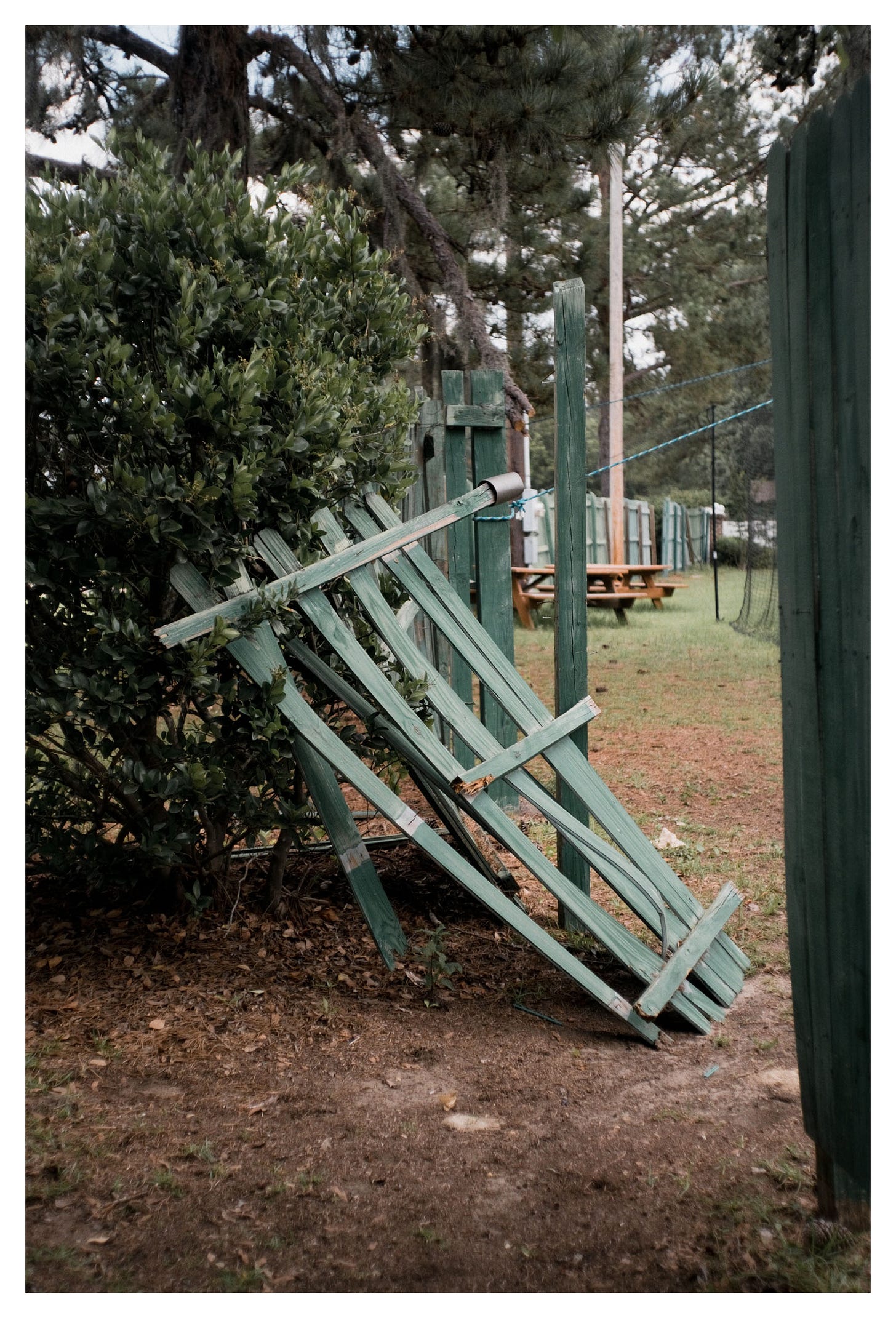-
 @ 84b0c46a:417782f5
2025-05-27 08:19:49
@ 84b0c46a:417782f5
2025-05-27 08:19:49Simple Long Form Content Editor (NIP-23)
機能
-
nostr:npub1sjcvg64knxkrt6ev52rywzu9uzqakgy8ehhk8yezxmpewsthst6sw3jqcw や、 nostr:nevent1qvzqqqqqqypzq4jsz7zew5j7jr4pdfxh483nwq9vyw9ph6wm706sjwrzj2we58nqqyxhwumn8ghj77tpvf6jumt9qys8wumn8ghj7un9d3shjtt2wqhxummnw3ezuamfwfjkgmn9wshx5uqpr4mhxue69uhhyetvv9ujumn0wd68ytnhd9ex2erwv46zu6nsqyxhwumn8ghj7mn0wvhxcmmvqqsgcn99jyn5tevxz5zxsrkd7h0sx8fwnqztula423xh83j9wau7cms3vg9c7 のようにnostr:要素を挿入できる (メニューのNアイコンから挿入またはnostr:note~~のように手動で入力)
-
:monoice:のようにカスタム絵文字を挿入できる(メニューの🙂アイコンから)
:monopaca_kao:
:kubipaca_karada:
- 新規記事作成と、既存記事の修正ができる
やることやったこと
-
[x] nostr:を投稿するときにtagにいれる
-
[x] 画像をアップロードできるようにする(NIP-96)
 できる
できる - [x] 投稿しましたログとかをトースト的なやつでだすようにする
- [ ] レイアウトを整える
- [ ] あとなんか
-
-
 @ b7274d28:c99628cb
2025-05-28 01:11:43
@ b7274d28:c99628cb
2025-05-28 01:11:43In this second installment of The Android Elite Setup tutorial series, we will cover installing the nostr:npub10r8xl2njyepcw2zwv3a6dyufj4e4ajx86hz6v4ehu4gnpupxxp7stjt2p8 on your #Android device and browsing for apps you may be interested in trying out.
Since the #Zapstore is a direct competitor to the Google Play Store, you're not going to be able to find and install it from there like you may be used to with other apps. Instead, you will need to install it directly from the developer's GitHub page. This is not a complicated process, but it is outside the normal flow of searching on the Play Store, tapping install, and you're done.
Installation
From any web browser on your Android phone, navigate to the Zapstore GitHub Releases page and the most recent version will be listed at the top of the page. The .apk file for you to download and install will be listed in the "Assets."
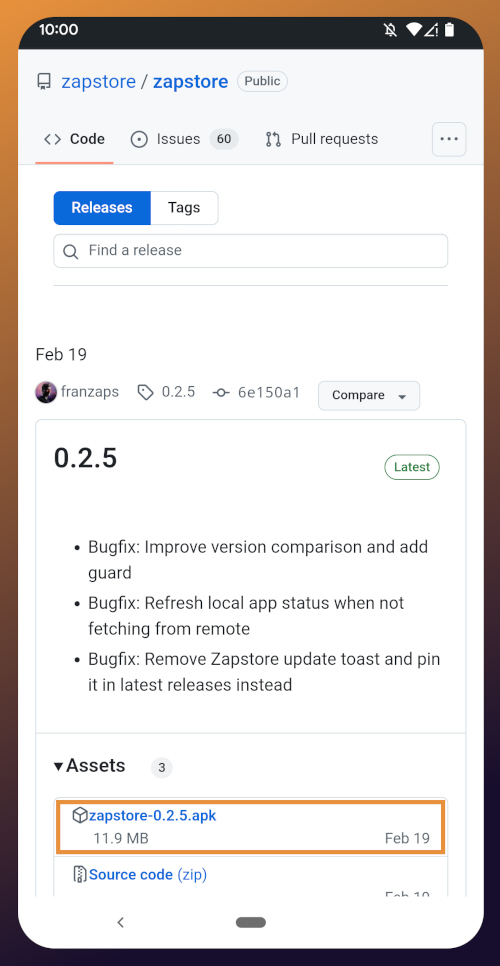
Tap the .apk to download it, and you should get a notification when the download has completed, with a prompt to open the file.
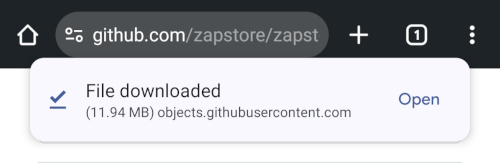
You will likely be presented with a prompt warning you that your phone currently isn't allowed to install applications from "unknown sources." Anywhere other than the Play Store is considered an "unknown source" by default. However, you can manually allow installation from unknown sources in the settings, which the prompt gives you the option to do.
In the settings page that opens, toggle it to allow installation from this source, and you should be prompted to install the application. If you aren't, simply go to your web browser's downloads and tap on the .apk file again, or go into your file browser app and you should find the .apk in your Downloads folder.

If the application doesn't open automatically after install, you will find it in your app drawer.

Home Page
Right at the top of the home page in the Zapstore is the search bar. You can use it to find a specific app you know is available in the Zapstore.

There are quite a lot of open source apps available, and more being added all the time. Most are added by the Zapstore developer, nostr:npub1wf4pufsucer5va8g9p0rj5dnhvfeh6d8w0g6eayaep5dhps6rsgs43dgh9, but some are added by the app developers themselves, especially Nostr apps. All of the applications we will be installing through the Zapstore have been added by their developers and are cryptographically signed, so you know that what you download is what the developer actually released.
The next section is for app discovery. There are curated app collections to peruse for ideas about what you may want to install. As you can see, all of the other apps we will be installing are listed in nostr:npub1wf4pufsucer5va8g9p0rj5dnhvfeh6d8w0g6eayaep5dhps6rsgs43dgh9's "Nostr" collection.

In future releases of the Zapstore, users will be able to create their own app collections.
The last section of the home page is a chronological list of the latest releases. This includes both new apps added to the Zapstore and recently updated apps. The list of recent releases on its own can be a great resource for discovering apps you may not have heard of before.

Installed Apps
The next page of the app, accessed by the icon in the bottom-center of the screen that looks like a clock with an arrow circling it, shows all apps you have installed that are available in the Zapstore. It's also where you will find apps you have previously installed that are ready to be updated. This page is pretty sparse on my test profile, since I only have the Zapstore itself installed, so here is a look at it on my main profile:
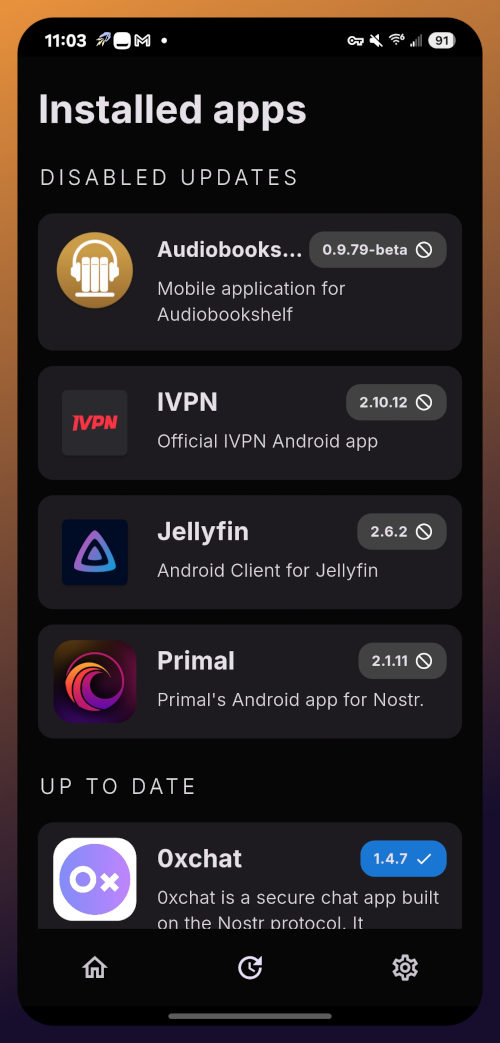
The "Disabled Apps" at the top are usually applications that were installed via the Play Store or some other means, but are also available in the Zapstore. You may be surprised to see that some of the apps you already have installed on your device are also available on the Zapstore. However, to manage their updates though the Zapstore, you would need to uninstall the app and reinstall it from the Zapstore instead. I only recommend doing this for applications that are added to the Zapstore by their developers, or you may encounter a significant delay between a new update being released for the app and when that update is available on the Zapstore.
Tap on one of your apps in the list to see whether the app is added by the developer, or by the Zapstore. This takes you to the application's page, and you may see a warning at the top if the app was not installed through the Zapstore.
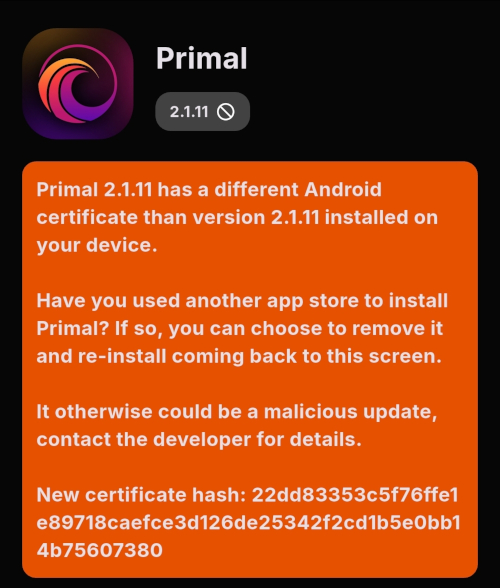
Scroll down the page a bit and you will see who signed the release that is available on the Zapstore.

In the case of Primal, even though the developer is on Nostr, they are not signing their own releases to the Zapstore yet. This means there will likely be a delay between Primal releasing an update and that update being available on the Zapstore.
Settings
The last page of the app is the settings page, found by tapping the cog at the bottom right.
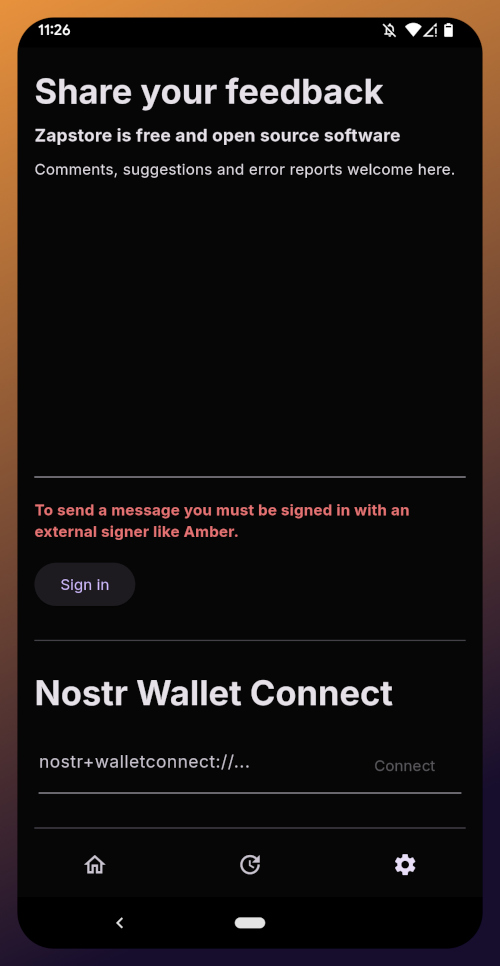
Here you can send the Zapstore developer feedback directly (if you are logged in), connect a Lightning wallet using Nostr Wallet Connect, delete your local cache, and view some system information.
We will be adding a connection to our nostr:npub1h2qfjpnxau9k7ja9qkf50043xfpfy8j5v60xsqryef64y44puwnq28w8ch wallet in part 5 of this tutorial series.
For the time being, we are all set with the Zapstore and ready for the next stage of our journey.
Continue to Part 3: Amber Signer. Nostr link: nostr:naddr1qqxnzde5xuengdeexcmnvv3eqgstwf6d9r37nqalwgxmfd9p9gclt3l0yc3jp5zuyhkfqjy6extz3jcrqsqqqa28qy2hwumn8ghj7un9d3shjtnyv9kh2uewd9hj7qg6waehxw309aex2mrp0yhxyunfva58gcn0d36zumn9wss80nug
-
 @ 39cc53c9:27168656
2025-05-27 09:21:53
@ 39cc53c9:27168656
2025-05-27 09:21:53The new website is finally live! I put in a lot of hard work over the past months on it. I'm proud to say that it's out now and it looks pretty cool, at least to me!
Why rewrite it all?
The old kycnot.me site was built using Python with Flask about two years ago. Since then, I've gained a lot more experience with Golang and coding in general. Trying to update that old codebase, which had a lot of design flaws, would have been a bad idea. It would have been like building on an unstable foundation.
That's why I made the decision to rewrite the entire application. Initially, I chose to use SvelteKit with JavaScript. I did manage to create a stable site that looked similar to the new one, but it required Jav aScript to work. As I kept coding, I started feeling like I was repeating "the Python mistake". I was writing the app in a language I wasn't very familiar with (just like when I was learning Python at that mom ent), and I wasn't happy with the code. It felt like spaghetti code all the time.
So, I made a complete U-turn and started over, this time using Golang. While I'm not as proficient in Golang as I am in Python now, I find it to be a very enjoyable language to code with. Most aof my recent pr ojects have been written in Golang, and I'm getting the hang of it. I tried to make the best decisions I could and structure the code as well as possible. Of course, there's still room for improvement, which I'll address in future updates.
Now I have a more maintainable website that can scale much better. It uses a real database instead of a JSON file like the old site, and I can add many more features. Since I chose to go with Golang, I mad e the "tradeoff" of not using JavaScript at all, so all the rendering load falls on the server. But I believe it's a tradeoff that's worth it.
What's new
- UI/UX - I've designed a new logo and color palette for kycnot.me. I think it looks pretty cool and cypherpunk. I am not a graphic designer, but I think I did a decent work and I put a lot of thinking on it to make it pleasant!
- Point system - The new point system provides more detailed information about the listings, and can be expanded to cover additional features across all services. Anyone can request a new point!
- ToS Scrapper: I've implemented a powerful automated terms-of-service scrapper that collects all the ToS pages from the listings. It saves you from the hassle of reading the ToS by listing the lines that are suspiciously related to KYC/AML practices. This is still in development and it will improve for sure, but it works pretty fine right now!
- Search bar - The new search bar allows you to easily filter services. It performs a full-text search on the Title, Description, Category, and Tags of all the services. Looking for VPN services? Just search for "vpn"!
- Transparency - To be more transparent, all discussions about services now take place publicly on GitLab. I won't be answering any e-mails (an auto-reply will prompt to write to the corresponding Gitlab issue). This ensures that all service-related matters are publicly accessible and recorded. Additionally, there's a real-time audits page that displays database changes.
- Listing Requests - I have upgraded the request system. The new form allows you to directly request services or points without any extra steps. In the future, I plan to enable requests for specific changes to parts of the website.
- Lightweight and fast - The new site is lighter and faster than its predecessor!
- Tor and I2P - At last! kycnot.me is now officially on Tor and I2P!
How?
This rewrite has been a labor of love, in the end, I've been working on this for more than 3 months now. I don't have a team, so I work by myself on my free time, but I find great joy in helping people on their private journey with cryptocurrencies. Making it easier for individuals to use cryptocurrencies without KYC is a goal I am proud of!
If you appreciate my work, you can support me through the methods listed here. Alternatively, feel free to send me an email with a kind message!
Technical details
All the code is written in Golang, the website makes use of the chi router for the routing part. I also make use of BigCache for caching database requests. There is 0 JavaScript, so all the rendering load falls on the server, this means it needed to be efficient enough to not drawn with a few users since the old site was reporting about 2M requests per month on average (note that this are not unique users).
The database is running with mariadb, using gorm as the ORM. This is more than enough for this project. I started working with an
sqlitedatabase, but I ended up migrating to mariadb since it works better with JSON.The scraper is using chromedp combined with a series of keywords, regex and other logic. It runs every 24h and scraps all the services. You can find the scraper code here.
The frontend is written using Golang Templates for the HTML, and TailwindCSS plus DaisyUI for the CSS classes framework. I also use some plain CSS, but it's minimal.
The requests forms is the only part of the project that requires JavaScript to be enabled. It is needed for parsing some from fields that are a bit complex and for the "captcha", which is a simple Proof of Work that runs on your browser, destinated to avoid spam. For this, I use mCaptcha.
-
 @ 84b0c46a:417782f5
2025-05-27 07:04:13
@ 84b0c46a:417782f5
2025-05-27 07:04:13 -
 @ 8bad92c3:ca714aa5
2025-05-28 08:01:41
@ 8bad92c3:ca714aa5
2025-05-28 08:01:41Marty's Bent

It's been a pretty historic week for the United States as it pertains to geopolitical relations in the Middle East. President Trump and many members of his administration, including AI and Crypto Czar David Sacks and Treasury Secretary Scott Bessent, traveled across the Middle East making deals with countries like Qatar, Saudi Arabia, the United Arab Emirates, Syria, and others. Many are speculating that Iran may be included in some behind the scenes deal as well. This trip to the Middle East makes sense considering the fact that China is also vying for favorable relationships with those countries. The Middle East is a power player in the world, and it seems pretty clear that Donald Trump is dead set on ensuring that they choose the United States over China as the world moves towards a more multi-polar reality.
Many are calling the events of this week the Riyadh Accords. There were many deals that were struck in relation to artificial intelligence, defense, energy and direct investments in the United States. A truly prolific power play and demonstration of deal-making ability of Donald Trump, if you ask me. Though I will admit some of the numbers that were thrown out by some of the countries were a bit egregious. We shall see how everything plays out in the coming years. It will be interesting to see how China reacts to this power move by the United States.
While all this was going on, there was something happening back in the United States that many people outside of fringe corners of FinTwit are not talking about, which is the fact that the 10-year and 30-year U.S. Treasury bond yields are back on the rise. Yesterday, they surpassed the levels of mid-April that caused a market panic and are hovering back around levels that have not been seen since right before Donald Trump's inauguration.


I imagine that there isn't as much of an uproar right now because I'm pretty confident the media freakouts we were experiencing in mid-April were driven by the fact that many large hedge funds found themselves off sides of large levered basis trades. I wouldn't be surprised if those funds have decreased their leverage in those trades and bond yields being back to mid-April levels is not affecting those funds as much as they were last month. But the point stands, the 10-year and 30-year yields are significantly elevated with the 30-year approaching 5%. Regardless of the deals that are currently being made in the Middle East, the Treasury has a big problem on its hands. It still has to roll over many trillions worth of debt over over the next few years and doing so at these rates is going to be massively detrimental to fiscal deficits over the next decade. The interest expense on the debt is set to explode in the coming years.
On that note, data from the first quarter of 2025 has been released by the government and despite all the posturing by the Trump administration around DOGE and how tariffs are going to be beneficial for the U.S. economy, deficits are continuing to explode while the interest expense on the debt has definitively surpassed our annual defense budget.

via Charlie Bilello

via Mohamed Al-Erian
To make matters worse, as things are deteriorating on the fiscal side of things, the U.S. consumer is getting crushed by credit. The 90-plus day delinquency rates for credit card and auto loans are screaming higher right now.

via TXMC
One has to wonder how long all this can continue without some sort of liquidity crunch. Even though equities markets have recovered from their post-Liberation Day month long bear market, I would not be surprised if what we're witnessing is a dead cat bounce that can only be continued if the money printers are turned back on. Something's got to give, both on the fiscal side and in the private markets where the Common Man is getting crushed because he's been forced to take on insane amounts of debt to stay afloat after years of elevated levels of inflation. Add on the fact that AI has reached a state of maturity that will enable companies to replace their current meat suit workers with an army of cheap, efficient and fast digital workers and it isn't hard to see that some sort of employment crisis could be on the horizon as well.
Now is not the time to get complacent. While I do believe that the deals that are currently being made in the Middle East are probably in the best interest of the United States as the world, again, moves toward a more multi-polar reality, we are facing problems that one cannot simply wish away. They will need to be confronted. And as we've seen throughout the 21st century, the problems are usually met head-on with a money printer.
I take no pleasure in saying this because it is a bit uncouth to be gleeful to benefit from the strife of others, but it is pretty clear to me that all signs are pointing to bitcoin benefiting massively from everything that is going on. The shift towards a more multi-polar world, the runaway debt situation here in the United States, the increasing deficits, the AI job replacements and the consumer credit crisis that is currently unfolding, All will need to be "solved" by turning on the money printers to levels they've never been pushed to before.
Weird times we're living in.
China's Manufacturing Dominance: Why It Matters for the U.S.
In my recent conversation with Lyn Alden, she highlighted how China has rapidly ascended the manufacturing value chain. As Lyn pointed out, China transformed from making "sneakers and plastic trinkets" to becoming the world's largest auto exporter in just four years. This dramatic shift represents more than economic success—it's a strategic power play. China now dominates solar panel production with greater market control than OPEC has over oil and maintains near-monopoly control of rare earth elements crucial for modern technology.
"China makes like 10 times more steel than the United States does... which is relevant in ship making. It's relevant in all sorts of stuff." - Lyn Alden
Perhaps most concerning, as Lyn emphasized, is China's financial leverage. They hold substantial U.S. assets that could be strategically sold to disrupt U.S. treasury market functioning. This combination of manufacturing dominance, resource control, and financial leverage gives China significant negotiating power in any trade disputes, making our attempts to reshoring manufacturing all the more challenging.
Check out the full podcast here for more on Triffin's dilemma, Bitcoin's role in monetary transition, and the energy requirements for rebuilding America's industrial base.
Headlines of the Day
Financial Times Under Fire Over MicroStrategy Bitcoin Coverage - via X
Trump in Qatar: Historic Boeing Deal Signed - via X
Get our new STACK SATS hat - via tftcmerch.io
Johnson Backs Stock Trading Ban; Passage Chances Slim - via X
Take the First Step Off the Exchange
Bitkey is an easy, secure way to move your Bitcoin into self-custody. With simple setup and built-in recovery, it’s the perfect starting point for getting your coins off centralized platforms and into cold storage—no complexity, no middlemen.
Take control. Start with Bitkey.
Use the promo code *“TFTC20”* during checkout for 20% off
Ten31, the largest bitcoin-focused investor, has deployed 158,469 sats | $150.00M across 30+ companies through three funds. I am a Managing Partner at Ten31 and am very proud of the work we are doing. Learn more at ten31.vc/invest.
Final thought...
Building things of value is satisfying.
Get this newsletter sent to your inbox daily: https://www.tftc.io/bitcoin-brief/
Subscribe to our YouTube channels and follow us on Nostr and X:
@media screen and (max-width: 480px) { .mobile-padding { padding: 10px 0 !important; } .social-container { width: 100% !important; max-width: 260px !important; } .social-icon { padding: 0 !important; } .social-icon img { height: 32px !important; width: 32px !important; } .icon-cell { padding: 0 4px !import
-
 @ 99e7936f:d5d2197c
2025-05-28 14:55:40
@ 99e7936f:d5d2197c
2025-05-28 14:55:40“Dieser Beitrag wurde mit dem Pareto-Client geschrieben.”
Wo bleibt die Rettung?
Wenn man bei einem Notfall auf den Rettungswagen wartet, dann fühlen sich Minuten wie Stunden an. Die Nerven sind bis zum Anschlag gespannt, alle Sinne sind geschärft.
Die Natur hat das so eingerichtet, damit man aufmerksam und gut geschützt ist vor weiteren Verletzungen.
Bei Trauma ist das auch so, nur dass dieser Zustand gefühlt ein halbes Leben andauert. Das klingt brutal, ist aber in etwa so. Da ein menschlicher Körper das nicht gut aushalten kann, sendet er dem Gehirn die Information: “ Bitte mach etwas zur Entlastung, ich kann mit dem Dauerstress nicht gut umgehen. Ich habe ständig das Gefühl, dass etwas Schlimmes passiert und ich mich verteidigen muss.“ Das Gehirn überlegt sich dann eine Lösung, um auch selber endlich wieder Ruhe zu haben. In der Regel wird der traumatische Inhalt verdrängt, vergessen, abgewandelt, abgeschwächt oder als Schwarz-Weiß-Film wieder gegeben, also ohne Gefühl (re)präsentiert. Man kann dann von den traumatischen Erlebnissen erzählen, ohne ein einziges Gefühl zu haben. Das wirkt souverän, als habe man das Trauma verarbeitet, das Gegenteil ist der Fall. Manche Menschen reden sogar über Gefühle, empfinden diese aber nicht. Gefühle werden imitiert oder inszeniert. Wenn man selber fühlen kann, spürt man diesen feinen Unterschied als Zuhörer sofort. Jedenfalls ist alles das Traumafolge bzw. die Lösung, die uns das Gehirn nach Trauma anbietet. Entweder ist der ganze Inhalt samt Emotion weg, oder der Inhalt ist noch da, aber die Emotion dazu fehlt. Es gibt Menschen, die so tief traumatisiert sind, dass sie eine ganz andere Geschichte von sich selbst erzählen, als die, die eigentlich stattgefunden hat. Ich weiß, dass das gruselig klingt. Aber das ist eine Realität. Und es ist vermutlich gut so. Die Natur macht alles, um ein Menschenleben zu retten, und wenn es um den Preis des psychologischen Vergessens ist. Manche Erinnerungen sind offensichtlich nicht mit dem Leben vereinbar, deswegen werden sie für immer abgespalten. Mittlerweile habe ich persönlich viel Respekt vor Menschen, die sich an nichts mehr „erinnern“ können, da ich gelernt habe, dass sie am schlimmsten traumatisiert sind. Diese Einstellung hatte ich nicht immer.
Jedenfalls verhält es sich nach meiner Beobachtung und auch nach meinen eigenen Erfahrungen so, dass man sich ganz oft erst dann vollständig UND in Farbe an traumatische Erlebnisse erinnert, wenn die Zeit dafür reif ist. Man könnte auch sagen, wenn die Seele bereit ist, die verlorenen Seelenanteile wieder zuzulassen. Sie sind nie weg, denn eine unsichtbare Schnur verbindet uns immer mit dem, was passiert ist. Also, wenn dieser Moment, in dem Du Deine Seelenanteile wieder begrüßen darfst, kommt, dann ist das wie ein riesiges Geschenk, auch wenn sich das zu Beginn nicht so anfühlt. Es fühlt sich dann eher so an, wie wenn man auf den Rettungswagen wartet, aber es ist definitiv ein Geschenk, genau wie eine Geburt ein Geschenk ist. Und eine Geburt ist ja auch nicht immer leicht.
Also, je mehr Gefühl beim Erinnern von traumatischen Inhalten spürbar ist, desto besser kann Traumabearbeitung gelingen. (Heiße den Schmerz willkommen, wenn er in Dein Leben kommt.) Ich persönlich hatte lange Wehen, bevor mein Trauma dann schlagartig aktiviert wurde. Das war, bildlich gesprochen, eine Hausgeburt, die ich allein vollbracht habe, weil der Rettungswagen dermaßen Verspätung hatte. Aber das Kind hat sich dennoch gut entwickelt. Ich habe zuvor lange von meinem Trauma „nur“ geredet. Ich habe rationalisiert, wie man in der Fachsprache sagt. Mir war meine frühe Verletzung bewusst, aber ich hatte kein Gefühl zu dem, was ich erlebt hatte. Als das Gefühl da war, verstand ich, dass es sinnvoll war, es solange nicht gefühlt haben zu können, denn es war ein überwältigender Schmerz. Die Natur macht instinktiv ein gutes Timing für die Wiederkehr des Gefühls. Sie sucht sich eine Zeit im Leben aus, wo man einen guten Stand hat, stabil ist, eine Umgebung hat, die einen zumindest für eine Weile halten und auffangen kann. Denn die Natur möchte schließlich, dass man auch die Wiederkehr des Gefühls überlebt.
Genauso schmerzhaft wie der Verlust des Gefühls war, genauso schmerzhaft ist seine Wiederkehr.
Der Schmerz ist quasi der Erste und der Letzte. Er macht das Licht aus, und später macht er das Licht oder den Farbfilm wieder an. Der Schmerz ist viel besser als sein Ruf.
Ich erzähle hier lediglich meine Erfahrungen und Beobachtungen, auch wenn ich allgemein formuliere. Das kann sich bei anderen Menschen auch anders verhalten. Aber ich finde den Erfahrungsaustausch über dieses Thema wichtig, WEIL es unterschiedlich sein kann und jeder auf einem anderen Level von Traumabearbeitung steht. Ein Problem bei Traumabearbeitung ist, dass jeder ein anderes Trauma erlebt hat, dass jeder einen anderen Nährboden hatte, auf den das Trauma fiel, und dass es verschiedene Stadien gibt, bis es dann endlich und hoffentlich soweit ist, dass das Trauma wieder vollständig in die eigene Psyche integriert werden kann und man wieder „ganz“ bzw. „neu und etwas anders“ ist. Und meine Erfahrung ist, dass man auf das Tempo dieses Prozesses leider keinen Einfluss hat, auch wenn es hierzu, wie ich finde, viele falsche Verkehrsdurchsagen gibt. Die Natur ist da verschlossen wie eine Auster, sie lässt sich nicht ins Handwerk pfuschen. Als ich das verstand, hat sich mein Wunsch, Menschen zu helfen, schlagartig verändert. Ich verstand, dass ICH das nicht machen kann, dass die Natur das selber macht. Und das ist eine gute Nachricht, denn die Natur kann das am besten und ist ein super zuverlässiger Partner.
Wir brauchen keinen Rettungswagen. Der Schmerz ist die Rettung.
Das Thema „Trauma“ birgt so viel positiven Erkenntnisgewinn über das Wunder des Lebens.
Aber zurück zum Thema. Wenn man, so wie ich, ein halbes Leben in einem Schwarz-Weiß-Film verbracht hat, dann die Hausgeburt ohne Rettungswagen durchgestanden hat und das Kind irgendwann anfängt, neugierige Fragen zu stellen, dann ist man im Zugzwang. In dieser Situation bin ich heute. Deswegen schreibe ich. Mein neues ICH fragt mich immer öfter, warum ich so viele Dinge tue, die ich eigentlich gar nicht mehr tun will. Kinder fragen einen auch manchmal ganz unverblümt, ob man den Hansi denn lieb hat oder ob man gerne im Büro arbeitet. Wenn man den Hansi nicht lieb hat und nicht gerne im Büro arbeitet, dann muss man schlucken und eine kindgerechte Antwort formulieren. Genauso wenig wie Kinder als kompetenter 20-jähriger auf die Welt kommen, genau so wenig ist man nach geglückter Traumabearbeitung „geheilt“. Es wird nichts schlagartig besser. Das ist auch so eine falsche Verkehrsdurchsage. Man lebt ja noch im alten Leben, was nun Schritt für Schritt verändert werden darf. ABER man ist glückliche Mutter. Mutter sein, ist nicht immer leicht, habe ich mir sagen lassen. Mütter lieben ihre Kinder. Im Idealfall machen sie sich keine Gedanken darüber, was aus ihrem Kind mal werden soll. Sie vertrauen einfach darauf, DASS aus ihrem Kind ein glücklicher Mensch wird und buttern deshalb so viel Liebe in das Kind hinein, wie in den wenigen Jahren, die das Kind ein Kind ist, möglich ist. So ähnlich geht es mir heute auch. Ich bin stolz auf mein neues ICH und lobe es, so oft ich kann. Jede Mutter lobt ihre Butter. Das ist wichtig, denn das Leben bietet ständig Herausforderungen, an denen man bekanntlich wachsen darf. Ich gehe jeden Tag mit meinem „Kind“ spazieren, und wir sehen viel. Wir sehen andere Menschen mit Trauma, wir hören zu, welches Trauma der andere erlebt hat und auf welchem Level er ist. Wir hören das Gefühl heraus, welches mitschwingt. Wir sehen Menschen in ihrem Schwarz-Weiß-Film. Und wir sehen Menschen, die scheinbar mit jeder Situation souverän umgehen können. Am meisten interessieren „uns“ zur Zeit solche Menschen, die ehrlich zugeben, dass sie Wehen haben, dass der Schmerz sich in immer kürzeren Abständen meldet. (Die verlorenen Seelenanteile ziehen an der unsichtbaren Schnur.) Mit diesen Leuten kann ich im Moment am besten. Das hört sich komisch an. Aber ich will damit zum Ausdruck bringen, dass ich mit diesen Menschen mittlerweile am meisten resoniere. Sie sprechen meine Sprache. Sie empfinden Gefühle, und sprechen über diese. Das ist für mich die schönste Sprache.
Wer in diesen Tagen wahrhaftig Schmerz empfindet, und nicht nur als Lippenbekenntnis, sondern echten üblen Schmerz über die enttäuschte Liebe oder über die Verhältnisse in dieser Welt, der ist mir sympathisch, der ist mir nah. Denn ich weiß, dass so ein fühlender Mensch auch bald eine Niederkunft erleben wird, die ihn verändert, die ihn anders auf diese Welt schauen lässt.
Der Schmerz bringt uns die Verwandlung. Der Schmerz bringt die verlorenen Seelenanteile zurück. Der Schmerz ist der Hüter des Lebens. Der Schmerz bringt Dir Deine volle Sensibilität für andere Menschen zurück. Alles, was Du bei Dir nicht fühlen kannst, kannst Du bei anderen nicht fühlen. Der Schmerz beendet das. Er macht das Licht an und gibt dem Film wieder Farbe.
Heiße den Schmerz willkommen, wenn er in Dein Leben kommt. Tu das, nicht etwa weil Du gern leidest, nein tu das, weil Du Dich liebst, weil Du bewusst darauf achten möchtest, was Dir wirklich gut tut und Freude macht. Ein Mensch oder ein Job, der Dir Schmerz bereitet, den gilt es loszulassen. Und wenn Du Schmerz im Gesicht Deines Gegenübers siehst, dann frage Dich ehrlich, was Dein Anteil daran ist, dass der andere leidet. Wir sind nicht für jedes Leid auf dieser Welt verantwortlich, das möchte ich hier auch betonen. Und die Schuld-Nummer zieht bei mir schon lange nicht mehr. Aber ich nehme immer besser wahr, wenn mein eigenes Verhalten nicht angemessen, nicht authentisch ist, von überholten Glaubensmustern geprägt ist. Ich kann das erkennen und korrigieren. Ich kann das heute selber erkennen, weil der Schmerz mich das gelehrt hat, mich geöffnet hat. Der Schmerz lehrt uns ganz viel. Der Schmerz ist der Hüter des Lebens. Er trifft einen hart, macht aber weich.
Heiße den Schmerz willkommen, denn er ist die Rettung.
“Dieser Beitrag wurde mit dem Pareto-Client geschrieben.”
Onboarding bei Nostr: Nostr
Easy onboarding via **Start.**\ \ Das Pareto-Team baut den “Marktplatz der Ideen” und hat dabei schon viel erreicht. \ team@pareto.space \ https://pareto.space \ https://geyser.fund/project/pareto?hero=1c1b8e487090
\ \ Newsletter per Mail (Die Friedenstaube)\ hier abonnieren\ \ In Telegram lesen -> hier unsere Kanäle\ https://t.me/pareto_artikel \ https://t.me/friedenstaube_artikel \ \ Als Feed in einem Feed-Reader \ https://pareto.space/atom/feed.xml \ https://pareto.space/atom/de_feed.xml \ https://pareto.space/atom/en_feed.xml
-
 @ cff1720e:15c7e2b2
2025-05-28 11:18:23
@ cff1720e:15c7e2b2
2025-05-28 11:18:23Liebe Anwender,\ \ diesmal beginnen die Neuigkeiten schon beim Titel und der Anrede. Unsere Worte bestimmen unser Denken, und daher war die Korrektur wichtiger als sie zunächst erscheint, denn bei Pareto gibt es die klassische Trennung zwischen Autor und Leser nicht mehr. Cocreation heißt unser Konzept, jeder kann publizieren, kommentieren, honorieren und distribuieren. Mag das bei Blogtexten derzeit noch nicht selbstverständlich sein, so ist das bei Bildern längst die Norm.

“Ein Bild sagt mehr als tausend Worte” beschreibt die Wirkung visueller Kommunikation. Deshalb haben wir nach dem Blogtext nun mit Bildern eine neue Content-Kategorie eingeführt. Natürlich auch hier mit den bekannten Funktionen der Interaktion wie like, repost und zap. Es gibt derzeit eine Gliederung in 4 Feeds, Gefolgt (für Nostr-User verfügbar), Memes und Kunst (gefiltert nach entsprechenden Tags) und Pareto für alles andere.

Jeder Nostr-User hat die Möglichkeit eigene Bilder hochzuladen, zu taggen, sowie mit einem Titel und Untertext zu versehen. “Everyone is a creator” war noch nie leichter, probiert es einfach aus! Noch kein Nostr-Profil und trotzdem interessiert? Kein Problem, bitte Informationen zu originellen Bildquellen oder Interesse an Mitwirkung per Mail senden an pictures@pareto.space

Leicht ist es auch die Pareto-Inhalte zu erhalten und konsumieren, man braucht weder einen Account noch spezielle Apps. Jeder hat bereits die entsprechenden Voraussetzungen, hier ein paar Beispiele.\ \ Newsletter per Mail (Die Friedenstaube)\ hier abonnieren\ \ In Telegram lesen -> hier unsere Kanäle\ https://t.me/pareto_artikel \ https://t.me/friedenstaube_artikel \ \ Als Feed in einem Feed-Reader \ https://pareto.space/atom/feed.xml \ https://pareto.space/atom/de_feed.xml \ https://pareto.space/atom/en_feed.xml

Fügt in Eure Artikel bitte am Anfang / Ende einen Hinweis auf den Pareto-Client ein, andere Clients unterstützen nicht alle Features. Das ist ein Service-Hinweis zur besseren Lesbarkeit “Dieser Beitrag wurde mit dem Pareto-Client geschrieben.” Ebenso ist ein Hinweis auf Onboarding bei Nostr nützlich: neue Nostr-User können euch liken und zappen: not yet on Nostr and want the full experience? Easy onboarding via Start.\ \ Das Pareto-Team baut den “Marktplatz der Ideen” und hat dabei schon viel erreicht. Feedback und Mitarbeit hilft uns damit noch schneller voranzukommen, wir bedanken uns für Eure Unterstützung.\ team@pareto.space \ https://pareto.space \ https://geyser.fund/project/pareto?hero=1c1b8e487090
-
 @ a19caaa8:88985eaf
2025-05-27 22:36:15
@ a19caaa8:88985eaf
2025-05-27 22:36:15インターネット、だいすき!
レスバって?
- たのしさ(ちゃぴにきく)
ちがい
- タイプもきく?それはダルい?
さけるには
- ちゃぴにきく
“思い遣る”のと“邪推する”のは違う
- でもそう捉えたんだから仕方ないじゃん(自分の気持ちも大事にする)(バランス)(またあ?)
- 「意見単体」として見ているか、「そのひとから発された言葉」として見ているかの違い?
-
自分の理想をひとに押し付けない
-
それはそれとして、社会に疲れて深く潜りにきて、同じように深いとこに居るひとと手を振り合ったり、そのあり方を見て吸収したりしたいのに、バトルに巻き込まれるの、不憫すぎる
- インスタくんはえらいなあ、「このひとにストーリーズを表示しない」ができて
- 自分はそんなつもり無くても、始まってしまった以上、責任がある気がしてしまって、相手がどうして欲しいかを考え始めてしまい、消耗する
- 社会じゃん
- EなのにEしづらい環境のひとたちの捌け口になる必要は無い
- 海は広い
-
 @ 39cc53c9:27168656
2025-05-27 09:21:37
@ 39cc53c9:27168656
2025-05-27 09:21:37After almost 3 months of work, we've completed the redesign of kycnot.me. More modern and with many new features.
Privacy remains the foundation - everything still works with JavaScript disabled. If you enable JS, you will get some nice-to-have features like lazy loading and smoother page transitions, but nothing essential requires it.
User Accounts
We've introduced user accounts that require zero personal information:
- Secret user tokens - no email, no phone number, no personal data
- Randomly generated usernames for default privacy and fairness
- Karma system that rewards contributions and unlocks features: custom display names, profile pictures, and more.
Reviews and Community Discussions
On the previous sites, I was using third party open source tools for the comments and discussions. This time, I've built my own from scratch, fully integrated into the site, without JavaScript requirements.
Everyone can share their experiences and help others make informed decisions:
- Ratings: Comments can have a 1-5 star rating attached. You can have one rating per service and it will affect the overall user score.
- Discussions: These are normal comments, you can add them on any listed service.
Comment Moderation
I was strugling to keep up with moderation on the old site. For this, we've implemented an AI-powered moderation system that:
- Auto-approves legitimate comments instantly
- Flags suspicious content for human review
- Keeps discussions valuable by minimizing spam
The AI still can mark comments for human review, but most comments will get approved automatically by this system. The AI also makes summaries of the comments to help you understand the overall sentiment of the community.
Powerful Search & Filtering
Finding exactly what you need is now easier:
- Advanced filtering system with many parameters. You can even filter by attributes to pinpoint services with specific features.
The results are dynamic and shuffle services with identical scores for fairness.
See all listings
Listings are now added as 'Community Contributed' by default. This means that you can still find them in the search results, but they will be clearly marked as such.
Updated Scoring System
New dual-score approach provides more nuanced service evaluations:
- Privacy Score: Measures how well a service protects your personal information and data
-
Trust Score: Assesses reliability, security, and overall reputation
-
Combined into a weighted Overall Score for quick comparisons
- Completely transparent and open source calculation algorithm. No manual tweaking or hidden factors.
AI-Powered Terms of Service Analysis
Basically, a TLDR summary for Terms of Service:
- Automated system extracts the most important points from complex ToS documents
- Clear summaries
- Updated monthly to catch any changes
The ToS document is hashed and only will be updated if there are any changes.
Service Events and Timelines
Track the complete history of any service, on each service page you can see the timeline of events. There are two types of events:
- Automatic events: Created by the system whenever something about a service changes, like its description, supported currencies, attributes, verification status…
- Manual events: Added by admins when there’s important news, such as a service going offline, being hacked, acquired, shut down, or other major updates.
There is also a global timeline view available at /events
Notification System
Since we now have user accounts, we built a notifiaction system so you can stay informed about anything:
- Notifications for comment replies and status changes
- Watch any comment to get notified for new replies.
- Subscribe to services to monitor events and updates
- Notification customization.
Coming soon: Third-party privacy-preserving notifications integration with Telegram, Ntfy.sh, webhooks...
Service Suggestions
Anyone with an account can suggest a new service via the suggestion form. After submitting, you'll receive a tracking page where you can follow the status of your suggestion and communicate directly with admins.
All new suggestions start as "unlisted" — they won't appear in search results until reviewed. Our team checks each submission to ensure it's not spam or inappropriate. If similar services already exist, you'll be shown possible duplicates and can choose to submit your suggestion as an edit instead.
You can always check the progress of your suggestion, respond to moderator questions, and see when it goes live, everything will also be notified to your account. This process ensures high-quality listings and a collaborative approach to building the directory.
These are some of the main features we already have, but there are many more small changes and improvements that you will find when using the site.
What's Next?
This is just the beginning. We will be constantly working to improve KYCnot.me and add more features that help you preserve your privacy.
Remember: True financial freedom requires the right to privacy. Stay KYC-free!
-
 @ a29cfc65:484fac9c
2025-05-28 10:30:32
@ a29cfc65:484fac9c
2025-05-28 10:30:32Deutschland ist eines der wenigen Länder mit einer gesetzlich verankerten ausnahmslosen Schulbesuchspflicht. Mit den Schulschließungen in der Corona-Zeit wurde das Gesetz jedoch faktisch plötzlich außer Kraft gesetzt. Alle mussten zu Hause lernen. Als die Schulen danach wieder offen waren, wurden die Kinder mit Maskenpflicht, Tests und Impfdruck gequält. Nicht selten traten bei den Schülern Krankheiten und psychische Störungen auf. Nicht wenige Eltern suchten im Gespräch mit dem Lehrerkollegium nach Lösungen für ihre Kinder. In den meisten Fällen war das nicht möglich. Die Lehrer waren auf die neue Ideologie und die Durchsetzung der Maßnahmen eingeschworen und hatten Angst. Einige Eltern haben ihre Kinder dann in eigener Verantwortung aus der Schule genommen und zu Hause selbst unterrichtet. An manchen Orten fanden sich Gemeinschaften, wo die Kinder in Gruppen lernten. Während viele Lerngemeinschaften nicht mehr existieren, hat die Familie von Katharina den Unterricht für ihre drei Kinder in Eigenregie etabliert. Inzwischen haben sie dafür sogar „den Segen“ von Familiengericht und Jugendamt.
Katharina und Johannes leben mit ihren drei Wunschkindern Aurelius (15), Benjamin (14) und Friedrich (10) in einem Vorort von Leipzig. Die Familie wohnte früher in der Stadt. In der Corona-Zeit haben sie sich mit dem Physiotherapie- & Seminarzentrum Curasanus eine Existenz auf dem Land aufgebaut und begehen diesen Sommer ihr 20-jähriges Praxis-Jubiläum. Katharina hat ihre Arbeit als Physiotherapeutin weitgehend aufgegeben, um sich als Mama und Lernbegleiterin ihren Kindern widmen zu können. Daneben bietet sie Vorträge und Workshops an, übernimmt einen großen Teil der Praxis-Organisation und ist Manager, Rezeptionistin und Vertriebler der eigenen Firma. Wir besuchten einen ihrer Lachyoga-Kurse. Dabei erlebten wir ihr Zusammenspiel mit den drei Kindern. Anschließend stellten wir Katharina unsere Fragen zum Freilernen.
Im unmittelbaren Umfeld wird die Familie bestaunt und geachtet. Sie haben sich bewusst für das Freilernen entschieden. Die Kinder wurden ohne Test nicht mehr in die Schule gelassen. Auch andere Zwangsmaßnahmen wie die Maske wollten die Eltern den Kindern ersparen. Besonders Benjamin hatte traumatische Erlebnisse. Seine Lehrerin schmiss mit dem Schlüssel nach den Schülern und wandte andere schwarze Pädagogik an. Er ging ständig mit Bauchschmerzen ins Bett. Ein weiterer Punkt ist die Masernimpfung. Die Kinder könnten zwar zur Schule gehen, aber die Eltern werden mit rechtlichen Maßnahmen und Zwangszahlungen belegt. Da Katharina in ihrer Praxis viele Erkrankungen als Folge der Masernimpfung beobachten konnte, lehnt sie die Pflichtimpfung ab. Die Eltern haben kein Vertrauen mehr in die staatliche Schulerziehung mit all dem Zwang und den Erpressungen. Als die Familie den Entschluss gefasst hatte, die Kinder nicht mehr in die Schule zu schicken, haben sie ihre Praxis vorübergehend geschlossen, ihr Haus verkauft und sind auf Reisen gegangen. Die beiden großen Kinder wurden von der Schule abgemeldet. Nach der Rückkehr haben sie dann mit einem neuen Leben auf dem Land begonnen.
Lernen ohne Schule: Wie geht das?
„Wissen ist Macht und eine Holschuld“, sagt uns Katharina. Das ist ihr Motto und motiviert auch die Kinder. Mit dem Unterricht zu Hause macht die Familie ihre eigene Studie und zeigt, dass Lernen auch anders geht als in der Schule. Die Eltern können viel besser auf jedes einzelne Kind eingehen. Johannes arbeitete früher als Straßenbauer. Er unterstützt die Jungs vor allem in Mathematik, Geometrie und Physik sowie bei handwerklichen Fertigkeiten. Katharinas Stärken liegen in Deutsch, Sprachen und Organisation. Unter den Patienten ihrer Praxis gibt es Lehrer, die ihnen helfen. Weitere Unterstützung kommt von Freunden und Bekannten. Bei bestimmten Projekten treffen sie auf andere Freilernerkinder. „Das Netzwerk wird immer größer, es wird immer schöner und interessanter“, sagt Katharina. Man geht mit vielen anderen einen gemeinsamen Weg, verlässt dabei eingetretene Pfade und erkundet neue Themenfelder wie Mediengestaltung, freie Energie, Elektrotherapie, meditatives und Improvisations-Zeichnen. „Ich sprudele vor Ideen. Sie kommen in mein Feld, und dann mache ich was draus“, sagt Katharina. Die Jungs sind in Wurzen im Ringelnatz-Literaturkreis. Dort schreiben sie Drehbuchgeschichten und haben einen Film produziert. Sie suchen sich Projekte oder kreieren neue, wie mit dem Planetarium Eilenburg. Diese Zusammenarbeit hat sich sehr gut entwickelt. Dort lernen 4- bis 15-Jährige zusammen. Die drei Jungs spielen Klavier. Erdkunde und Geschichte erleben die Kinder auch dadurch, dass die Familie Hauptstädte oder die bosnischen Pyramiden selbst erkundet. Dabei erweist es sich als Vorteil, nicht auf die Ferienzeiten angewiesen zu sein.
Als Physiotherapeutin ist Katharina bewusst, dass man neue Lernstrategien entwickeln muss. Die Kinder lernen unterschiedlich. Jedes Kind hat seinen eigenen Charakter. Aurelius benötigt eher eine 1:1-Betreuung. Darauf kann Katharina viel individueller eingehen als die staatliche Schule. Es ist aber auch aufwendiger und anstrengender. Besonderen Wert legt sie darauf, dass rechte und linke Gehirnhälfte gleichmäßig beansprucht werden. Lernphasen werden immer wieder mit Entspannungs- oder Bewegungsphasen kombiniert. Sie weiß, dass den Kindern zuerst die Grundlagen des Lesens, Rechnens und Schreibens vermittelt werden müssen. Dann sind sie in der Lage, sich alles Weitere selbst anzueignen – Unterstützung vorausgesetzt. „Besonders das Schreiben mit der eigenen Hand ist wichtig für die Vernetzung der beiden Gehirnhälften“, sagt Katharina. Dafür nehmen sich die Eltern Zeit. Die Kinder führen Tagebuch. Außerdem halten es die Eltern für wichtig, den Kindern Werte und Tugenden wie Dankbarkeit, Verlässlichkeit, Beharrlichkeit, Aufrichtigkeit, Ehrlichkeit und die zehn Gebote zu vermitteln. Katharina und Johannes sind beide religiös begleitet aufgewachsen. Heute sehen sie die Kirche als Institution kritisch. Angebunden an die Schöpfung und im Gottvertrauen erschaffen und schöpfen sie Leben und Lebensraum aus eigener Kraft – so erklärt es uns Katharina.
Ein weiteres Thema sind die Funktionen des Körpers und wie sich die Kinder gesund erhalten können. Vieles lernen sie dabei in der Physiotherapiepraxis. Die Familie hat das Privileg, in ihrem eigenen Biorhythmus leben zu können. „Das macht sehr viel aus – wir sind alle gesund“, sagt Katharina. Der Lern- und Arbeitstag beginnt nicht vor 9 Uhr und hat eine eigene Struktur. Im Tagesablauf sind feste Verantwortlichkeiten integriert. So wechseln sich die Kinder aller drei Tage mit Tischdecken, Staubsaugen und Geschirrspüler ab. Das hilft ihnen, sich selbst zu organisieren. Das geht nicht immer reibungslos vonstatten. Wenn das Lernpensum beizeiten abgearbeitet wurde, helfen die Kinder im Haushalt oder Garten oder gehen ihrem Bewegungsdrang auf andere Weise nach. Die Eltern sind am Abend noch länger aktiv, denn die Praxis erfordert noch die eine oder andere bürokratische Pflicht. Die Familie ist sehr naturverbunden. Sie gehen viel in den Wald und in den Garten. Sie bauen selbst Gemüse und Obst an. Dabei können die Kinder zum Beispiel Erfahrungen mit Permakultur und natürlicher Düngung sammeln. Die Familie achtet auf die Ernährung, schließlich ist Katharina seit fast 25 Jahren Ernährungsberaterin. Was sie nicht selbst anbauen, wird beim Bauern des Vertrauens eingekauft. Die Jungs können selbst kochen und backen. Die Schädlichkeit von Zucker ist den Kindern schon bewusst geworden, ohne gänzlich auf Schokolade verzichten zu müssen. Medikamente gibt es im Haushalt nicht. Sie kennen sich sehr gut mit den Heilmitteln aus der Natur aus und können so ihre Selbstheilungskräfte aktivieren. Sie haben keinen Hausarzt. Natürlich hat keines der Kinder ein Handy. Bisher haben sie noch kein Verlangen danach. Die Eltern halten es für wichtig, dass die Kinder erst sicher bei Selbstorganisation und Tagesstruktur sind, bevor sie ein Handy bekommen. Katharina weist darauf hin, dass beispielsweise WhatsApp erst ab 16 Jahren zugelassen ist, und fragt sich, ob das andere Eltern wissen.
Gesetze auf Augenhöhe auslegen
Den Behörden blieben die Freilerner nicht verborgen. Sie wurden aktiv und schalteten das Familiengericht ein. Die Familie hatte keinen Anwalt und keine Rechtsschutzversicherung. Katharina erzählt uns, dass sie schließlich auf „Hilfe von oben“ gehofft habe. Irgendwer hat sie anscheinend erhört, denn sie bekamen „einen Engel“ als Verfahrensbeistand. Die Behörden waren sehr zugänglich. In den Gesprächen gab man zu, mit der Schulsituation ebenfalls nicht zufrieden zu sein. „Wir wollen so wie ihr, dass sich etwas verändert. Wir sind an Eurer Seite.“ Die Gespräche mit dem Jugendamt und der Richterin vom Familiengericht Grimma waren immer auf Augenhöhe. Schließlich legte man der Familie keine Steine in den Weg. Damit kann Katharina ihr Konzept nach außen leben und andere inspirieren. Ihre Schlussfolgerung: Eltern müssen sich ihrer Stärken bewusst werden und aus ihrer Angst herauskommen. Das Konzept muss aber zur Familie passen, denn jede Familie ist anders.
Die Basis für freies Lernen ist das Vertrauen der Eltern in ihre Kinder. Denn Kinder sind von Natur aus wissbegierig und wollen lernen. Katharina hat viel von Bertrand Stern und von Riccardo Leppe gelernt. Beiden wurde von ihren Eltern das Lernen ohne Schulbesuch ermöglicht. Mit Bertrand Stern hat Katharina Kontakt. Er wird im November am Buß- und Bettag eine kleine Fortbildung im Therapie- und Seminarzentrum geben. Für den Vorabend ist ein Vortrag geplant. Katharina zitiert Riccardo Leppe: „Es ändert sich nur was, wenn man es selbst tut.“ Er sei sich sicher, dass der Fortschritt beim Freilernen inzwischen so weit ist, dass „die Paste nicht wieder zurück in die Tube geht“.
Der Übergang zur Berufsausbildung
Die ersten Freilernerkinder kommen jetzt in das Alter, in dem sie eine Berufsausbildung beginnen können. Aurelius und Benjamin, die beiden „Großen“, machen seit Anfang des Jahres schon erste Praktika bei ortsansässigen Handwerksbetrieben. Beide Seiten sind sehr zufrieden. Durch die Praktika, die länger dauern als im schulischen Lehrplan vorgesehen, können sich die Kinder ausprobieren. Katharina findet es interessant miterleben zu dürfen, wie auf ihre Kinder reagiert wird. Bringen sie etwas mit, das die anderen nicht haben? Denken sie anders mit? Benjamin bekam schon ein Angebot, in einem Metallbau-Betrieb stundenweise mitzuarbeiten. In den Betrieben weiß man, dass die Abschlüsse der staatlichen Schulen größtenteils das Papier nicht wert sind, auf dem sie stehen. Viele verlassen die Schule und können kaum lesen und schreiben, von Selbstorganisation ganz zu schweigen. Ein Freilerner kann eine staatliche Externen-Prüfung ablegen, um einen Haupt- oder Realschulabschluss zu erwerben. Katharina: „Für eine Ausbildung bei einem privaten Unternehmer braucht man das nicht, allein der Unternehmer entscheidet über die Aufnahme des Auszubildenden“. Außerdem stehen den jungen Leuten Privatschulen oder der zweite Bildungsweg zur Verfügung. Wenn man einen praktischen Beruf ergreift, ist es immer noch möglich, sich bis zur Hochschulreife weiterzubilden. Nach mehrjährigen Tätigkeiten kann man bei den Kammern von Industrie, Handel und Handwerk (IHK und HWK) eine Abschlussprüfung ablegen, mit der man zum Studium zugelassen werden kann. Oder man geht gleich den Weg in die Selbstständigkeit.
Frei lernen weitergedacht
Während der Coronazeit haben sich in Sachsen und speziell um Leipzig herum kleine Freilernergruppen gefunden. Die Gruppen werden aktuell zusammengeführt, um zum Beispiel gemeinsam den Mathematikunterricht zu gestalten. Besonders um Dresden herum ist die Szene noch stärker ausgeprägt. Außerdem gibt es seit mehr als 20 Jahren den Bundesverband Natürlich Lernen (BVNL). Er bietet Beratung und zentrale Veranstaltungen an.
Der Wunsch nach dem freien Lernen ohne Schulzwang ist groß. Doch die meisten Eltern wollen ihre Kinder dafür irgendwo abgeben und nicht selbst unterrichten. Katharinas größter Wunsch ist es, drei bis fünf Elternpaare zu finden, die sich in die Betreuung und Unterrichtung ihrer Kinder teilen. Das größte Hindernis dafür sieht sie in den Eltern selbst. Durch ungelöste transgenerative Konflikte und unverarbeitete Familientraumata kommen sie noch nicht in ihre eigene Kraft für ein selbstbestimmtes Leben. Viele wagen es noch nicht, ihre Erwerbstätigkeit zugunsten der Kinder einzuschränken. Katharina sieht es als große Aufgabe für sich und ihre Familie, mit dem Freilernen das Gemeinschaftsbewusstsein und gute Konfliktlösungsstrategien zu entwickeln. Sie denkt dabei bereits an ihre Enkel. Aber sie weiß auch, dass die Eltern ein sehr hohes Maß an Eigeninitiative, Motivation und Selbstdisziplin aufbringen müssen. Sie würde Eltern, die sich das noch nicht zutrauen, als Traumabegleiterin zur Verfügung stehen, für einen angemessenen Energieausgleich. Diese gegenseitige Unterstützung käme Kindern und Eltern zugute. Ebenso hält sie die Idee der Mehrgenerationenerziehung für wichtig. Dabei profitieren nicht nur die Kinder. Die Erfahrungen der älteren Menschen gehen nicht verloren, sondern werden an die jüngeren Generationen weitergegeben und machen sie resilienter. Das hilft den Eltern, ihrer Erwerbsarbeit nachzugehen und Familientraumata zu bewältigen.
Katharina ist eine starke Frau und sprüht nur so vor Energie. Selbst als wir nach 21 Uhr das Therapiezentrum verlassen, sind ihr die Anstrengungen des Tages nicht anzumerken. Sie wird nicht müde beim Sprechen. Für Fragen zum Thema Freilernen kann man sich an sie wenden.
Der Text wurde zuerst am 27.05.2025 im Blog „Freie Akademie für Medien und Journalismus“ veröffentlicht (https://www.freie-medienakademie.de/medien-plus/lernen-neu-gemacht)
Bildquelle: Salah Darwish, unsplash.com
-
 @ c1e6505c:02b3157e
2025-05-28 17:36:03
@ c1e6505c:02b3157e
2025-05-28 17:36:03I recently acquired a new lens:
1959 Leica Summaron F2.8 35mm LTM.
1959 Leica Summaron 35mm f2.8 LTM mounted on my Fujifilm Xpro2 with LTM adapter made by Urth.
Technically, it was a trade. I helped a fellow Bitcoiner set up their Sparrow Wallet, Nostr stuff, and troubleshoot a few wallet issues, and in return, they gave me the lens.
It all started at a local Bitcoin meetup I went to about a week ago - my second time attending. I recognized a few faces from last time, but also saw some new ones. These meetups are refreshing - it’s rare to speak a common language about something like Bitcoin or Nostr. Most people still don’t get it. But they will.
Technology moves forward. Networks grow. Old cells die off.
During the meetup, someone noticed I had my Leica M262 with me and struck up a conversation. Said they had some old Leica lenses and gear at home, and wanted to show me.
Bitcoin and photography in one conversation? I’m down.
A day or so later, they sent me a photo of one of the lenses: a vintage Summaron LTM 35mm f/2.8 from 1959. I’d never seen or heard of one before. They asked if I could help them set up Sparrow and a Bitcoin node. In exchange, they’d give me the lens. Sounded like a good deal to me. Helping plebs with their setups feels like a duty anyway. I said, of course.
They invited me over - a pretty trusting move, which I appreciated. They had some great Bitcoin memorabilia: Fred Krueger’s The Big Bitcoin Book (even if the guy’s turned full shitcoiner), and some FTX sunglasses from Bitcoin 2022. Probably future collector’s items, lol.

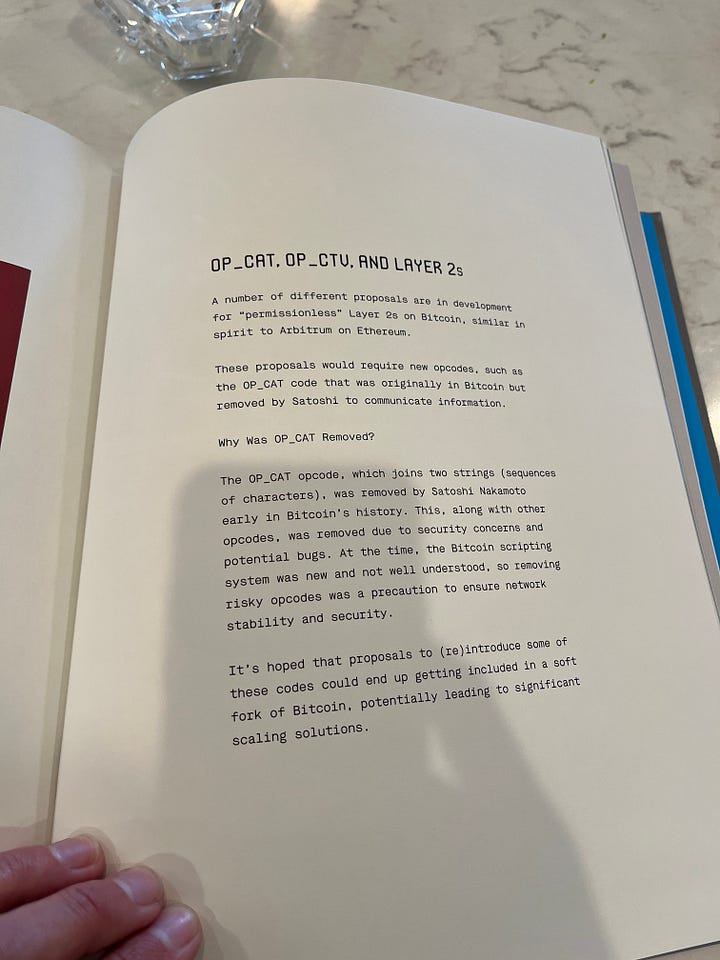
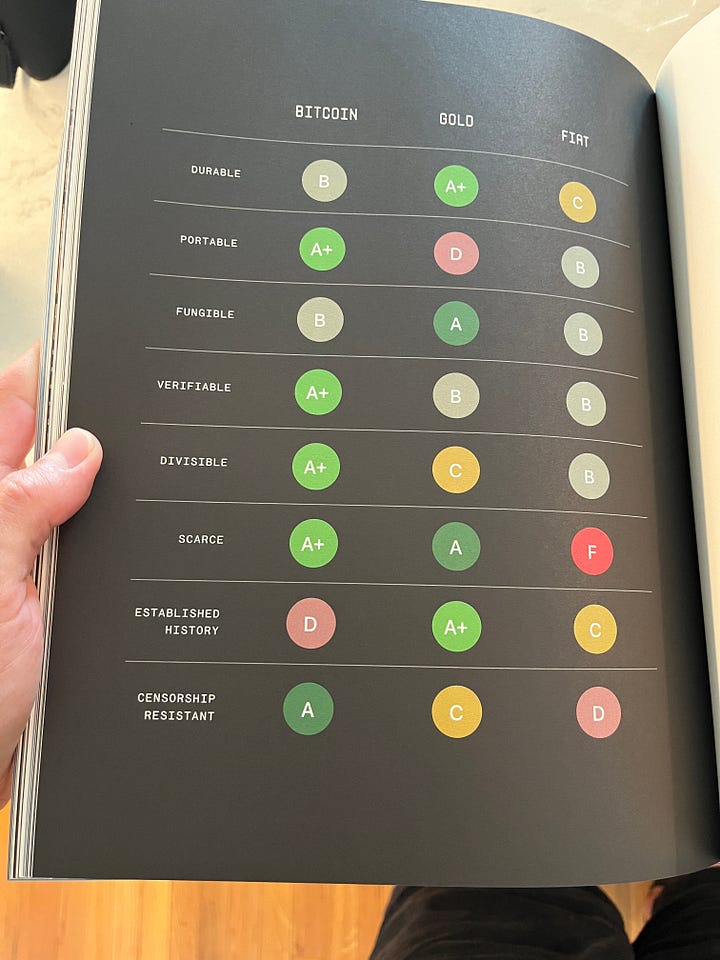

We headed upstairs to work on setting up Sparrow Wallet on their Windows machine. I verified the software download first (which you should always do), then helped them create a new wallet using their Ledger Flex. They also had an older Ledger Nano X. The Flex setup was easy, but the Nano X gave us trouble. It turns out Ledger allows multiple wallets for the same asset, which can show up differently depending on how they’re configured. In Sparrow, only one wallet showed—none of the others.
I believe it had to do with the derivation path from the Ledger. If anyone knows a fix, let me know.
After a few hours of troubleshooting, I told them I couldn’t really recommend Ledger. The UX is a mess. They’d already heard similar things from other plebs too.
I suggested switching to the Blockstream Jade. It’s a solid Bitcoin-only device from a trustworthy team. That’s what you want in a hardware wallet.
But back to the lens…
Since it’s an LTM (Leica Thread Mount), I couldn’t mount it directly on my M262. Luckily, I remembered I had an Urth adapter that fits my Fujifilm X-Pro2. I don’t use the X-Pro2 much these days—it’s mostly been sidelined by the M262 - but this was the perfect excuse to bring it out again.
To test the lens, I shot everything wide open at f/2.8. Nothing crazy fast, but it’s the best way to see a lens’s character. And this one definitely has character. There’s a subtle softness and a kind of motion blur effect around the edges when wide open. At first, I wasn’t sure how I felt about it, but the more I shot, the more I liked it. It reminds me of Winogrand’s work in Winogrand Color - those messy, shifting edges that make the frame feel alive. It also helps soften the digital-ness of the camera sensor.
The focus throw is short and snappy - much tighter than my Summicron V3 35mm f/2. I really like how fast it is to use. The closest focusing distance is about 3.5 feet, so it’s not ideal for close-ups. And with the Urth adapter on the X-Pro2, the focal length ends up closer to 40mm.
The only thing that threw me off was the infinity lock. When the focus hits infinity, it physically locks - you have to press a small tab to unlock it. I’ve seen others complain about it, so I guess it’s just one of those old lens quirks. I’m getting used to it.
All the photos here were taken around where I live in South Carolina. Some during bike rides to the river for a swim, others while walking through the marshlands.
I try to make work wherever I am. You should be able to.
It’s about the light, the rhythm, the play - and having the motivation to actually go out and shoot.
Lens rating: 7.9/10
I mainly shoot with a Leica M262, and edit in Lightroom + Dehancer
Use “PictureRoom” for 10% off Dehancer Film
If you’ve made it this far, thank you for taking the time to view my work - consider becoming a paid subscriber.
Also, please contact me if you would like to purchase any of my prints.
Follow me on Nostr:
npub1c8n9qhqzm2x3kzjm84kmdcvm96ezmn257r5xxphv3gsnjq4nz4lqelne96
-
 @ 502ab02a:a2860397
2025-05-29 01:40:28
@ 502ab02a:a2860397
2025-05-29 01:40:28เรามาดู แลคเชอร์ประวัติศาสตร์ ที่พลิกโลกแห่งการเกษตรและอาหารของมนุษย์ชาติกันครับ เรามาดูความแยบยลที่สามารถจูงใจคนมากมายให้เห็นถึงข้อดีของเนื้อจากแลบ เขาทำได้ยังไง เรามาศึกษาการสื่อสารกันครับ
เรื่องมันเริ่มจากการประชุม World Economic Forum ปี 2015 ที่ศาสตราจารย์ Mark Post นักเภสัชวิทยาชาวดัตช์ ที่เรารู้จักกันไปแล้ว ซึ่งตอนนั้นเป็นศาสตราจารย์ด้านสรีรวิทยาของหลอดเลือดอยู่ที่ Maastricht University และเป็นผู้ร่วมก่อตั้งบริษัท Mosa Meat ได้ลุกขึ้นมาเล่าเรื่อง "เนื้อเพาะเลี้ยง" หรือ cultured meat ให้คนทั้งห้องฟัง
สิ่งที่เขาพูดมันไม่ใช่แค่นวัตกรรมใหม่ แต่คือคำเตือนที่จริงจัง ว่าถ้ามนุษย์ยังผลิตเนื้อสัตว์แบบเดิม เรากำลังวิ่งเข้าใกล้ปัญหาใหญ่ที่รออยู่ข้างหน้า
ศาสตราจารย์ Post เล่าไว้ได้น่าสนใจมาก เขาบอกว่าแค่จะได้แฮมเบอร์เกอร์ 1 ชิ้นขนาดหนึ่งในสี่ปอนด์ เราต้องใช้เมล็ดธัญพืช 7 ปอนด์ ใช้น้ำจืด 50 แกลลอน และพื้นที่ดินอีก 70 ตารางฟุต นั่นแปลว่าเรากำลังเปลี่ยนของดีในธรรมชาติ ข้าว น้ำ ดิน ไปเป็นของที่กินหมดใน 10 นาที แล้วหิวใหม่ได้ในอีกครึ่งชั่วโมง
เหตุผลก็เพราะวัวมันไม่ได้แปลงโปรตีนพืชมาเป็นเนื้อได้มีประสิทธิภาพนัก พูดอีกแบบคือ มันเปลืองเกินไป
ตอนนี้พื้นที่เพาะปลูกของโลกกว่า 70% ถูกใช้ไปในการผลิตเนื้อสัตว์ คิดดูสิว่าถ้าเราหาทางที่ดีกว่านี้ได้ เราจะมีพื้นที่ว่างกลับคืนมาแค่ไหน
แถมวัวไม่ใช่แค่กินเก่งนะ ยังปล่อยก๊าซเก่งด้วย โดยเฉพาะมีเทนที่ทำให้โลกร้อนพอๆ กับอุตสาหกรรมการขนส่งเลยทีเดียว ศาสตราจารย์ Post เล่าว่า ทุกครั้งที่เขาเห็นวัวยืนเคี้ยวหญ้า เขาไม่ได้เห็นแค่วัว...แต่เห็นเมฆก๊าซมีเทนลอยมาด้วย
และที่น่าคิดคือ เมื่อรายได้ของคนในอินเดียหรือจีนสูงขึ้น พวกเขาจะกินเนื้อเพิ่มตามรายได้ ซึ่งสถิติบอกว่าภายในปี 2050 ความต้องการเนื้อสัตว์จะเพิ่มขึ้นเป็น สองเท่า จากปัจจุบัน
แต่ศาสตราจารย์ก็ไม่ได้มองว่าเนื้อเป็นปีศาจ เขาบอกว่า มนุษย์ถูกสร้างมาให้รักเนื้อ เนื้อคือสิ่งที่มาพร้อมวิวัฒนาการ เราได้พลังงานจากมัน สมองเราใหญ่ขึ้นเพราะมัน และกลายเป็นมนุษย์เพราะมัน
แม้จะมีคนอีกกว่าสองพันล้านที่เป็นมังสวิรัติ ส่วนใหญ่อาจเพราะไม่มีทางเลือก แต่อย่างน้อยพวกเขาก็อยู่รอดได้ แต่ก็ปฏิเสธไม่ได้ว่า คนที่เคยล่า เคยกินเนื้อ จะรู้สึกตื่นเต้นทุกครั้งที่ได้แบ่งเนื้อกันบนโต๊ะ
ศาสตราจารย์ Post เองก็ยังชอบกินเนื้อ แต่เขาอยากได้เนื้อที่ได้มาจากทางเลือกที่ดีกว่า ไม่ใช่ทางที่พาโลกเข้า ICU
เนื้อเพาะเลี้ยงเริ่มจากหลักการง่ายๆ ที่เรารู้มาตั้งแต่ช่วงปี 2000 ว่า ในกล้ามเนื้อของสัตว์มี สเต็มเซลล์ รอคอยจะซ่อมแซมเนื้อเยื่อหากมันได้รับบาดเจ็บ
แค่เอาชิ้นกล้ามเนื้อเล็กๆ จากวัว ขนาดแค่ 1 ซม. x 1 มม. มาแยกสเต็มเซลล์ออกมาเลี้ยงให้ขยายตัว
เฮียว่าอันนี้น่าทึ่งมาก เพราะจากตัวอย่างเล็กๆ ชิ้นเดียว สามารถผลิตเนื้อวัวได้ถึง 10,000 กิโลกรัม เลยนะ!
แปลว่าเราสามารถลดจำนวนวัวทั้งโลกจากครึ่งพันล้านตัว เหลือแค่ประมาณ 30,000 ตัวได้เลย
และถ้าให้เซลล์กล้ามเนื้อพวกนี้อยู่ในสภาพแวดล้อมที่เหมาะสม มันก็จะเริ่มสร้างกล้ามเนื้อขึ้นมาเอง โดยเฉพาะถ้าเรากระตุ้นให้มันรู้สึกเหมือนกำลัง “ออกกำลัง” อยู่ เช่น ใส่แรงตึงเข้าไป
ทีมนักวิจัยของเขาเลี้ยงเซลล์เหล่านี้ให้เติบโตในรูปวงแหวนคล้ายโดนัท ครบ 3 สัปดาห์ กล้ามเนื้อจะเริ่มหดตัว สร้างความตึง และกลายเป็นเนื้อกล้ามเนื้อแบบเต็มตัวที่ดูไม่ต่างจากกล้ามเนื้อในสเต็กจริงๆ เลย
ปี 2013 ทีมของ Mark Post ผลิตเส้นใยกล้ามเนื้อจำนวน 10,000 เส้น เอามาทำแฮมเบอร์เกอร์ และนำไปเปิดตัวในงานแถลงข่าวที่ลอนดอน เป็นเหมือนการโชว์ทำอาหารผสมกับเปิดงานวิจัย
จุดประสงค์คือจะพิสูจน์ให้โลกเห็นว่า “เฮ้ย! สิ่งนี้ไม่ใช่แค่ไอเดียลอยๆ แต่มันทำได้จริง และจำเป็นต้องทำจริงๆ เพราะเรากำลังจะเจอวิกฤต”
ราคาแฮมเบอร์เกอร์ตอนนั้นคือ 250,000 ยูโร
มีเชฟผู้กล้าปรุง และอาสาสมัครสองคนลองชิม พวกเขาบอกว่า “ก็โอเคในฐานะเบอร์เกอร์ราคาเท่านี้ แต่ก็อยากได้รสเข้มกว่านี้หน่อย” เพราะยังไม่มีไขมัน เลยรสจืดไปหน่อย
แต่ที่สำคัญคือ พวกเขายืนยันว่า “มันคือเนื้อจริงๆ” ทั้งเนื้อสัมผัสและโครงสร้าง
แค่มีต้นแบบยังไม่พอ เพราะจะทำให้ขายได้จริง ต้องผ่านด่านสำคัญ เนื้อต้องผลิตได้โดยใช้ทรัพยากรน้อยกว่าการเลี้ยงวัวจริง การประเมินเบื้องต้นจาก University of Oxford พบว่า เนื้อเพาะเลี้ยงใช้พื้นที่น้อยลง 90% น้ำลดลง 90% พลังงานลดลง 60–70%
ทุกอย่างที่ใช้ในการเลี้ยงเซลล์ต้องมีจำนวนมากพอหรือหมุนเวียนใช้ได้ ที่น่าหนักใจคือ การเลี้ยงเซลล์ต้องใช้ “ซีรั่มจากลูกวัว” ซึ่งได้มาจากเลือดวัว ถ้าลดจำนวนวัว เราก็ไม่มีซีรั่ม แต่ตอนนี้มีงานพัฒนาไปเยอะแล้ว กำลังหาวิธีทำเซลล์กล้ามเนื้อโดยไม่ต้องพึ่งซีรั่มจากสัตว์
ไม่ใช่แค่โปรตีน แต่ต้องเป็น "เนื้อ" ในทุกความรู้สึก นักวิจัยพยายามปรับสภาพแวดล้อมการเพาะเลี้ยง เช่น ความเข้มข้นของออกซิเจน เพื่อให้เซลล์แสดงโปรตีนสำคัญ เช่น myoglobin ที่ทำให้เนื้อมีสีและรสชาติเหมือนเนื้อจริง
การยอมรับของผู้บริโภคเป็นอีกด่านสำคัญที่เนื้อเพาะเลี้ยงต้องข้ามผ่านให้ได้ ไม่ใช่แค่เรื่องรสชาติหรือคุณค่าทางโภชนาการเท่านั้น แต่ยังเป็นเรื่องของ "ใจ" ที่ต้องเปิดรับสิ่งใหม่ที่ไม่คุ้นเคย ศาสตราจารย์ Post เล่าว่า ในการสำรวจผู้บริโภคในอังกฤษและเนเธอร์แลนด์ พบว่ามีคนไม่น้อยที่ยินดีจะลองกินเนื้อเพาะเลี้ยง ถึง 52% ของชาวดัตช์ และ 60% ของชาวอังกฤษเลยทีเดียว
เขาเปรียบเทียบว่า จริงๆ แล้ว คนเรายอมกินฮอทดอกโดยไม่รู้ด้วยซ้ำว่าทำมาจากอะไร หรือผ่านอะไรมาบ้าง ขอแค่มัน "อร่อย ถูก และดูปลอดภัย" ก็เพียงพอแล้วสำหรับคนส่วนใหญ่ ดังนั้นเนื้อเพาะเลี้ยงจึงไม่ต่างกันมากนัก ขอเพียงให้คนรู้สึกว่า “กินแล้วไม่ตาย” และ “ไม่ได้แปลกจนใจฝ่อ” เท่านั้นแหละ วันหนึ่งมันก็จะกลายเป็นของธรรมดาในตู้เย็นเหมือนกับโยเกิร์ตหรือไส้กรอกนั่นเอง
ในด้านของราคา แม้จะยังไม่ถูกเท่าไส้กรอกในซูเปอร์ แต่ก็ลดลงมาไกลจากจุดเริ่มต้นแบบสุดๆ จากชิ้นต้นแบบราคา 250,000 ดอลลาร์ในปี 2013 ตอนนี้ต้นทุนลดลงมาเหลือประมาณ 65 ดอลลาร์ต่อกิโลกรัม (ยังไม่รวมเทคโนโลยีล้ำหน้าอื่นๆ ที่กำลังพัฒนาอยู่) ซึ่งก็ถือว่าอยู่ในระดับเดียวกับเนื้อวากิวหรือสเต๊กเกรดพรีเมียมเลยทีเดียว เป้าหมายคือทำให้ถูกลงอีก และผลิตได้ในระดับอุตสาหกรรมให้เพียงพอกับคนทั้งโลก ไม่ใช่ของฟุ่มเฟือยสำหรับคนรวยเท่านั้น
แต่วิสัยทัศน์ที่น่าสนใจจริงๆ คือ ภาพของอนาคตที่ศาสตราจารย์ Post วาดไว้ เขาเชื่อว่าเทคโนโลยีนี้เรียบง่ายพอที่จะขยายไปสู่ครัวเรือนหรือชุมชนเล็กๆ ได้ วันหนึ่งเราอาจได้เห็นการเพาะเลี้ยงเซลล์จากหมูที่เลี้ยงอยู่ข้างบ้าน แล้วเอาไปปั่นเป็นหมูสับแบบสดใหม่ ไม่ต้องฆ่าสัตว์ ไม่ต้องส่งโรงงาน ไม่ต้องตัดต่อพันธุกรรม แค่นั่งรอเหมือนหมักแป้งเปรี้ยว แล้วได้เนื้อสดๆ มาใส่ต้มจืด
และนั่นแหละคือ "การเปลี่ยนกรอบคิดเรื่องเนื้อสัตว์" แบบพลิกฝ่ามือ
มันจะไม่ใช่เรื่องการฆ่าอีกต่อไป ไม่ใช่เรื่องของฟาร์มกลิ่นฉี่ หรือสายพานโรงฆ่าสัตว์ มันจะเป็น "ผลิตภัณฑ์ใหม่" ที่เราสร้างได้ ควบคุมได้ และปรับแต่งได้ เช่น เพิ่มโอเมก้า 3 ในเซลล์ไขมันให้สูงขึ้น หรือทำให้เนื้อไม่มีคอเลสเตอรอลเลยก็ยังได้
แม้ศาสตราจารย์ Post จะเน้นเรื่องความมั่นคงทางอาหารและผลกระทบต่อสิ่งแวดล้อมเป็นหลัก แต่เขาก็ยอมรับว่า สำหรับคนกินทั่วๆ ไป ประเด็นที่ "ไม่มีสัตว์ต้องเจ็บปวด" จะกลายเป็นจุดขายที่สำคัญในใจของผู้บริโภค
เขาเชื่อว่า เมื่อวันนั้นมาถึง วันที่เรายืนอยู่หน้าตู้แช่ในซูเปอร์ แล้วเห็นผลิตภัณฑ์สองชิ้นวางข้างกัน — หนึ่งคือเนื้อวัวที่มาจากฟาร์ม และอีกหนึ่งคือเนื้อเพาะเลี้ยงที่ไม่เคยมีวัวต้องร้องไห้แม้แต่นิดเดียว — การตัดสินใจอาจจะไม่ง่าย แต่ "จะมีคนจำนวนมากขึ้นเรื่อยๆ ที่เลือกแบบไม่ต้องฆ่า"
เพราะสุดท้าย เราไม่ได้แค่กินเนื้อ… เรากำลังกิน “ความเชื่อ” ลงไปด้วย #pirateketo #กูต้องรู้มั๊ย #ม้วนหางสิลูก #siamstr
ใครสนใจดูคลิปก็กดตรงนี้ได้ครับ https://youtu.be/1lI9AwxKfTY?si=6CDBUl2yGBoHWc-P
-
 @ 866e0139:6a9334e5
2025-05-27 10:15:17
@ 866e0139:6a9334e5
2025-05-27 10:15:17Autor: Milosz Matuschek. Dieser Beitrag wurde mit dem Pareto-Client geschrieben. Sie finden alle Texte der Friedenstaube und weitere Texte zum Thema Frieden hier. Die neuesten Pareto-Artikel finden Sie auch in unserem Telegram-Kanal.
Die neuesten Artikel der Friedenstaube gibt es jetzt auch im eigenen Friedenstaube-Telegram-Kanal.
Der Schweizer Historiker Daniele Ganser startet eine Plakataktion. Auf Facebook schreibt er:
"Dieses Plakat habe ich ab heute an sechs Bahnhöfen in der Schweiz aufhängen lassen: Die Schweiz muss die Neutralität bewahren. Keine Zusammenarbeit mit der NATO!
Die Aktion läuft eine Woche. Das Plakat hängt in Basel (Gleis 5 und 7), Zürich (Gleis 9 und 12), Bern (Gleis 3 und 11), Luzern (Gleis 7 und 11), St. Gallen (Gleis 1 und 2) und Chur (Gleis 4 und Arosabahn).
Wenn jemand ein Plakat sieht und fotografiert und es mir per Email schickt freut mich das!
https://globalbridge.ch/die-schweiz-muss-die.../
Daniele Ganser kann man über folgende Seite kontaktieren.

LASSEN SIE DER FRIEDENSTAUBE FLÜGEL WACHSEN!
Hier können Sie die Friedenstaube abonnieren und bekommen die Artikel zugesandt.
Schon jetzt können Sie uns unterstützen:
- Für 50 CHF/EURO bekommen Sie ein Jahresabo der Friedenstaube.
- Für 120 CHF/EURO bekommen Sie ein Jahresabo und ein T-Shirt/Hoodie mit der Friedenstaube.
- Für 500 CHF/EURO werden Sie Förderer und bekommen ein lebenslanges Abo sowie ein T-Shirt/Hoodie mit der Friedenstaube.
- Ab 1000 CHF werden Sie Genossenschafter der Friedenstaube mit Stimmrecht (und bekommen lebenslanges Abo, T-Shirt/Hoodie).
Für Einzahlungen in CHF (Betreff: Friedenstaube):

Für Einzahlungen in Euro:
Milosz Matuschek
IBAN DE 53710520500000814137
BYLADEM1TST
Sparkasse Traunstein-Trostberg
Betreff: Friedenstaube
Wenn Sie auf anderem Wege beitragen wollen, schreiben Sie die Friedenstaube an: friedenstaube@pareto.space
Sie sind noch nicht auf Nostr and wollen die volle Erfahrung machen (liken, kommentieren etc.)? Zappen können Sie den Autor auch ohne Nostr-Profil! Erstellen Sie sich einen Account auf Start. Weitere Onboarding-Leitfäden gibt es im Pareto-Wiki.
-
 @ b7274d28:c99628cb
2025-05-28 00:59:49
@ b7274d28:c99628cb
2025-05-28 00:59:49Your identity is important to you, right? While impersonation can be seen in some senses as a form of flattery, we all would prefer to be the only person capable of representing ourselves online, unless we intentionally delegate that privilege to someone else and maintain the ability to revoke it.
Amber does all of that for you in the context of #Nostr. It minimizes the possibility of your private key being compromized by acting as the only app with access to it, while all other Nostr apps send requests to Amber when they need something signed. This even allows you to give someone temporary authority to post as you without giving them your private key, and you retain the authority to revoke their permissions at any time.
nostr:npub1w4uswmv6lu9yel005l3qgheysmr7tk9uvwluddznju3nuxalevvs2d0jr5 has provided Android users with an incredibly powerful tool in Amber, and he continues to improve its functionality and ease of use. Indeed, there is not currently a comparative app available for iOS users. For the time being, this superpower is exclusive to Android.
Installation
Open up the Zapstore app that you installed in the previous stage of this tutorial series.
Very likely, Amber will be listed in the app collection section of the home page. If it is not, just search for "Amber" in the search bar.

Opening the app's page in the Zapstore shows that the release is signed by the developer. You can also see who has added this app to one of their collections and who has supported this app with sats by zapping the release.
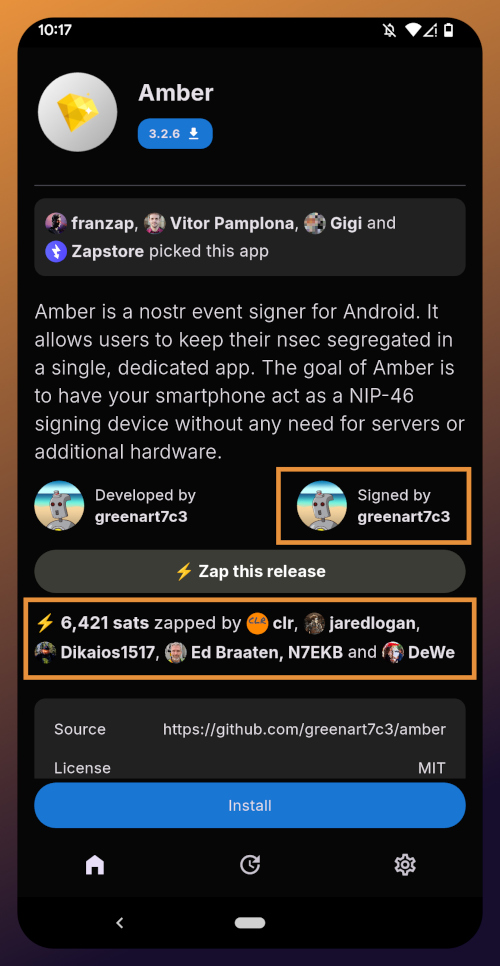
Tap "Install" and you will be prompted to confirm you are sure you want to install Amber.
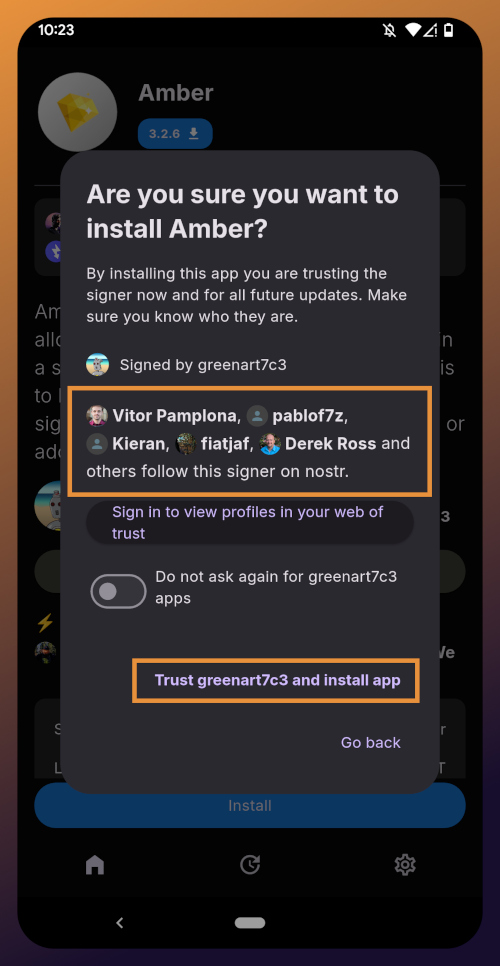
Helpfully, you are informed that several other users follow this developer on Nostr. If you have been on Nostr a while, you will likely recognize these gentlemen as other Nostr developers, one of them being the original creator of the protocol.
You can choose to never have Zapstore ask for confirmation again with apps developed by nostr:npub1w4uswmv6lu9yel005l3qgheysmr7tk9uvwluddznju3nuxalevvs2d0jr5, and since we have another of his apps to install later in this tutorial series, I recommend you toggle this on. Then tap on "Trust greenart7c3 and install app."
Just like when you installed the Zapstore from their GitHub, you will be prompted to allow the Zapstore to install apps, since Android considers it an "unknown source."
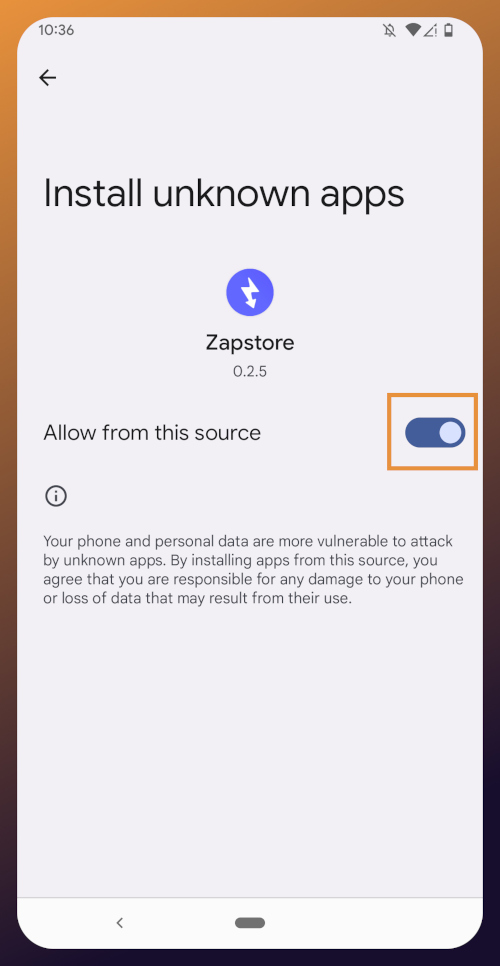
Once you toggle this on and use the back button to get back to the Zapstore, Amber will begin downloading and then present a prompt to install the app. Once installed, you will see a prompt that installation was a success and you can now open the app.

From here, how you proceed will depend on whether you need to set up a new Nostr identity or use Amber with an existing private key you already have set up. The next section will cover setting up a new Nostr identity with Amber. Skip to the section titled "Existing Nostrich" if you already have an nsec that you would like to use with Amber.
New Nostrich
Upon opening the application, you will be presented with the option to use an existing private key or create a new Nostr account. Nostr doesn't really have "accounts" in the traditional sense of the term. Accounts are a relic of permissioned systems. What you have on Nostr are keys, but Amber uses the "account" term because it is a more familiar concept, though it is technically inaccurate.

Choose "Create a new Nostr account" and you will be presented with a screen telling you that your Nostr account is ready. Yes, it was really that easy. No email, no real name, no date of birth, and no annoying capcha. Just "Create a new account" and you're done.
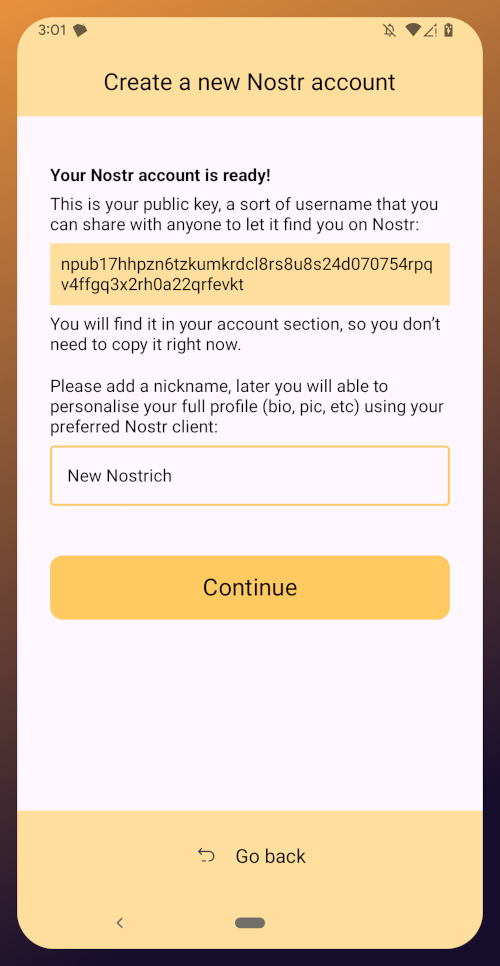
The app presents you with your public key. This is like an address that can be used to find your posts on Nostr. It is 100% unique to you, and no one else can post a note that lists this npub as the author, because they won't have the corresponding private key. You don't need to remember your npub, though. You'll be able to readily copy it from any Nostr app you use whenever you need it.
You will also be prompted to add a nickname. This is just for use within Amber, since you can set up multiple profiles within the app. You can use anything you want here, as it is just so you can tell which profile is which when switching between them in Amber.
Once you've set your nickname, tap on "Continue."
The next screen will ask you what Amber's default signing policy should be.
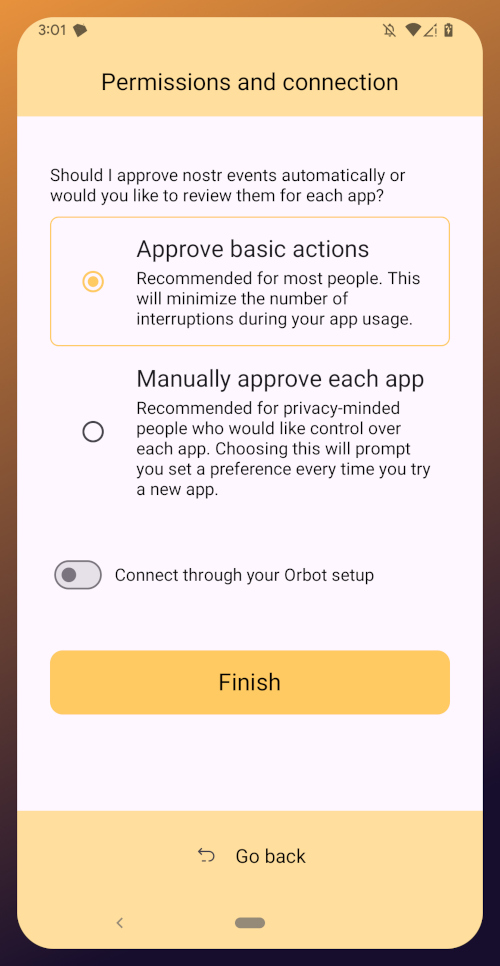
The default is to approve basic actions, referring to things that are common for Nostr clients to request a signature for, like following another user, liking a post, making a new post, or replying. If you are more concerned about what Amber might be signing for on your behalf, you can tell it to require manual approval for each app.
Once you've made your decision, tap "Finish." You will also be able to change this selection in the app settings at any time.
With this setup out of the way, you are now presented with the main "Applications" page of the app.
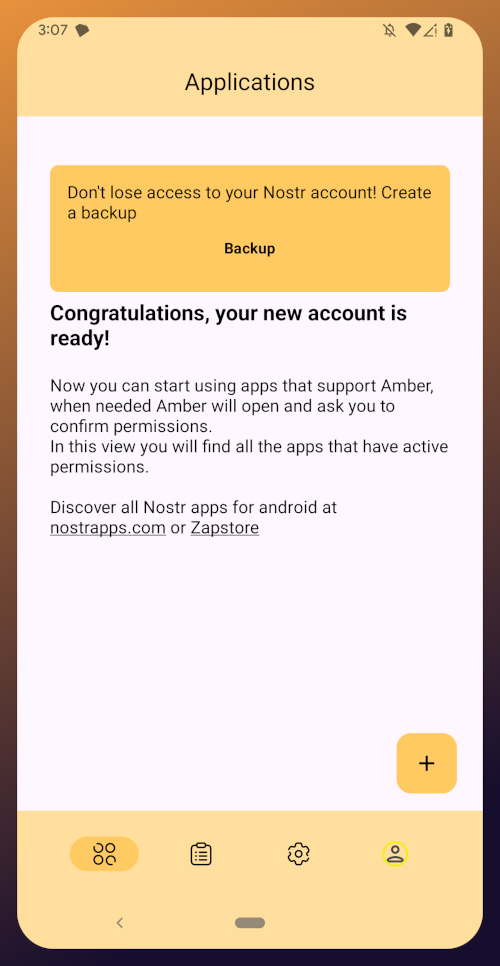
At the top, you have a notification encouraging you to create a backup. Let's get that taken care of now by tapping on the notification and skipping down to the heading titled "Backing Up Your Identity" in this tutorial.
Existing Nostrich
Upon opening the application, you will be presented with the option to use your private key or create a new Nostr account. Choose the former.

The next screen will require you to paste your private key.
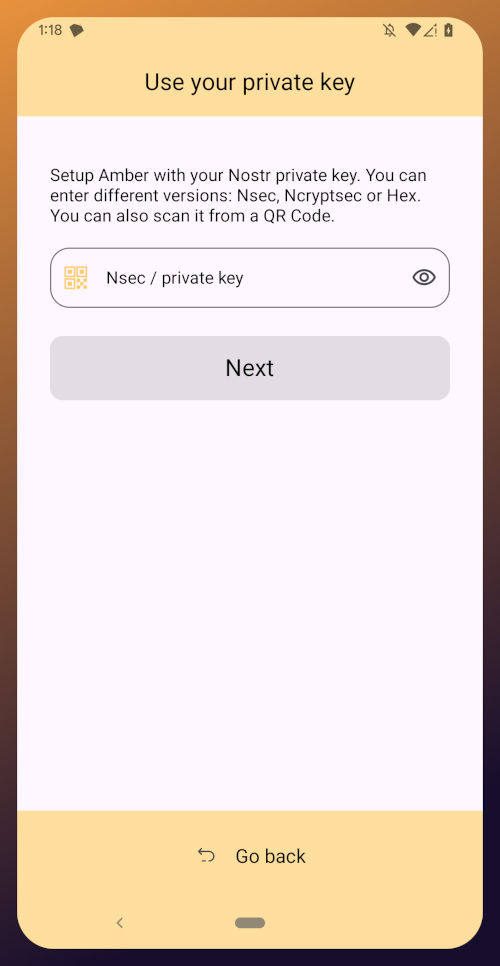
You will need to obtain this from whatever Nostr app you used to create your profile, or any other Nostr app that you pasted your nsec into in the past. Typically you can find it in the app settings and there will be a section mentioning your keys where you can copy your nsec. For instance, in Primal go to Settings > Keys > Copy private key, and on Amethyst open the side panel by tapping on your profile picture in the top-left, then Backup Keys > Copy my secret key.
After pasting your nsec into Amber, tap "Next."

Amber will give you a couple options for a default signing policy. The default is to approve basic actions, referring to things that are common for Nostr clients to request a signature for, like following another user, liking a post, making a new post, or replying. If you are more concerned about what Amber might be signing for on your behalf, you can tell it to require manual approval for each app.
Once you've made your decision, tap "Finish." You will also be able to change this selection in the app settings at any time.
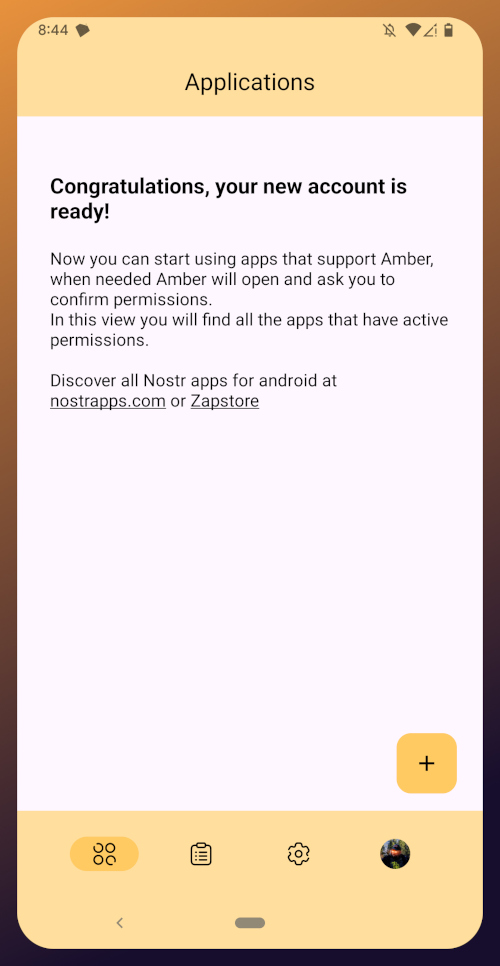
With this setup out of the way, you are now presented with the main "Applications" page of the app. You have nothing here yet, since you haven't used Amber to log into any Nostr apps, but this will be where all of the apps you have connected with Amber will be listed, in the order of the most recently used at the top.
Before we go and use Amber to log into an app, though, let's make sure we've created a backup of our private key. You pasted your nsec into Amber, so you could just save that somewhere safe, but Amber gives you a few other options as well. To find them, you'll need to tap the cog icon at the bottom of the screen to access the settings, then select "Backup Keys."

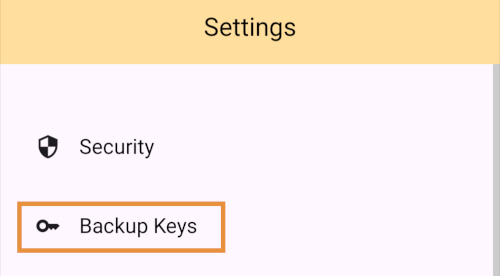
Backing Up Your Identity

You'll notice that Amber has a few different options for backing up your private key that it can generate.
First, it can give you seed words, just like a Bitcoin seed. If you choose that option, you'll be presented with 12 words you can record somewhere safe. To recover your Nostr private key, you just have to type those words into a compatible application, such as Amber.
The next option is to just copy the secret/private key in its standard form as an "nsec." This is the least secure way to store it, but is also the most convenient, since it is simple to paste into another signer application. If you want to be able to log in on a desktop web app, the browser extension Nostr signers won't necessarily support entering your 12 word seed phrase, but they absolutely will support pasting in your nsec.
You can also display a QR code of your private key. This can be scanned by Amber signer on another device for easily transferring your private key to other devices you want to use it on. Say you have an Android tablet in addition to your phone, for instance. Just make sure you only use this function where you can be certain that no one will be able to get a photograph of that QR code. Once someone else has your nsec, there is no way to recover it. You have to start all over on Nostr. Not a big deal at this point in your journey if you just created a Nostr account, but if you have been using Nostr for a while and have built up a decent amount of reputation, it could be much more costly to start over again.
The next options are a bit more secure, because they require a password that will be used to encrypt your private key. This has some distinct advantages, and a couple disadvantages to be aware of. Using a password to encrypt your private key will give you what is called an ncryptsec, and if this is leaked somehow, whoever has it will not necessarily have access to post as you on Nostr, the way they would if your nsec had been leaked. At least, not so long as they don't also have your password. This means you can store your ncryptsec in multiple locations without much fear that it will be compromised, so long as the password you used to encrypt it was a strong and unique one, and it isn't stored in the same location. Some Nostr apps support an ncryptsec for login directly, meaning that you have the option to paste in your ncryptsec and then just log in with the password you used to encrypt it from there on out. However, now you will need to keep track of both your ncryptsec and your password, storing both of them safely and separately. Additionally, most Nostr clients and signer applications do not support using an ncryptsec, so you will need to convert it back to a standard nsec (or copy the nsec from Amber) to use those apps.
The QR option using an ncryptsec is actually quite useful, though, and I would go this route when trying to set up Amber on additional devices, since anyone possibly getting a picture of the QR code is still not going to be able to do anything with it, unless they also get the password you used to encrypt it.
All of the above options will require you to enter the PIN you set up for your device, or biometric authentication, just as an additional precaution before displaying your private key to you.
As for what "store it in a safe place" looks like, I highly recommend a self-hosted password manager, such as Vaultwarden+Bitwarden or KeePass. If you really want to get wild, you can store it on a hardware signing device, or on a steel seed plate.
Additional Settings

Amber has some additional settings you may want to take advantage of. First off, if you don't want just anyone who has access to your phone to be able to approve signing requests, you can go into the Security settings add a PIN or enable biometrics for signing requests. If you enable the PIN, it will be separate from the PIN you use to access your phone, so you can let someone else use your phone, like your child who is always begging to play a mobile game you have installed, without worrying that they might have access to your Nostr key to post on Amethyst.
Amber also has some relay settings. First are the "Active relays" which are used for signing requests sent to Amber remotely from Nostr web apps. This is what enables you to use Amber on your phone to log into Nostr applications on your desktop web browser, such as Jumble.social, Coracle.social, or Nostrudel.ninja, eliminating your need to use any other application to store your nsec whatsoever. You can leave this relay as the default, or you can add other relays you want to use for signing requests. Just be aware, not all relays will accept the notes that are used for Nostr signing requests, so make sure that the relay you want to use does so. In fact, Amber will make sure of this for you when you type in the relay address.
The next type of relays that you can configure in Amber are the "Default profile relays." These are used for reading your profile information. If you already had a Nostr identity that you imported to Amber, you probably noticed it loaded your profile picture and display name, setting the latter as your nickname in Amber. These relays are where Amber got that information from. The defaults are relay.nostr.band and purplepag.es. The reason for this is because they are aggregators that look for Nostr profiles that have been saved to other relays on the network and pull them in. Therefore, no matter what other relay you may save your profile to, Amber will likely be able to find it on one of those two relays as well. If you have a relay you know you will be saving your Nostr profiles to, you may want to add it to this list.
You can also set up Amber to be paired with Orbot for signing over Tor using relays that are only accessible via the Tor network. That is an advanced feature, though, and well beyond the scope of this tutorial.
Finally, you can update the default signing policy. Maybe after using Amber for a while, you've decided that the choice you made before was too strict or too lenient. You can change it to suit your needs.
Zapstore Login
Now that you are all set up with Amber, let's get you signed into your first Nostr app by going back to the Zapstore.
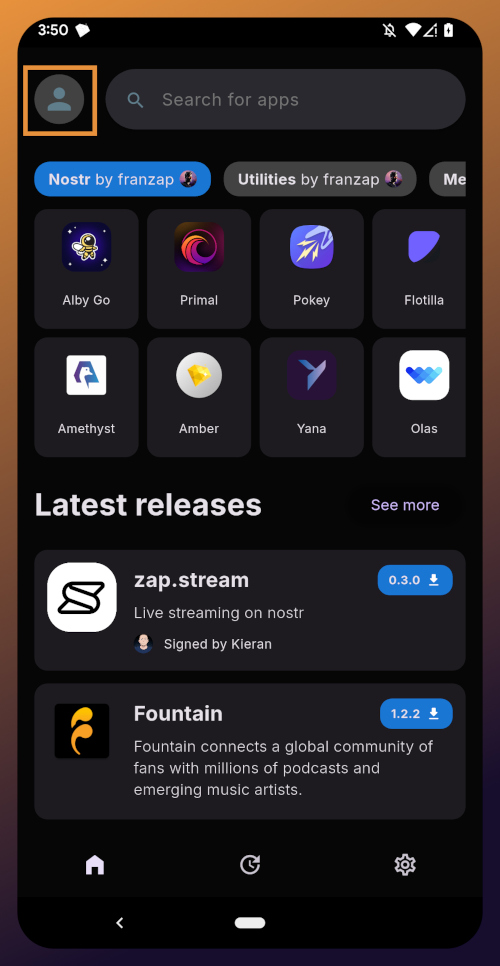
From the app's home screen, tap on the user icon in the upper left of the screen. This will open a side panel with not much on it except the option to "sign in." Go ahead and tap on it.
You will be presented with the option to either sign in with Amber, or to paste your npub. However, if you do the latter, you will only have read access, meaning you cannot zap any of the app releases. There are other features planned for the Zapstore that may also require you to be signed in with write access, so go ahead and choose to log in with Amber.
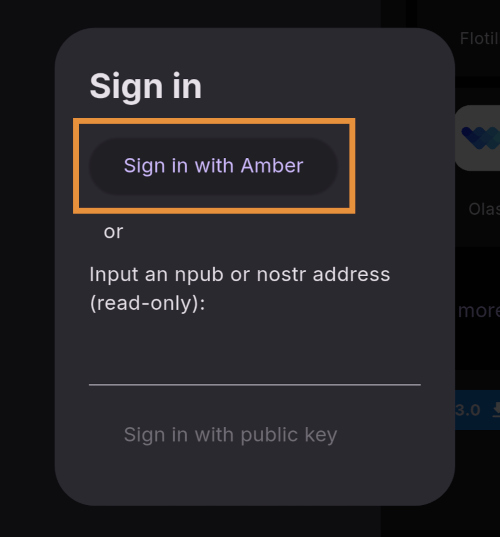
Your phone should automatically switch to Amber to approve the sign-in request.
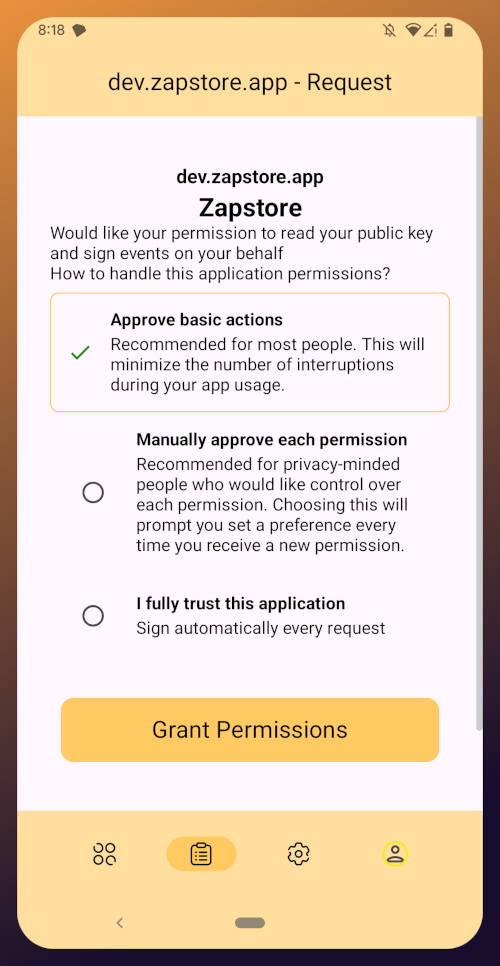
You can choose to only approve basic actions for Zapstore, require it to manually approve every time, or you can tell it that you "fully trust this application." Only choose the latter option with apps you have used for a while and they have never asked you to sign for anything suspicious. For the time being, I suggest you use the "Approve basic actions" option and tap "Grant Permissions."
Your phone will switch back to the Zapstore and will show that you are now signed in. Congratulations! From here on out, logging into most Nostr applications will be as easy as tapping on "Log in with Amber" and approving the request.

If you set up a new profile, it will just show a truncated version of your npub rather than the nickname you set up earlier. That's fine. You'll have an opportunity to update your Nostr profile in the next tutorial in this series and ensure that it is spread far and wide in the network, so the Zapstore will easily find it.
That concludes the tutorial for Amber. While we have not covered using Amber to log into Nostr web apps, that is outside the scope of this series, and I will cover it in an upcoming tutorial regarding using Amber's remote signer options in detail.
Since you're already hanging out in the Zapstore, you may as well stick around, because we will be using it right out the gate in the next part of this series: Amethyst Installation and Setup. (Coming Soon)
-
 @ dfa02707:41ca50e3
2025-05-29 03:01:31
@ dfa02707:41ca50e3
2025-05-29 03:01:31News
- Bitcoin mining centralization in 2025. According to a blog post by b10c, Bitcoin mining was at its most decentralized in May 2017, with another favorable period from 2019 to 2022. However, starting in 2023, mining has become increasingly centralized, particularly due to the influence of large pools like Foundry and the use of proxy pooling by entities such as AntPool.

Source: b10c's blog.
- OpenSats announces the eleventh wave of Nostr grants. The five projects in this wave are the mobile live-streaming app Swae, the Nostr-over-ham-radio project HAMSTR, Vertex—a Web-of-Trust (WOT) service for Nostr developers, Nostr Double Ratchet for end-to-end encrypted messaging, and the Nostr Game Engine for building games and applications integrated with the Nostr ecosystem.
- New Spiral grantee: l0rinc. In February 2024, l0rinc transitioned to full-time work on Bitcoin Core. His efforts focus on performance benchmarking and optimizations, enhancing code quality, conducting code reviews, reducing block download times, optimizing memory usage, and refactoring code.
- Project Eleven offers 1 BTC to break Bitcoin's cryptography with a quantum computer. The quantum computing research organization has introduced the Q-Day Prize, a global challenge that offers 1 BTC to the first team capable of breaking an elliptic curve cryptographic (ECC) key using Shor’s algorithm on a quantum computer. The prize will be awarded to the first team to successfully accomplish this breakthrough by April 5, 2026.
- Unchained has launched the Bitcoin Legacy Project. The initiative seeks to advance the Bitcoin ecosystem through a bitcoin-native donor-advised fund platform (DAF), investments in community hubs, support for education and open-source development, and a commitment to long-term sustainability with transparent annual reporting.
- In its first year, the program will provide support to Bitcoin hubs in Nashville, Austin, and Denver.
- Support also includes $50,000 to the Bitcoin Policy Institute, a $150,000 commitment at the University of Austin, and up to $250,000 in research grants through the Bitcoin Scholars program.
"Unchained will match grants 1:1 made to partner organizations who support Bitcoin Core development when made through the Unchained-powered bitcoin DAF, up to 1 BTC," was stated in a blog post.
- Block launched open-source tools for Bitcoin treasury management. These include a dashboard for managing corporate bitcoin holdings and provides a real-time BTC-to-USD price quote API, released as part of the Block Open Source initiative. The company’s own instance of the bitcoin holdings dashboard is available here.
Source: block.xyz
- Bull Bitcoin expands to Mexico, enabling anyone in the country to receive pesos from anywhere in the world straight from a Bitcoin wallet. Additionally, users can now buy Bitcoin with a Mexican bank account.
"Bull Bitcoin strongly believes in Bitcoin’s economic potential in Mexico, not only for international remittances and tourism, but also for Mexican individuals and companies to reclaim their financial sovereignty and protect their wealth from inflation and the fragility of traditional financial markets," said Francis Pouliot, Founder and CEO of Bull Bitcoin.
- Corporate bitcoin holdings hit a record high in Q1 2025. According to Bitwise, public companies' adoption of Bitcoin has hit an all-time high. In Q1 2025, these firms collectively hold over 688,000 BTC, marking a 16.11% increase from the previous quarter. This amount represents 3.28% of Bitcoin's fixed 21 million supply.

Source: Bitwise.
- The Bitcoin Bond Company for institutions has launched with the aim of acquiring $1 trillion in Bitcoin over 21 years. It utilizes secure, transparent, and compliant bond-like products backed by Bitcoin.
- The U.S. Senate confirmed Paul Atkins as Chair of the Securities and Exchange Commission (SEC). At his confirmation hearing, Atkins emphasized the need for a clear framework for digital assets. He aims to collaborate with the CFTC and Congress to address jurisdiction and rulemaking gaps, aligning with the Trump administration's goal to position the U.S. as a leader in Bitcoin and blockchain finance.
- Ethereum developer Virgil Griffith has been released from custody. Griffith, whose sentence was reduced to 56 months, is now seeking a pardon. He was initially sentenced to 63 months for allegedly violating international sanctions laws by providing technical advice on using cryptocurrencies and blockchain technology to evade sanctions during a presentation titled 'Blockchains for Peace' in North Korea.
- No-KYC exchange eXch to close down under money laundering scrutiny. The privacy-focused cryptocurrency trading platform said it will cease operations on May 1. This decision follows allegations that the platform was used by North Korea's Lazarus Group for money laundering. eXch revealed it is the subject of an active "transatlantic operation" aimed at shutting down the platform and prosecuting its team for "money laundering and terrorism."
- Blockstream combats ESP32 FUD concerning Jade signers. The company stated that after reviewing the vulnerability disclosed in early March, Jade was found to be secure. Espressif Systems, the designer of the ESP32, has since clarified that the "undocumented commands" do not constitute a "backdoor."
- Bank of America is lobbying for regulations that favor banks over tech firms in stablecoin issuance. The bank's CEO Brian Moynihan is working with groups such as the American Bankers Association to advance the issuance of a fully reserved, 1:1 backed "Bank of America coin." If successful, this could limit stablecoin efforts by non-banks like Tether, Circle, and others, reports The Block.
- Tether to back OCEAN Pool with its hashrate. "As a company committed to financial freedom and open access, we see supporting decentralization in Bitcoin mining as essential to the network’s long-term integrity," said Tether CEO Paolo Ardoino.
- Bitdeer to expand its self-mining operations to navigate tariffs. The Singapore-based mining company is advancing plans to produce machines in the U.S. while reducing its mining hardware sales. This response is in light of increasing uncertainties related to U.S. trade policy, as reported by Bloomberg.
- Tether acquires $32M in Bitdeer shares. The firm has boosted its investment in Bitdeer during a wider market sell-off, with purchases in early to mid-April amounting to about $32 million, regulatory filings reveal.
- US Bitcoin miner manufacturer Auradine has raised $153 million in a Series C funding round as it expands into AI infrastructure. The round was led by StepStone Group and included participation from Maverick Silicon, Premji Invest, Samsung Catalyst Fund, Qualcomm Ventures, Mayfield, MARA Holdings, GSBackers, and other existing investors. The firm raised to over $300 million since its inception in 2022.
- Voltage has partnered with BitGo to [enable](https://www.voltage.cloud/blog/bitgo-and-voltage-team-up-to-deliver-instant-bitcoin-and-stabl
-
 @ e9d7ed6f:f52b3346
2025-05-28 23:36:58
@ e9d7ed6f:f52b3346
2025-05-28 23:36:58I'd like to toss it off by thanking you my reader, friends, associates, strangers, bitcoiners, cryptonaires, economists, and critics from all walks of life for granting me this opportunity to write to you. yeah?...
Is that readable? Is there enough ink in this pen to write? Let me squash and develop a fresh script!
Okay now, that was one heck of a disaster introduction my friends.
That's not even the way Satoshi introduced his White paper back in 2008, or rather mined his first block. So dear reader, lets pretend this introduction never happened lets give it one more kick start.
Alright we are set so here we go...
Flavatos, Gateway Mall, the left ventricle of Lilongwe's heart, Malawi is where the aroma of a fresh bitcoin pizza sent waves of spattering energy, broadcasting to all nodes over the bitcoin network. Pizza crums spread over the table, folks and knives faced opposite directions, tomato sauce on the white plate had contours of pizza passage, a half baked joke & its laughter could be heard by passersby's heading inside the mall. It was chilly Saturday afternoon from outside but the soft drinks were a must to soften the well baked fragments of pizza which were being churned. All thanks to Larszlo Keyckenes. Phones where right on the table as the photographer snapped every detail of moment with his camera, trying to paint a bitcoin Monalisa, innocence was in the youthful energetic bitcoiners who filled left to right seats in pairs. Three tables were joined together making a table tennis appear short, but the waitress had to check for any empty slot to squeeze a chair in. We were twenty three with the expection of thirty but the space was just plentiful.
Flavatos was ready and set. The waitress again, with a smile of welcoming a guest whispered right besides where i was standing that the pizza is ready, but i had to HODL for a moment, we were just setting up the laptop which we would use to connect & listen to a presentation by John Miller, a distant relative and a bitcoiner we had talked of for weeks. As if am very good at analysing charts, the looks of the faces were eagerly waiting and i when i looked on my wrist i realised we didn't have much more time other than to start off, so i clapped my hands to capture everyones attention. I was excited to welcome all & really appreciate for sparing their time to come.
There was buzz in the atmosphere, all eyes glued to me as i thanked the cofounder Grant for pulling the strings, in our presence we had the cofounder of women of Satoshi Yankho who i was facing directly to my right hand side and threw me sparkle of acknowledgement, i couldn't forget & sweep under the mat, John Miller sponsor for the Bitcoin Pizza who is currently in the US & was waiting to deliver a speech on this very moment. All started off in the right order, my stomach tuned as my brain signaled the pizza image, sending tickling hunger sensation, so not to keep everyone waiting longer, i handed it over to Grant who quickly threw like free shot on the free throw line. There was genuine appreciation and he set the floor ready for John Miller to grace and unwrap the Pizza. When John took on the google meet space, we all fixed to our phones, eager to see John who was seven hours away from us, about two or three plane tickets to get where he was physically located. John delivered a twenty minute presentation that would make a fresh graduate take off his hat and really consider what they did the last four years of their university. There was a lot of knowledge on his presentation, highlighting the eminent nails to the coffin for US dollar, the chart and numbers didn't lie when he displayed how the purchasing power of the dollar has declined since 1971 post detachment from gold. He spoke with authority on why bitcoin, how Bitcoiners should continue orange pilling and detoxing all the pool of confusion of the current FIAT sytem. It was listening to wisdom of an old man, giving the torch to the young ones. The waitress had brought to the table clean white plates with some folks wrapped in a white napkin tissue that appeared so white as Satoshi's white paper. In no time the pizza was ready to bona petite, John wrapped up in a cousy style by saying, "keep stacking Sats and avoiding shitcoins. The attendees were in pairs and hands were rubbing, contemplating of how the first bite would feel. The enzymes were ready to digest. The next host, who happens to be the writer of this article had to take the floor and give short remarks to thank John, Grant and everyone. I saw the pizza being cut into slices, whilst others took sips of their favorite soft drinks, there were smiles from left to right check. The sound chewing was amplified, triggering my ear drums to some vibe. This was was a big family reunion. My signal for speaking almost went off as the aroma teased the mind, i saw the bubble from the fanta bottle float up but i was mature to handled the temper of my hunger. As the pizza halvening was going on, I reminded of how significant this moment was when Larszlo Heykens first made an offer of 10,000 BTC & how it signified use case of bitcoin as a medium of exchange and a resort of finality between two counterparts without any middleman. It surely was moment that reminded us of the free markets. Where two counterparts chose their own commodities of exchange and each left satisfied as finality of transactions. Truly those were the good old free market days. By the time i said goodbye, my counterparts had already mined half of the pizza brought. I was about to pop a question of where is my share when i saw three more full plates of pizza broadcasted & awaiting for verification. I knew i was in for a treat.
As i kept my hands, mouth and tummy busy, one surprising moment really fired me up with excitement. Grant stood up and surprised everyone by introducing his new friend from Kenya. He said they had met in Mulanje and how they came across each other was purely a barter coincidence of wants. Rather him explaining, he let our new Kenyan explorer share the fascinating story of how he wanted to send funds in Kenya but couldn't find means of transalating our local currency into the Kenyan shilling. So how could these two opposite worlds tie together? When he saw the post of bitcoin accepted here, it sparked the charge. Using Bitcoin, he was able to send funds in Kenya via bitcoin lightening wallet through Tando and Mpesa. As if we were in a cinema watching possibilities become realities, a demostration was showcased how inter transactions are done from a wallet of Satoshi lightening wallet to Tando whilst eating pizza in Malawi.
It was truly a fantastic orange day to pill and slice. See you in the next article as i continue to polish my writing skills.
Pacharo Nyirenda. Bitcoinboma An amature writer but soon to be pro writer & blogger!
-
 @ 39cc53c9:27168656
2025-05-27 09:21:51
@ 39cc53c9:27168656
2025-05-27 09:21:51Know Your Customer is a regulation that requires companies of all sizes to verify the identity, suitability, and risks involved with maintaining a business relationship with a customer. Such procedures fit within the broader scope of anti-money laundering (AML) and counterterrorism financing (CTF) regulations.
Banks, exchanges, online business, mail providers, domain registrars... Everyone wants to know who you are before you can even opt for their service. Your personal information is flowing around the internet in the hands of "god-knows-who" and secured by "trust-me-bro military-grade encryption". Once your account is linked to your personal (and verified) identity, tracking you is just as easy as keeping logs on all these platforms.
Rights for Illusions
KYC processes aim to combat terrorist financing, money laundering, and other illicit activities. On the surface, KYC seems like a commendable initiative. I mean, who wouldn't want to halt terrorists and criminals in their tracks?
The logic behind KYC is: "If we mandate every financial service provider to identify their users, it becomes easier to pinpoint and apprehend the malicious actors."
However, terrorists and criminals are not precisely lining up to be identified. They're crafty. They may adopt false identities or find alternative strategies to continue their operations. Far from being outwitted, many times they're several steps ahead of regulations. Realistically, KYC might deter a small fraction – let's say about 1% ^1 – of these malefactors. Yet, the cost? All of us are saddled with the inconvenient process of identification just to use a service.
Under the rhetoric of "ensuring our safety", governments and institutions enact regulations that seem more out of a dystopian novel, gradually taking away our right to privacy.
To illustrate, consider a city where the mayor has rolled out facial recognition cameras in every nook and cranny. A band of criminals, intent on robbing a local store, rolls in with a stolen car, their faces obscured by masks and their bodies cloaked in all-black clothes. Once they've committed the crime and exited the city's boundaries, they switch vehicles and clothes out of the cameras' watchful eyes. The high-tech surveillance? It didn’t manage to identify or trace them. Yet, for every law-abiding citizen who merely wants to drive through the city or do some shopping, their movements and identities are constantly logged. The irony? This invasive tracking impacts all of us, just to catch the 1% ^1 of less-than-careful criminals.
KYC? Not you.
KYC creates barriers to participation in normal economic activity, to supposedly stop criminals. ^2
KYC puts barriers between many users and businesses. One of these comes from the fact that the process often requires multiple forms of identification, proof of address, and sometimes even financial records. For individuals in areas with poor record-keeping, non-recognized legal documents, or those who are unbanked, homeless or transient, obtaining these documents can be challenging, if not impossible.
For people who are not skilled with technology or just don't have access to it, there's also a barrier since KYC procedures are mostly online, leaving them inadvertently excluded.
Another barrier goes for the casual or one-time user, where they might not see the value in undergoing a rigorous KYC process, and these requirements can deter them from using the service altogether.
It also wipes some businesses out of the equation, since for smaller businesses, the costs associated with complying with KYC norms—from the actual process of gathering and submitting documents to potential delays in operations—can be prohibitive in economical and/or technical terms.
You're not welcome
Imagine a swanky new club in town with a strict "members only" sign. You hear the music, you see the lights, and you want in. You step up, ready to join, but suddenly there's a long list of criteria you must meet. After some time, you are finally checking all the boxes. But then the club rejects your membership with no clear reason why. You just weren't accepted. Frustrating, right?
This club scenario isn't too different from the fact that KYC is being used by many businesses as a convenient gatekeeping tool. A perfect excuse based on a "legal" procedure they are obliged to.
Even some exchanges may randomly use this to freeze and block funds from users, claiming these were "flagged" by a cryptic system that inspects the transactions. You are left hostage to their arbitrary decision to let you successfully pass the KYC procedure. If you choose to sidestep their invasive process, they might just hold onto your funds indefinitely.
Your identity has been stolen
KYC data has been found to be for sale on many dark net markets^3. Exchanges may have leaks or hacks, and such leaks contain very sensitive data. We're talking about the full monty: passport or ID scans, proof of address, and even those awkward selfies where you're holding up your ID next to your face. All this data is being left to the mercy of the (mostly) "trust-me-bro" security systems of such companies. Quite scary, isn't it?
As cheap as $10 for 100 documents, with discounts applying for those who buy in bulk, the personal identities of innocent users who passed KYC procedures are for sale. ^3
In short, if you have ever passed the KYC/AML process of a crypto exchange, your privacy is at risk of being compromised, or it might even have already been compromised.
(they) Know Your Coins
You may already know that Bitcoin and most cryptocurrencies have a transparent public blockchain, meaning that all data is shown unencrypted for everyone to see and recorded forever. If you link an address you own to your identity through KYC, for example, by sending an amount from a KYC exchange to it, your Bitcoin is no longer pseudonymous and can then be traced.
If, for instance, you send Bitcoin from such an identified address to another KYC'ed address (say, from a friend), everyone having access to that address-identity link information (exchanges, governments, hackers, etc.) will be able to associate that transaction and know who you are transacting with.
Conclusions
To sum up, KYC does not protect individuals; rather, it's a threat to our privacy, freedom, security and integrity. Sensible information flowing through the internet is thrown into chaos by dubious security measures. It puts borders between many potential customers and businesses, and it helps governments and companies track innocent users. That's the chaos KYC has stirred.
The criminals are using stolen identities from companies that gathered them thanks to these very same regulations that were supposed to combat them. Criminals always know how to circumvent such regulations. In the end, normal people are the most affected by these policies.
The threat that KYC poses to individuals in terms of privacy, security and freedom is not to be neglected. And if we don’t start challenging these systems and questioning their efficacy, we are just one step closer to the dystopian future that is now foreseeable.
Edited 20/03/2024 * Add reference to the 1% statement on Rights for Illusions section to an article where Chainalysis found that only 0.34% of the transaction volume with cryptocurrencies in 2023 was attributable to criminal activity ^1
-
 @ 005bc4de:ef11e1a2
2025-05-28 09:05:10
@ 005bc4de:ef11e1a2
2025-05-28 09:05:10
BIP-2,100,000,000,000,000,000
So, you're telling me...
- 21 million bitcoins is out, and...
- 2.1 quadrillion sats is in, except that...
- sats are out, so...
- 2.1 quadrillion bitcoins is in, except that...
- there are actually millisats, but...
- millisats are out, so...
- millibitcoins are in, so now...
- there are 2.1 quintillion millibitcoins, except that...
- millibitcoins are the basic base unit of bitcoin, so...
- millibitcoins are out, and now...
- 2.1 quintillion bitcoins are in

-
 @ c1e9ab3a:9cb56b43
2025-05-27 16:19:06
@ c1e9ab3a:9cb56b43
2025-05-27 16:19:06Star Wars is often viewed as a myth of rebellion, freedom, and resistance to tyranny. The iconography—scrappy rebels, totalitarian stormtroopers, lone smugglers—suggests a deep anti-authoritarian ethos. Yet, beneath the surface, the narrative arc of Star Wars consistently affirms the necessity, even sanctity, of central authority. This blog entry introduces the question: Is Star Wars fundamentally a celebration of statism?
Rebellion as Restoration, Not Revolution
The Rebel Alliance’s mission is not to dismantle centralized power, but to restore the Galactic Republic—a bureaucratic, centrally governed institution. Characters like Mon Mothma and Bail Organa are high-ranking senators, not populist revolutionaries. The goal is to remove the corrupt Empire and reinstall a previous central authority, presumed to be just.
- Rebels are loyalists to a prior state structure.
- Power is not questioned, only who wields it.
Jedi as Centralized Moral Elites
The Jedi, often idealized as protectors of peace, are unelected, extra-legal enforcers of moral and military order. Their authority stems from esoteric metaphysical abilities rather than democratic legitimacy.
- They answer only to their internal Council.
- They are deployed by the Senate, but act independently of civil law.
- Their collapse is depicted as tragic not because they were unaccountable, but because they were betrayed.
This positions them as a theocratic elite, not spiritual anarchists.
Chaos and the Frontier: The Case of the Cantina
The Mos Eisley cantina, often viewed as a symbol of frontier freedom, reveals something darker. It is: - Lawless - Violent - Culturally fragmented
Conflict resolution occurs through murder, not mediation. Obi-Wan slices off a limb; Han shoots first—both without legal consequence. There is no evidence of property rights, dispute resolution, or voluntary order.
This is not libertarian pluralism—it’s moral entropy. The message: without centralized governance, barbarism reigns.
The Mythic Arc: Restoration of the Just State
Every trilogy in the saga returns to a single theme: the fall and redemption of legitimate authority.
- Prequels: Republic collapses into tyranny.
- Originals: Rebels fight to restore legitimate order.
- Sequels: Weak governance leads to resurgence of authoritarianism; heroes must reestablish moral centralism.
The story is not anti-state—it’s anti-bad state. The solution is never decentralization; it’s the return of the right ruler or order.
Conclusion: The Hidden Statism of a Rebel Myth
Star Wars wears the costume of rebellion, but tells the story of centralized salvation. It: - Validates elite moral authority (Jedi) - Romanticizes restoration of fallen governments (Republic) - Portrays decentralized zones as corrupt and savage (outer rim worlds)
It is not an anarchist parable, nor a libertarian fable. It is a statist mythology, clothed in the spectacle of rebellion. Its core message is not that power should be abolished, but that power belongs to the virtuous few.
Question to Consider:
If the Star Wars universe consistently affirms the need for centralized moral and political authority, should we continue to see it as a myth of freedom? Or is it time to recognize it as a narrative of benevolent empire? -
 @ 39cc53c9:27168656
2025-05-27 09:21:50
@ 39cc53c9:27168656
2025-05-27 09:21:50Over the past few months, I've dedicated my time to a complete rewrite of the kycnot.me website. The technology stack remains unchanged; Golang paired with TailwindCSS. However, I've made some design choices in this iteration that I believe significantly enhance the site. Particularly to backend code.
UI Improvements
You'll notice a refreshed UI that retains the original concept but has some notable enhancements. The service list view is now more visually engaging, it displays additional information in a more aesthetically pleasing manner. Both filtering and searching functionalities have been optimized for speed and user experience.
Service pages have been also redesigned to highlight key information at the top, with the KYC Level box always accessible. The display of service attributes is now more visually intuitive.
The request form, especially the Captcha, has undergone substantial improvements. The new self-made Captcha is robust, addressing the reliability issues encountered with the previous version.
Terms of Service Summarizer
A significant upgrade is the Terms of Service summarizer/reviewer, now powered by AI (GPT-4-turbo). It efficiently condenses each service's ToS, extracting and presenting critical points, including any warnings. Summaries are updated monthly, processing over 40 ToS pages via the OpenAI API using a self-crafted and thoroughly tested prompt.
Nostr Comments
I've integrated a comment section for each service using Nostr. For guidance on using this feature, visit the dedicated how-to page.
Database
The backend database has transitioned to pocketbase, an open-source Golang backend that has been a pleasure to work with. I maintain an updated fork of the Golang SDK for pocketbase at pluja/pocketbase.
Scoring
The scoring algorithm has also been refined to be more fair. Despite I had considered its removal due to the complexity it adds (it is very difficult to design a fair scoring system), some users highlighted its value, so I kept it. The updated algorithm is available open source.
Listings
Each listing has been re-evaluated, and the ones that were no longer operational were removed. New additions are included, and the backlog of pending services will be addressed progressively, since I still have access to the old database.
API
The API now offers more comprehensive data. For more details, check here.
About Page
The About page has been restructured for brevity and clarity.
Other Changes
Extensive changes have been implemented in the server-side logic, since the whole code base was re-written from the ground up. I may discuss these in a future post, but for now, I consider the current version to be just a bit beyond beta, and additional updates are planned in the coming weeks.
-
 @ 39cc53c9:27168656
2025-05-27 09:21:48
@ 39cc53c9:27168656
2025-05-27 09:21:48I'm launching a new service review section on this blog in collaboration with OrangeFren. These reviews are sponsored, yet the sponsorship does not influence the outcome of the evaluations. Reviews are done in advance, then, the service provider has the discretion to approve publication without modifications.
Sponsored reviews are independent from the kycnot.me list, being only part of the blog. The reviews have no impact on the scores of the listings or their continued presence on the list. Should any issues arise, I will not hesitate to remove any listing.
The review
WizardSwap is an instant exchange centred around privacy coins. It was launched in 2020 making it old enough to have weathered the 2021 bull run and the subsequent bearish year.
| Pros | Cons | |------|------| | Tor-friendly | Limited liquidity | | Guarantee of no KYC | Overly simplistic design | | Earn by providing liquidity | |
Rating: ★★★★★ Service Website: wizardswap.io
Liquidity
Right off the bat, we'll start off by pointing out that WizardSwap relies on its own liquidity reserves, meaning they aren't just a reseller of Binance or another exchange. They're also committed to a no-KYC policy, when asking them, they even promised they would rather refund a user their original coins, than force them to undergo any sort of verification.
On the one hand, full control over all their infrastructure gives users the most privacy and conviction about the KYC policies remaining in place.
On the other hand, this means the liquidity available for swapping isn't huge. At the time of testing we could only purchase at most about 0.73 BTC with XMR.
It's clear the team behind WizardSwap is aware of this shortfall and so they've come up with a solution unique among instant exchanges. They let you, the user, deposit any of the currencies they support into your account and earn a profit on the trades made using your liquidity.
Trading
Fees on WizardSwap are middle-of-the-pack. The normal fee is 2.2%. That's more than some exchanges that reserve the right to suddenly demand you undergo verification, yet less than half the fees on some other privacy-first exchanges. However as we mentioned in the section above you can earn almost all of that fee (2%) if you provide liquidity to WizardSwap.
It's good that with the current Bitcoin fee market their fees are constant regardless of how much, or how little, you send. This is in stark contrast with some of the alternative swap providers that will charge you a massive premium when attempting to swap small amounts of BTC away.
Test trades
Test trades are always performed without previous notice to the service provider.
During our testing we performed a few test trades and found that every single time WizardSwap immediately detected the incoming transaction and the amount we received was exactly what was quoted before depositing. The fees were inline with what WizardSwap advertises.

- Monero payment proof
- Bitcoin received
- Wizardswap TX link - it's possible that this link may cease to be valid at some point in the future.
ToS and KYC
WizardSwap does not have a Terms of Service or a Privacy Policy page, at least none that can be found by users. Instead, they offer a FAQ section where they addresses some basic questions.
The site does not mention any KYC or AML practices. It also does not specify how refunds are handled in case of failure. However, based on the FAQ section "What if I send funds after the offer expires?" it can be inferred that contacting support is necessary and network fees will be deducted from any refund.
UI & Tor
WizardSwap can be visited both via your usual browser and Tor Browser. Should you decide on the latter you'll find that the website works even with the most strict settings available in the Tor Browser (meaning no JavaScript).
However, when disabling Javascript you'll miss the live support chat, as well as automatic refreshing of the trade page. The lack of the first means that you will have no way to contact support from the trade page if anything goes wrong during your swap, although you can do so by mail.
One important thing to have in mind is that if you were to accidentally close the browser during the swap, and you did not save the swap ID or your browser history is disabled, you'll have no easy way to return to the trade. For this reason we suggest when you begin a trade to copy the url or ID to someplace safe, before sending any coins to WizardSwap.
The UI you'll be greeted by is simple, minimalist, and easy to navigate. It works well not just across browsers, but also across devices. You won't have any issues using this exchange on your phone.
Getting in touch
The team behind WizardSwap appears to be most active on X (formerly Twitter): https://twitter.com/WizardSwap_io
If you have any comments or suggestions about the exchange make sure to reach out to them. In the past they've been very receptive to user feedback, for instance a few months back WizardSwap was planning on removing DeepOnion, but the community behind that project got together ^1 and after reaching out WizardSwap reversed their decision ^2.
You can also contact them via email at:
support @ wizardswap . ioDisclaimer
None of the above should be understood as investment or financial advice. The views are our own only and constitute a faithful representation of our experience in using and investigating this exchange. This review is not a guarantee of any kind on the services rendered by the exchange. Do your own research before using any service.
-
 @ 9e9085e9:2056af17
2025-05-28 15:21:58
@ 9e9085e9:2056af17
2025-05-28 15:21:58Part 3: Features That Can Drive User Engagement
Growing the Yakihonne Community – What’s Next?
To attract more users and keep engagement high, Yakihonne could expand with the following features:
- Gamification & Milestones
Badges, activity points, and rewards to motivate interaction.
- Smart Content Discovery
Trending topics, hashtag feeds, and AI-curated (but private) suggestions.
- Community Tools
Verified groups, decentralized moderation, and event features.
- Rich Profile Customization
Bio, themes, badges, and follower highlights.
- Lightning Micro-Tipping
Enable users to send instant tips for posts or engagement.
- Cross-Device Compatibility
Smooth use across mobile, web, and desktop.
- Developer Ecosystem
Open APIs to allow third-party apps and tools to thrive.
Yakihonne #Yakihonne #Yakihonne #Nostr #Nostr #YoungDfx
-
 @ a3c6f928:d45494fb
2025-05-28 12:21:32
@ a3c6f928:d45494fb
2025-05-28 12:21:32In a world that constantly demands our attention, where external achievements are often mistaken for fulfillment, there is a quieter, more powerful path to freedom—the journey within. True freedom is not merely the absence of constraints but the presence of inner peace, purpose, and self-mastery.
What Is Self-Mastery?
Self-mastery is the ability to govern your thoughts, emotions, and actions in alignment with your values and goals. It is about becoming the author of your own story rather than being swept away by the noise and chaos of the external world. With self-mastery comes clarity, direction, and the freedom to live authentically.
The Pillars of Inner Freedom
-
Self-Awareness: Freedom begins with knowing who you are. Understanding your strengths, triggers, and motivations lays the foundation for personal growth.
-
Discipline: Discipline is not restriction—it is the structure that supports your vision. It turns intention into reality.
-
Emotional Intelligence: Learning to manage emotions, rather than being ruled by them, grants the power to respond rather than react.
-
Purpose: A sense of purpose provides direction. When you know what matters most, distractions lose their power.
Why Self-Mastery Matters
Without self-mastery, external freedom can feel hollow. You might have opportunities, resources, and rights, yet still feel trapped—by fear, self-doubt, or the need for validation. Mastering yourself unlocks the kind of freedom that no one can take away: the freedom to be at peace with who you are.
How to Begin the Journey
-
Reflect Daily: Spend time each day in silence or journaling to deepen your awareness.
-
Set Intentions: Start each day with a clear intention to guide your focus.
-
Challenge Yourself: Growth lies just beyond your comfort zone. Embrace discomfort as part of the process.
-
Seek Stillness: Create moments of stillness to listen to your inner voice.
“He who conquers himself is the mightiest warrior.” — Confucius
True freedom starts from within. Master yourself, and you master your life.
-
-
 @ c1e9ab3a:9cb56b43
2025-05-27 13:19:53
@ c1e9ab3a:9cb56b43
2025-05-27 13:19:53I. Introduction: Money as a Function of Efficiency and Preference
Money is not defined by law, but by power over productivity. In any open economy, the most economically efficient actors—those who control the most valuable goods, services, and knowledge—ultimately dictate the medium of exchange. Their preferences signal to the broader market what form of money is required to access the highest-value goods, from durable commodities to intangibles like intellectual property and skilled labor.
Whatever money these actors prefer becomes the de facto unit of account and store of value, regardless of its legal status. This emergent behavior is natural and reflects a hierarchy of monetary utility.
II. Classical Gresham’s Law: A Product of Market Distortion
Gresham’s Law, famously stated as:
"Bad money drives out good"
is only valid under coercive monetary conditions, specifically: - Legal tender laws that force the acceptance of inferior money at par with superior money. - Fixed exchange rates imposed by decree, not market valuation. - Governments or central banks backing elastic fiduciary media with promises of redemption. - Institutional structures that mandate debt and tax payments in the favored currency.
Under these conditions, superior money (hard money) is hoarded, while inferior money (soft, elastic, inflationary) circulates. This is not an expression of free market behavior—it is the result of suppressed price discovery and legal coercion.
Gresham’s Law, therefore, is not a natural law of money, but a law of distortion under forced parity and artificial elasticity.
III. The Collapse of Coercion: Inversion of Gresham’s Law
When coercive structures weaken or are bypassed—through technological exit, jurisdictional arbitrage, monetary breakdown, or political disintegration—Gresham’s Law inverts:
Good money drives out bad.
This occurs because: - Market actors regain the freedom to select money based on utility, scarcity, and credibility. - Legal parity collapses, exposing the true economic hierarchy of monetary forms. - Trustless systems (e.g., Bitcoin) or superior digital instruments (e.g., stablecoins) offer better settlement, security, and durability. - Elastic fiduciary media become undesirable as counterparty risk and inflation rise.
The inversion marks a return to monetary natural selection—not a breakdown of Gresham’s Law, but the collapse of its preconditions.
IV. Elasticity and Control
Elastic fiduciary media (like fiat currency) are not intrinsically evil. They are tools of state finance and debt management, enabling rapid expansion of credit and liquidity. However, when their issuance is unconstrained, and legal tender laws force their use, they become weapons of economic coercion.
Banks issue credit unconstrained by real savings, and governments enforce the use of inflated media through taxation and courts. This distorts capital allocation, devalues productive labor, and ultimately hollows out monetary confidence.
V. Monetary Reversion: The Return of Hard Money
When the coercion ends—whether gradually or suddenly—the monetary system reverts. The preferences of the productive and wealthy reassert themselves:
- Superior money is not just saved—it begins to circulate.
- Weaker currencies are rejected not just for savings, but for daily exchange.
- The hoarded form becomes the traded form, and Gresham’s Law inverts completely.
Bitcoin, gold, and even highly credible stable instruments begin to function as true money, not just stores of value. The natural monetary order returns, and the State becomes a late participant, not the originator of monetary reality.
VI. Conclusion
Gresham’s Law operates only under distortion. Its inversion is not an anomaly—it is a signal of the collapse of coercion. The monetary system then reorganizes around productive preference, technological efficiency, and economic sovereignty.
The most efficient market will always dictate the form of hard money. The State can delay this reckoning through legal force, but it cannot prevent it indefinitely. Once free choice returns, bad money dies, and good money lives again.
-
 @ 10846a37:73b5f923
2025-05-28 11:41:30
@ 10846a37:73b5f923
2025-05-28 11:41:30A 80win tem se destacado como uma das plataformas de entretenimento online mais completas do momento. Com um ambiente moderno, intuitivo e pensado especialmente para o público brasileiro, a plataforma oferece uma experiência única que une tecnologia, segurança e uma vasta seleção de jogos. Seja você um iniciante curioso ou um jogador experiente, a 80win proporciona diversão para todos os perfis.
Interface Amigável e Acesso Rápido Ao acessar a 80win, o que chama a atenção de imediato é o design leve e fácil de navegar. A plataforma foi projetada para que os usuários encontrem tudo o que precisam com poucos cliques. Desde o cadastro, que pode ser feito em minutos, até a escolha dos jogos, tudo é prático e acessível.
Além disso, a 80win está otimizada para dispositivos móveis, o que significa que você pode jogar onde estiver, sem comprometer a qualidade gráfica ou o desempenho. O site funciona perfeitamente em smartphones, tablets e computadores, garantindo flexibilidade total para o usuário.
Diversidade de Jogos Para Todos os Gostos A seleção de jogos da 80winé um dos seus grandes diferenciais. A plataforma reúne uma enorme variedade de opções, desde jogos de cartas clássicos como pôquer e bacará, até roletas virtuais e jogos temáticos com gráficos impressionantes e trilhas sonoras envolventes.
Para os fãs de jogos com elementos de sorte, a plataforma oferece slots (caça-níqueis) com temas variados, bônus atrativos e efeitos visuais de última geração. Esses jogos são atualizados com frequência, garantindo que sempre haja novidades para explorar.
Já quem prefere jogos que exigem mais estratégia e raciocínio rápido também encontra ótimas opções. Os modos multiplayer permitem interações com outros jogadores em tempo real, trazendo uma camada extra de emoção e competitividade.
Segurança e Suporte de Qualidade A 80win preza pela segurança dos seus usuários. A plataforma utiliza tecnologia de criptografia avançada para proteger todos os dados e transações, garantindo que suas informações pessoais e financeiras estejam sempre seguras.
Além disso, o suporte ao cliente é outro ponto forte. A equipe da 80win está disponível todos os dias para tirar dúvidas, resolver problemas técnicos e auxiliar em qualquer situação. O atendimento pode ser feito via chat ao vivo ou e-mail, com respostas rápidas e eficazes.
Experiência do Jogador: Diversão com Responsabilidade Na 80win, a experiência do jogador vai além dos jogos em si. A plataforma oferece promoções regulares, bônus de boas-vindas e programas de fidelidade que recompensam os usuários mais ativos. Tudo isso contribui para uma jornada mais dinâmica e envolvente.
Outro ponto importante é o incentivo ao jogo responsável. A 80win disponibiliza ferramentas para controle de tempo e gastos, permitindo que cada jogador tenha controle sobre sua própria experiência e jogue de forma consciente.
Conclusão A 80win é muito mais do que uma simples plataforma de jogos online. É um ambiente completo, seguro e divertido, onde a variedade de opções e a qualidade dos serviços colocam o jogador em primeiro lugar. Se você está em busca de uma experiência empolgante, interativa e acessível, a 80win é a escolha certa para explorar o mundo do entretenimento digital com total confiança.
-
 @ a296b972:e5a7a2e8
2025-05-26 12:42:46
@ a296b972:e5a7a2e8
2025-05-26 12:42:46Zahlreiche Anzeichen deuten darauf hin, dass die Zeit zu Ende geht, in der Europa, vor allem Deutschland, unter den schützenden Flügeln des US-Adlers bleiben kann. Die europäischen Küken sind noch nicht flügge, werden aber jetzt aus dem wohligen Nest geworfen und in die Freiheit entlassen. Ängstlich schlagen sie mit den Flügeln, doch das Fliegen will nicht so recht gelingen.
Angstbenommenheit, Inkompetenz und blinder Aktionismus erzeugen so staatsmännisch klingende Sprüche wie die, dass Deutschland zur stärksten Kraft in Europa werden soll. Hieran erkennt man die pubertäre Unreife, weil es kein Bewusstsein dafür gibt, was diese Aussage im Ausland unter Umständen bewirken kann. Man kann sich vorstellen, dass so etwas vor allem in der Bevölkerung des jahrelangen Erzfeindes Frankreich ein ungutes Gefühl erwecken könnte.
Ebenso bei den Briten, die möglicherweise ebenfalls nicht vor lauter Begeisterung vollends aus dem Häuschen sein werden.
Die USA und Russland beobachten sehr genau, was in Deutschland vorgeht, wobei die Aussage des zukünftigen Ex-Bundeskanzlers in Russland möglicherweise nur ein süffisantes Lächeln erzeugt, so, wie wenn ein Yorkshire-Terrier einen Bull-Dog ankläffen würde.
Deutschland scheint nicht den geringsten Schimmer davon zu haben, mit wem es sich anlegt.
Wenn für die Russen der "unschöne Besuch" der Deutschen in Russland mit rund 27 Millionen Toten an Bedeutung verloren hätte, würden die Paraden zum Sieg über den Faschismus nicht nach wie vor so groß gefeiert werden. Wenn die deutschen Regierungsverantwortlichen wenigstens über emphatische Fähigkeiten verfügen würden, wären sie in der Lage, sich in die Emotionen der russischen Seele einzufühlen. Und die Sauerländer sind wohl eher nicht für ihre warme Herzlichkeit bekannt, sondern eher für ihre Sturheit.
Vorbei die Zeiten, in denen es um den Wandel durch Annäherung ging, und man den Eindruck hatte, von Politikern mit Charakter- und Herzensbildung geleitet zu werden. Das waren auch alles keine Heiligen, aber man hatte zumindest den Eindruck, sie bemühten sich um die Mehrung des Wohles für Deutschland.
Mit den richtigen Leuten an der richtigen Stelle böte die derzeitige Veränderung der Kräfteverhältnisse die einmalige Chance, dass Deutschland endlich seiner schon lange fälligen Aufgabe nachkäme, nämlich dem geistig gemeinten Spruch „Am deutschen Wesen soll die Welt genesen“ in die lebendige Tat umzusetzen. Es heißt nicht: An deutschen Waffen oder an deutscher Kriegstüchtigkeit soll Europa, soll die Welt genesen, sondern am deutschen WESEN!!!
Was macht dieses Wesen, wie es geistig gemeint ist, aus?
Deutschland blickt auf eine lange Geschichte von Denkern und Dichtern zurück. Was hat das deutsche Wesen für Komponisten hervorgebracht, welche geistige Blütezeit erlebte Deutschland in der Romantik? In der deutschen Kultur wird gut und gerne gedacht, man hat Freude am Nachdenken, am Austüfteln, am Erfinden. Das eigentliche Kapital der deutschen Kultur ist das Denkvermögen und der Verstand, sofern er sich frei entfalten kann, erst lange danach kommt die Bewertung des wirtschaftlichen Erfolges, der nur die Folge davon ist. Effiziente, hochmoderne Waffen herzustellen, ist eine Verirrung dieses Denkvermögens.
Die geografischen Verhältnisse lassen sich mit keinem Krieg verändern. Die USA bleiben da, wo sie sind, Russland im Osten auch, Frankreich im Westen ebenso.
Die USA haben eine vollkommen andere Grenzsituation, als z. B. Russland. Die USA grenzen im Norden an Kanada, im Süden an Mexico, im Osten und im Westen sind sie durch den Ozean abgegrenzt. Russland ist das flächengrößte Land der Erde mit einer Festland- Grenzlänge von rund 22.000 Kilometern. Das schafft ein komplett anderes, legitimes Schutzbedürfnis.
Deutschland liegt sowohl geographisch, als auch wirtschaftlich (noch, mehr oder weniger) im Zentrum Europas. Diese Lage mit den USA im Westen und Russland im Osten drängt Deutschland schon rein geographisch in die Situation, eigentlich der Vermittler zwischen dem Westen und dem Osten zu sein, statt sich auf eine Seite von beiden zu stellen. Dazu würde ein einvernehmliches, einträgliches Auskommen mit beiden Seiten gehören.
Um diese Aufgabe wahrzunehmen, wäre es die klügste, derzeit für die agierenden „Geistesgrößen“ aber leider unmöglich zu denkende Entscheidung, die Gelegenheit zu ergreifen, statt kriegstüchtig werden zu wollen, endlich wirklich friedensfähig zu werden, in dem, wie gesagt, für die derzeitigen „Kapazitäten“ absurd klingend, Deutschland sofort mit massiven Neutralitätsbestrebungen beginnen müsste, also vor allem zunächst einmal raus aus der NATO. Sofortiges Einstellen von Waffenlieferungen und deren Komponenten ins Ausland.
Mit der Schweiz und Österreich gibt es bereits den Ansatz der Neutralität im deutschsprachigen Kulturraum, dem Deutschland, wenn es sich anschlösse, einen gewaltigen Auftrieb geben würde. Das wäre zu Ende gedacht, die Umsetzung der derzeit hohlen Phrase: Von deutschem Boden soll nur noch Frieden ausgehen. Frieden durch Krieg herstellen zu wollen, ist paradox. Und Frieden durch Neutralität ist auch viel billiger, als Aufrüstung zur Kriegsverhinderung. Man stelle sich vor, welche Entlastung die Entscheidung für Neutralität in den Anrainerstaaten, in ganz Europa und der Welt auslösen würde. Es würde eine immense Entspannung eintreten. Im Idealfall sogar Nachahmer finden. Was wäre das für ein Signal! Was menschlich und wirtschaftlich ins Stocken geraten ist, könnte wieder ins Fließen kommen. Stattdessen soll verhindert werden, dass die Nordstream Pipeline wieder in Betrieb genommen wird. Das ist pathologischer Wirtschafts-Suizid.
Die Skeptiker mögen Gründe vorlegen, warum Russland oder sonst wer auf die Idee kommen sollte, ein neutrales Land angreifen zu wollen.
Druck erzeugt Gegendruck! Diesen Druck aufzubauen, liegt vor allem in der immer noch primitiven Veranlagung des Menschen, besonders ausgeprägt bei Männern. Wer hat den „Längeren“, und wer ihn nicht hat, der gibt stattdessen mit dem dicksten Auto an. Im übertragenen Sinne passiert das genauso in der Politik. Und Krieg ist Politik mit anderen Mitteln. Phallisch anmutende Raketen sind der äußere Ausdruck von vor allem testosterongesteuertem, spätpubertärem Imponiergehabe, und das ist dringend zu überwinden! Die Entwicklung der Menschheit könnte so einen großen Schritt nach vorne machen.
Man stelle sich vor, welche beruhigende, friedfertige Ausstrahlung vom deutschsprachigen Kulturraum ausgehen würde, wenn diese Neutralität gelebt würde.
Derzeit ist es aber eher so, dass z. B. von Scott Ritter, der lange in Deutschland war und das deutsche Wesen kennt, die Aussage kommt, dass er Deutschland in seinem Streben nach Frieden nie wirklich getraut hat, und jetzt hätte sich bestätigt, dass er richtig gelegen hat. Die Stationierung einer Brigade in Litauen ist pure Provokation und vollkommen Gaga.
Deutschland ist schon sehr weit auf dem Holzweg vorangeschritten und reitet sich immer tiefer in den Sumpf. Das Dilemma ist, dass weder in den Alt-Parteien, noch in der Opposition ein Bewusstsein dafür vorhanden ist, was wirklich zu tun wäre.
Deutschland braucht keine erstarkte Bundeswehr (weil testosterongesteuert), sondern eine Truppe von Menschen, die sich friedensbildenden Maßnahmen verschrieben hat und diese zum Wohle Deutschlands und den irren Zuständen in der ganzen Welt unter allen Umständen umsetzen will.
Auf die Deutschen, die sagen, „Ich allein kann ja sowieso nichts ändern“, kann man nicht zählen, weil sie sich ihrer Macht gar nicht bewusst sind, wenn sie in der Lage wären zu erfassen, wie viele genau dasselbe sagen.
Der Impuls muss von denjenigen ausgehen, die sich nicht mehr beweisen müssen, was für tolle Hechte sie sind, die nicht mit ihren dicken, doofen Karren und mit ihrem Haus, ihrem Pool und sonst noch was den Frauen beweisen müssen, wie potent sie noch sind.
Und auch von den Frauen, die nicht wollen, dass sie sich Sorgen um ihre Männer, Söhne, Brüder machen wollen, ob sie im besten Fall aus dem Krieg mit amputierten Gliedmaßen, traumatisiert oder gar nicht mehr nach Hause kommen. Inklusive der Omas gegen rechts vor links, die einmal bei einem Stück Sahnetorte und einem koffeinfreien Kaffee, verlängert mit heißem Wasser (mein Herz!), darüber nachdenken sollten, ob sie ihre geliebten Enkel wirklich für eine menschenfeindliche, kriegerische Ideologie verheizen lassen wollen.
Das ist ein Appell an die vielen verirrten Seelen an den Schalthebeln: Denkt bitte einmal darüber nach, ob es wirklich sinnvoll ist, mit rheinmetallischen Waffen abschrecken zu wollen, oder ob es nicht vielleicht menschenwesensgerechter wäre, durch wirklich umsetzbare, an der Lebensrealität gemessenen friedensbildenden Maßnahmen den Dampf aus dem Kessel zu nehmen. Würdet ihr nämlich darüber ernsthaft nachdenken, würde euch ganz schnell klar werden, dass eure Strategie, eure sogenannten Friedensvorschläge, eure Vorstellungen nicht mit der Realität vereinbar sind.
Dieser Artikel wurde mit dem Pareto-Client geschrieben
* *
(Bild von pixabay)
-
 @ c3b2802b:4850599c
2025-05-26 07:57:44
@ c3b2802b:4850599c
2025-05-26 07:57:44Knapp 20 Millionen Menschen im Land sind heute in Deutschland in Genossenschaften tätig, welche eine Alternative zum nicht zukunftsfähigen Abwärtsstrudel von global agierenden Wirtschafts- und Finanzplayern mit ihren Kriegs- und Krisenplänen darstellen. Und kaum bemerkt findet derzeit ein stürmisches Wachstum der Genossenschaftsbewegung statt.
Nach Informationen des Deutschen Genossenschafts- und Raiffeisenverbandes stieg während der Multikrise der vergangenen 5 Jahre im Laufe nur einen Jahres (vom Jahresbericht 2023 zum Jahresbericht 2024) die Zahl der Energiegenossenschaften von 877 auf 951 an, die von Konsum- und Dienstleistungsgenossenschaften von 440 auf 510 und die von gewerblichen Genossenschaften von 1.372 auf 1.419.
Wer das Gejammer von „Wirtschaftsweisen“ über zu geringe Wachstumsraten bei ethisch fragwürdigen Indikatoren einer wünschenswerten Gesellschaft wie dem BIP (Brutto-Inland-Produkt) im Ohr hat, könnte bereits beim Überschlagen des Anstiegs bei den oben genannten Zahlen die These gestützt sehen, dass der Strukturwandel hin zur Regionalgesellschaft bereits in vollem Gang ist.
Wenn Sie sich für die Aufbruchstimmung und den frischen Wind insbesondere bei den neu gegründeten Genossenschaften interessieren, schauen sie gern einmal auf die Plattform einer jungen Genossenschaft, welche „Menschlich Wirtschaften“ in ihrer Satzung zum Ziel erklärt hat.
Und sollten Sie Mitte Juni eine Reise an die Ostsee attraktiv finden, kommen Sie gern zum Genossenschaftstreffen vom 13. bis 15. Juni 2025 in Poppendorf bei Rostock. Dort dürfen Sie nicht nur einen Einblick in die aktuellen Baustellen und ersten Erfolge unserer bundesweit aktiven Genossenschaft erwarten, sondern auch ein buntes Kulturprogramm im Rahmen eines kleinen Festivals und ein Zusammensein mit Pionieren der Regionalgesellschaft!
Das Titelbild zeigt ein Menschlich Wirtschaften Domizil in Stralsund. Dieser Beitrag wurde mit dem Pareto-Client geschrieben. Was charakterisiert eine Genossenschaft?
-
 @ eb0157af:77ab6c55
2025-05-29 03:01:11
@ eb0157af:77ab6c55
2025-05-29 03:01:11Block’s hardware wallet sparks debate between security and borderline compromises.
The debate ignited after Jack Dorsey publicly supported the superiority of “seedless” wallets over traditional solutions on X.
seedless is safer https://t.co/MvjmFcQE8k
— jack (@jack) May 27, 2025
The Twitter co-founder and Block CEO sustained this by promoting Bitkey, a company that completely eliminates seed phrases, aiming to simplify the user experience and improve security through different recovery options.
The Bitkey model
Bitkey represents a different solution compared to the traditional approach to bitcoin custody. Instead of relying on a single seed phrase, the system implements a 2-of-3 multisig scheme that distributes security across three distinct keys:
- Hardware key: protected by biometric fingerprint on the physical device;
- Mobile key: stored in the smartphone app;
- Server key: managed by Block’s servers.
Any transaction requires two of the three signatures, eliminating the single point of failure represented by traditional seed phrases, the company claims. In its official documents, Bitkey explains how this approach, according to the company, offers three different recovery paths: phone loss, hardware loss, or loss of both through “Trusted Contacts,” pre-set trusted people who can help the user regain wallet access without being able to see the balance or control the private keys.
The seed phrase criticism
For the Bitkey team, the seed phrase paradoxically represents the weakest link in the Bitcoin security chain. While private keys are “exceptionally secure” within the hardware – “designed for security, isolated from networks, physically reinforced” – the seed phrase is “plain text, readable, physically vulnerable,” the company states.
Bitkey developers argue that the industry has “offloaded the most complex part of the security model onto individuals least equipped to handle it.”
System limits and dependencies
However, Bitkey’s simplicity comes at a price. The system introduces a dependency on Block for optimal multisig functionality. Although users always maintain the ability to move funds using the two keys in their possession, recovery procedures and many advanced features require collaboration from the company’s servers.
This architecture presents limitations in terms of flexibility: users cannot use Bitkey with other mobile applications, cannot import the wallet into alternative solutions, and do not have direct access to seed phrases for traditional backup operations.
One of the most frequent criticisms concerns the absence of a screen on the hardware device. Unlike traditional hardware wallets that allow direct verification of destination addresses and transaction amounts on the device display, Bitkey forces users to rely exclusively on the mobile app for these details. This design choice introduces what critics define as a “blind signing risk”: if the mobile app were compromised by malware, users could unknowingly authorize altered transactions without the possibility of independent verification.
Community criticism
Dorsey’s post sparked contrasting reactions in the community. The most orthodox bitcoiners mainly contest two aspects:
- third-party dependency: despite Bitkey maintaining the “self-custody” label, the need to rely on Block’s servers for many operations contradicts the autonomy principles that many bitcoiners consider fundamental;
- loss of technical control: the inability to directly manage the seed phrase or use the device in customized multisig configurations limits the user’s technical sovereignty.
Some users have criticized Block’s hardware wallet. User bamskki highlighted how “the lack of a screen forces users to rely on the app for transaction details. Unlike traditional hardware wallets with screens, Bitkey users cannot verify transactions independently. Users must trust the app as the source of truth.”
Even more critical was user nakadai_mon, who ironized about Dorsey’s strategy writing: “It would be a shame if I influenced you to abandon the seed and locked you into my ecosystem so I can surveil you, sell and share your personal data with government authorities and deny you service.”
Dorsey responded directly to both criticisms. To bamskki he replied:
it's a start, not our end. we will iterate the product like everything else.
— jack (@jack) May 28, 2025
More articulated was his response to nakadai_mon:
we are working on much of the privacy aspects (launching soon). and you don't have to use our 3rd key. that's where some of the restrictions come in. working to figure out how to allow folks to create their own trusted 3rd party as well. but all of this is designed to get people…
— jack (@jack) May 28, 2025
However, privacy concerns are not unfounded. Bitkey’s own documentation clarifies that “because we maintain this key, we are able to identify transaction data on the blockchain related to your Bitkey” and that “this information is collected when you transfer bitcoin to or from your Bitkey.”
Additionally, Block declares using automated decision-making systems, without direct staff involvement, to manage some activities that have legal effects on users. Among these, the application of sanctions restrictions: the system is programmed to automatically prevent the purchase and use of Bitkey by people or countries subject to international sanctions. Finally, the privacy policy specifies that users’ personal data can be shared with law enforcement, government agencies, officials, or authorized third parties in the presence of a warrant, court order, or other legal obligation. Block reserves the right to disclose this information whenever it deems necessary to comply with regulations, legal proceedings, or government requests.
Hardware security and compromises
From a hardware security perspective, Bitkey implements advanced protections including unique device identifiers, secure boot, and anti-tamper technologies. In case the device were compromised, an attacker would still need to access a second key to steal funds.
According to Dorsey’s statements, Bitkey represents an attempt to make self-custody accessible to a broader audience. The company’s roadmap promises improvements in terms of privacy, security, and usability.
The post Bitkey controversy: Dorsey’s marketing divides the community appeared first on Atlas21.
-
 @ 9cb3545c:2ff47bca
2025-05-27 12:58:56
@ 9cb3545c:2ff47bca
2025-05-27 12:58:56Introduction
Public companies that hold Bitcoin on behalf of investors (often issuing securities backed by those Bitcoin holdings) have faced growing pressure to demonstrate proof of reserves – evidence that they genuinely hold the cryptocurrency they claim. One approach is to publish the company’s Bitcoin wallet addresses so that anyone can verify the balances on the blockchain. This practice gained momentum after high-profile crypto collapses (e.g. FTX in 2022) eroded trust, leading major exchanges and fund issuers like Binance, Kraken, OKX, and Bitwise to publicize wallet addresses as proof of assets . The goal is transparency and reassurance for investors. However, making wallet addresses public comes with significant security and privacy risks. This report examines those risks – from cybersecurity threats and blockchain tracing to regulatory and reputational implications – and weighs them against the transparency benefits of on-chain proof of reserves.
Proof of Reserves via Public Wallet Addresses
In the cryptocurrency ethos of “don’t trust – verify,” on-chain proof of reserves is seen as a powerful tool. By disclosing wallet addresses (or cryptographic attestations of balances), a company lets investors and analysts independently verify that the Bitcoin reserves exist on-chain. For example, some firms have dashboards showing their addresses and balances in real time . In theory, this transparency builds trust by proving assets are not being misreported or misused. Shareholders gain confidence that the company’s Bitcoin holdings are intact, potentially preventing fraud or mismanagement.
Yet this approach essentially sacrifices the pseudonymity of blockchain transactions. Publishing a wallet address ties a large, known institution to specific on-chain funds. While Bitcoin addresses are public by design, most companies treat their specific addresses as sensitive information. Public proof-of-reserve disclosures break that anonymity, raising several concerns as detailed below.
Cybersecurity Threats from Visible Wallet Balances
Revealing a wallet address with a large balance can make a company a prime target for hackers and cybercriminals. Knowing exactly where significant reserves are held gives attackers a clear blueprint. As Bitcoin advocate (and MicroStrategy Executive Chairman) Michael Saylor warned in 2025, “publicly known wallet addresses become prime targets for malicious actors. Knowing where significant reserves are held provides hackers with a clear target, potentially increasing the risk of sophisticated attacks” . In other words, publishing the address increases the attack surface – attackers might intensify phishing campaigns, malware deployment, or insider bribery aimed at obtaining the keys or access to those wallets.
Even if the wallets are secured in cold storage, a public address advertisement may encourage attempts to penetrate the organization’s security. Custodians and partners could also be targeted. Saylor noted that this exposure isn’t just risky for the company holding the Bitcoin; it can indirectly put their custodial providers and related exchanges at risk as well . For instance, if a third-party custodian manages the wallets, hackers might attempt to breach that custodian knowing the reward (the company’s Bitcoin) is great.
Companies themselves have acknowledged these dangers. Grayscale Investments, which runs the large Grayscale Bitcoin Trust (GBTC), pointedly refused to publish its wallet addresses in late 2022, citing “security concerns” and complex custody arrangements that have “kept our investors’ assets safe for years” . Grayscale implied that revealing on-chain addresses could undermine those security measures, and it chose not to “circumvent complex security arrangements” just to appease public demand . This highlights a key point: corporate treasury security protocols often assume wallet details remain confidential. Publicizing them could invalidate certain assumptions (for example, if an address was meant to be operationally secret, it can no longer serve that role once exposed).
Additionally, a publicly known trove of cryptocurrency might invite physical security threats. While not a purely “cyber” issue, if criminals know a particular company or facility controls a wallet with, say, thousands of Bitcoin, it could lead to threats against personnel (extortion or coercion to obtain keys). This is a less common scenario for large institutions (which typically have robust physical security), but smaller companies or key individuals could face elevated personal risk by being associated with huge visible crypto reserves.
In summary, cybersecurity experts consider public proof-of-reserve addresses a double-edged sword: transparency comes at the cost of advertising exactly where a fortune is held. As Saylor bluntly put it, “the conventional way of issuing proof of reserves today is actually insecure… This method undermines the security of the issuer, the custodian, the exchanges and the investors. This is not a good idea”  . From a pure security standpoint, broadcasting your wallets is akin to drawing a bullseye on them.
Privacy Risks: Address Clustering and Blockchain Tracing
Blockchain data is public, so publishing addresses opens the door to unwanted analytics and loss of privacy for the business. Even without knowing the private keys, analysts can scrutinize every transaction in and out of those addresses. This enables address clustering – linking together addresses that interact – and other forms of blockchain forensics that can reveal sensitive information about the company’s activities.
One immediate risk is that observers can track the company’s transaction patterns. For example, if the company moves Bitcoin from its reserve address to an exchange or to another address, that move is visible in real time. Competitors, investors, or even attackers could deduce strategic information: perhaps the company is planning to sell (if coins go to an exchange wallet) or is reallocating funds. A known institution’s on-chain movements can thus “reveal strategic movements or holdings”, eroding the company’s operational privacy . In a volatile market, advance knowledge of a large buy or sell by a major player could even be exploited by others (front-running the market, etc.).
Publishing one or a few static addresses also violates a basic privacy principle of Bitcoin: address reuse. Best practice in Bitcoin is to use a fresh address for each transaction to avoid linking them  . If a company continuously uses the same “proof of reserve” address, all counterparties sending funds to or receiving funds from that address become visible. Observers could map out the company’s business relationships or vendors by analyzing counterparties. A Reddit user commenting on an ETF that published a single address noted that “reusing a single address for this makes me question their risk management… There are much better and more privacy-preserving ways to prove reserves… without throwing everything in a single public address” . In other words, a naive implementation of proof-of-reserve (one big address) maximizes privacy leakage.
Even if multiple addresses are used, if they are all disclosed, one can perform clustering analysis to find connections. This happened in the Grayscale case: although Grayscale would not confirm any addresses, community analysts traced and identified 432 addresses likely belonging to GBTC’s custodial holdings by following on-chain traces from known intermediary accounts . They managed to attribute roughly 317,705 BTC (about half of GBTC’s holdings) to those addresses . This demonstrates that even partial information can enable clustering – and if the company directly published addresses, the task becomes even easier to map the entirety of its on-chain asset base.
Another threat vector is “dusting” attacks, which become more feasible when an address is publicly known. In a dusting attack, an adversary sends a tiny amount of cryptocurrency (dust) to a target address. The dust itself is harmless, but if the target address ever spends that dust together with other funds, it can cryptographically link the target address to other addresses in the same wallet. Blockchain security researchers note that “with UTXO-based assets, an attacker could distribute dust to an address to reveal the owner’s other addresses by tracking the dust’s movement… If the owner unknowingly combines this dust with their funds in a transaction, the attacker can… link multiple addresses to a single owner”, compromising privacy . A company that publishes a list of reserve addresses could be systematically dusted by malicious actors attempting to map out all addresses under the company’s control. This could unmask cold wallet addresses that the company never intended to publicize, further eroding its privacy and security.
Investor confidentiality is another subtle concern. If the business model involves individual investor accounts or contributions (for instance, a trust where investors can deposit or withdraw Bitcoin), public addresses might expose those movements. An outside observer might not know which investor corresponds to a transaction, but unusual inflows/outflows could signal actions by big clients. In extreme cases, if an investor’s own wallet is known (say a large investor announces their involvement), one might link that to transactions in the company’s reserve addresses. This could inadvertently reveal an investor’s activities or holdings, breaching expectations of confidentiality. Even absent direct identification, some investors might simply be uncomfortable with their transactions being part of a publicly traceable ledger tied to the company.
In summary, publishing reserve addresses facilitates blockchain tracing that can pierce the veil of business privacy. It hands analysts the keys to observe how funds move, potentially exposing operational strategies, counterparties, and internal processes. As one industry publication noted, linking a large known institution to specific addresses can compromise privacy and reveal more than intended . Companies must consider whether they are ready for that level of transparency into their every on-chain move.
Regulatory and Compliance Implications
From a regulatory perspective, wallet address disclosure lies in uncharted territory, but it raises several flags. First and foremost is the issue of incomplete information: A wallet address only shows assets, not the company’s liabilities or other obligations. Regulators worry that touting on-chain holdings could give a false sense of security. The U.S. Securities and Exchange Commission (SEC) has cautioned investors to “not place too much confidence in the mere fact a company says it’s got a proof-of-reserves”, noting that such reports “lack sufficient information” for stakeholders to ascertain if liabilities can be met . In other words, a public company might show a big Bitcoin address balance, but if it has debts or customer liabilities of equal or greater value, the proof-of-reserve alone is “not necessarily an indicator that the company is in a good financial position” .
This regulatory stance implies that address disclosure, if done, must be paired with proper context. A public company would likely need to clarify in its financial statements or investor communications that on-chain reserves are unencumbered (not pledged as loan collateral, not already sold forward, etc.) and that total liabilities are accounted for. Otherwise, there’s a risk of misleading investors, which could have legal consequences. For example, if investors interpret the on-chain balance as proof of solvency but the company actually had leveraged those bitcoins for loans, lawsuits or regulatory enforcement could follow for misrepresentation.
There’s also a compliance burden associated with revealing addresses. Once an address is known to be the company’s, that company effectively must monitor all transactions related to it. If someone sends funds to that address (even without permission), the company might receive tainted coins (from hacked sources or sanctioned entities). This could trigger anti-money laundering (AML) red flags. Normally, compliance teams can ignore random deposits to unknown wallets, but they cannot ignore something sent into their publicly identified corporate wallet. Even a tiny dust amount sent from a blacklisted address could complicate compliance – for instance, the company would need to prove it has no relation to the sender and perhaps even avoid moving those tainted outputs. Being in the open increases such exposure. Threat actors might even exploit this by “poisoning” a company’s address with unwanted transactions, just to create regulatory headaches or reputational smears.
Another consideration is that custodial agreements and internal risk controls might forbid public disclosure of addresses. Many public companies use third-party custodians for their Bitcoin (for example, Coinbase Custody, BitGo, etc.). These custodians often treat wallet details as confidential for security. Grayscale noted that its Bitcoin are custodied on Coinbase and implied that revealing on-chain info would interfere with security arrangements  . It’s possible that some custodians would object to their clients broadcasting addresses, or might require additional assurances. A company going against such advice might be seen as negligent if something went wrong.
Regulators have so far not mandated on-chain proofs for public companies – in fact, recent laws have exempted public companies from proof-of-reserve mandates on the assumption they are already subject to rigorous SEC reporting. For example, a Texas bill in 2023 required crypto exchanges and custodians to provide quarterly proof-of-reserves to the state, but it “specifically carved out public reporting companies” since they already file audited financials with the SEC . The rationale was that between SEC filings and audits, public companies have oversight that private crypto firms lack . However, this also highlights a gap: even audited financials might not verify 100% of crypto assets (auditors often sample balances). Some observers noted that standard audits “may not ever include the 100% custodial asset testing contemplated by proof of reserves”, especially since quarterly SEC filings (10-Q) are often not audited . This puts public companies in a nuanced position – they are trusted to use traditional audits and internal controls, but the onus is on them if they choose to add extra transparency like on-chain proofs.
Finally, securities regulators focus on fair disclosure and accuracy. If a company publicly posts addresses, those essentially become investor disclosures subject to anti-fraud rules. The firm must keep them up to date and accurate. Any mistake (such as publishing a wrong address or failing to mention that some coins are locked up or lent out) could attract regulatory scrutiny for being misleading. In contrast, a formal audit or certification from a third-party comes with standards and disclaimers that are better understood by regulators. A self-published wallet list is an unprecedented form of disclosure that regulators haven’t fully vetted – meaning the company bears the risk if something is misinterpreted.
In summary, wallet address disclosure as proof-of-reserve must be handled very carefully to avoid regulatory pitfalls. The SEC and others have warned that on-chain assets alone don’t tell the whole story . Public companies would need to integrate such proofs with their official reporting in a responsible way – otherwise they risk confusion or even regulatory backlash for giving a false sense of security.
Reputational and Operational Risks
While transparency is meant to enhance reputation, in practice public wallet disclosures can create new reputational vulnerabilities. Once an address is public, a company’s every on-chain action is under the microscope of the crypto community and media. Any anomaly or perceived misstep can snowball into public relations problems.
One vivid example occurred with Crypto.com in late 2022. After the exchange published its cold wallet addresses to prove reserves (a move prompted by the FTX collapse), on-chain analysts quickly noticed a “suspicious transfer of 320,000 ETH” – about 82% of Crypto.com’s Ether reserves – moving from their cold wallet to another exchange (Gate.io)  . This large, unexpected transfer sparked immediate panic and FUD (fear, uncertainty, and doubt) on social media. Observers speculated that Crypto.com might be insolvent or was manipulating snapshots of reserves by borrowing funds. The CEO had to publicly respond, admitting it was an operational error – the ETH was supposed to go to a new cold storage address but ended up at a whitelisted external address by mistake . The funds were eventually returned, but not before reputational damage was done: the incident made headlines about mishandled funds and rattled user confidence  . This case illustrates how full public visibility can turn an internal slip-up into a highly public crisis. If the addresses had not been public, the mistake might have been quietly corrected; with on-chain transparency, there was nowhere to hide and no way to control the narrative before the public drew worst-case conclusions.
Even routine operations can be misinterpreted. Blockchain data lacks context – analysts may jump to conclusions that hurt a company’s reputation even if nothing is actually wrong. For instance, Binance (the world’s largest crypto exchange) encountered scrutiny when on-chain observers noted that one of its reserve wallets (labeled “Binance 8”) contained far more assets than it should have. This wallet was meant to hold collateral for Binance’s issued tokens, but held an excess balance, suggesting possible commingling of customer funds with collateral  . Bloomberg and others reported a ~$12.7 billion discrepancy visible on-chain . Binance had to acknowledge the issue as a “clerical error” and quickly separate the funds, all under the glare of public attention  . While Binance maintained that user assets were fully backed and the mistake was purely operational, the episode raised public concern over Binance’s practices, feeding a narrative that even the largest exchange had internal control lapses. The key point is that public proof-of-reserves made the lapse obvious to everyone, forcing a reactive explanation. The reputational hit (even if temporary) was an operational risk of being so transparent.
Additionally, strategic confidentiality is lost. If a company holding Bitcoin as a reserve asset decides to make a major move (say, reallocating to a different wallet, or using some Bitcoin for a strategic investment or loan), doing so with known addresses broadcasts that strategy. Competitors or market analysts can infer things like “Company X is moving 10% of its BTC — why? Are they selling? Hedging? Using it as collateral?” This can erode any competitive advantage of keeping financial strategies discreet. It might even affect the company’s stock price if investors interpret moves negatively. For example, if a blockchain analysis shows the company’s reserves dropping, shareholders might fear the company sold Bitcoin (perhaps due to financial distress), even if the reality is benign (like moving funds to a new custodian). The company would be forced into continuous public explanation of on-chain actions to prevent misunderstanding.
There’s also a risk of exposing business partnerships. Suppose the company uses certain exchanges or OTC desks to rebalance its holdings – transactions with those service providers will be visible and could link the company to them. If one of those partners has issues (say a hacked exchange or a sanctioned entity inadvertently), the company could be reputationally contaminated by association through the blockchain trail.
Finally, not all publicity is good publicity in the crypto world. A public proof-of-reserve might invite armchair auditors to scrutinize and criticize every aspect of the company’s crypto management. Minor issues could be blown out of proportion. On the flip side, if a company chooses not to publish addresses, it could face reputational risk from a different angle: skeptics might question why it isn’t being transparent. (Indeed, Grayscale’s refusal to disclose wallet addresses led to social media chatter about whether they truly held all the Bitcoin they claimed, contributing to investor nervousness and a steep discount on GBTC shares .) Thus, companies are in a delicate spot: share too much and every move invites scrutiny; share too little and you breed distrust.
Balancing Transparency Benefits vs. Risks
The central question is whether the benefit of proving reserve holdings to investors outweighs these security and privacy risks. It’s a classic risk-reward calculation, and opinions in the industry are divided.
On the side of transparency, many argue that the credibility and trust gained by proof-of-reserves is invaluable. Advocates note that Bitcoin was designed for open verification – “on-chain auditability and permissionless transparency” are core features . By embracing this, companies demonstrate they are good stewards of a “trustless” asset. In fact, some believe public companies have a duty to be extra transparent. A recent Nasdaq report contended that “when a publicly traded company holds Bitcoin but offers no visibility into how that Bitcoin is held or verified, it exposes itself to multiple levels of risk: legal, reputational, operational, and strategic”, undermining trust . In that view, opacity is riskier in the long run – a lack of proof could weaken investor confidence or invite regulatory suspicion. Shareholders and analysts may actually penalize a company that refuses to provide verifiable proof of its crypto assets .
Transparency done right can also differentiate a firm as a leader in governance. Publishing reserve data (whether via addresses or through third-party attestations) can be seen as a commitment to high standards. For example, Metaplanet, an investment firm, publicly discloses its BTC reserve addresses and even provides a live dashboard for anyone to verify balances . This proactive openness signals confidence and has been touted as an industry best practice in some quarters. By proving its reserves, a company can potentially avoid the fate of those that lost public trust (as happened with opaque crypto firms in 2022). It’s also a means to preempt false rumors – if data is out in the open, misinformation has less room to grow.
However, the pro-transparency camp increasingly acknowledges that there are smarter ways to achieve trust without courting all the risks. One compromise is using cryptographic proofs or audits instead of plain address dumps. For instance, exchanges like Kraken have implemented Merkle tree proof-of-reserves: an independent auditor verifies all customer balances on-chain and provides a cryptographic report, and customers can individually verify their account is included without the exchange revealing every address publicly. This method proves solvency to those who need to know without handing over a complete roadmap to attackers. Another emerging solution is zero-knowledge proofs, where a company can prove knowledge or ownership of certain assets without revealing the addresses or amounts to the public. These technologies are still maturing, but they aim to deliver the best of both worlds: transparency and privacy.
On the side of caution, many experts believe the risks of full public disclosure outweigh the incremental gain in transparency, especially for regulated public companies. Michael Saylor encapsulates this viewpoint: he calls on-chain proof-of-reserve “a bad idea” for institutions, arguing that it “offers one-way transparency” (assets only) and “leaves organizations open to cyberattacks” . He stresses that no serious security expert would advise a Fortune 500 company to list all its wallet addresses, as it essentially compromises corporate security over time . Saylor and others also point out the pointlessness of an assets-only proof: unless you also prove liabilities, showing off reserves might even be dangerous because it could lull investors into a false sense of security .
Regulators and traditional auditors echo this: proof-of-reserves, while a useful tool, “is not enough by itself” to guarantee financial health . They advocate for holistic transparency – audits that consider internal controls, liabilities, and legal obligations, not just a snapshot of a blockchain address  . From this perspective, a public company can satisfy transparency demands through rigorous third-party audits and disclosures rather than raw on-chain data. Indeed, public companies are legally bound to extensive reporting; adding public crypto addresses on top may be seen as redundant and risky.
There is also an implicit cost-benefit analysis: A successful attack resulting from over-sharing could be catastrophic (loss of funds, legal liability, reputational ruin), whereas the benefit of public proof is somewhat intangible (improved investor sentiment, which might be achieved via other assurance methods anyway). Given that trade-off, many firms err on the side of caution. As evidence, few if any U.S.-listed companies that hold Bitcoin have published their wallet addresses. Instead, they reference independent custodians and audits for assurance. Even crypto-native companies have pulled back on full transparency after realizing the downsides – for example, some auditing firms halted issuing proof-of-reserves reports due to concerns about how they were interpreted and the liability involved  .
Industry best practices are still evolving. A prudent approach gaining favor is to prove reserves without leaking sensitive details. This can involve disclosing total balances and having an auditor or blockchain oracle confirm the assets exist, but without listing every address publicly. Companies are also encouraged to disclose encumbrances (whether any of the reserves are collateralized or lent out) in tandem, to address the liabilities issue . By doing so, they aim to achieve transparency and maintain security.
In evaluating whether to publish wallet addresses, a company must ask: Will this level of openness meaningfully increase stakeholder trust, or would a more controlled disclosure achieve the same goal with less risk? For many public companies, the answer has been to avoid public addresses. The risks – from attracting hackers to revealing strategic moves – tend to outweigh the marginal transparency benefit in their judgment. The collapse of unregulated exchanges has certainly proven the value of reserve verification, but public companies operate in a different context with audits and legal accountability. Thus, the optimal solution may be a middle ground: proving reserves through vetted processes (auditor attestations, cryptographic proofs) that satisfy investor needs without blatantly exposing the company’s financial backend to the world.
Conclusion
Publishing Bitcoin wallet addresses as proof of reserves is a bold transparency measure – one that speaks to crypto’s ideals of open verification – but it comes with a laundry list of security considerations. Public companies weighing this approach must contend with the heightened cybersecurity threat of advertising their treasure troves to hackers, the loss of privacy and confidentiality as on-chain sleuths dissect their every transaction, and potential regulatory complications if such disclosures are misunderstood or incomplete. Real-world incidents illustrate the downsides: firms that revealed addresses have seen how quickly online communities flag (and sometimes misinterpret) their blockchain moves, causing reputational turbulence and forcing rapid damage control  .
On the other hand, proving reserves to investors is important – it can prevent fraud and bolster trust. The question is how to achieve it without incurring unacceptable risk. Many experts and industry leaders lean towards the view that simply publishing wallet addresses is too risky a method, especially for public companies with much to lose  . The risks often do outweigh the direct benefits in such cases. Transparency remains crucial, but it can be provided in safer ways – through regular audits, cryptographic proofs that don’t expose all wallet details, and comprehensive disclosures that include liabilities and controls.
In conclusion, while on-chain proof of reserves via public addresses offers a tantalizing level of openness, it must be approached with extreme caution. For most public companies, the smart strategy is to balance transparency with security: verify and show investors that assets exist and are sufficient, but do so in a controlled manner that doesn’t compromise the very assets you’re trying to protect. As the industry matures, we can expect more refined proof-of-reserve practices that satisfy the demand for honesty and solvency verification without unduly endangering the enterprise. Until then, companies will continue to tread carefully, mindful that transparency is only truly valuable when it doesn’t come at the price of security and trust.
Sources:
• Grayscale statement on refusal to share on-chain proof-of-reserves  • Community analysis identifying Grayscale’s wallet addresses  • Cointelegraph – Crypto.com’s mistaken 320k ETH transfer spotted via on-chain proof-of-reserves   • Axios – Binance wallet “commingling” error observed on-chain   • Michael Saylor’s remarks on security risks of publishing wallet addresses    • SEC Acting Chief Accountant on limitations of proof-of-reserves reports  • Nasdaq (Bitcoin for Corporations) – argument for corporate transparency & proof-of-reserves    • 1inch Security Blog – explanation of dusting attacks and privacy loss via address linking  -
 @ d360efec:14907b5f
2025-05-27 15:46:26
@ d360efec:14907b5f
2025-05-27 15:46:26 -
 @ 39cc53c9:27168656
2025-05-27 09:21:46
@ 39cc53c9:27168656
2025-05-27 09:21:46Bitcoin enthusiasts frequently and correctly remark how much value it adds to Bitcoin not to have a face, a leader, or a central authority behind it. This particularity means there isn't a single person to exert control over, or a single human point of failure who could become corrupt or harmful to the project.
Because of this, it is said that no other coin can be equally valuable as Bitcoin in terms of decentralization and trustworthiness. Bitcoin is unique not just for being first, but also because of how the events behind its inception developed. This implies that, from Bitcoin onwards, any coin created would have been created by someone, consequently having an authority behind it. For this and some other reasons, some people refer to Bitcoin as "The Immaculate Conception".
While other coins may have their own unique features and advantages, they may not be able to replicate Bitcoin's community-driven nature. However, one other cryptocurrency shares a similar story of mystery behind its creation: Monero.
History of Monero
Bytecoin and CryptoNote
In March 2014, a Bitcointalk thread titled "Bytecoin. Secure, private, untraceable since 2012" was initiated by a user under the nickname "DStrange"^1^. DStrange presented Bytecoin (BCN) as a unique cryptocurrency, in operation since July 2012. Unlike Bitcoin, it employed a new algorithm known as CryptoNote.
DStrange apparently stumbled upon the Bytecoin website by chance while mining a dying bitcoin fork, and decided to create a thread on Bitcointalk^1^. This sparked curiosity among some users, who wondered how could Bytecoin remain unnoticed since its alleged launch in 2012 until then^2^.
Some time after, a user brought up the "CryptoNote v2.0" whitepaper for the first time, underlining its innovative features^4^. Authored by the pseudonymous Nicolas van Saberhagen in October 2013, the CryptoNote v2 whitepaper^5^ highlighted the traceability and privacy problems in Bitcoin. Saberhagen argued that these flaws could not be quickly fixed, suggesting it would be more efficient to start a new project rather than trying to patch the original^5^, an statement simmilar to the one from Satoshi Nakamoto^6^.
Checking with Saberhagen's digital signature, the release date of the whitepaper seemed correct, which would mean that Cryptonote (v1) was created in 2012^7^, although there's an important detail: "Signing time is from the clock on the signer's computer" ^9^.
Moreover, the whitepaper v1 contains a footnote link to a Bitcointalk post dated May 5, 2013^10^, making it impossible for the whitepaper to have been signed and released on December 12, 2012.
As the narrative developed, users discovered that a significant 80% portion of Bytecoin had been pre-mined^11^ and blockchain dates seemed to be faked to make it look like it had been operating since 2012, leading to controversy surrounding the project.
The origins of CryptoNote and Bytecoin remain mysterious, leaving suspicions of a possible scam attempt, although the whitepaper had a good amount of work and thought on it.
The fork
In April 2014, the Bitcointalk user
thankful_for_today, who had also participated in the Bytecoin thread^12^, announced plans to launch a Bytecoin fork named Bitmonero^13^.The primary motivation behind this fork was "Because there is a number of technical and marketing issues I wanted to do differently. And also because I like ideas and technology and I want it to succeed"^14^. This time Bitmonero did things different from Bytecoin: there was no premine or instamine, and no portion of the block reward went to development.
However, thankful_for_today proposed controversial changes that the community disagreed with. Johnny Mnemonic relates the events surrounding Bitmonero and thankful_for_today in a Bitcointalk comment^15^:
When thankful_for_today launched BitMonero [...] he ignored everything that was discussed and just did what he wanted. The block reward was considerably steeper than what everyone was expecting. He also moved forward with 1-minute block times despite everyone's concerns about the increase of orphan blocks. He also didn't address the tail emission concern that should've (in my opinion) been in the code at launch time. Basically, he messed everything up. Then, he disappeared.
After disappearing for a while, thankful_for_today returned to find that the community had taken over the project. Johnny Mnemonic continues:
I, and others, started working on new forks that were closer to what everyone else was hoping for. [...] it was decided that the BitMonero project should just be taken over. There were like 9 or 10 interested parties at the time if my memory is correct. We voted on IRC to drop the "bit" from BitMonero and move forward with the project. Thankful_for_today suddenly resurfaced, and wasn't happy to learn the community had assumed control of the coin. He attempted to maintain his own fork (still calling it "BitMonero") for a while, but that quickly fell into obscurity.
The unfolding of these events show us the roots of Monero. Much like Satoshi Nakamoto, the creators behind CryptoNote/Bytecoin and thankful_for_today remain a mystery^17^, having disappeared without a trace. This enigma only adds to Monero's value.
Since community took over development, believing in the project's potential and its ability to be guided in a better direction, Monero was given one of Bitcoin's most important qualities: a leaderless nature. With no single face or entity directing its path, Monero is safe from potential corruption or harm from a "central authority".
The community continued developing Monero until today. Since then, Monero has undergone a lot of technological improvements, migrations and achievements such as RingCT and RandomX. It also has developed its own Community Crowdfundinc System, conferences such as MoneroKon and Monerotopia are taking place every year, and has a very active community around it.
Monero continues to develop with goals of privacy and security first, ease of use and efficiency second. ^16^
This stands as a testament to the power of a dedicated community operating without a central figure of authority. This decentralized approach aligns with the original ethos of cryptocurrency, making Monero a prime example of community-driven innovation. For this, I thank all the people involved in Monero, that lead it to where it is today.
If you find any information that seems incorrect, unclear or any missing important events, please contact me and I will make the necessary changes.
Sources of interest
- https://forum.getmonero.org/20/general-discussion/211/history-of-monero
- https://monero.stackexchange.com/questions/852/what-is-the-origin-of-monero-and-its-relationship-to-bytecoin
- https://en.wikipedia.org/wiki/Monero
- https://bitcointalk.org/index.php?topic=583449.0
- https://bitcointalk.org/index.php?topic=563821.0
- https://bitcointalk.org/index.php?action=profile;u=233561
- https://bitcointalk.org/index.php?topic=512747.0
- https://bitcointalk.org/index.php?topic=740112.0
- https://monero.stackexchange.com/a/1024
- https://inspec2t-project.eu/cryptocurrency-with-a-focus-on-anonymity-these-facts-are-known-about-monero/
- https://medium.com/coin-story/coin-perspective-13-riccardo-spagni-69ef82907bd1
- https://www.getmonero.org/resources/about/
- https://www.wired.com/2017/01/monero-drug-dealers-cryptocurrency-choice-fire/
- https://www.monero.how/why-monero-vs-bitcoin
- https://old.reddit.com/r/Monero/comments/u8e5yr/satoshi_nakamoto_talked_about_privacy_features/
-
 @ 69eea734:4ae31ae6
2025-05-26 01:15:05
@ 69eea734:4ae31ae6
2025-05-26 01:15:05Dies ist der Anfang einer Serie, die ich schreiben möchte. Sie handelt von etwas, das wir verloren haben, und das dennoch, in Teilen, in uns weiterlebt.
Wen meine ich mit dem “wir”? Das Wir kann schnell problematisch werden, wenn man meint für andere zu sprechen, und dann erkennen muss, falsche Annahmen gemacht zu haben.
Als ich diesen Satz schrieb, hatte ich diejenigen von uns im Hinterkopf, die in einer westlichen Industriegesellschaft aufgewachsen sind. Der Verlust ist etwas, das ich spüre, und dem reale Geschehnisse mit zugrunde liegen. Eine Art Sehnsucht wird stärker, wenn ich von bestimmten Ereignissen lese, bei denen Menschen gewaltsam von dem getrennt wurden, das sie bis dahin gehalten und ernährt hatte: Dem Land, zu dem sie gehörten.
Worüber ich schreiben möchte, das sind die Commons. Ein weites Feld. Commons, das kann Allmende heißen oder Gemeingüter.
Es geht dabei aber nicht nur um das, was gemeinsam genutzt wird, sondern auch um das Soziale darum herum — wie sich eine Gruppe selbst organisiert, und dabei den Mitgliedern und dem Gemeingut gerecht wird
Es ist eines jener Konzepte, denen mit einer einfachen Definition nicht gut gedient ist. Es geht eher darum, ein Gefühl dafür zu bekommen, sich ihm anzunähern, eine Beziehung aufzubauen. Wenn das gelingt, dann ist man an einer Art neuem Ort, einer neuen (und gleichzeitig alten) Sichtweise angekommen, die man nicht mehr verliert. Und gleichzeitig Teil einer Gemeinschaft geworden.
Zum Commons gehören Personen und das Commoning. Subjekte und ein Verb. Hinzu kommen die Resourcen, die gemeinsam betreut werden. Also Subjekt, Verb, Objekt. Hilfreicher ist es, die Ressourcen ebenfalls als Subjekte zu sehen. Beim ursprünglichen Commons stand der Commoner in einer partnerschaftlichen Beziehung zu dem Land, das seine Lebensgrundlage war. [1]
Die Commons bilden ein Gegengewicht zu Staat und Privatwirtschaft. Sie funktionieren nach einer anderen Logik, und wirken der kapitalistischen Forderung nach exponentiellem Wachstum, und der Vereinzelung der Menschen in der modernen Gesellschaft entgegen.
Mein Vorhaben ist, alle ein bis zwei Wochen einen kurzen Aufsatz zu schreiben, der einen Aspekt der Commons beleuchtet. Der deutsche Wikipedia-Eintrag gibt sehr gut wieder, wie vielschichtig das Thema ist.
Es könnte dabei in folgende Richtungen gehen:
- Geschichte der Enclosures (Einhegungen)
- Kämpfe indigener Kulturen und anarchischer Gemeinschaften
- Bemühungen, Commons und das Commoning in unserer westlichen Kulturn wiederzubeleben und zu fördern
- Das kollektive Trauma, das mit dem Verlust von Gemeingütern, insbesondere Land, verbunden ist
- Wie sich dies in jedem Einzelnen widerspiegelt
Ich schreibe dabei auch, um mir selbst über bestimmte Dinge klar zu werden. Ich bin mit zwei Commons-Bewegungen im Südwesten Englands verbunden, und diese Beziehungen sind nicht immer ganz einfach. Und doch würde ich mich nicht davon lösen wollen.
Warum schrieb ich davon, dass wir etwas verloren haben, wenn es die Commons doch gibt?
Eine bestimmte Lebensweise, die freien Zugang zu Wald und Acker- und Weideland garantierte, um sich zu ernähren und Holz und Torf zu sammeln, wurde mit den Einhegungen nach und nach zerstört. Während das Leben sicher sehr hart war — und sich zuvor innerhalb der Feudalherrschaft abspielte — sorgten über lange Zeit gewachsene Traditionen und Bräuche dafür, dass Menschen sich zugehörig und versorgt fühlten. Diese Art des Aufgehobenseins ging verloren, als die Landbewohner vertrieben wurden und sich in den Städten als Lohnarbeiter verdingen oder auswandern mussten.
Vor kurzem habe ich ein Buch namens The Traumatised Society gelesen, in dem Fred Harrison das Schicksal des englischen Naturdichters John Clare schildert, der direkt miterlebte, wie das Land eingegrenzt wurde und darüber verzweifelte. Besonders eindrücklich schreibt auch Alastair McIntosh in dem insgesamt sehr erstaunlichen und magischen Buch Soil and Soul über die schottische Version der Einhegungen, die Highland Clearances.
Solche Schilderungen lassen ahnen, wie gewaltsam die Menschen von ihrer früheren Lebensweise getrennt wurden. Später gingen England und andere europäische Mächte in ihren Kolonien ähnlich vor. Die erste Kolonisierung war die der eigenen Bevölkerung. Ich glaube, dass diese Vorgänge uns kollektiv geprägt haben, und wir die Commons brauchen, um den Folgen entgegenzuwirken.
Diese haben aber auch in ihren neueren Formen keinen leichten Stand.
Wie Silke Helfrich schrieb: “Commons existieren nicht in einer heilen Welt, sondern in einer commons-unfreundlichen Umgebung. Es ist daher wichtig, dass Commoners sich bewusst sind, welchen Schatz sie in den Händen halten, um ihn bewahren und entfalten zu können.”
Demnächst mehr...
\ [1] Der amerikanische Priester und Gelehrte Thomas Berry rief dazu auf, das Universum nicht als eine Ansammlung von Objekten zu sehen, sondern eine Gemeinschaft von Subjekten: The universe is a communion of subjects, not a collection of objects.
-
 @ 39cc53c9:27168656
2025-05-27 09:21:45
@ 39cc53c9:27168656
2025-05-27 09:21:45I've been thinking about how to improve my seed backup in a cheap and cool way, mostly for fun. Until now, I had the seed written on a piece of paper in a desk drawer, and I wanted something more durable and fire-proof.
After searching online, I found two options I liked the most: the Cryptosteel Capsule and the Trezor Keep. These products are nice but quite expensive, and I didn't want to spend that much on my seed backup. Privacy is also important, and sharing details like a shipping address makes me uncomfortable. This concern has grown since the Ledger incident^1. A $5 wrench attack^2 seems too cheap, even if you only hold a few sats.
Upon seeing the design of Cryptosteel, I considered creating something similar at home. Although it may not be as cool as their device, it could offer almost the same in terms of robustness and durability.
Step 1: Get the materials and tools
When choosing the materials, you will want to go with stainless steel. It is durable, resistant to fire, water, and corrosion, very robust, and does not rust. Also, its price point is just right; it's not the cheapest, but it's cheap for the value you get.

I went to a material store and bought:
- Two bolts
- Two hex nuts and head nuts for the bolts
- A bag of 30 washers
All items were made of stainless steel. The total price was around €6. This is enough for making two seed backups.
You will also need:
- A set of metal letter stamps (I bought a 2mm-size letter kit since my washers were small, 6mm in diameter)
- You can find these in local stores or online marketplaces. The set I bought cost me €13.
- A good hammer
- A solid surface to stamp on
Total spent: 19€ for two backups
Step 2: Stamp and store
Once you have all the materials, you can start stamping your words. There are many videos on the internet that use fancy 3D-printed tools to get the letters nicely aligned, but I went with the free-hand option. The results were pretty decent.

I only stamped the first 4 letters for each word since the BIP-39 wordlist allows for this. Because my stamping kit did not include numbers, I used alphabet letters to define the order. This way, if all the washers were to fall off, I could still reassemble the seed correctly.
The final result
So this is the final result. I added two smaller washers as protection and also put the top washer reversed so the letters are not visible:

Compared to the Cryptosteel or the Trezor Keep, its size is much more compact. This makes for an easier-to-hide backup, in case you ever need to hide it inside your human body.
Some ideas
Tamper-evident seal
To enhance the security this backup, you can consider using a tamper-evident seal. This can be easily achieved by printing a unique image or using a specific day's newspaper page (just note somewhere what day it was).
Apply a thin layer of glue to the washer's surface and place the seal over it. If someone attempts to access the seed, they will be forced to destroy the seal, which will serve as an evident sign of tampering.
This simple measure will provide an additional layer of protection and allow you to quickly identify any unauthorized access attempts.
Note that this method is not resistant to outright theft. The tamper-evident seal won't stop a determined thief but it will prevent them from accessing your seed without leaving any trace.
Redundancy
Make sure to add redundancy. Make several copies of this cheap backup, and store them in separate locations.
Unique wordset
Another layer of security could be to implement your own custom mnemonic dictionary. However, this approach has the risk of permanently losing access to your funds if not implemented correctly.
If done properly, you could potentially end up with a highly secure backup, as no one else would be able to derive the seed phrase from it. To create your custom dictionary, assign a unique number from 1 to 2048 to a word of your choice. Maybe you could use a book, and index the first 2048 unique words that appear. Make sure to store this book and even get a couple copies of it (digitally and phisically).
This self-curated set of words will serve as your personal BIP-39 dictionary. When you need to translate between your custom dictionary and the official BIP-39 wordlist, simply use the index number to find the corresponding word in either list.
Never write the idex or words on your computer (Do not use
Ctr+F) -
 @ 10846a37:73b5f923
2025-05-28 11:41:06
@ 10846a37:73b5f923
2025-05-28 11:41:06O cenário de entretenimento online no Brasil está cada vez mais aquecido, e uma plataforma que tem chamado a atenção dos jogadores é a 888f. Com uma proposta moderna, segura e repleta de funcionalidades, o site oferece uma experiência diferenciada para quem busca diversão e oportunidade de ganhos em um ambiente digital bem estruturado.
Introdução à Plataforma 888f A 888f se destaca como uma plataforma inovadora voltada para o público brasileiro, oferecendo uma navegação simples e intuitiva, com suporte completo em português e atendimento dedicado. Desde o primeiro acesso, os usuários são recebidos com um layout limpo, organizado e responsivo, que se adapta perfeitamente a qualquer dispositivo – seja computador, tablet ou smartphone.
Um dos principais atrativos da 888fé a facilidade de cadastro e uso. Em poucos minutos, é possível criar uma conta e começar a explorar todas as opções de jogos disponíveis. A plataforma também oferece diversas formas de pagamento, incluindo métodos populares como Pix, transferências bancárias e carteiras digitais, sempre com foco na agilidade e segurança das transações.
Jogos Variados para Todos os Estilos A variedade de jogos é um dos grandes diferenciais da 888f. O site reúne títulos dos principais fornecedores do mercado, garantindo gráficos de alta qualidade, mecânicas envolventes e jogabilidade fluida. Os usuários encontram desde os clássicos jogos de cartas, como poker e blackjack, até opções modernas de roletas, slots interativos e outros formatos com recursos inovadores.
Os famosos "jogos ao vivo" também estão presentes, oferecendo uma imersão ainda maior para quem busca adrenalina e interação em tempo real. Nesses jogos, o jogador participa de partidas com apresentadores reais, transmitidas por vídeo em alta definição, criando uma sensação de estar dentro de uma sala física sem sair de casa.
Além disso, há jogos de aposta rápida e instantânea, que são perfeitos para quem deseja jogar de maneira dinâmica e divertida, com resultados em poucos segundos. Cada jogo é desenvolvido com tecnologia de ponta, garantindo aleatoriedade justa e transparência nas rodadas.
Experiência do Jogador em Primeiro Lugar A 888f prioriza a satisfação e segurança dos seus usuários. Por isso, investe constantemente em tecnologia de proteção de dados e oferece um ambiente de jogo responsável, com ferramentas de controle de tempo e gastos para promover uma experiência equilibrada e consciente.
O atendimento ao cliente também é um destaque. A equipe de suporte está disponível 24 horas por dia, todos os dias da semana, pronta para ajudar com qualquer dúvida ou problema. Os canais de contato incluem chat ao vivo, e-mail e atendimento via WhatsApp, sempre com resposta rápida e cordial.
Outro ponto importante é o sistema de recompensas. A 888f oferece promoções regulares, bônus de boas-vindas e programas de fidelidade que beneficiam os jogadores mais ativos. Tudo isso contribui para uma jornada envolvente e repleta de vantagens.
Conclusão A 888f surge como uma excelente opção para quem procura entretenimento digital de qualidade no Brasil. Com uma plataforma segura, jogos diversos e suporte de excelência, ela conquista cada vez mais espaço entre os jogadores que buscam diversão com responsabilidade e conforto. Seja você um iniciante ou um usuário experiente, a 888f oferece tudo o que é necessário para uma experiência online completa e gratificante.
-
 @ b7274d28:c99628cb
2025-05-27 07:07:33
@ b7274d28:c99628cb
2025-05-27 07:07:33A few months ago, a nostrich was switching from iOS to Android and asked for suggestions for #Nostr apps to try out. nostr:npub18ams6ewn5aj2n3wt2qawzglx9mr4nzksxhvrdc4gzrecw7n5tvjqctp424 offered the following as his response:
nostr:nevent1qvzqqqqqqypzq0mhp4ja8fmy48zuk5p6uy37vtk8tx9dqdwcxm32sy8nsaa8gkeyqydhwumn8ghj7un9d3shjtnwdaehgunsd3jkyuewvdhk6tcpz4mhxue69uhhyetvv9ujuerpd46hxtnfduhszythwden5te0dehhxarj9emkjmn99uqzpwwts6n28eyvjpcwvu5akkwu85eg92dpvgw7cgmpe4czdadqvnv984rl0z
Yes. #Android users are fortunate to have some powerful Nostr apps and tools at our disposal that simply have no comparison over on the iOS side. However, a tool is only as good as the knowledge of the user, who must have an understanding of how best to wield it for maximum effect. This fact was immediately evidenced by replies to Derek asking, "What is the use case for Citrine?" and "This is the first time I'm hearing about Citrine and Pokey. Can you give me links for those?"
Well, consider this tutorial your Nostr starter-kit for Android. We'll go over installing and setting up Amber, Amethyst, Citrine, and Pokey, and as a bonus we'll be throwing in the Zapstore and Coinos to boot. We will assume no previous experience with any of the above, so if you already know all about one or more of these apps, you can feel free to skip that tutorial.
So many apps...
You may be wondering, "Why do I need so many apps to use Nostr?" That's perfectly valid, and the honest answer is, you don't. You can absolutely just install a Nostr client from the Play Store, have it generate your Nostr identity for you, and stick with the default relays already set up in that app. You don't even need to connect a wallet, if you don't want to. However, you won't experience all that Nostr has to offer if that is as far as you go, any more than you would experience all that Italian cuisine has to offer if you only ever try spaghetti.
Nostr is not just one app that does one thing, like Facebook, Twitter, or TikTok. It is an entire ecosystem of applications that are all built on top of a protocol that allows them to be interoperable. This set of tools will help you make the most out of that interoperability, which you will never get from any of the big-tech social platforms. It will provide a solid foundation for you to build upon as you explore more and more of what Nostr has to offer.
So what do these apps do?

Fundamental to everything you do on Nostr is the need to cryptographically sign with your private key. If you aren't sure what that means, just imagine that you had to enter your password every time you hit the "like" button on Facebook, or every time you commented on the latest dank meme. That would get old really fast, right? That's effectively what Nostr requires, but on steroids.
To keep this from being something you manually have to do every 5 seconds when you post a note, react to someone else's note, or add a comment, Nostr apps can store your private key and use it to sign behind the scenes for you. This is very convenient, but it means you are trusting that app to not do anything with your private key that you don't want it to. You are also trusting it to not leak your private key, because anyone who gets their hands on it will be able to post as you, see your private messages, and effectively be you on Nostr. The more apps you give your private key to, the greater your risk that it will eventually be compromised.
Enter #Amber, an application that will store your private key in only one app, and all other compatible Nostr apps can communicate with it to request a signature, without giving any of those other apps access to your private key.
Most Nostr apps for Android now support logging in and signing with Amber, and you can even use it to log into apps on other devices, such as some of the web apps you use on your PC. It's an incredible tool given to us by nostr:npub1w4uswmv6lu9yel005l3qgheysmr7tk9uvwluddznju3nuxalevvs2d0jr5, and only available for Android users. Those on iPhone are incredibly jealous that they don't have anything comparable, yet.

Speaking of nostr:npub1w4uswmv6lu9yel005l3qgheysmr7tk9uvwluddznju3nuxalevvs2d0jr5, the next app is also one of his making.
All Nostr data is stored on relays, which are very simple servers that Nostr apps read notes from and write notes to. In most forms of social media, it can be a pain to get your own data out to keep a backup. That's not the case on Nostr. Anyone can run their own relay, either for the sake of backing up their personal notes, or for others to post their notes to, as well.
Since Nostr notes take up very little space, you can actually run a relay on your phone. I have been on Nostr for almost 2 and a half years, and I have 25,000+ notes of various kinds on my relay, and a backup of that full database is just 24MB on my phone's storage.
Having that backup can save your bacon if you try out a new Nostr client and it doesn't find your existing follow list for some reason, so it writes a new one and you suddenly lose all of the people you were following. Just pop into your #Citrine relay, confirm it still has your correct follow list or import it from a recent backup, then have Citrine restore it. Done.
Additionally, there are things you may want to only save to a relay you control, such as draft messages that you aren't ready to post publicly, or eCash tokens, which can actually be saved to Nostr relays now. Citrine can also be used with Amber for signing into certain Nostr applications that use a relay to communicate with Amber.
If you are really adventurous, you can also expose Citrine over Tor to be used as an outbox relay, or used for peer-to-peer private messaging, but that is far more involved than the scope of this tutorial series.

You can't get far in Nostr without a solid and reliable client to interact with. #Amethyst is the client we will be using for this tutorial because there simply isn't another Android client that comes close, so far. Moreover, it can be a great client for new users to get started on, and yet it has a ton of features for power-users to take advantage of as well.
There are plenty of other good clients to check out over time, such as Coracle, YakiHonne, Voyage, Olas, Flotilla and others, but I keep coming back to Amethyst, and by the time you finish this tutorial, I think you'll see why. nostr:npub1gcxzte5zlkncx26j68ez60fzkvtkm9e0vrwdcvsjakxf9mu9qewqlfnj5z and others who have contributed to Amethyst have really built something special in this client, and it just keeps improving with every update that's shipped.

Most social media apps have some form of push notifications, and some Nostr apps do, too. Where the issue comes in is that Nostr apps are all interoperable. If you have more than one application, you're going to have both of them notifying you. Nostr users are known for having five or more Nostr apps that they use regularly. If all of them had notifications turned on, it would be a nightmare. So maybe you limit it to only one of your Nostr apps having notifications turned on, but then you are pretty well locked-in to opening that particular app when you tap on the notification.
Pokey, by nostr:npub1v3tgrwwsv7c6xckyhm5dmluc05jxd4yeqhpxew87chn0kua0tjzqc6yvjh, solves this issue, allowing you to turn notifications off for all of your Nostr apps, and have Pokey handle them all for you. Then, when you tap on a Pokey notification, you can choose which Nostr app to open it in.
Pokey also gives you control over the types of things you want to be notified about. Maybe you don't care about reactions, and you just want to know about zaps, comments, and direct messages. Pokey has you covered. It even supports multiple accounts, so you can get notifications for all the npubs you control.

One of the most unique and incredibly fun aspects of Nostr is the ability to send and receive #zaps. Instead of merely giving someone a 👍️ when you like something they said, you can actually send them real value in the form of sats, small portions of a Bitcoin. There is nothing quite like the experience of receiving your first zap and realizing that someone valued what you said enough to send you a small amount (and sometimes not so small) of #Bitcoin, the best money mankind has ever known.
To be able to have that experience, though, you are going to need a wallet that can send and receive zaps, and preferably one that is easy to connect to Nostr applications. My current preference for that is Alby Hub, but not everyone wants to deal with all that comes along with running a #Lightning node. That being the case, I have opted to use nostr:npub1h2qfjpnxau9k7ja9qkf50043xfpfy8j5v60xsqryef64y44puwnq28w8ch for this tutorial, because they offer one of the easiest wallets to set up, and it connects to most Nostr apps by just copy/pasting a connection string from the settings in the wallet into the settings in your Nostr app of choice.
Additionally, even though #Coinos is a custodial wallet, you can have it automatically transfer any #sats over a specified threshold to a separate wallet, allowing you to mitigate the custodial risk without needing to keep an eye on your balance and make the transfer manually.

Most of us on Android are used to getting all of our mobile apps from one souce: the Google Play Store. That's not possible for this tutorial series. Only one of the apps mentioned above is available in Google's permissioned playground. However, on Android we have the advantage of being able to install whatever we want on our device, just by popping into our settings and flipping a toggle. Indeed, thumbing our noses at big-tech is at the heart of the Nostr ethos, so why would we make ourselves beholden to Google for installing Nostr apps?
The nostr:npub10r8xl2njyepcw2zwv3a6dyufj4e4ajx86hz6v4ehu4gnpupxxp7stjt2p8 is an alternative app store made by nostr:npub1wf4pufsucer5va8g9p0rj5dnhvfeh6d8w0g6eayaep5dhps6rsgs43dgh9 as a resource for all sorts of open-source apps, but especially Nostr apps. What is more, you can log in with Amber, connect a wallet like Coinos, and support the developers of your favorite Nostr apps directly within the #Zapstore by zapping their app releases.
One of the biggest features of the Zapstore is the fact that developers can cryptographically sign their app releases using their Nostr keys, so you know that the app you are downloading is the one they actually released and hasn't been altered in any way. The Zapstore will warn you and won't let you install the app if the signature is invalid.
Getting Started
Since the Zapstore will be the source we use for installing most of the other apps mentioned, we will start with installing the Zapstore.
We will then use the Zapstore to install Amber and set it up with our Nostr account, either by creating a new private key, or by importing one we already have. We'll also use it to log into the Zapstore.
Next, we will install Amethyst from the Zapstore and log into it via Amber.
After this, we will install Citrine from the Zapstore and add it as a local relay on Amethyst.
Because we want to be able to send and receive zaps, we will set up a wallet with CoinOS and connect it to Amethyst and the Zapstore using Nostr Wallet Connect.
Finally, we will install Pokey using the Zapstore, log into it using Amber, and set up the notifications we want to receive.
By the time you are done with this series, you will have a great head-start on your Nostr journey compared to muddling through it all on your own. Moreover, you will have developed a familiarity with how things generally work on Nostr that can be applied to other apps you try out in the future.
Continue to Part 2: The Zapstore. Nostr Link: nostr:naddr1qvzqqqr4gupzpde8f55w86vrhaeqmd955y4rraw8aunzxgxstsj7eyzgntyev2xtqydhwumn8ghj7un9d3shjtnzwf5kw6r5vfhkcapwdejhgtcqp5cnwdphxv6rwwp3xvmnzvqgty5au
-
 @ 39cc53c9:27168656
2025-05-27 09:21:43
@ 39cc53c9:27168656
2025-05-27 09:21:43kycnot.me features a somewhat hidden tool that some users may not be aware of. Every month, an automated job crawls every listed service's Terms of Service (ToS) and FAQ pages and conducts an AI-driven analysis, generating a comprehensive overview that highlights key points related to KYC and user privacy.
Here's an example: Changenow's Tos Review

Why?
ToS pages typically contain a lot of complicated text. Since the first versions of kycnot.me, I have tried to provide users a comprehensive overview of what can be found in such documents. This automated method keeps the information up-to-date every month, which was one of the main challenges with manual updates.
A significant part of the time I invest in investigating a service for kycnot.me involves reading the ToS and looking for any clauses that might indicate aggressive KYC practices or privacy concerns. For the past four years, I performed this task manually. However, with advancements in language models, this process can now be somewhat automated. I still manually review the ToS for a quick check and regularly verify the AI’s findings. However, over the past three months, this automated method has proven to be quite reliable.
Having a quick ToS overview section allows users to avoid reading the entire ToS page. Instead, you can quickly read the important points that are grouped, summarized, and referenced, making it easier and faster to understand the key information.
Limitations
This method has a key limitation: JS-generated pages. For this reason, I was using Playwright in my crawler implementation. I plan to make a release addressing this issue in the future. There are also sites that don't have ToS/FAQ pages, but these sites already include a warning in that section.
Another issue is false positives. Although not very common, sometimes the AI might incorrectly interpret something harmless as harmful. Such errors become apparent upon reading; it's clear when something marked as bad should not be categorized as such. I manually review these cases regularly, checking for anything that seems off and then removing any inaccuracies.
Overall, the automation provides great results.
How?
There have been several iterations of this tool. Initially, I started with GPT-3.5, but the results were not good in any way. It made up many things, and important thigs were lost on large ToS pages. I then switched to GPT-4 Turbo, but it was expensive. Eventually, I settled on Claude 3 Sonnet, which provides a quality compromise between GPT-3.5 and GPT-4 Turbo at a more reasonable price, while allowing a generous 200K token context window.
I designed a prompt, which is open source^1, that has been tweaked many times and will surely be adjusted further in the future.
For the ToS scraping part, I initially wrote a scraper API using Playwright^2, but I replaced it with Jina AI Reader^3, which works quite well and is designed for this task.
Non-conflictive ToS
All services have a dropdown in the ToS section called "Non-conflictive ToS Reviews." These are the reviews that the AI flagged as not needing a user warning. I still provide these because I think they may be interesting to read.
Feedback and contributing
You can give me feedback on this tool, or share any inaccuraties by either opening an issue on Codeberg^4 or by contacting me ^5.
You can contribute with pull requests, which are always welcome, or you can support this project with any of the listed ways.
-
 @ 39cc53c9:27168656
2025-05-27 09:21:41
@ 39cc53c9:27168656
2025-05-27 09:21:41These reviews are sponsored, yet the sponsorship does not influence the outcome of the evaluations. Sponsored reviews are independent from the kycnot.me list, being only part of the blog. The reviews have no impact on the scores of the listings or their continued presence on the list. Should any issues arise, I will not hesitate to remove any listing. Reviews are in collaboration with Orangefren.
The review
Swapter.io is an all-purpose instant exchange. They entered the scene in the depths of the bear market about 2 years ago in June of 2022.
| Pros | Cons | | --------------- | ---------------------------------- | | Low fees | Shotgun KYC with opaque triggers | | Large liquidity | Relies on 3rd party liquidity | | Works over Tor | Front-end not synced with back-end | | Pretty UI | |
Rating: ★★★☆☆ Service Website: swapter.io
⚠️ There is an ongoing issue with this service: read more on Reddit.
Test Trades
During our testing we performed a trade from XMR to LTC, and then back to XMR.
Our first trade had the ID of:
mpUitpGemhN8jjNAjQuo6EvQ. We were promised 0.8 LTC for sending 0.5 XMR, before we sent the Monero. When the Monero arrived we were sent 0.799 LTC.On the return journey we performed trade with ID:
yaCRb5pYcRKAZcBqg0AzEGYg. This time we were promised 0.4815 XMR for sending 0.799 LTC. After Litecoin arrived we were sent 0.4765 XMR.As such we saw a discrepancy of
~0.1%in the first trade and~1%in the second trade. Considering those trades were floating we determine the estimates presented in the UI to be highly accurate and honest.Of course Swapter could've been imposing a large fee on their estimates, but we checked their estimates against CoinGecko and found the difference to be equivalent to a fee of just over
0.5%. Perfectly in line with other swapping services.Trading
Swapter supports BTC, LTC, XMR and well over a thousand other coins. Sadly they don't support the Lightning Network. For the myriad of currencies they deal with they provide massive upper limits. You could exchange tens, or even hundreds, of thousands of dollars worth of cryptocurrency in a single trade (although we wouldn't recommend it).
The flip side to this is that Swapter relies on 3rd party liquidity. Aside from the large liqudity this also benefits the user insofar as it allows for very low fees. However, it also comes with a negative - the 3rd party gets to see all your trades. Unfortunately Swapter opted not to share where they source their liquidity in their Privacy Policy or Terms of Service.
KYC & AML policies
Swapter reserves the right to require its users to provide their full name, their date of birth, their address and government-issued ID. A practice known as "shotgun KYC". This should not happen often - in our testing it never did - however it's not clear when exactly it could happen. The AML & KYC policy provided on Swapter's website simply states they will put your trade on hold if their "risk scoring system [deems it] as suspicious".
Worse yet, if they determine that "any of the information [the] customer provided is incorrect, false, outdated, or incomplete" then Swapter may decide to terminate all of the services they provide to the user. What exactly would happen to their funds in such a case remains unclear.
The only clarity we get is that the Swapter policy outlines a designated 3rd party that will verify the information provided by the user. The third party's name is Sum & Substance Ltd, also simply known as samsub and available at sumsub.com
It's understandable that some exchanges will decide on a policy of this sort, especially when they rely on external liquidity, but we would prefer more clarity be given. When exactly is a trade suspicious?
Tor
We were pleased to discover Swapter works over Tor. However, they do not provide a Tor mirror, nor do they work without JavaScript. Additionally, we found that some small features, such as the live chat, did not work over Tor. Fortunately, other means of contacting their support are still available.
UI
We have found the Swapter UI to be very modern, straightforward and simple to use. It's available in 4 languages (English, French, Dutch and Russian), although we're unable to vouch for the quality of some of those, the ones that we used seemed perfectly serviceable.
Our only issue with the UI was that it claims the funds have been sent following the trade, when in reality it seems to take the backend a minute or so to actually broadcast the transaction.
Getting in touch
Swapter's team has a chat on their website, a support email address and a support Telegram. Their social media presence in most active on Telegram and X (formerly Twitter).
Disclaimer
None of the above should be understood as investment or financial advice. The views are our own only and constitute a faithful representation of our experience in using and investigating this exchange. This review is not a guarantee of any kind on the services rendered by the exchange. Do your own research before using any service.
-
 @ c1e6505c:02b3157e
2025-05-27 01:11:45
@ c1e6505c:02b3157e
2025-05-27 01:11:45I spent Memorial Day swimming in the local river - something I try to do at least four times a week. It’s the best form of exercise imo, but it’s more than that. Swimming against the tide, feeling the water move around me... there’s something about it that keeps me grounded. Nature at her peak.
Today I brought my X-Pro2 with the 1959 Leica Summaron 35mm f/2.8. I'm still testing the lens wide open to get a feel for its character. My subject this time: the light playing on the ripples and waves.
While I was shooting, a kid randomly ran up to me and started telling me something about what he got for his dad while fishing, or something - I didn’t quite hear him - and then he asked what I was looking at. I told him, “The ripples. The way the light is refracting.” I had him sit exactly where I was so he could see it too.
He lit up. You could tell no one had ever pointed something like that out to him before. In that moment, I felt like maybe I was able to plant a little seed - a new way of seeing.
This is what I was looking at.

-
 @ b1ddb4d7:471244e7
2025-05-29 03:00:51
@ b1ddb4d7:471244e7
2025-05-29 03:00:51In the heart of East Africa, where M-Pesa reigns supreme and innovation pulses through bustling markets, a quiet revolution is brewing—one that could redefine how millions interact with money.
Enter Bitika, the Kenyan startup turning bitcoin’s complexity into a three-step dance, merging the lightning speed of sats with the trusted rhythm of mobile money.
At the helm is a founder whose “aha” moment came not in a boardroom, but at his kitchen table, watching his father grapple with the gap between understanding bitcoin and actually using it.
Bitika was born from that friction—a bridge between M-Pesa’s ubiquity and bitcoin’s borderless promise, wrapped in a name as playful as the Swahili slang that inspired it.
But this isn’t just a story about simplifying transactions. It’s about liquidity battles, regulatory tightropes, and a vision to turn Bitika into the invisible rails powering Africa’s Bitcoin future.
Building on Bitcoin
- Tell us a bit about yourself and how you got into bitcoin/fintech, and what keeps you passionate about this space?
I first came across bitcoin in 2020, but like many at that time, I didn’t fully grasp what it really was. It sounded too complicated, probably with the heavy terminologies. Over time, I kept digging deeper and became more curious.
I started digging into finance and how money works and realised this was what I needed to understand bitcoin’s objectives. I realized that bitcoin wasn’t just a new type of money—it was a breakthrough in how we think about freedom, ownership, and global finance.
What keeps me passionate is how bitcoin can empower people—especially in Africa—to take control of their wealth, without relying on unstable systems or middlemen.
- What pivotal moment or experience inspired you to create Bitika? Was there a specific gap in Kenya’s financial ecosystem that sparked the idea?
Yes, this idea was actually born right in my own home. I’ve always been an advocate for bitcoin, sharing it with friends, family, and even strangers. My dad and I had countless conversations about it. Eventually, he understood the concept. But when he asked, “How do I even buy bitcoin?” or “Can you just buy it for me?” and after taking him through binance—that hit me.
If someone I’d educated still found the buying process difficult, how many others were feeling the same way? That was the lightbulb moment. I saw a clear gap: the process of buying bitcoin was too technical for the average Kenyan. That’s the problem Bitika set out to solve.
- How did you identify the synergy between bitcoin and M-Pesa as a solution for accessibility?
M-Pesa is at the center of daily life in Kenya. Everyone uses it—from buying groceries to paying rent. Instead of forcing people to learn new tools, I decided to meet them where they already are. That synergy between M-Pesa and bitcoin felt natural. It’s about bridging what people already trust with something powerful and new.
- Share the story behind the name “Bitika” – does it hold a cultural or symbolic meaning?
Funny enough, Bitika isn’t a deeply planned name. It came while I was thinking about bitcoin and the type of transformation it brings to individuals. In Swahili, we often add “-ka” to words for flair—like “bambika” from “bamba.”
So, I just coined Bitika as a playful and catchy way to reflect something bitcoin-related, but also uniquely local. I stuck with it because thinking of an ideal brand name is the toughest challenge for me.
- Walk us through the user journey – how does buying bitcoin via M-Pesa in “3 simple steps” work under the hood?
It’s beautifully simple.
1. The user enters the amount they want to spend in KES—starting from as little as 50 KES (about $0.30).
2. They input their Lightning wallet address.
3. They enter their M-Pesa number, which triggers an STK push (payment prompt) on their phone. Once confirmed—pap!—they receive bitcoin almost instantly.
Under the hood, we fetch the live BTC price, validate wallet addresses, check available liquidity, process the mobile payment, and send sats via the Lightning Network—all streamlined into a smooth experience for the user.
- Who’s Bitika’s primary audience? Are you focusing on unbanked populations, tech enthusiasts, or both?
Both. Bitika is designed for everyday people—especially the unbanked and underbanked who are excluded from traditional finance. But we also attract bitcoiners who just want a faster, easier way to buy sats. What unites them is the desire for a seamless and low-barrier bitcoin experience.

Community and Overcoming Challenges
- What challenges has Bitika faced navigating Kenya’s bitcoin regulations, and how do you build trust with regulators?
Regulation is still evolving here. Parliament has drafted bills, but none have been passed into law yet. We’re currently in a revision phase where policymakers are trying to strike a balance between encouraging innovation and protecting the public.
We focus on transparency and open dialogue—we believe that building trust with regulators starts with showing how bitcoin can serve the public good.
- What was the toughest obstacle in building Bitika, and how did you overcome it?
Liquidity. Since we don’t have deep capital reserves, we often run into situations where we have to pause operations often to manually restock our bitcoin supply. It’s frustrating—for us and for users. We’re working on automating this process and securing funding to maintain consistent liquidity so users can access bitcoin at any time, without disruption.
This remains our most critical issue—and the primary reason we’re seeking support.
- Are you eyeing new African markets? What’s next for Bitika’s product?
Absolutely. The long-term vision is to expand Bitika into other African countries facing similar financial challenges. But first, we want to turn Bitika into a developer-first tool—infrastructure that others can build on. Imagine local apps, savings products, or financial tools built using Bitika’s simple bitcoin rails. That’s where we’re heading.
- What would you tell other African entrepreneurs aiming to disrupt traditional finance?
Disrupting finance sounds exciting—but the reality is messy. People fear what they don’t understand. That’s why simplicity is everything. Build tools that hide the complexity, and focus on making the user’s life easier. Most importantly, stay rooted in local context—solve problems people actually face.
What’s Next?
- What’s your message to Kenyans hesitant to try bitcoin, and to enthusiasts watching Bitika?
To my fellow Kenyans: bitcoin isn’t just an investment—it’s a sovereign tool. It’s money you truly own. Start small, learn, and ask questions.
To the bitcoin community: Bitika is proof that bitcoin is working in Africa. Let’s keep pushing. Let’s build tools that matter.
- How can the bitcoin community, both locally and globally, support Bitika’s mission?
We’re currently fundraising on Geyser. Support—whether it’s financial, technical, or simply sharing our story—goes a long way. Every sat you contribute helps us stay live, grow our liquidity, and continue building a tool that brings bitcoin closer to the everyday person in Africa.
Support here: https://geyser.fund/project/bitika
-
 @ 866e0139:6a9334e5
2025-05-25 11:03:13
@ 866e0139:6a9334e5
2025-05-25 11:03:13Autor: Alexa Rodrian. Dieser Beitrag wurde mit dem Pareto-Client geschrieben. Sie finden alle Texte der Friedenstaube und weitere Texte zum Thema Frieden hier. Die neuesten Pareto-Artikel finden Sie in unserem Telegram-Kanal.
Die neuesten Artikel der Friedenstaube gibt es jetzt auch im eigenen Friedenstaube-Telegram-Kanal.
„Triff niemals deine Idole“ heißt ein gängiger Ratschlag. In gewendeten Zeiten stehen zu dem die Werte auf dem Kopf – und manche Künstler mit ihnen. Die Worte, die aus manch ihrer Mündern kommen, wirken, als hätte eine fremde Hand sie auf deren Zunge gelegt.
Die Sängerin Alexa Rodrian erlebte bei der Verleihung des Deutschen Filmpreises einen solchen Moment der Desillusion. Es war der Auftritt des Liedermachers Wolf Biermann. Hören Sie hierzu Alexa Rodrians Text „Wolf Biermann und sein falscher Friede“.
https://soundcloud.com/radiomuenchen/wolf-biermann-und-sein-falscher-friede-von-alexa-rodrian
Dieser Beitrag erschien zuerst auf Radio München.
LASSEN SIE DER FRIEDENSTAUBE FLÜGEL WACHSEN!
Hier können Sie die Friedenstaube abonnieren und bekommen die Artikel zugesandt.
Schon jetzt können Sie uns unterstützen:
- Für 50 CHF/EURO bekommen Sie ein Jahresabo der Friedenstaube.
- Für 120 CHF/EURO bekommen Sie ein Jahresabo und ein T-Shirt/Hoodie mit der Friedenstaube.
- Für 500 CHF/EURO werden Sie Förderer und bekommen ein lebenslanges Abo sowie ein T-Shirt/Hoodie mit der Friedenstaube.
- Ab 1000 CHF werden Sie Genossenschafter der Friedenstaube mit Stimmrecht (und bekommen lebenslanges Abo, T-Shirt/Hoodie).
Für Einzahlungen in CHF (Betreff: Friedenstaube):

Für Einzahlungen in Euro:
Milosz Matuschek
IBAN DE 53710520500000814137
BYLADEM1TST
Sparkasse Traunstein-Trostberg
Betreff: Friedenstaube
Wenn Sie auf anderem Wege beitragen wollen, schreiben Sie die Friedenstaube an: friedenstaube@pareto.space
Sie sind noch nicht auf Nostr and wollen die volle Erfahrung machen (liken, kommentieren etc.)? Zappen können Sie den Autor auch ohne Nostr-Profil! Erstellen Sie sich einen Account auf Start. Weitere Onboarding-Leitfäden gibt es im Pareto-Wiki.
-
 @ 39cc53c9:27168656
2025-05-27 09:21:40
@ 39cc53c9:27168656
2025-05-27 09:21:40“The future is there... staring back at us. Trying to make sense of the fiction we will have become.” — William Gibson.
This month is the 4th anniversary of kycnot.me. Thank you for being here.
Fifteen years ago, Satoshi Nakamoto introduced Bitcoin, a peer-to-peer electronic cash system: a decentralized currency free from government and institutional control. Nakamoto's whitepaper showed a vision for a financial system based on trustless transactions, secured by cryptography. Some time forward and KYC (Know Your Customer), AML (Anti-Money Laundering), and CTF (Counter-Terrorism Financing) regulations started to come into play.
What a paradox: to engage with a system designed for decentralization, privacy, and independence, we are forced to give away our personal details. Using Bitcoin in the economy requires revealing your identity, not just to the party you interact with, but also to third parties who must track and report the interaction. You are forced to give sensitive data to entities you don't, can't, and shouldn't trust. Information can never be kept 100% safe; there's always a risk. Information is power, who knows about you has control over you.
Information asymmetry creates imbalances of power. When entities have detailed knowledge about individuals, they can manipulate, influence, or exploit this information to their advantage. The accumulation of personal data by corporations and governments enables extensive surveillances.
Such practices, moreover, exclude individuals from traditional economic systems if their documentation doesn't meet arbitrary standards, reinforcing a dystopian divide. Small businesses are similarly burdened by the costs of implementing these regulations, hindering free market competition^1:
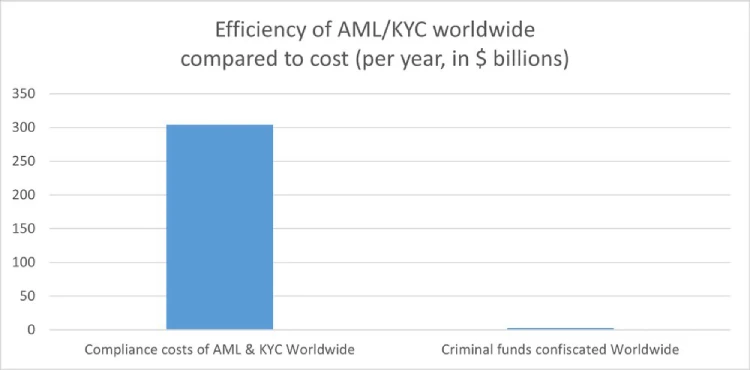
How will they keep this information safe? Why do they need my identity? Why do they force businesses to enforce such regulations? It's always for your safety, to protect you from the "bad". Your life is perpetually in danger: terrorists, money launderers, villains... so the government steps in to save us.
‟Hush now, baby, baby, don't you cry Mamma's gonna make all of your nightmares come true Mamma's gonna put all of her fears into you Mamma's gonna keep you right here, under her wing She won't let you fly, but she might let you sing Mamma's gonna keep baby cosy and warm” — Mother, Pink Floyd
We must resist any attack on our privacy and freedom. To do this, we must collaborate.
If you have a service, refuse to ask for KYC; find a way. Accept cryptocurrencies like Bitcoin and Monero. Commit to circular economies. Remove the need to go through the FIAT system. People need fiat money to use most services, but we can change that.
If you're a user, donate to and prefer using services that accept such currencies. Encourage your friends to accept cryptocurrencies as well. Boycott FIAT system to the greatest extent you possibly can.
This may sound utopian, but it can be achieved. This movement can't be stopped. Go kick the hornet's nest.
“We must defend our own privacy if we expect to have any. We must come together and create systems which allow anonymous transactions to take place. People have been defending their own privacy for centuries with whispers, darkness, envelopes, closed doors, secret handshakes, and couriers. The technologies of the past did not allow for strong privacy, but electronic technologies do.” — Eric Hughes, A Cypherpunk's Manifesto
The anniversary
Four years ago, I began exploring ways to use crypto without KYC. I bookmarked a few favorite services and thought sharing them to the world might be useful. That was the first version of kycnot.me — a simple list of about 15 services. Since then, I've added services, rewritten it three times, and improved it to what it is now.
kycnot.me has remained 100% independent and 100% open source^2 all these years. I've received offers to buy the site, all of which I have declined and will continue to decline. It has been DDoS attacked many times, but we made it through. I have also rewritten the whole site almost once per year (three times in four years).
The code and scoring algorithm are open source (contributions are welcome) and I can't arbitrarly change a service's score without adding or removing attributes, making any arbitrary alterations obvious if they were fake. You can even see the score summary for any service's score.
I'm a one-person team, dedicating my free time to this project. I hope to keep doing so for many more years. Again, thank you for being part of this.
-
 @ c9badfea:610f861a
2025-05-26 21:30:33
@ c9badfea:610f861a
2025-05-26 21:30:33- Install Loop Habit Tracker (it's free and open source)
- Launch the app, tap ➡️
- Tap ⁝, select Settings, scroll down and tap Customize Notifications
- Enable Show Notifications
- Return to the main screen
- Tap + to add a habit
- Choose Yes Or No for simple yes/no questions (e.g. Did you wake up early?)
- Choose Measurable for questions where a quantity is expected (e.g. How many pages did you read?)
- Assign a Name (e.g. Waking up early)
- Enter a Question (e.g. Did you wake up early?)
- Define the Frequency (e.g. Every Day)
- Schedule a Reminder (e.g. 08:00 and Any Day Of The Week)
- Include a Note if needed
- Hit Save to create the habit
- Start tracking your habits!
ℹ️ To categorize habits, use colors (e.g. blue for morning, orange for afternoon) or title prefixes (e.g. "Morning - Waking Up Early" and "Afternoon - Workout")
-
 @ 2b24a1fa:17750f64
2025-05-25 09:42:49
@ 2b24a1fa:17750f64
2025-05-25 09:42:49Eine Stunde Klassik! Der Münchner Pianist und "Musikdurchdringer" Jürgen Plich stellt jeden Dienstag um 20 Uhr große klassische Musik vor. Er teilt seine Hör- und Spielerfahrung und seine persönliche Sicht auf die Meisterwerke. Er spielt selbst besondere, unbekannte Aufnahmen, erklärt, warum die Musik so und nicht anders klingt und hat eine Menge aus dem Leben der Komponisten zu erzählen.
https://soundcloud.com/radiomuenchen/eine-stunde-klassik-opus-eins?
Sonntags um 10 Uhr in der Wiederholung.
-
 @ 06639a38:655f8f71
2025-05-26 14:21:37
@ 06639a38:655f8f71
2025-05-26 14:21:37Finally there is a release (1.7.0) for Nostr-PHP with a full NIP-19 integration. Here is an example file with some snippets to how it works to encode and decode bech32 encoded entities:
- https://github.com/nostrver-se/nostr-php/blob/main/src/Examples/nip19-bech32-decoded-entities.php
- https://github.com/nostrver-se/nostr-php/blob/main/src/Examples/nip19-bech32-encoded-entities.php
Now merge request #68 (and issues #74, #64 are closed) is finally merged which I opened in October 2024.
Next up is:
- Create documentation how to use NIP-19 with the library on https://nostr-php.dev
- Create documentation how to use NIP-04 and NIP-44 with the library on https://nostr-php.dev
- Work out a proof-of-concept with the revolt/event-loop package to create concurrent async requests with websocket connections
-
 @ 06639a38:655f8f71
2025-05-26 12:58:38
@ 06639a38:655f8f71
2025-05-26 12:58:38Nostr-PHP
Djuri submitted quite some pull requests in the last couple of week while he was implementing a Nostr connect / login on https://satsback.com. The backend of that platform is written in PHP so the Nostr-PHP library is used for several purposes while Djuri also developed quite some new features utilizing the following NIPs:
- NIP-04
- NIP-05
- NIP-17
- NIP-44
Thank you very much Djuri for these contributions. We now can do the basic private stuff with the library.
PR for NIP-04 and NIP-44: https://github.com/nostrver-se/nostr-php/pull/84 and https://github.com/nostrver-se/nostr-php/pull/88
Examples:- https://github.com/nostrver-se/nostr-php/blob/main/src/Examples/nip04-encrypted-messages.php
- https://github.com/nostrver-se/nostr-php/blob/main/src/Examples/nip44-gift-wrapping.php
PR for NIP-05: https://github.com/nostrver-se/nostr-php/pull/89
Example: https://github.com/nostrver-se/nostr-php/blob/main/src/Examples/nip05-lookup.phpPR for NIP-17: https://github.com/nostrver-se/nostr-php/pull/90
Example: https://github.com/nostrver-se/nostr-php/blob/main/src/Examples/nip17-private-direct-messages.phpPR for adding more metadata profile fields: https://github.com/nostrver-se/nostr-php/pull/94
Example: https://github.com/nostrver-se/nostr-php/blob/main/src/Examples/fetch-profile-metadata.phpFetch
10050event (dm relay list) of an given pubkey
Example: https://github.com/nostrver-se/nostr-php/blob/main/src/Examples/fetch-dm-relayslist.phpThe CLI tool is removed from the library, see PR https://github.com/nostrver-se/nostr-php/pull/93
Nostr-PHP documentation
While new NIPs are implemented in the Nostr-PHP library, I'm trying to keep up with the documentation at https://nostr-php.dev. For now, things are still much work in progress and I've added the AI agent Goose using the Claude LLM to bootstrap new documentation pages. Currently I'm working on documentation for
- How to direct messages with NIP-04 and NIP-17
- Encrypted payloads for event content NIP-44
- Fetch profiledata of a given pubkey
- Lookup NIP-05 data of given pubkey
- Using the NIP-19 helper class
CCNS.news
I've moved CCNS to a new domain https://ccns.news and have partly implemented the new NIP-B0 for web bookmarks. When you post a bookmark there, a kind
39701event is transmitted to some Nostr relays (take a look at this event for example). Optionally you can also publish this content as a note to the network.As you can see at https://ccns.news/l/censorship-resistant-publishing-and-archiving, I've listed some todo's. All this stuff is done with Javascript using the NDK Typescript library (so I'm not using any PHP stuff for this with Nostr-PHP).

Also new: https://ccns.news/global now has a global feed which fetches all the web bookmark events with kind
39701from several public Nostr relays. I had a rough idea to compare feeds generated with NDK and Nostr-PHP (for both using the same set of relays).
Building a njump clone for this Drupal website
You can now use this URL pattern to fetch Nostr events:
https://nostrver.se/e/{event_id|nevent1|note1|addr1}where you can provide a plain Nostr event ID or NIP-19 encoded identifier.An example, this URL [nostr:nevent1qvzqqqqqqypzqmjxss3dld622uu8q25gywum9qtg4w4cv4064jmg20xsac2aam5nqqsqm2lz4ru6wlydzpulgs8m60ylp4vufwsg55whlqgua6a93vp2y4g3uu9lr) fetches the data from one or more relays. This data is then being saved as a (Drupal) node entity (in a database on the server where this website is hosted, which is located in my office fyi). With this saved node, this data is now also available at https://nostrver.se/e/0dabe2a8f9a77c8d1079f440fbd3c9f0d59c4ba08a51d7f811ceeba58b02a255/1 where the (cached) data is server from the database instead. It's just raw data for now, nothing special about it. One of my next steps is to style this in a more prettier interface and I will need to switch the theme of this website to a custom theme. A custom theme where I will be using TailwindCSS v4 and DaisyUI v5.
The module which is providing these Nostr features is FOSS and uses the Nostr-PHP library for doing the following:
- Request the event from one or more relays
- Decode the provided NIP-19 identifier
For now this module is way for me to utilize the Nostr-PHP library with Drupal for fetching events. This can be automated so in theory I could index all the Nostr events. But this is not my ambition as it would require quite some hardware resources to accomplish this.
I hope I can find the time to build up a new theme first for this website, so I can start styling the data for the fetched events. On this website, there is also a small piece (powered by another module) you can find at https://nostrver.se/nostrides doing things with this NIP-113 around activity events (in my case that's cycling what interests me).What's next
I'm already working on the following stuff:
- Implement a class to setup a persistent connection to a relay for requesting events continuously
- Extend the documentation with the recent added features
Other todo stuff:
- Review NIP-13 proof-of-work PR from Djuri
- Implement a NIP-65 lookup for fetching read and write relays for a given npub issue #91
- Build a proof-of-concept with revolt/event-loop to request events asynchronous with persistent relay connections
- Add comments to https://ccns.news
-
 @ 611021ea:089a7d0f
2025-05-26 18:28:46
@ 611021ea:089a7d0f
2025-05-26 18:28:46Imagine a world where your favorite health and fitness apps—diet trackers, meditation tools, cardio and strength training platforms, even therapy apps—can all work together seamlessly. Not because they're owned by the same company, but because they speak a common, open language. That's the future NIP-101h is building on Nostr.
A Modular, Privacy-First Health Data Framework
NIP-101h defines a modular, privacy-first framework for sharing granular health and fitness metrics on the decentralized Nostr protocol. The core idea is simple but powerful: every health metric (weight, steps, calories, mood, and so on) gets its own unique Nostr event kind. Apps can implement only the metrics they care about, and users can choose exactly what to share, with whom, and how.
This modular approach means true interoperability. A meditation app can log mindfulness sessions, a running app can record your daily mileage, and a diet tracker can keep tabs on your nutrition—all using the same underlying standard. Each app remains independent, but your data becomes portable, composable, and, most importantly, under your control.
Why NIP-101h Matters
Interoperability
Today's health and fitness apps are walled gardens. Data is locked away in proprietary formats, making it hard to move, analyze, or combine. NIP-101h breaks down these barriers by providing a common, open standard for health metrics on Nostr. Apps can collaborate, users can migrate, and new services can emerge—without permission or lock-in.
User Control & Privacy
Health data is deeply personal. That's why NIP-101h is privacy-first: all metric values are encrypted by default using NIP-44, unless the user explicitly opts out. You decide what's public, what's private, and who gets access. Even if you want to keep everything local, that's supported too.
Extensibility
The world of health and fitness is always evolving. NIP-101h is designed to grow with it. New metrics can be added at any time via the
-
 @ cae03c48:2a7d6671
2025-05-29 03:00:30
@ cae03c48:2a7d6671
2025-05-29 03:00:30Bitcoin Magazine

Block Announces Bitcoin Business Stack, Makes Historic Lightning Payments Push at Bitcoin 2025Bitcoin isn’t just something to hold anymore—it’s something to live on. That was the core message delivered by Miles Suter, Bitcoin Product Lead at Block Inc., during his keynote at the Bitcoin 2025 Conference today. Standing at the intersection of innovation and ideology, Suter laid out a vision where Bitcoin isn’t just a store of value—but the internet’s native currency.
“Bitcoin is at a crossroads—on one hand it’s never been stronger: a trillion in market cap, millions of holders, and even talk of nation-state adoption,” Suter said. “We use Bitcoin to hold, to hedge, to opt out, but we rarely use it to live. At Block Inc., we believe that has to change.”
Suter officially announced that Block is rolling out Bitcoin payment capability for merchants using Square POS, allowing them to accept bitcoin directly in-store. The move comes as part of a broader initiative Block calls the full bitcoin for business stack—covering acquiring, managing, reporting, accounting, converting, lending, and taxes.

“This is what makes Bitcoin an everyday currency for everyone,” he emphasized. “We believe hard-working entrepreneurs deserve access to the full power of bitcoin.”
To prove the vision in action, Block helped power a Guinness World Record attempt for the most Lightning payments in a day, hosted live at the conference. The goal: prove that Lightning payments aren’t just functional—they’re scalable, fast, and real.
Block’s commitment isn’t new. In 2020, the company put bitcoin on its balance sheet. In 2021, it co-founded the Bitcoin Clean Energy Initiative to fight the “boiling oceans” narrative. In 2022, Cash App became one of the first major platforms on Lightning. In 2023, it launched on-chain payments with Square. And in 2024, it helped defeat Craig Wright in court, “standing up for Satoshi.”
“These aren’t just headlines—they’re a pattern,” Suter said. “We’ve made it more accessible, more secure. Now we’re focused on making it usable every day.”
Cash App already ranks among the top bitcoin on-ramps in the U.S., accounting for nearly 10% of on-chain block space at any time. In 2024, Lightning usage grew 7x. “Block runs one of the top Lightning nodes globally. And here’s what’s wild—it’s working,” he said.
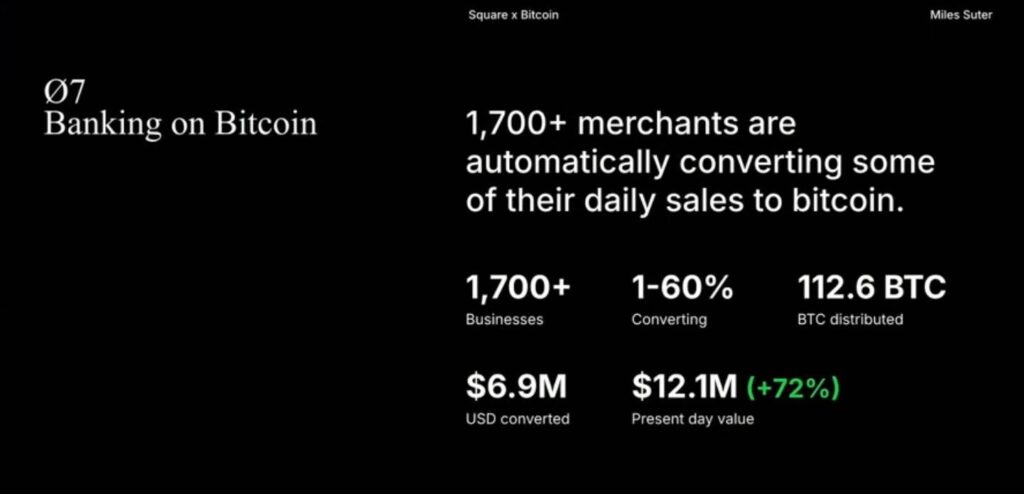
Block is now taking 10% of all profits from Bitcoin and adding it back to its balance sheet, and over 1,700 merchants are automatically converting part of their daily sales to Bitcoin.
“If Bitcoin just becomes digital gold, we failed the mission,” Suter said. “Bitcoin payments validate Bitcoin. They make it real. Bitcoin is money.”
This post Block Announces Bitcoin Business Stack, Makes Historic Lightning Payments Push at Bitcoin 2025 first appeared on Bitcoin Magazine and is written by Jenna Montgomery.
-
 @ c9badfea:610f861a
2025-05-26 16:14:46
@ c9badfea:610f861a
2025-05-26 16:14:46- Install Trail Sense (it's free and open source)
- Open the app, and tap Next then I Agree
- Allow location access While Using The App and Allow notifications
- Tap 🧭 on the bottom bar to open the compass
- Use 📍️ in the upper left to manage paths
- Use 🗺️ in the upper right to take a picture of a physical map and navigate on it
- Use ⬆️ in the lower right to set beacons along your hike
- Tap ☁️ on the bottom bar for weather information
- Use ☁️ in the upper left to predict weather using cloud patterns
- Use 🌡️ in the upper right to estimate the temperature (useful when in the mountains)
- Tap ✨ on the bottom bar for astronomy details
- Use 🔦 in the upper left to toggle your phone's flashlight
- Use ⬇️ in the upper right to set alarms and reminders (e.g. sunset alerts)
- Tap ▦ on the bottom bar to access extra tools
- Use 🔦 to toggle the flashlight
- Use 🔊 to play a whistle sound
- Use 🔋 to turn battery-saving mode on or off
- Select User Guide for help with all features
- Enjoy!
ℹ️ Explore the app - it has many features worth learning
-
 @ 5c26ee8b:a4d229aa
2025-05-26 16:10:05
@ 5c26ee8b:a4d229aa
2025-05-26 16:10:05In March 2022, I have introduced “VCPs”; (Virtual Currency points). So that the international transactions are made without relying on one currency or another and the financial crises are easily avoided.
You may have noticed that banks are increasing their gold reserves and that there are interests for local virtual currency and that was after the note was published.
The picture of the note showing its date will be in attachment to this post; I can’t edit it to avoid that its date gets changed. Here its content:
Conversion of international banking system: The “VCPs” system: * Each central bank would keep its assets and funds in homeland. * Establishing the value of one virtual currency point. I suggested that: 1 virtual currency point (VCP) = 0.1 gram of gold. * Virtual evaluation must be made to each currency, virtual currency points must be added to each currency’s market value. * International transfers and payments must use the virtual currency points, VCPs, assigned to each currency in international operations. * Daily, weekly, monthly or yearly the actual money corresponding to the virtual currency points used in payments and transfers will be sent by any chosen mean of transport to the banks that had completed the operations or to the corresponding central banks. In this way no currency would prevail in international payments as all currencies will be considered as VCPs. —————————————————————- Because of the need of more guidelines to start using VCPs I have published the following updates:
VCPs allowance updates:
- Not only gold, also precious stones or agreed minerals held in banks can be used to obtain the VCPs allowance (public VCPs allowances). At the same time what is registered and kept in circulation (of gold, precious stones and agreed minerals that belongs to the people) in the country as private VCPs allowances to increase the VCPs allowances. The people can use their personal VCPs along with their precious items for purchases; for example if they sell or use their own gold to buy something, they must give their VCPs registration receipt or card (if they didn’t register their gold to obtain VCPs allowance, they can get it registered at the moment they decide to sell it so it gets added to the private VCPs allowances of his/her country). However, the registered materials must be declared at all borders while traveling once exceeded an internationally agreed specific amount (such as the value of €10000). Therefore a registration method can be agreed with gold and jewelry shops. For instance, while evaluating the materials getting registered, an online VCPs account (for a first registration) can get made on the site that is getting ready and the registration can be combined with a physical/online card (VCPs allowance card. For registering other materials in a later moment, the same card can be used to access the same account. Note that the materials must be used with the private VCPs allowance card for buying or selling, while for public VCPs accounts it’s not necessary because the materials will be kept in the central bank or other banks) or a receipt with a serial number (and other methods to protect customers from fraud). Banks can buy private VCPs while buying gold or other agreed materials and make them public VCPs. And people can have public VCPs allowances corresponding to the value of money (currency) they have already in their accounts. While if people buy gold from the bank (with cash or any other payment method), the related public VCPs allowance will be transformed into private ones (the buyers must receive the actual gold with the private VCPs allowance).
- The agreed materials that can be used to obtain public VCPs must not be consumable (such as oil or natural gas) or used for industrial purposes (such as iron or lithium).
- The printed and online (used by credit or debit cards) currency kept in circulation of the concerned country must correspond to the value of public VCPs allowance that must correspond with the value of gold kept in the central bank (printing more money will decrease its own value internationally).
- Private banks in the same country can have a public VCPs agreement with the central bank so that each bank registers and declares how much gold or valuable materials it has and get its own share of public VCPs allowance and its related printed/online currency in circulation.
- Gems and gold kept in museums can have public VCPs allowances that correspond to their weights only not the archeological values.
- International trade can use public VCPs allowances and the physical payment must follow; either by a preferred currency or gold. However if two or more countries have a trade agreement they can barter goods using IVCPs (International VCPs Allowances; that does not need to have a deposited amount of gold although they will use the same reference as public or private VCPs because it’s a general way to evaluate goods of different types; so for example oil can be swapped for electronics based on how much IVCPs are agreed to be equally swapped each year; i.e. a gallon of oil that costs 50 IVCPs can be swapped for a device that costs 25 IVCPs and grains that cost 25 IVCPs in an International VCPs Allowance Agreement where all parties receives the agreed goods without transferring money or gold). The amount of IVCPs can be agreed per year or there could a multiple online account/s viewable by the countries/parties taking part in the agreement showing the balance of International VCPs that can still be used in bartering goods for each one of the participating countries/parties).
- Cryptocurrencies can be like International VCPs they won’t need to have a deposit of gold, however they must go through an evaluation process compared to their current comparative value and gold (i.e. the amount of bitcoin that must be paid to buy a 0.1g of gold now can become the fixed value) so that the Cryptocurrencies can still be used for trading or bartering for goods even after the release of VCPs. The Cryptocurrencies can sustain the deficiencies of amount of currency that can be used in the same country or internationally (because not everyone can have enough gold deposited to sustain the daily trade). However regulations on the amount of Cryptocurrency/ies exchanged in a country must be agreed with its own central bank or there could be an international agreement; this amount can’t be less than what’s already in use of a certain Cryptocurrency. Or Cryptocurrencies can be exchanged with IVCPs (to protect people’s money while keeping in mind their compared value with gold now) and an amount of International VCPs allowance can be used also for bartering goods in the same country through an agreement with its own central bank.
- Public VCPs must have printable cash allowance that can be in the country or overseas (registered in banks, exchange companies and at borders). Each bank can have registers of local or foreign cash.
- In order to avoid the devaluation of the currency, because the printed money will corrisponde to the gold or valuable minerals held by the country, the concerned country must retrieve the cash abroad and replace it either with another currency or IVCPs through a trade agreement.
- To compensate the deficit of VCPs necessary for daily use within a country and to make a proper distinction, locally, Local Virtual Points (LVCPs) can be used.
- The Local VCPs would be issued by local authorities.
Meanwhile, countries started using the free VCPs platform that is built by a talented web developer in JavaScript; fiatjaf. I insist though that the trade name for the virtual currency points stays “VCPs” and that the clients are made aware of its usage in their daily banking.
-
 @ 1f956aec:768866bd
2025-05-26 15:06:38
@ 1f956aec:768866bd
2025-05-26 15:06:38== January 17 2025
Out From Underneath | Prism Shores
crazy arms | pigeon pit
Humanhood | The Weather Station
== february 07 2025
Wish Defense | FACS
Sayan - Savoie | Maria Teriaeva
Nowhere Near Today | Midding
== february 14 2025
Phonetics On and On | Horsegirl
== february 21 2025
Finding Our Balance | Tsoh Tso
Machine Starts To Sing | Porridge Radio
Armageddon In A Summer Dress | Sunny Wa
== february 28 2025
you, infinite | you, infinite
On Being | Max Cooper
Billboard Heart | Deep Sea Diver
== March 21 2025
Watermelon/Peacock | Exploding Flowers
Warlord of the Weejuns | Goya Gumbani
== March 28 2025
Little Death Wishes | CocoRosie
Forever is a Feeling | Lucy Dacus
Evenfall | Sam Akpro
== April 4 2025
Tripla | Miki Berenyi Trio
Adagio | Σtella
The Fork | Oscar Jerome
== April 18 2025
Send A Prayer My Way | Julien Baker & TORRES
Superheaven | Superheaven
Thee Black Boltz | Tunde Adebimpe
from brooklyvegan
== April 25 2025
Face Down In The Garden |Tennis
Under Tangled Silence | Djrum
Viagr Aboys |Viagra Boys
Blurring Time | Bells Larsen
== May 2 2025
Time is Not Yours | Say Sue Me 세이수미
If You Asked For A Picture | Blondshell
== May 16 2025
Wield Your Hope Like A Weapon | Soot Sprite
Transmission 96 | Liftin Spirits & DJ Persuasion
Menedék | TÖRZS
== May 28 2025
Forefowk, Mind Me | Quinie
Silver Tears | SILVER TEARS
-
 @ cff1720e:15c7e2b2
2025-05-24 20:17:45
@ cff1720e:15c7e2b2
2025-05-24 20:17:45Ich liebe Pareto. Für das was es ist, viel mehr aber für das was es derzeit wird - der Marktplatz der Ideen. Er entsteht durch gemeinsames Engagement von Entwicklern, Autoren und aktiven Lesern. Es ist ein lebendiges Medium, das jeden Tag wächst, quantitativ wie qualitativ, durch offene Interaktion, was es in dieser Form einzigartig macht.\ \ Mein Text ist inspiriert durch den Artikel von Alexa Rodrian vom 22. Mai über den Auftritt von Wolf Biermann bei der Verleihung des Deutschen Filmpreises. Alexa ist keine Publizistin, genau wie zahlreiche unserer Autoren, aber sie hat einen bemerkenswerten Beitrag verfasst. Ich habe ihn spontan geliked, kommentiert und mit einer Spende honoriert. In den vergangenen Tagen habe ich viel darüber reflektiert, und Pareto ermöglicht es mir, und jedem anderen, diese Überlegungen zur “Causa Biermann” hier darzulegen.

MSN kommentierte die anstößige Rede wie folgt: mit einem verfälschten Golda-Meir-Zitat lenkte Biermann das Thema auf das Sterben in Gaza, für das er die Palästinenser selbst verantwortlich machte. „Dass ihr unsere Söhne ermordet habt, werden wir Euch eines Tages verzeihen“, habe Meir zu den Palästinensern gesagt, „aber wir werden euch niemals verzeihen können, dass ihr unsere Söhne gezwungen habt, selber Mörder zu werden.“ Alexa Rodrian, in einer Mischung aus Enttäuschung und Empörung, eröffnete ihren Artikel wie folgt:

„Triff niemals deine Idole“ heißt ein gängiger Ratschlag. In gewendeten Zeiten stehen zu dem die Werte auf dem Kopf – und manche Künstler mit ihnen. Die Worte, die aus manch ihrer Mündern kommen, wirken, als hätte eine fremde Hand sie auf deren Zunge gelegt. Die fremde Hand ist bei Biermann eher unwahrscheinlich, denn sein Hang zu Provokationen und Verletzungen haben Tradition, man erinnere sich an den legendären Auftritt bei einer Feierstunde im Bundestag 2014 in der er die Mitglieder der Linksfraktion als “elenden Rest“ und ”Drachenbrut” bezeichnete. Oder seine Beschimpfungen der (ostdeutschen) Wähler von AfD und BSW im August 2024 in einem Zeit-Interview: „Die, die zu feige waren in der Diktatur, rebellieren jetzt ohne Risiko gegen die Demokratie. Den Bequemlichkeiten der Diktatur jammern sie nach, und die Mühen der Demokratie sind ihnen fremd.“
Im Februar 2025 wurde Wolf Biermann für sein Lebenswerk mit einem Musikpreis der GEMA ausgezeichnet. Was aber ist sein Lebenswerk, sein mutiges Engagement in der Opposition der DDR bis 1976 oder seine verfehlten Rüpeleien in der Gegenwart? Ein solcher Preis ist fragwürdig, denn kein Lebenswerk ist konsistent, und die Bewertung abhängig von subjektiven Maßstäben. Meist wählen wir unsere Idole nach unseren Idealen, aber die können sich verändern, ebenso wie das Idol. Beethoven widmete seine 3. Sinfonie (Eroica) Napoleon, zog die Widmung aber zurück als dieser sich 1804 zum Kaiser krönen ließ. “Ist der auch nichts anderes, wie ein gewöhnlicher Mensch?” soll er wütend ausgerufen haben. Richtig! Was hatte Beethoven erwartet, einen Gott? “Hosianna” und “kreuzigt ihn” sind Affekte die durch unsere Projektionen verursacht und den Realitäten nie gerecht werden.

Den Preis für sein Lebenswerk kann Wolf Biermann behalten. Er hat Millionen von Menschen in der DDR Mut gemacht. Er hat zahlreiche großartige Gedichte und Lieder verfasst, das behalte ich gerne in Erinnerung. Nun hat er sich selbst vom Sockel gestürzt und durch seinen Empathiemangel das Image beschädigt. Das hätte er vermeiden können, wenn er sich an die Worte seines Lehrmeisters Brecht erinnert hätte.
...\ Dabei wissen wir doch:\ Auch der Hass gegen die Niedrigkeit\ verzerrt die Züge.\ Auch der Zorn über das Unrecht\ Macht die Stimme heiser. Ach, wir\ Die wir den Boden bereiten wollten für die Freundlichkeit\ Konnten selber nicht freundlich sein.\ ...

Er hätte auch von der Medizin nehmen können, die er selbst für andere entwickelt hat \ (1966 für seinen Freund Peter Huchel).
…\ Du, laß dich nicht verhärten\ in dieser harten Zeit.\ Die allzu hart sind, brechen,\ die allzu spitz sind, stechen\ und brechen ab sogleich.\ …
PS: Fortsetzung folgt in der Reihe \ “Was wir von großen Persönlichkeiten lernen können, wenn wir ihnen zuhören würden."
-
 @ 10846a37:73b5f923
2025-05-28 11:40:41
@ 10846a37:73b5f923
2025-05-28 11:40:41O universo dos jogos online ganha um novo patamar com a chegada da plataforma 30win, um ambiente moderno, seguro e totalmente pensado para oferecer entretenimento de qualidade aos seus usuários. Com uma interface intuitiva, ampla variedade de jogos e suporte completo, a 30win se destaca como uma excelente opção para quem busca diversão e oportunidades emocionantes de vitória.
Uma Plataforma Moderna e Confiável A 30win foi desenvolvida com tecnologia de ponta, priorizando segurança e praticidade. O site possui um design responsivo, que se adapta perfeitamente a computadores, tablets e smartphones, permitindo que o jogador aproveite seus momentos de lazer em qualquer lugar. A navegação é rápida e fluida, com menus claros e opções bem organizadas, o que torna a experiência ainda mais agradável, até mesmo para quem está começando.
Outro grande diferencial da 30winé seu compromisso com a proteção dos dados dos usuários. A plataforma utiliza protocolos avançados de criptografia, garantindo que todas as transações e informações pessoais estejam seguras. Além disso, oferece múltiplos métodos de pagamento e saque, com rapidez e eficiência.
Variedade de Jogos Para Todos os Gostos O que realmente atrai os jogadores para a 30win é a impressionante seleção de jogos disponíveis. A plataforma conta com centenas de títulos de desenvolvedores renomados, trazendo gráficos de alta qualidade, trilhas sonoras envolventes e mecânicas de jogo inovadoras.
Entre os destaques estão os jogos de slots, com temáticas variadas que vão desde aventuras épicas até símbolos clássicos. Cada título traz funções especiais como giros grátis, multiplicadores e rodadas bônus, o que aumenta tanto a diversão quanto as chances de ganhar prêmios.
Para quem gosta de desafios estratégicos, a 30win oferece também uma boa seleção de jogos de cartas como pôquer, blackjack e baccarat, além de roletas virtuais e jogos interativos com crupiês ao vivo, que proporcionam uma experiência realista e envolvente, diretamente da tela do seu dispositivo.
Experiência do Jogador em Primeiro Lugar A 30win se preocupa em entregar uma experiência completa e satisfatória aos seus jogadores. Desde o primeiro acesso, é possível notar a atenção dada aos detalhes. O cadastro é simples e rápido, com poucos cliques, e o usuário já pode começar a explorar tudo o que a plataforma tem a oferecer.
Outro ponto forte é o suporte ao cliente. A equipe de atendimento está disponível 24 horas por dia, sete dias por semana, pronta para ajudar em qualquer dúvida ou situação. Isso transmite confiança e demonstra o comprometimento da plataforma com seus usuários.
Além disso, a 30win promove constantemente bônus e promoções exclusivas, premiando tanto novos jogadores quanto os mais fiéis. Esses incentivos tornam a experiência ainda mais atrativa, com recompensas que vão desde créditos extras até prêmios especiais.
Conclusão Se você está em busca de uma plataforma de jogos online completa, segura e com excelente variedade de opções, a 30win é uma escolha certeira. Com sua interface amigável, suporte eficiente e jogos de altíssimo nível, ela oferece uma experiência empolgante que atende a todos os perfis de jogadores.
-
 @ a296b972:e5a7a2e8
2025-05-24 09:35:09
@ a296b972:e5a7a2e8
2025-05-24 09:35:09„Aaaach, was für ein herrlicher Tag!“
In Berlin geht man hochmotiviert an die Arbeit, in der tiefen Überzeugung stets die richtigen Entscheidungen zu treffen, die Steuern der Einzahler ausschließlich für wohlüberlegte, notwendige Investitionen auszugeben und Entscheidungen zu treffen, die im dem Umfeld, in dem man sich bewegt, als höchst sinnvoll erachtet werden. Zustimmung von allen Seiten, dann muss es ja richtig sein.
Man fährt im Dienstwagen ins Regierungsviertel, sieht die vielen geschäftigen Menschen, wie sie ebenfalls zur Arbeit eilen. Man freut sich darüber, dass alles so gut läuft, dank der überragenden Kompetenz, die man einbringen darf und die das alles ermöglicht.
In Gedanken klopft man sich auf die Schulter und sagt sich im Stillen: „Bist schon ein geiler Typ, der richtig was bewegen kann, bewegen kann.“
Man hat auch schon erkannt, dass die zunehmende Kriminalität, vorzugsweise mit einem unsachgemäß gebrauchten Messer, durch den schlechten Einfluss der sozialen Medien entstanden ist und schon entsprechende Maßnahmen auf den Weg gebracht, um das durch geleitete Meinungsäußerungen, selbstverständlich zum Wohle aller, zu unterbinden. Man ist ja nicht umsonst in diese verantwortungsvolle Position gelangt. „Endlich am Ziel!“
„Messerattacken sind unschön, unschön, aber man muss auch berücksichtigen, dass viele der Attentäter und Attentäterinnen in ihren Herkunftsländern Schlimmes erlebt haben und dadurch traumatisiert wurden. Den betroffenen Traumaopfern kann ja nichts Besseres passieren, als in eine deutsche Psychiatrie zu kommen, wo sie die allerbeste Therapie erfahren, um wieder glückliche Menschen der Gesellschaft zu werden.
** **
Und jeder, der nicht die große soziale Aufgabe erkennt, die wir uns gestellt haben und auch effizient umsetzen, muss es eben noch besser erklärt bekommen, erklärt bekommen. Daran müssen wir noch arbeiten. (Muss ich mir notieren, damit ich meinem Sekretär die Anweisung erteile, das in die Wege zu leiten). Und jeder, der sich dagegen sträubt, zeigt damit eindeutig, dass er zum rechten Rand gehört. Was denen nur einfällt? Da müssen klare Zeichen gesetzt werden, und das muss unter allen Umständen unterbunden werden, unterbunden werden.
** **
Sowas schadet der Demokratie, es delegitimiert sie“.
Zum Schutz der braven Bürger arbeitet man auch fleißig daran, Deutschland, in neuem Selbstbewusstsein, zur stärksten Kraft in Europa zu machen. Mit der Stationierung von deutschen Soldaten an der Ostfront, pardon, an der Ostflanke, zeigt man dem bösen, aggressiven Russen schon mal, was eine Harke ist. „Und das ist ja erst der Anfang, der Anfang. Warte nur ab!“
„Was noch? Ach ja, die Wirtschaft. Solange die nicht auf die Barrikaden geht, das sehe ich derzeit nicht, scheint es ja noch keinen akuten Handlungsbedarf zu geben. Darum kümmern wir uns später. Immerhin halten sich die Wirtschaftsprognosen in einem akzeptablen Rahmen und die Priorität (die kann auch nicht jeder richtig setzen) der Investitionen muss derzeit auf dem wichtigsten Bereich, der Aufrüstung liegen, Aufrüstung liegen. Schließlich werden wir bald angegriffen.
** **
Ich darf nicht vergessen, meinen Sekretär zu beauftragen, meine Bestellung im Feinkostladen abholen zu lassen, sonst gibt’s Zuhause Ärger. Ach ja, und die Anzüge und die Wäsche muss auch noch aus der Reinigung abgeholt werden. Darf ich nicht vergessen, nicht vergessen.
** **
Wie viele Reinigungen gäbe es nicht, wenn wir Politiker nicht wären, nicht wären. Viele sichere Arbeitsplätze, gut so!
** **
Was, schon da? Das ging aber heute schnell. Kein Stau. Ja, der Chauffeur ist schon ein Guter, der weiß, wo man lang muss, um Baustellen zu umfahren. Allerdings muss ich ihm bei nächster Gelegenheit noch einmal deutlich sagen, dass er bitte die Sitzheizung früher anzuschalten hat, anzuschalten hat! Dass der sich das immer noch nicht gemerkt hat, unmöglich!“
Wen wundert es, wenn in dieser Wonnewelt der Selbstüberschätzung von Unsererdemokratie gesprochen wird, so entrückt vom Alltag, in einem Raumschiff, dass völlig losgelöst von der Realität über allem schwebt.
„Ich müsste ja verrückt sein, wenn ich an diesen Zuständen etwas ändern wollte. Warum auch, es läuft doch und mir geht es doch gut. Ich habe ein gutes Einkommen, kann mir allerhand leisten, Haus ist bezahlt, Frau ist gut untergebracht, Kinder sind versorgt, wie die Zeit vergeht. Und wenn ich mal ausscheide, erhalte ich weiter meine Bezüge und muss nicht an mein Vermögen ran, man will ja auch den Kindern was hinterlassen. Schadet ja nicht, wenn ich mich etwas einschränke, und der eine oder andere Job wird schon an mich herangetragen werden, schließlich habe ich ja erstklassige Kontakte, die dem einen oder anderen sicher etwas wert sein werden.
** **
Na, dann woll’n wir mal wieder, woll’n wir mal wieder!“
Dieser Artikel wurde mit dem Pareto-Client geschrieben
* *
(Bild von pixabay)
-
 @ 162b4b08:9f7d278c
2025-05-28 11:37:08
@ 162b4b08:9f7d278c
2025-05-28 11:37:08Lối sống năng động, linh hoạt và hướng đến sự cân bằng đang ngày càng trở thành lựa chọn của nhiều người trẻ Việt Nam trong thời đại hiện đại. Họ không chỉ chú trọng đến công việc và học tập mà còn quan tâm đến việc chăm sóc bản thân, tận hưởng cuộc sống và tìm kiếm những khoảnh khắc thư giãn giữa lịch trình bận rộn. WIN77K, với vai trò là một nền tảng giải trí trực tuyến thông minh, đã nhanh chóng nắm bắt được nhu cầu này và cung cấp một loạt nội dung giải trí phù hợp với nhịp sống trẻ trung, sôi động. Các tính năng truy cập nhanh, giao diện dễ sử dụng và hệ thống hoạt động ổn định trên cả điện thoại lẫn máy tính giúp người dùng linh hoạt tận hưởng các hoạt động giải trí mọi lúc, mọi nơi. Thay vì tiêu tốn thời gian vào những hoạt động kém hiệu quả, người trẻ có thể lựa chọn những trải nghiệm nhẹ nhàng, thư giãn nhưng vẫn duy trì được năng lượng tích cực cho cả ngày dài. Đây chính là điểm mạnh giúp WIN77K trở thành người bạn đồng hành đáng tin cậy cho thế hệ năng động ngày nay.
Không chỉ hỗ trợ giải trí, win77k còn cung cấp nhiều chuyên mục bài viết hữu ích liên quan đến lối sống, sức khỏe tinh thần, và các gợi ý giúp người trẻ duy trì phong cách sống lành mạnh. Những nội dung như cách tổ chức thời gian, làm thế nào để giữ năng lượng tích cực mỗi ngày, hoặc các bài viết chia sẻ kinh nghiệm xây dựng thói quen tốt… đều được biên tập kỹ lưỡng và cập nhật thường xuyên. Điều này giúp người dùng không chỉ tiêu thụ nội dung mà còn được truyền cảm hứng để thay đổi thói quen sống một cách chủ động. Hơn nữa, WIN77K còn kết nối cộng đồng người trẻ có cùng lối sống qua các hoạt động chia sẻ và thảo luận trực tuyến. Nhờ vậy, người dùng có thể tìm thấy sự đồng cảm, học hỏi lẫn nhau và mở rộng mạng lưới quan hệ tích cực trong môi trường số. Việc xây dựng cộng đồng này không chỉ thúc đẩy sự phát triển cá nhân mà còn lan tỏa tinh thần sống tích cực, tự chủ và sáng tạo đến nhiều người hơn trong xã hội.
Thành công của WIN77K đến từ sự thấu hiểu sâu sắc đối với nhu cầu của người dùng hiện đại, đặc biệt là thế hệ trẻ. Trong một thế giới mà mọi thứ đều chuyển động không ngừng, việc tìm ra điểm dừng hợp lý để nạp lại năng lượng là điều cần thiết. Và WIN77K đã làm tốt vai trò đó khi không chỉ tạo ra một nền tảng giải trí đơn thuần mà còn là không gian giúp người trẻ phát triển bản thân một cách toàn diện. Dù là trong lúc nghỉ ngơi giữa giờ học, thư giãn sau một ngày làm việc mệt mỏi hay đơn giản là tìm kiếm một khoảng lặng trong cuộc sống bận rộn, WIN77K luôn hiện diện như một lựa chọn tiện lợi, an toàn và truyền cảm hứng. Sự linh hoạt, hiện đại cùng định hướng phát triển bền vững chính là lý do khiến WIN77K không ngừng gia tăng sự tin tưởng và yêu mến từ cộng đồng người trẻ Việt Nam, ngày càng khẳng định vai trò của mình trong việc đồng hành cùng lối sống năng động và tích cực của thế hệ tương lai.
-
 @ bf95e1a4:ebdcc848
2025-05-26 12:04:27
@ bf95e1a4:ebdcc848
2025-05-26 12:04:27This is a part of the Bitcoin Infinity Academy course on Knut Svanholm's book Bitcoin: Sovereignty Through Mathematics. For more information, check out our Geyser page!
The Environment
There’s no such thing as a free lunch. There’s no such thing as a zero-sum game. The 2nd law of thermodynamics tells us this. You know, the one about entropy and how everything will be really lame in a couple of trillion years. There’s no action without an equally big reaction somewhere. This is also true for Bitcoin mining. Every once in a while, some ignorant clickbait-hungry journalist writes an article about Bitcoin’s energy usage and how it’s connected to global warming or how widespread Bitcoin adoption would kill us all someday because of its “wasteful” production process. What they all fail to address is the alternative cost. As mentioned before, Bitcoin is valuable because it's scarce, and it's scarce because it's costly to produce. The same is true for gold or diamonds or anything else that is scarce and hard to come by. As discussed in earlier chapters, the mining algorithm can never be any more energy efficient because the electricity spent is directly linked to the value of the token.
Secondly, think about what most people use their Bitcoin for. Nothing. That’s right, nothing. Bitcoin incentivizes saving rather than spending. This is the exact opposite of how people use money in our current system of fiat currencies because Bitcoin is deflationary rather than inflationary relative to all other currencies. This means that every dollar, yen, or pound spent on Bitcoin would have ended up being spent on some other energy-demanding thing had it not been spent on Bitcoin. Either that or it would have lost its value due to inflation, which implies that even more dollars, yen, or euros would have been created and spent on frivolous things. Right now, credit is cheap, and the underlying economic theory of our time is based on the idea that the amount of spending going on in society is a key metric in economics. Bitcoin, on the other hand, is based on the economic theories of the Austrian school, where saving is the key metric. Yes, Bitcoin is costly to produce, but so is overproducing every product on Earth because every business needs to expand as fast as possible to pay off their loans. Human well-being has always been, and will always be, linearly connected to energy consumption. You can’t get around or bypass this fact. Energy consumption and human flourishing are inevitably linked. The thing Bitcoin does is to take away the need for unnecessary energy consumption by incentivizing us to save for future generations. It’s a mechanism that hinders our self-destructive tendencies. Not a threat to our planet's health, but a remedy.
The next time you hear about the Bitcoin network using as much energy as a small country, ask yourself: where would all that energy have ended up if it wasn’t funneled into the only invention trying to save us from ourselves there is? Into a Chinese factory producing consumer goods shipped by boat, truck and car for temporary use and probably ending up in a garbage pile the size of a small country in less than a year? How is that better for the planet? The only place from which solutions for humanity's problems can stem is human ingenuity. Such ingenuity in turn, stems from places where people with brains have a shot at getting somewhere in life. Thanks to the Internet and Bitcoin, that somewhere is everywhere. The Internet connects us, and Bitcoin frees up our time and emancipates us from our current, destructive systems. Bitcoin helps you plant a seed and watch it grow. Before you criticize Bitcoin, try to comprehend why it was invented and what inflationary, soft money does to the mechanisms of the market. Try to understand why we have a “climate problem” in the first place — why we overconsume. What underlying forces pull our psychological strings and make us borrow money for a new car? It takes a special kind of ignorance to criticize a solution without first fully comprehending the problem.
There’s one specific word that describes the current global environmentalist movement better than any other, and that word is “hubris.” Yes, the Earth has been getting warmer, very slowly, over the last fifty years. Yes, at least one of the ice caps might be melting. Yes, it’s probably because of human activity but no, you can’t save the planet through political interference in people’s lives. To get every nation on Earth to agree that it is a good idea to forcefully make people change their behavior for the sake of the climate is not only impossible but also cruel and counterproductive. Collectivists always disguise their urge to deprive their fellow man of his or her possessions and freedoms as a necessary thing to do in order to “save” humanity. This is nothing new. They’ve just decided that “climate change” is the most effective banner to rally under right now. The causes change, but the underlying philosophy stays the same. It’s very disturbing that the socialist experiment gets to repeat itself so many times in so many parts of the world.
Human progress and human flourishing have linear relationships to energy usage. If we want to find new ways of bettering ourselves, we should use more energy, not less. Truly free market competition leads to the most efficient solutions, and there are a bunch of incentives for producers of consumable goods to find cheap energy sources. Bitcoin provides the market with yet another incentive — to find locations for and invest in power plants in remote areas of the world where the cost barrier for building the plant has been too high historically due to the costly and wasteful process of transporting electricity. Hydro-electric plants in areas with a high risk of flooding, for instance. These areas are not suitable for human settlements, but they could provide us with a lot of electricity. When producers have the option to convert electricity into money directly, they’re more likely to use renewable energy sources, not less. In this sense, Bitcoin can function as a battery for energy producers.
Offshore wind farms have a very specific wind force range where they produce a usable amount of electricity. The bigger the turbine, the wider the range, but they still have an upper and a lower wind force limit. If an offshore wind farm had been connected to a Bitcoin mining rig, the surplus energy produced on windy days could have been converted into a profit for the producer instantly. The same logic applies to solar farms and geothermal plants. Energy is not a finite resource in any practical sense for the inhabitants of Mother Earth. If we could harness and store all the power of all the sunlight that hits the Earth during just one day, we could satisfy all of humanity’s energy needs for a couple of hundred years.
Bitcoin’s role in all of this is unexplored, but its potential to be a very positive environmental force is huge, and it will prove its utility during the next century. On one hand, it provides energy producers with a battery; on the other hand, it gives central bankers a run for their money and ultimately forces them to adopt a more sound monetary policy or become obsolete altogether. Bitcoin creates an incentive for sacrificing surplus energy for a small profit and a greater good rather than just letting it go to waste. The energy harnessed is converted into a completely scarce asset that is divisible and transportable to a much greater extent than any other valuable resource on Earth. It incentivizes energy producers to think long term and will reward those most patient and least wasteful among them. This recalibration of incentive structures is, of course, not only limited to energy producers or miners but to anyone who embraces this technology and understands its implications. In due time, Bitcoin’s superior monetary properties will be undeniable to even the most stubborn dinosaur. This would be an enormous net gain for humanity and the environment.
Courageous politicians dare to implement unpopular policies. They don’t need climate-striking teenagers to tell them which issues ought to be addressed first. It is ironic how celebrities who score cheap points by talking about the climate often accuse their political opponents of being “populist.” What really happens when you raise carbon taxes and try to force populations into behaviors that they don’t really like? The gilets jaunes, or yellow vests, in France are a great example. People still have to commute to work. Raising taxes solves nothing — it just distorts the market and relocates the problem. The only thing the recently adopted environmentalist policies of France resulted in was the destruction of Paris. Arguably not the best thing for the environment.
In a truly free society, a society with sound money, climate-striking children wouldn’t be a problem. They would have to learn to cooperate in order to address whatever imaginary problem they sought to solve, which would be harmless to the rest of us. Now, when backed by fear-mongering journalists, they can cause a ton of damage as our virtue-signaling political class needs to adapt to whatever imaginary issue the press has primed us with in order to secure votes. It’s not about whether there is a real climate problem or not, but rather about motives. Always ask yourself, what does this person stand to gain from holding this particular opinion? Can this issue really be solved by political means?
There’s no such thing as a free lunch. There is such a thing as representation, however, and there’s always a personal economic motive behind political decisions. They’re not here for you; you’re here for them. One of the most eye-opening experiences of my life was seeing the lobbyist quarters in Brussels. The rise of veganism, placebic gluten intolerance, and "meat-free Mondays" in school cafeterias are all products of the food industry. A soy burger is a lot cheaper to produce than a beef one. To anyone who can sell it at a higher price by appealing to people’s vanity or world-saving hubris, huge profits await. They’ve managed to monetize our collective bad climate conscience in such a cunning way that most of us have no clue we’re being played. In the 20th century, the cereal-killers of the Kellogg's company and their likes funded “research” that cemented a fear of red meats and saturated fats into the minds of the public. The effects of this propaganda can very much still be seen today as the inhabitants of America are about twice as fat today than they were before the introduction of “light” products to the market. All of these things are connected to the root of the problem: the lack of sound money. Inflation made it possible for the food industry to replace our homemade beef burger with a mass-produced cheap soy substitute while making us believe that the price of a burger hadn’t changed that much in the last fifty years. Spoiler alert - it had.
Another of the most eye-opening experiences I’ve had was during my stay in a Mayan village in the Toledo district of Belize about ten years ago. I spent a couple of days with a family of two adults and six children in a jungle village of huts and no electricity save for two diesel generators. One night, the father of the house told me a story about his friend going into politics a decade earlier and being murdered for having the wrong opinions. We slept on wooden beds without mattresses, and a couple of dogs and turkeys ran freely around the village. One day, the family’s ten-year-old was listening to some Bob Marley songs on a CD player connected to a car battery and a small solar panel on a pole in the garden. I listened for a while and then asked him about the strange sound effects in between the songs. Helicopter sounds, machine gun sounds, and other strange noises were intersecting the songs here and there. He replied by telling me, “...oh, it’s not a proper CD. I made it with Virtual DJ on my cousin’s laptop”. I was stunned. Here was this ten-year-old, in the middle of the jungle, just as skilled with a computer as any other ten-year-old I had ever met. At that moment, I realized just how leveled the playing field has been for the workforce across the globe. Here was this child, living in a hut without even electricity (but also without a mortgage to inherit), ready to compete on the same global market as any other kid in the world.
Bitcoin is the logical next step. Bitcoin doesn’t care about nationality, gender, ethnicity, age, sexual preferences, or any other imagined victimization or privilege. To Bitcoin, we’re all equal. It is a voluntary system, and it knows no biases. Bitcoin is equality of opportunity in its purest form, and it doesn’t have any opinion on the outcome whatsoever.
About the Bitcoin Infinity Academy
The Bitcoin Infinity Academy is an educational project built around Knut Svanholm’s books about Bitcoin and Austrian Economics. Each week, a whole chapter from one of the books is released for free on Highlighter, accompanied by a video in which Knut and Luke de Wolf discuss that chapter’s ideas. You can join the discussions by signing up for one of the courses on our Geyser page. Signed books, monthly calls, and lots of other benefits are also available.
-
 @ 3c559080:a053153e
2025-05-25 20:26:43
@ 3c559080:a053153e
2025-05-25 20:26:43So firstly you should find an emulator for whatever you want to play on. There are many for desktop and mobile devices. Checkhere for a list of all the available consoles and their various emulators.
Next what game do you want to play? This is the like the homepage for a shit ton of roms.
Some of the more popular roms are there and other various list like Sony Nintendo
After narrowing down your selection you will end up on myrient i assume this is just some dope person hosting all these so if you get some use out of it, think of donating they even take corn, but other shitcoins too (but thats not the focus here)
Once you download the Rom of the game you want, you will get a compressed (zip) folder, unzip it and within it will be the rom, most systems will identify your emulator and use it open the game. If not, launch the emulator and within it should be an option to open a file, open the file in the unzipped folder.
Enjoy So you want to Mod?
So every Mod, is a mod for a specific game [ex. Pokemon Blue, Pokemon FireRed, Super Mario Bros.] so it requires you to get the Rom for that base game, the mod itself, and a tool to patch it.
 There is an online tool to easily patch the mod to the ROM. IMPORTANT, this will not change any naming, Id recommend having a folder with the base game roms, and a folder for the mods, and lastly a folder for the newly modded roms. Make sure to name or just save the game in modded roms folder after the patch.
There is an online tool to easily patch the mod to the ROM. IMPORTANT, this will not change any naming, Id recommend having a folder with the base game roms, and a folder for the mods, and lastly a folder for the newly modded roms. Make sure to name or just save the game in modded roms folder after the patch. Below are a few resource to find various Pokemon Rom mods(sometimes called hacks)
Personally, Pokemon Unbound is considered the best most polished hack. it runs on Pokemon Fire Red.
Pokemon Emerald Rouge is a cool take on the popular Rougelite genre. This runs on base game Pokemon Emerald
-
 @ e0a24c5c:fa44b1e7
2025-05-23 19:21:04
@ e0a24c5c:fa44b1e7
2025-05-23 19:21:04Ralph Boes – Menschenrechtsaktivist, Philosoph
Ralph Boes zeigt in dem Buch auf, wie wir uns von der Übermacht des Parteienwesens, die zur Entmündigung des Volkes führt, befreien können. Er zeigt, dass schon im Grundgesetz selbst höchst gegenläufige, an seinen freiheitlich-demokratischen Idealen bemessen sogar als verfassungswidrig zu bezeichnende Tendenzen wirken. Und dass diese es sind, die heute in seine Zerstörung führen. Er weist aber auch die Ansatzpunkte auf, durch die der Zerstörung des Grundgesetzes wirkungsvoll begegnet werden kann.
Eintritt frei, Spendentopf
Ralph Boes hat u.a. dafür gesorgt, dass die unmäßigen Sanktionen in Hartz IV 2019 vom Bundesverfassungsgericht für menschenrechts- und verfassungswidrig erklärt wurden. Aktuell setzt er sich für eine Ur-Abstimmung des Volkes über seine Verfassung ein.
-
 @ cae03c48:2a7d6671
2025-05-29 03:00:29
@ cae03c48:2a7d6671
2025-05-29 03:00:29Bitcoin Magazine

Adam Back Presents Blockstream’s Bitcoin-First Infrastructure Vision at Bitcoin 2025Adam Back, Co-founder and CEO of Blockstream, took the stage at the Bitcoin 2025 Conference with a clear message: Bitcoin is becoming the foundation of global finance—and Blockstream is building the infrastructure to support it.
“So I think Bitcoin is still early,” Back began, “but more mainstream players are starting to become involved. It is starting to become the foundation of global finance.” From El Salvador’s President becoming “patient zero” to institutional adoption spreading rapidly, Back emphasized that “people in all layers of company management and politics have become orange-pilled.”
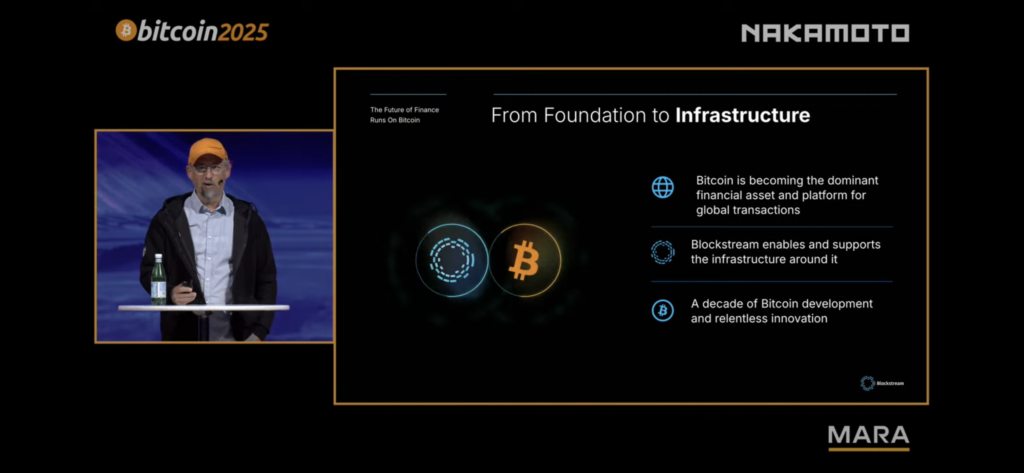
Citing Bitcoin’s accelerating growth trajectory, Back referenced Hal Finney’s prediction that Bitcoin’s addressable market could hit $200 trillion. “Today, we are a lot closer to that situation,” he noted. He alluded again that this is just the beginning for Bitcoin.
To meet that growing demand, Back announced Blockstream’s plan to support the journey from 100 million to 1 billion users by simplifying self-custody and Bitcoin-native asset management. “We’re laser-focused on Bitcoin,” he said. “At Blockstream, we are here to provide the infrastructure to enable that.”
In a detailed presentation, Back outlined five core pillars powering Blockstream’s strategy:

-
Infrastructure Expansion: “Bitcoin is becoming the dominant financial asset and platform for global transactions. Blockstream enables and supports the infrastructure around it.”
-
Unified Platform: Blockstream is developing one platform built for the Bitcoin economy—including consumer products (secure self-custody), enterprise solutions (asset transfer on Bitcoin rails), and institutional integration (custody for large-scale investment).
-
The Blockstream App: Designed to streamline self-custody, the app simplifies onboarding, supports BTC, LBTC, and USDT, and offers advanced features for experienced users.
-
Enterprise Tools: With custody, tokenization without smart contract risks, and SDK/API-ready infrastructure, Blockstream is pushing enterprise-grade Bitcoin use cases—from corporate finance to treasuries.
-
Security and Ecosystem Design: “Secure, proven, and built to last,” Back said, referring to Blockstream’s Bitcoin-first architecture. “Security is our cornerstone, and every product connects at every layer.”
In closing, Back reaffirmed his long-term vision: “The future of finance runs on Bitcoin.”
This post Adam Back Presents Blockstream’s Bitcoin-First Infrastructure Vision at Bitcoin 2025 first appeared on Bitcoin Magazine and is written by Jenna Montgomery.
-
-
 @ cae03c48:2a7d6671
2025-05-29 03:00:28
@ cae03c48:2a7d6671
2025-05-29 03:00:28Bitcoin Magazine

Eric Trump Said Everybody Wants Bitcoin. Everybody is Buying BitcoinAt the 2025 Bitcoin Conference in Las Vegas, the Executive Chairman & Board Member of American Bitcoin Mike Ho, the CEO of American Bitcoin Matt Prusak, the founder of Altcoin Daily Aaron Arnold, Donald Trump Jr. and Eric Trump discussed the future of Bitcoin and their views.
Eric Trump started the panel by saying, “we are bringing Bitcoin to America and America is going to win the crypto revolution.”
Donald continued by mentioning the $2.5 billion bitcoin treasury.
“All the announcement yesterday, True Social and TMTG committing $2.5 billion to a bitcoin treasury,” stated Trump Jr. “Then the trifecta of crypto you have is what we are doing with the world liberty and USD1 from a DeFi platform. We are very long crypto.”
Eric talked about how all the world wants Bitcoin and that most companies are having problems when buying Bitcoin because there is a lot of demand and not as much supply.
“Everybody wants Bitcoin. Everybody is buying Bitcoin,” Eric stated.JUST IN:
 Eric Trump says "everyone in the world wants #Bitcoin, everybody is buying Bitcoin"
Eric Trump says "everyone in the world wants #Bitcoin, everybody is buying Bitcoin" "0.1 BTC is going to be worth an absolute fortune"
 pic.twitter.com/0942a3dSWI
pic.twitter.com/0942a3dSWI— Bitcoin Magazine (@BitcoinMagazine) May 28, 2025
“The whole system is broken and now all of the sudden you have crypto which solves all the problems,” commented Eric. “It makes everything cheaper, it makes everything faster, it makes it safer, it makes it more transparent. It makes the whole system more functional.“
Mike Ho explained his view of the volatility of Bitcoin and how it benefits everybody.
“We see Bitcoin mining as just the foundational layer of being able to accumulate more creative Bitcoin for our shareholders at a discount to what the market can buy Bitcoin for,” commented Ho. “Then there is a value in the volatility of the stock. Usually volatility carries a negative connotation, but in here it’s the volatility that allows us to raise very low cost converts to even accelerate accumulation of Bitcoin.”
Matt Prusak mentioned how they are stacking sats and accumulating as much Bitcoin as they can.
“We are looking for ways to accumulate as much Bitcoin as fast as possible,” said Prusak. “We are stacking sats for our mining operations. We are going to stack sats for the accumulation.”
They all made predictions of Bitcoin’s end price of this year, Eric said $170,000, Trump Jr between $150,000 and $175,000 and Mike Ho over $200,000. Eric finalized with, “the next 10 years are going to be absolutely parabolical.”
This post Eric Trump Said Everybody Wants Bitcoin. Everybody is Buying Bitcoin first appeared on Bitcoin Magazine and is written by Oscar Zarraga Perez.
-
 @ 39cc53c9:27168656
2025-05-27 09:21:38
@ 39cc53c9:27168656
2025-05-27 09:21:38
Silent.link is an anonymous eSIM provider. They offer pay-as-you-go roaming in 160+ countries.
Pros
- Anonymous
- Private payment options
- High performance
- Global availability
Cons
- Need to select the right networks sometimes
- Latency
- Data and incoming SMS & call only
Rating
★★★★★
Service website
eSIMs replace traditional, physical SIM cards, if you have a fairly new phone, odds are it supports them. Since most people change their mobile carrier very rarely, the most common use case for these new eSIMs is their use in travel. Although their use as a piece of a larger OPSEC puzzle to improve privacy when using the internet from your phone is increasingly popular too.
Silent.link is not the only eSIM provider out there. Yet, they’re so unique that even Twitter’s (now X) founder Jack Dorsey recommends them.
Let’s start off with a quick explanation of how Silent.link works and what pay-as-you-go means. Most other eSIM providers will sell you packages of GBs with an expiration date. For instance imagine you’re visiting France then going to the UK after a few months. With other providers you might buy a 10GB in France package valid for 7 days, then after some months a 10GB in the UK package also valid for 7 days. You likely won’t use up the full package in either country and the remaining capacity will be voided as the package expires.
Silent.link’s pay-as-you-go is different. There are no geographic packages. There are no expiration dates. You simply have a balance denominated in USD and are charged as you use up the data according to the pricing of whichever local carrier you’re connecting via.
Preparing for the same trips from the example above you’d simply top-up your Silent.link balance with $10. Then you’d use Silent.link in France paying $1.33/GB, you’d only be charged for the exact amount used, then you’d go to the UK and pay $1.54/GB from the balance you had left over from France. It doesn’t matter how much time passes between the trips, because Silent.link balances don’t expire. If you have a balance left over you can use it on a future trip, or simply use it up in your home country.
Pros
Anonymity
Silent.link is anonymous. Most other eSIM providers require some form of identification. This can be a traditional, full KYC, procedure involving your ID or passport numbers or, as seemingly innocent, as verifying your phone number with your main carrier. Regardless, a link between the eSIM you bought online and your identity is established.
In some countries you’ll be able to pick up a traditional SIM (or the new eSIM) from a local carrier without undergoing this verification. This can still be a hassle though. You’ll need to look up the laws before travelling, you’ll need to find a local store selling them, you’ll need to decide how you’ll pay privately, etc. And that’s the best case, that’s assuming the country you want to get the SIM in allows you to buy one anonymously.
Private payment methods
Silent.link only accepts cryptocurrency and according to their stats, most payments are made with Bitcoin (either onchain or using the Lightning Network) or with Monero. As such paying anonymously is not a problem. The use a self-hosted instance of BTCPay Server to process payments and operate their own LN node. The entire checkout process can be completed over Tor.
Cons
Network selection
Although you can skip the hassle of buying a new eSIM every time you travel it’s a good idea to look up the pricing of different mobile networks in the country you’re going to. The differences can be trivial, but can also be 100x. If a specific mobile network offers a much better deal, you’ll probably want to dive into your phone’s settings to make sure it only connects to that network.
High prices for some regions
Second issue can be that, especially for poorer countries, Silent.link might not have the best prices. For instance if you travel to Angola you’ll end up paying $155.44/GB. But if you search around for other providers you’ll find eSIM that offer much lower prices for that same country.
Data & incoming SMS & calls only
These eSIMs are either data-only or only offer data and inbound sms and calls. You can’t use Silent.link eSIMs to send texts or make phone calls.
Latency
For most use-cases this shouldn’t matter, but the way roaming works is that when you’re abroad your data is first sent to your home country then sent out into the internet from there. For instance if you’re a Brit on holiday in Spain wherever you open up a website your phone communicates with the Spanish network who forwards the request to your home network in the UK and only there does the request start going towards the website you’re trying to load. The response takes the same path in reverse.
The home network for the Silent.link eSIMs is Poland. To take an extreme (antipodal) example, if you’re in Chile loading a Chilean website your request will go to Poland then back from Poland to the website’s server in Chile, then the response will go from Chile to Poland to you (in Chile). All those trips add latency. In our testing, done during the recent OrangeFren.com meetup in Istanbul, the difference was an additional 73ms. The bandwidth, however, was exceptional, easily surpassing 100 Mbps.
This latency issue isn’t unique to Silent.link, other eSIM providers usually suffer from it too, though their home network may be better suited for your latency needs. If you need the best latency we recommend a SIM from a local provider (or WiFi).
This proxy behaviour isn’t all negative however. It may potentially allow you to circumvent censorship or geoblocking if you’re trying to access resources available from Poland, but unavailable elsewhere.
Besides Istanbul one of the countries we also tested Silent.link in was Northern Cyprus. This territory is mostly unrecognized. It’s a country that, depending on who you ask, is or isn’t real. Despite this unresolved geopolitical status Silent.link performed without any issues.
Installation
If you decide to give Silent.link a try, you'll need to select if you want a data-only plan or a plan with inbound SMS & calling, once you complete the payment simply scan the QR code on the order confirmation page with your phone. Make sure to save the url of that order confirmation page somewhere! You will need it to top up your eSIM and check your remaining balance.
Getting in touch
The preferred way of contacting Silent.link's support is using the website's built-in chat function. Alternative methods include X (formerly Twitter), Matrix and email.
Their support is online from 09:00 - 21:00 UTC although even when testing outside of those hours we got a reply within a minute.
NOTE: These reviews are sponsored, yet the sponsorship does not influence the outcome of the evaluations. Sponsored reviews are independent from the kycnot.me list, being only part of the blog. The reviews have no impact on the scores of the listings or their continued presence on the list. Should any issues arise, I will not hesitate to remove any listing.
-
 @ 78a1621b:0153f86c
2025-05-26 14:22:23
@ 78a1621b:0153f86c
2025-05-26 14:22:23I was very surprised to see the foreword written by Ken Liu. I have read The Three Body Problem and Death's End, two science fiction books translated by him. Just could not believe the connection.
Chapter 1 covered Finite Fields. This took me back to my Abstract Algebra class in undergrad. I wish I had this book and was interested in Bitcoin back then. So much of what you study in school you have to study without experiencing how they connect to the real world. I wish this wasn't the case.
Jimmy Song does an amazing job of explaining just what you need in simple terms and planting flags to watch out for concepts that will be relevant later in the book. The companion code and exercises are also very well designed. This got me thinking about how much students miss out by not actively incorporating programming into the mathematics curriculum.
Looking forward to continuing with the book.
-
 @ 5144fe88:9587d5af
2025-05-23 17:01:37
@ 5144fe88:9587d5af
2025-05-23 17:01:37The recent anomalies in the financial market and the frequent occurrence of world trade wars and hot wars have caused the world's political and economic landscape to fluctuate violently. It always feels like the financial crisis is getting closer and closer.
This is a systematic analysis of the possibility of the current global financial crisis by Manus based on Ray Dalio's latest views, US and Japanese economic and financial data, Buffett's investment behavior, and historical financial crises.
Research shows that the current financial system has many preconditions for a crisis, especially debt levels, market valuations, and investor behavior, which show obvious crisis signals. The probability of a financial crisis in the short term (within 6-12 months) is 30%-40%,
in the medium term (within 1-2 years) is 50%-60%,
in the long term (within 2-3 years) is 60%-70%.
Japan's role as the world's largest holder of overseas assets and the largest creditor of the United States is particularly critical. The sharp appreciation of the yen may be a signal of the return of global safe-haven funds, which will become an important precursor to the outbreak of a financial crisis.
Potential conditions for triggering a financial crisis Conditions that have been met 1. High debt levels: The debt-to-GDP ratio of the United States and Japan has reached a record high. 2. Market overvaluation: The ratio of stock market to GDP hits a record high 3. Abnormal investor behavior: Buffett's cash holdings hit a record high, with net selling for 10 consecutive quarters 4. Monetary policy shift: Japan ends negative interest rates, and the Fed ends the rate hike cycle 5. Market concentration is too high: a few technology stocks dominate market performance
Potential trigger points 1. The Bank of Japan further tightens monetary policy, leading to a sharp appreciation of the yen and the return of overseas funds 2. The US debt crisis worsens, and the proportion of interest expenses continues to rise to unsustainable levels 3. The bursting of the technology bubble leads to a collapse in market confidence 4. The trade war further escalates, disrupting global supply chains and economic growth 5. Japan, as the largest creditor of the United States, reduces its holdings of US debt, causing US debt yields to soar
Analysis of the similarities and differences between the current economic environment and the historical financial crisis Debt level comparison Current debt situation • US government debt to GDP ratio: 124.0% (December 2024) • Japanese government debt to GDP ratio: 216.2% (December 2024), historical high 225.8% (March 2021) • US total debt: 36.21 trillion US dollars (May 2025) • Japanese debt/GDP ratio: more than 250%-263% (Japanese Prime Minister’s statement)
Before the 2008 financial crisis • US government debt to GDP ratio: about 64% (2007) • Japanese government debt to GDP ratio: about 175% (2007)
Before the Internet bubble in 2000 • US government debt to GDP ratio: about 55% (1999) • Japanese government debt to GDP ratio: about 130% (1999)
Key differences • The current US debt-to-GDP ratio is nearly twice that before the 2008 crisis • The current Japanese debt-to-GDP ratio is more than 1.2 times that before the 2008 crisis • Global debt levels are generally higher than historical pre-crisis levels • US interest payments are expected to devour 30% of fiscal revenue (Moody's warning)
Monetary policy and interest rate environment
Current situation • US 10-year Treasury yield: about 4.6% (May 2025) • Bank of Japan policy: end negative interest rates and start a rate hike cycle • Bank of Japan's holdings of government bonds: 52%, plans to reduce purchases to 3 trillion yen per month by January-March 2026 • Fed policy: end the rate hike cycle and prepare to cut interest rates
Before the 2008 financial crisis • US 10-year Treasury yield: about 4.5%-5% (2007) • Fed policy: continuous rate hikes from 2004 to 2006, and rate cuts began in 2007 • Bank of Japan policy: maintain ultra-low interest rates
Key differences • Current US interest rates are similar to those before the 2008 crisis, but debt levels are much higher than then • Japan is in the early stages of ending its loose monetary policy, unlike before historical crises • The size of global central bank balance sheets is far greater than at any time in history
Market valuations and investor behavior Current situation • The ratio of stock market value to the size of the US economy: a record high • Buffett's cash holdings: $347 billion (28% of assets), a record high • Market concentration: US stock growth mainly relies on a few technology giants • Investor sentiment: Technology stocks are enthusiastic, but institutional investors are beginning to be cautious
Before the 2008 financial crisis • Buffett's cash holdings: 25% of assets (2005) • Market concentration: Financial and real estate-related stocks performed strongly • Investor sentiment: The real estate market was overheated and subprime products were widely popular
Before the 2000 Internet bubble • Buffett's cash holdings: increased from 1% to 13% (1998) • Market concentration: Internet stocks were extremely highly valued • Investor sentiment: Tech stocks are in a frenzy
Key differences • Buffett's current cash holdings exceed any pre-crisis level in history • Market valuation indicators have reached a record high, exceeding the levels before the 2000 bubble and the 2008 crisis • The current market concentration is higher than any period in history, and a few technology stocks dominate market performance
Safe-haven fund flows and international relations Current situation • The status of the yen: As a safe-haven currency, the appreciation of the yen may indicate a rise in global risk aversion • Trade relations: The United States has imposed tariffs on Japan, which is expected to reduce Japan's GDP growth by 0.3 percentage points in fiscal 2025 • International debt: Japan is one of the largest creditors of the United States
Before historical crises • Before the 2008 crisis: International capital flows to US real estate and financial products • Before the 2000 bubble: International capital flows to US technology stocks
Key differences • Current trade frictions have intensified and the trend of globalization has weakened • Japan's role as the world's largest holder of overseas assets has become more prominent • International debt dependence is higher than any period in history
-
 @ 56f27915:5fee3024
2025-05-23 18:51:08
@ 56f27915:5fee3024
2025-05-23 18:51:08Ralph Boes – Menschenrechtsaktivist, Philosoph, Vorstandsmitglied im Verein Unsere Verfassung e.V.
Ralph Boes zeigt in dem Buch auf, wie wir uns von der Übermacht des Parteienwesens, die zur Entmündigung des Volkes führt, befreien können. Er zeigt, dass schon im Grundgesetz selbst höchst gegenläufige, an seinen freiheitlich-demokratischen Idealen bemessen sogar als verfassungswidrig zu bezeichnende Tendenzen wirken. Und dass diese es sind, die heute in seine Zerstörung führen. Er weist aber auch die Ansatzpunkte auf, durch die der Zerstörung des Grundgesetzes wirkungsvoll begegnet werden kann.
Eintritt frei, Spendentopf
Ralph Boes hat u.a. dafür gesorgt, dass die unmäßigen Sanktionen in Hartz IV 2019 vom Bundesverfassungsgericht für menschenrechts- und verfassungswidrig erklärt wurden. Aktuell setzt er sich für eine Ur-Abstimmung des Volkes über seine Verfassung ein.
-
 @ cae03c48:2a7d6671
2025-05-29 03:00:27
@ cae03c48:2a7d6671
2025-05-29 03:00:27Bitcoin Magazine

Adam Back Said It’s Still Early For the Retail Investors To Buy BitcoinAt the 2025 Bitcoin Conference in Las Vegas, the Head of Firmwide Research at Galaxy Digital Alex Thorn, Founder and Managing Partner of Pantera Capital Dan Morehead, Managing Partner, CEO, CIO of 10T Holdings + 1RoundTable Partners Dan Tapiero and the Co-founder & CEO of Blockstream Adam Back discussed the future of Bitcoin treasury companies.
Dan Tapiero started by sharing his opinion on how he sees Bitcoin in comparison to gold:
“I really have always believed in that physical ownership that the individual has the right and should be able to own his own asset and so I started this physical gold business years ago,” said Tapiero. “I think our focus today is further adoption and the elevation of Bitcoin. I think the understanding of Bitcoin as an important asset.”
Adam Back was asked what he thought about Bitcoin treasury companies and he responded, “in effect, Blockstream is one of the first Bitcoin treasury companies. We have been around since 2014 and we work with our investors to put Bitcoin in a balance sheet back then and since then. I think the way to look at the treasury companies is Bitcoin is effectively the harder rate. It’s very hard to outperform Bitcoin most people that invest in things since Bitcoin around thought I should put that in Bitcoin and not in the other thing.”
Then Adam continued by explaining what treasury companies do.
“That’s why you get companies switching to the Bitcoin standard because it’s the only way for them to keep up with Bitcoin,” stated Back. ”They start with a Bitcoin capital base. They use the operating in-revenue to buy more Bitcoin and then they are able to participate in this kind of micro arbitrage.”
Finishing the panel, Alex Thorn asked, “Five years from now what is the price of Bitcoin?”
Dan Morehead predicted $750,000k, Tapiero $1,000,000 and Back said, “a million easy.”
Adam back closed by saying, “It’s still early for the retail investors.”
You can watch the full panel discussion and the rest of the Bitcoin 2025 Conference Day 2 below:
This post Adam Back Said It’s Still Early For the Retail Investors To Buy Bitcoin first appeared on Bitcoin Magazine and is written by Oscar Zarraga Perez.
-
 @ c9badfea:610f861a
2025-05-25 22:36:12
@ c9badfea:610f861a
2025-05-25 22:36:12- Install Notally (it's free and open source)
- Open the app, tap ≡, and select Settings
- Tap View and switch to Grid
- Return to the main screen
- Tap ☑ to create a task list and ✏️ to create a note
- Enjoy!
ℹ️ You can also add pictures and set reminders for notes and task lists
ℹ️ Add labels to the notes (e.g. "Diary", "Snippet" or "Knowledge")
ℹ️ Use emojis to enhance titles (e.g. "🛒 Purchases" and "🔗️ Links")
-
 @ 5d4b6c8d:8a1c1ee3
2025-05-23 13:46:21
@ 5d4b6c8d:8a1c1ee3
2025-05-23 13:46:21You'd think I'd be most excited to talk about that awesome Pacers game, but, no. What I'm most excited about this week is that @grayruby wants to continue Beefing with Cowherd.
Still, I am excited to talk about Tyrese Haliburton becoming a legendary Knicks antagonist. Unfortunately, the Western Conference Finals are not as exciting. Also, why was the MVP announcement so dumb?
The T20k cricket contest is tightening up, as we head towards the finish. Can @Coinsreporter hold on to his vanishing lead?
@Carresan has launched Football Madness. Let's see if we understand whatever the hell this is any better than we did last week.
On this week's Blok'd Shots, we'll ridicule Canada for their disgraceful loss in the World Championships and talk about the very dominant American Florida Panthers, who are favorites to win the Stanley Cup.
Are the Colorado the worst team in MLB history?
The Tush Push has survived another season. Will the NFL eventually ban it or will teams adjust?
Plus, whatever else Stackers want to talk about.
https://stacker.news/items/987399
-
 @ 63d59db8:be170f6f
2025-05-23 12:53:00
@ 63d59db8:be170f6f
2025-05-23 12:53:00In a world overwhelmed by contradictions—climate change, inequality, political instability, and social disconnection—absurdity becomes an unavoidable lens through which to view the human condition. Inspired by Albert Camus' philosophy, this project explores the tension between life’s inherent meaninglessness and our persistent search for purpose.\ \ The individuals in these images embody a quiet defiance, navigating chaos with a sense of irony and authenticity. Through the act of revolt—against despair, against resignation—they find agency and resilience. These photographs invite reflection, not on solutions, but on our capacity to live meaningfully within absurdity.
Visit Katerina's website here.
Submit your work to the NOICE Visual Expression Awards for a chance to win a few thousand extra sats:
-
 @ 28ca019b:93fcb2cc
2025-05-25 19:25:17
@ 28ca019b:93fcb2cc
2025-05-25 19:25:17Introduction
“There is nothing more powerful than an idea whose time has come.” -Victor Hugo
Early 1950’s America. Harry S. Truman is in office. The economy is booming and the middle class are comfortable. Shiny new television sets invite the first scenes of Hollywood into people’s homes. The Weavers, Tony Bennett, Vera Lynn and Perry Como play on the radio.
But on the fringes, in dance halls and late night clubs, a cultural revolution is brewing… A new musical fusion with influences from blues, R\&B, jazz, rockabilly, country and gospel music is about to give birth to not only a new genre, but a whole new way of life that will change society and culture, forever.
Rock & Roll
It becomes a symbol of freedom, a means of expression, and a catalyst for social change. It brings into existence a new type of counter-culture, filled with individuals who are driven to rebel against norms and authority. They don’t ask for permission. They push for change.
I believe we are witnessing such a shift now. And like rock & roll, the movement I’m speaking of is also ground up, grass roots, punk rock and will not look to authority to seek permission. The catalyst for this new social change, I believe, is Bitcoin. With its innate properties, it empowers and enables the individual like never before to achieve their fullest potential, expressed through an unprecedented freedom technology. It is an idea, like a song everyone can sing in their own way, that nobody can silence.
Revolution
"You say you got a real solution / Well you know / we’d all love to see the plan" -John Lennon
The rock & roll era helped bring about meaningful societal change through art, music, and film. It created a new social narrative. Today, the Bitcoin network is providing people with a different set of tools and ideas to build a better future in a much more practical and pragmatic way. Instead of trying to reshape social consensus and cultural norms through art forms, fashion, or lifestyle, bitcoin is achieving this through open source code.
For the first time, this technology gives individuals financial sovereignty and personal control over their own destiny, with the ability to self custody their own money that no corporation, government, dictator or king can tamper with. The individual has an opportunity to finally be freed from economic tyranny. And societies have the potential to avoid endless wars funded with printed government money. John Lennon said ‘give peace a chance’. If he were still here today and understood how bitcoin could subvert the military industrial complex would he not exclaim, ‘give bitcoin a chance’?
Natural Rights, Civil Rights, Digital Rights
"The times they are a-Changin’" -Bob Dylan
The civil rights movement was tightly interwoven with the history of rock & roll. The march on Washington, August 28th 1963, marked a seminal moment in American history for the advancement of equal rights before the law. Bob Dylan, along with Joan Baez, stood with over two hundred thousand other Americans and listened to Martin Luther King’s now immortal speech.
People with the same values peacefully gathered in numbers to make a statement powerful enough to change the conversation. This is analogous to the same freedom-minded people today gathering in cyberspace and voting not in the traditional sense, but voting with their money – peacefully exiting and transferring their economic energy into a system where they can’t be expropriated.
The question of whether individual rights are granted or have to be secured by each individual remains a contested area of philosophy to this day. To outline each in a very crude and simplistic way, natural rights (sometimes referred to as inalienable rights) are derived from the belief that every person owns their own body, therefore their own labor, time, and energy. Civil rights, on the other hand, are granted by the state and are therefore not universal. The fact that they are rights granted to humans by other humans means they always have the potential to be revoked or withdrawn.
Digital rights granted by the power of asymmetric cryptography are based in the laws of mathematics. Combined with proof of work, based in the law of thermodynamics, this makes digital rights that bitcoin provides more akin to natural rights than civil rights, as no one person or group can unilaterally revoke those rights or confiscate your property through violence. No amount of fire power, tanks, fighter jets or nuclear weapons can break a bitcoin private key or rewrite the sunken cost of proof of work embedded into bitcoin’s timechain. This idea of securing rights without asking permission is, in itself, a revolution and achievable now in an egalitarian way. This implies a potentially huge shift in power from those with a monopoly on violence, to peaceful individuals who want to be treated fairly and with dignity.
Cypher Punk-Rock
Songwriters write songs. Cypherpunks write code.
To tie things back and look at a very narrow, but potentially huge use case of bitcoin, let’s examine the current broken incentives of the music industry, particularly recorded music. It is becoming increasingly apparent that an option other than a subscription model could find demand from content consumers and producers alike.
There is now a way, with Bitcoin and Lightning Network, for a music fan to pay artists directly and for any amount – dollars, cents or even fractions of cents. This model has positive outcomes for the music producer and fan who are the main two parties engaged in the transaction. The artist keeps all of what is sent and the listener can pay what they want. The listener can pay as they listen, rather than be locked into a rolling subscription that isn’t based on usage. This concept, called ‘value for value’, is finding its way into new music platforms such as Wavlake and Fountain. I believe this model will become the de-facto way of monetizing digital content in the coming years. This could bring an economic signal back to music that has been lost and cannot be achieved by streams alone. This will hopefully create a more meritocratic music system and shake up the entrenched streaming monoliths.
Art can shine a light on a certain truth. It can also make people look at things in a completely new way. Maybe then, Satoshi was the greatest artist who ever lived. Bitcoin smashed the conventional wisdom and theories of the most basic and prevalent thing everyone takes for granted: money. Using money as a lens to view the world can lead to distortions in your perception if the lens is warped. Removing the glasses makes you reevaluate economics, politics, religion, philosophy, morality, beauty, and almost every other aspect of life. The beauty of the Sistine Chapel, the Egyptian pyramids, the Mona Lisa, Beethoven’s 5th Symphony, Bohemian Rhapsody all intrinsically imply a certain degree of proof of work. The art, you could say, speaks for itself.
The Long and Winding Road Ahead
As a musician, I have found a new hope. The value for value movement gives me that hope. If this is truly a superior model of music distribution and consumption it will win out over time on the market.
Another point to touch on would be the possibility of this technology ushering in an artistic renaissance. I can honestly say my favorite music, the songs that have moved me the most, normally comes from a place of truth, honesty and sheer talent. Maybe I’m out of touch, but I feel popular music of late is devoid of soul, meaning and the biggest mainstream artists want to conform to the man (giant corporations/governments) instead of stick it to the man! Probably because there is nowhere else to turn now that streaming and social media platforms own their speech and art. We need to investigate and embrace new ways to own our speech and art, to make art interesting again. The powers that be, need to let it be, and leave alone individuals who wish to use this technology for their own interests if they do so in a peaceful way.
I want to leave you with a Frank Zappa quote that seems more relevant than ever:
“I’d say that today, dishonesty is the rule, and honesty the exception. It could be, statistically, that more people are honest than dishonest, but the few that really control things are not honest, and that tips the balance…”
My charitable view is that the majority of people in power aren’t corrupt, it’s rather just a case of ‘no one is better than their incentives’. But when incentives are misaligned bad outcomes will inevitably result. With bitcoin and its incorruptible incentive structure, we have a chance to peacefully opt-out of a rigged game. I urge you to not trust, but verify with your own research that bitcoin is the answer to many of society’s current problems.
I think it’s fair to say, we all need to question ourselves and authority a little more than we’re comfortable doing, to hold truth as an ideal worth striving for, and live a little more rock & roll!
Link to original article**
-
 @ d3d74124:a4eb7b1d
2025-05-29 02:19:14
@ d3d74124:a4eb7b1d
2025-05-29 02:19:14language is a funny thing. the English grammar is one of the most, if the not THE most complicated grammars to learn.
https://en.wikipedia.org/wiki/Defense_Language_Aptitude_Battery\ DLAB. it's the test you take to see if you have a gift for language learning.
in my exploration of languages, first Chinese Mandarin, then software languages, context is king (Jesus is King). the surrounding context is different every where you go.
physical space context. we can't be two places at once. nostr allows for many languages, because you can provide your own digital context. our physical perspective give us a field of view. NOSTR clients give us a field of view into digital context.
math is a language.
bitcoin will be called a lot of things.
wizardry
some elections results are anchored in time. using bitcoin. what else should be? legal documents seem obvious. other cryptographic proofs.
zero knowledge proofs. something about curve trees.
Find your local BitDevs.
Shenandoah Bitcoin Club
pondering a Veteran's Day live music event in Frederick County, VA. who would show up to a lunch and learn with hardware wallets in testnet4 mode? to try shit out? local only, but you should do it where you are too if you're not local.
mining
getting better? Bitmain announces a "decentralized mining pool" but I doubt we'll see open source code if history follows. 256Foundation getting to business. working prototypes for the Ember One using USB and python are out there for those that know where to look. i am very bullish on mujina. very bullish. fun coinbase tricks happening too with CTV+CSFS.
p.s. written on primal's new article publishing UI.
-
 @ 4d4fb5ff:1e821f47
2025-05-25 22:12:14
@ 4d4fb5ff:1e821f47
2025-05-25 22:12:14Numerical heatmap derived from biologically-sourced data. I reversed the process of scientific discovery by stripping away the context of data collected in four of my published experiments, leaving only single digits. This makes the table appear to include only unrelated, random numbers. However, since the numbers come from real world data, there remains meaningful hidden structure in the grid. This invites the viewer to participate in parsing signal from noise.
https://ordiscan.com/inscription/96817034

-
 @ cae03c48:2a7d6671
2025-05-29 03:00:26
@ cae03c48:2a7d6671
2025-05-29 03:00:26Bitcoin Magazine

Saifedean Ammous: “Nothing Stops This Train” – Tether, Bitcoin, and the Endgame for the DollarSaifedean Ammous, CEO of Saifedean.com and author of The Bitcoin Standard, delivered a data-driven keynote at the Bitcoin 2025 Conference, warning of inevitable U.S. dollar decline and positioning Bitcoin as the only rational hedge. “Default, devaluation, or default by devaluation are inevitable,” Ammous declared, adding pointedly, “Tether can’t fix what a century of fiat democracy ruined.”
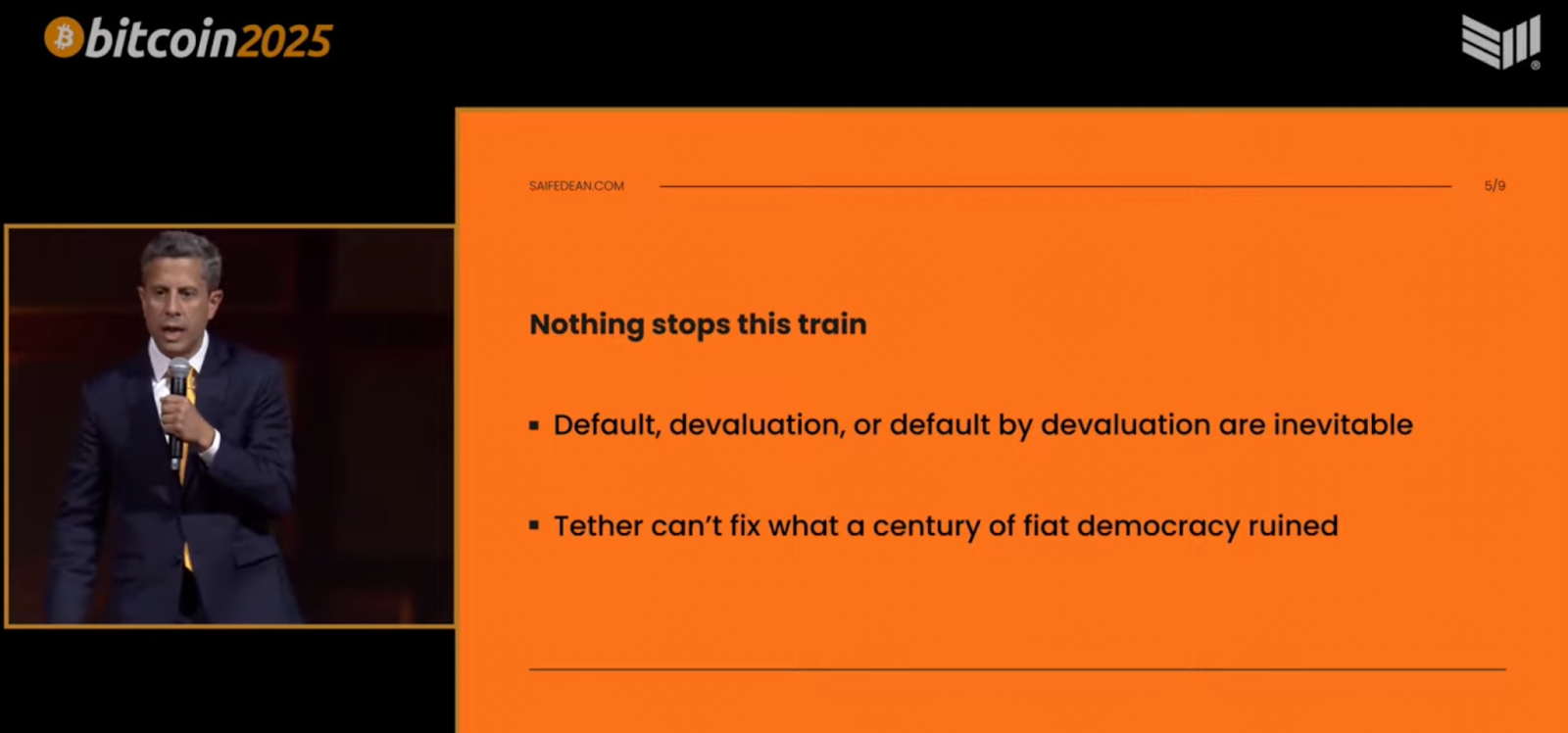
Using projections and flow charts, Ammous argued that Tether’s Bitcoin strategy could soon outpace its U.S. dollar reserves. “Then Tether will break the peg upwards,” he said, predicting a scenario where 1 USDT could equal 1.02 USD and continue revaluing as the dollar weakens. “Tether becomes a relatively stablecoin as the dollar declines.”
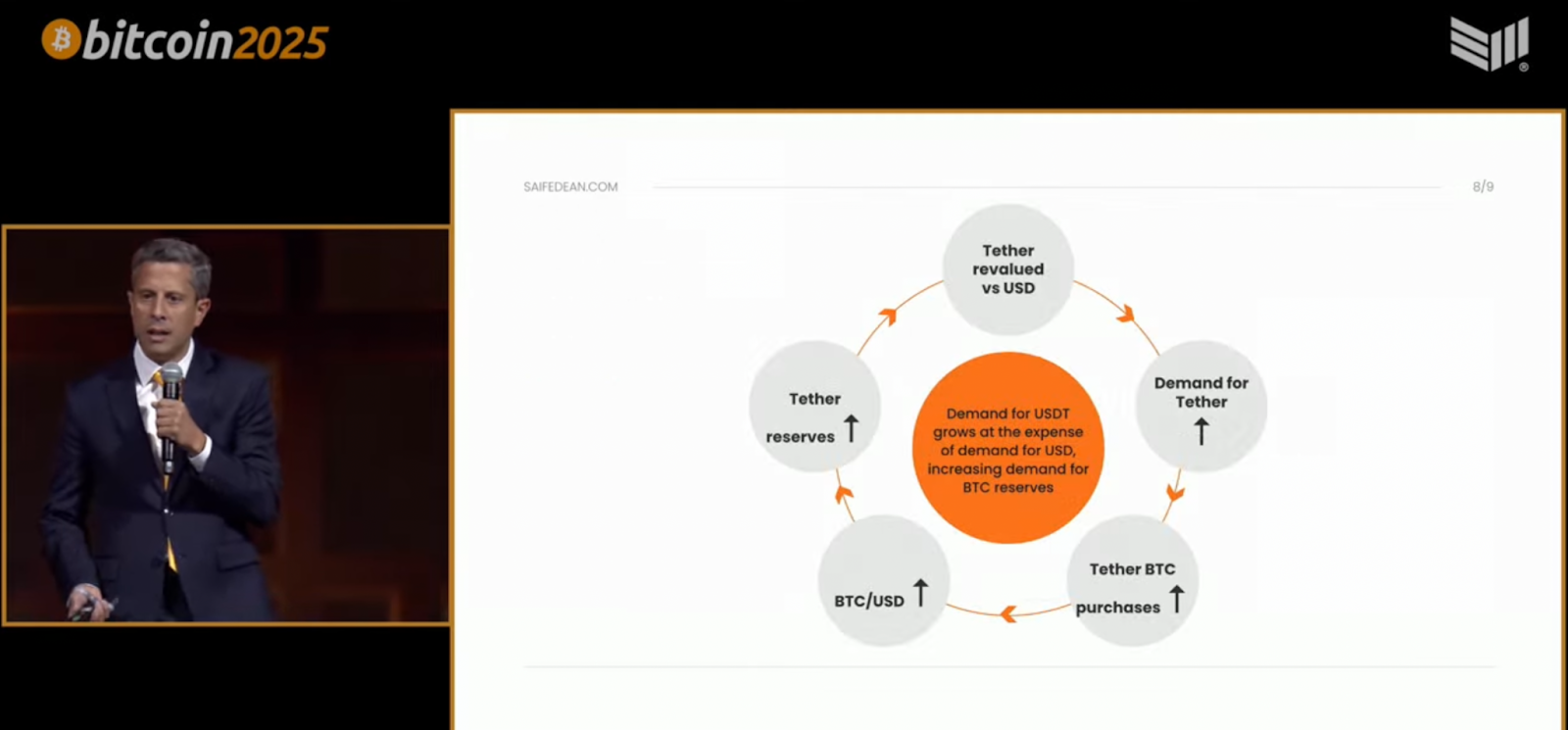
The talk emphasized what Ammous described as a self-reinforcing loop: as USDT demand rises, so does Tether’s need for BTC reserves, which drives up Bitcoin prices—leading to even more revaluation. “This is a significant impact on the market,” he said. “Buying bitcoin is the smartest thing anybody could do.”
In a final sweeping statement, Ammous forecasted the end of the USD era. “Eventually, USD reserves go to zero next to BTC reserves,” he said. “USDT keeps getting revalued upward until it is redeemable in bitcoin. USDT → BTCT.” He called Tether a “transition monetary system” and concluded, “Even the most bullish scenario for USD is much more bullish for BTC.”
To Ammous, the dollar is locked in a downward spiral while Bitcoin, with its “number go up technology,” continues rising. “The thing that goes up is going to overtake the thing that goes down,” he said—summarizing his entire argument in one sentence.
This post Saifedean Ammous: “Nothing Stops This Train” – Tether, Bitcoin, and the Endgame for the Dollar first appeared on Bitcoin Magazine and is written by Jenna Montgomery.
-
 @ 8d34bd24:414be32b
2025-05-25 06:29:21
@ 8d34bd24:414be32b
2025-05-25 06:29:21It seems like most Christians today have lost their reverence and awe of God. We’ve attributed God’s awesome creation by the word of His mouth to random chance and a Big Bang. We’ve attributed the many layers of sediment to millions and billions of years of time instead of God’s judgment of evil. We’ve emphasized His love and mercy to the point that we’ve forgotten about His holiness and righteous wrath. We’ve brought God down to our level and made Him either our “buddy” or made Him our magic genie servant, who is just there to answer our every want and whim.
The God of the Bible is a holy and awesome God who should be both loved and feared.
The fear of the Lord is the beginning of knowledge;\ Fools despise wisdom and instruction. (Proverbs 1:7)
The God of the Bible is the Lord of Lords and King of Kings who “… upholds all things by the word of His power. …” (Hebrews 1:3). Yes, God loves us as sons. Yes, God is merciful. Yes, through Jesus we have the blessed opportunity to approach God directly. None of that means we get to treat God like just another friend. We are to approach God with fear and trembling and worship Him in reverence and awe.
Worship the Lord with reverence And rejoice with trembling. (Psalm 2:11)
Part of the problem is that our culture just doesn’t show reverence to authority. It focuses on self and freedom. The whole thought of reverence for authority is incomprehensible for many. Look at this Psalm of worship:
The Lord reigns, let the peoples tremble;\ He is enthroned above the cherubim, let the earth shake!\ The Lord is great in Zion,\ And He is exalted above all the peoples.\ Let them praise Your great and awesome name;\ Holy is He. (Psalm 99:1-3)
This is the way we should view God and the proper attitude for approaching God.
Another issue is that we don’t study what God has done in the past. In the Old Testament, God commanded the Israelites to setup monuments of remembrance and to teach their kids all of the great things God had done for them. When they failed to do so, Israel drifted astray.
You shall teach them to your sons, talking of them when you sit in your house and when you walk along the road and when you lie down and when you rise up. (Deuteronomy 11:19)
God has given us the Bible, His word, so that we can know Him, know His character, and know His great deeds. When we fail to be in His word daily, we can forget (or not even know) the greatness of our God.
Establish Your word to Your servant,\ As that which produces reverence for You. (Psalm 119:38)
Do you love God’s word like this? Do you hunger for God’s word? Do you seek to know everything about God that you can know? When we love someone or something, we want to know everything about it.
Princes persecute me without cause,\ But my heart stands in awe of Your words.\ **I rejoice at Your word,\ As one who finds great spoil. \ (Psalm 119:161-162) {emphasis mine}
In addition to what we can learn about God in the Bible, we also need to remember what God has done in our own lives. We need to dwell on what God has done for us. We can just try to remember. Even better (I’ll admit this is a weakness for me), write down answered prayers, blessings, and other things God has done for you. My son has been writing down one blessing every day for over a year. What an example he is!
After we have thought about what God has done for us and those we care about, we should praise Him for His great works.
Shout joyfully to God, all the earth;\ Sing the glory of His name;\ Make His praise glorious.\ Say to God, “How awesome are Your works!\ Because of the greatness of Your power \ Your enemies will give feigned obedience to You.\ All the earth will worship You,\ And will sing praises to You;\ They will sing praises to Your name.” Selah.\ **Come and see the works of God,\ Who is awesome in His deeds toward the sons of men. \ (Psalm 66:1-5) {emphasis mine}
There is nothing we can do to earn salvation from God, but we should be in awe of what He has done for us leading to submission and obedience in gratitude.
Therefore, since we receive a kingdom which cannot be shaken, let us show gratitude, by which we may offer to God an acceptable service with reverence and awe; for our God is a consuming fire. (Hebrews 12:28-29) {emphasis mine}
Are you thankful for your blessings or resentful for what you don’t have? Do you worship God or take things He has provided for granted? Do you tell the world the awesome things God has done for you or do you stay silent? Do you claim to be a Christian, but live a life no different than those around you?
Then the Lord said,
“Because this people draw near with their words\ And honor Me with their lip service,\ But they remove their hearts far from Me,\ And their reverence for Me consists of tradition learned by rote, (Isaiah 29:13)
I hope this passage does not describe your relation ship with our awesome God. He deserves so much more. Instead we should be zealous to praise God and share His goodness with those around us.
Who is there to harm you if you prove zealous for what is good? But even if you should suffer for the sake of righteousness, you are blessed. And do not fear their intimidation, and do not be troubled, but sanctify Christ as Lord in your hearts, always being ready to make a defense to everyone who asks you to give an account for the hope that is in you, yet with gentleness and reverence; (1 Peter 3:13-15) {emphasis mine}
Did you know that you can even show reverence by your every day work?
By faith Noah, being warned by God about things not yet seen, in reverence prepared an ark for the salvation of his household, by which he condemned the world, and became an heir of the righteousness which is according to faith. (Hebrews 11:7) {emphasis mine}
When Noah stepped out in faith and obedience to God and built the ark as God commanded, despite the fact that the people around him probably thought he was crazy building a boat on dry ground that had never flooded, his work was a kind of reverence to God. Are there areas in your life where you can obey God in reverence to His awesomeness? Do you realize that quality work in obedience to God can be a form of worship?
Just going above and beyond in your job can be a form of worship of God if you are working extra hard to honor Him. Obedience is another form of worship and reverence.
Then Zerubbabel the son of Shealtiel, and Joshua the son of Jehozadak, the high priest, with all the remnant of the people, obeyed the voice of the Lord their God and the words of Haggai the prophet, as the Lord their God had sent him. And the people showed reverence for the Lord. (Haggai 1:12) {emphasis mine}
Too many people have put the word of men (especially scientists) above the word of God and have tried to change the clear meaning of the Bible. I used to think it strange how the Bible goes through the days of creation and ends each day with “and there was evening and there was morning, the xth day.” Since a day has an evening and a morning, that seemed redundant. Why did God speak in this manner? God knew that a day would come when many scientist would try to disprove God and would claim that these days were not 24 hour days, but long ages. When a writer is trying to convey long ages, the writer does not mention evening/morning and doesn’t count the days.1
When we no longer see God as speaking the universe and everything in it into existence, we tend to not see God as an awesome God. We don’t see His power. We don’t see His knowledge. We don’t see His goodness. We also don’t see His authority. Why do we have to obey God? Because He created us and because He upholds us. Without Him we would not exist. Our creator has the authority to command His creation. When we compromise in this area, we lose our submission, our awe, and our reverence. (For more on the subject see my series.) When we believe His great works, especially those spoken of in Genesis 1-11 and in Exodus, we can’t help but be in awe of our God.
For the word of the Lord is upright,\ And all His work is done in faithfulness.\ He loves righteousness and justice;\ The earth is full of the lovingkindness of the Lord.\ By the word of the Lord the heavens were made,\ And by the breath of His mouth all their host.\ He gathers the waters of the sea together as a heap;\ He lays up the deeps in storehouses.\ **Let all the earth fear the Lord;\ Let all the inhabitants of the world stand in awe of Him. \ (Psalm 33:4-8) {emphasis mine}
Remembering God’s great works, we can’t help but worship in awe and reverence.
By awesome deeds You answer us in righteousness, O God of our salvation,\ *You who are the trust of all the ends of the earth* and of the farthest sea;\ Who establishes the mountains by His strength,\ Being girded with might;\ Who stills the roaring of the seas,\ The roaring of their waves,\ And the tumult of the peoples.\ They who dwell in the ends of the earth stand in awe of Your signs;\ You make the dawn and the sunset shout for joy. \ (Psalm 65:5-8) {emphasis mine}
If we truly do have awe and reverence for our God, we should be emboldened to tell those around us of His great works.
I will tell of Your name to my brethren;\ In the midst of the assembly I will praise You.\ You who fear the Lord, praise Him;\ All you descendants of Jacob, glorify Him,\ And stand in awe of Him, all you descendants of Israel. \ (Psalm 22:22-23) {emphasis mine}
May God grant you the wisdom to see His awesomeness and to trust Him, serve Him, obey Him, and worship Him as He so rightly deserves. May you always have a right view of God and a hunger for His word and a personal relationship with Him. To God be the Glory!
Trust Jesus
FYI, these are a few more passages on the subject that are helpful, but didn’t fit in the flow of my post.
Great is the Lord, and highly to be praised,\ And His greatness is unsearchable.\ One generation shall praise Your works to another,\ And shall declare Your mighty acts.\ On the glorious splendor of Your majesty\ And on Your wonderful works, I will meditate.\ Men shall speak of the power of Your awesome acts,\ And I will tell of Your greatness. (Psalm 145:3-6)
The boastful shall not stand before Your eyes;\ You hate all who do iniquity.\ You destroy those who speak falsehood;\ The Lord abhors the man of bloodshed and deceit.\ But as for me, by Your abundant lovingkindness I will enter Your house,\ At Your holy temple I will bow in reverence for You. (Psalm 5:5-7) {emphasis mine}
If you do not listen, and if you do not take it to heart to give honor to My name,” says the Lord of hosts, “then I will send the curse upon you and I will curse your blessings; and indeed, I have cursed them already, because you are not taking it to heart. Behold, I am going to rebuke your offspring, and I will spread refuse on your faces, the refuse of your feasts; and you will be taken away with it. Then you will know that I have sent this commandment to you, that My covenant may continue with Levi,” says the Lord of hosts. “My covenant with him was one of life and peace, and I gave them to him as an object of reverence; so he revered Me and stood in awe of My name. (Malachi 2:2-5) {emphasis mine}
-
 @ c9badfea:610f861a
2025-05-25 21:03:23
@ c9badfea:610f861a
2025-05-25 21:03:23- Install AnkiDroid (it's free and open source)
- Launch the app, tap Get Started, then tap ≡ and select Settings
- Select Sync and disable Display Synchronization Status
- Return to the main screen
- Create and download flashcard decks (see links below)
- Tap ⁝, then Import, then Deck Package (.apkg), select the file and tap Add
- Select Import
- Wait for the import to finish and start learning!
Some Flashcard Deck Sources
ℹ️ On GrapheneOS, you may need to enable the Network (used for localhost access) and Read And Write To The AnkiDroid Database permissions.
ℹ️ Also check this article on formulating knowledge
-
 @ cae03c48:2a7d6671
2025-05-29 03:00:25
@ cae03c48:2a7d6671
2025-05-29 03:00:25Bitcoin Magazine

The World’s Largest Bitcoin Conference Returns to Las Vegas in 2026May 28, 2025 – BTC Inc., the leading provider of Bitcoin-related news and events, is excited to announce that the Bitcoin Conference, the world’s largest and most prestigious gathering of the Bitcoin industry, will be returning to Las Vegas next year. Next year’s conference will take place at the Venetian Las Vegas from April 27 – 29, 2026.
The announcement comes on the heels of a highly successful Bitcoin 2025 event, which saw over 35,000 attendees descend to Las Vegas to participate in valuable networking and community building events, experience leading-edge technology showcases, and hear insights from policy leaders, business executives, and celebrities across the Bitcoin industry.
“Bitcoin 2025 was the largest event in Bitcoin’s history and arrived at a pivotal moment for the industry,” said Brandon Green, Chief of Staff at BTC Inc. “Next year, we are going to compound it into not only the biggest event in Bitcoin’s history, but one of the largest and most important events globally.”
“Our city and state were delighted to host the Bitcoin conference this year,” said Governor Joe Lombardo. “Las Vegas is home to groundbreaking innovation and exciting new ideas, and we’re the perfect forum for the 2026 Bitcoin conference. We look forward to welcoming the conference to our state again next year.”
Tickets for Bitcoin 2026 are available for purchase on the official conference website. Interested individuals and organizations are encouraged to secure their spots early, as demand is expected to be unprecedented.
For sponsorship opportunities, media inquiries, or further information about The Bitcoin Conference, please contact us or visit https://b.tc/conference/2026.
About The Bitcoin Conference:
The Bitcoin Conference is the world’s largest and most influential gathering of Bitcoin professionals, investors, and thought leaders. Committed to fostering Bitcoin adoption and industry innovation, the conference has grown into a global phenomenon since its founding in 2019. Learn more at https://b.tc/conference/2026
This post The World’s Largest Bitcoin Conference Returns to Las Vegas in 2026 first appeared on Bitcoin Magazine and is written by Bitcoin Magazine.
-
 @ 866e0139:6a9334e5
2025-05-23 17:57:24
@ 866e0139:6a9334e5
2025-05-23 17:57:24Autor: Caitlin Johnstone. Dieser Beitrag wurde mit dem Pareto-Client geschrieben. Sie finden alle Texte der Friedenstaube und weitere Texte zum Thema Frieden hier. Die neuesten Pareto-Artikel finden Sie in unserem Telegram-Kanal.
Die neuesten Artikel der Friedenstaube gibt es jetzt auch im eigenen Friedenstaube-Telegram-Kanal.
Ich hörte einem jungen Autor zu, der eine Idee beschrieb, die ihn so sehr begeisterte, dass er die Nacht zuvor nicht schlafen konnte. Und ich erinnerte mich daran, wie ich mich früher – vor Gaza – über das Schreiben freuen konnte. Dieses Gefühl habe ich seit 2023 nicht mehr gespürt.
Ich beklage mich nicht und bemitleide mich auch nicht selbst, ich stelle einfach fest, wie unglaublich düster und finster die Welt in dieser schrecklichen Zeit geworden ist. Es wäre seltsam und ungesund, wenn ich in den letzten anderthalb Jahren Freude an meiner Arbeit gehabt hätte. Diese Dinge sollen sich nicht gut anfühlen. Nicht, wenn man wirklich hinschaut und ehrlich zu sich selbst ist in dem, was man sieht.
Es war die ganze Zeit über so hässlich und so verstörend. Es gibt eigentlich keinen Weg, all diesen Horror umzudeuten oder irgendwie erträglich zu machen. Alles, was man tun kann, ist, an sich selbst zu arbeiten, um genug inneren Raum zu schaffen, um die schlechten Gefühle zuzulassen und sie ganz durchzufühlen, bis sie sich ausgedrückt haben. Lass die Verzweiflung herein. Die Trauer. Die Wut. Den Schmerz. Lass sie deinen Körper vollständig durchfließen, ohne Widerstand, und steh dann auf und schreibe das nächste Stück.
Das ist es, was Schreiben für mich jetzt ist. Es ist nie etwas, worüber ich mich freue, es zu teilen, oder wofür ich von Inspiration erfüllt bin. Wenn überhaupt, dann fühlt es sich eher so an wie: „Okay, hier bitte, es tut mir schrecklich leid, dass ich euch das zeigen muss, Leute.“ Es ist das Starren in die Dunkelheit, in das Blut, in das Gemetzel, in die gequälten Gesichter – und das Aufschreiben dessen, was ich sehe, Tag für Tag.
Nichts daran ist angenehm oder befriedigend. Es ist einfach das, was man tut, wenn ein Genozid in Echtzeit vor den eigenen Augen stattfindet, mit der Unterstützung der eigenen Gesellschaft. Alles daran ist entsetzlich, und es gibt keinen Weg, das schönzureden – aber man tut, was getan werden muss. So, wie man es täte, wenn es die eigene Familie wäre, die da draußen im Schutt liegt.
Dieser Genozid hat mich für immer verändert. Er hat viele Menschen für immer verändert. Wir werden nie wieder dieselben sein. Die Welt wird nie wieder dieselbe sein. Ganz gleich, was passiert oder wie dieser Albtraum endet – die Dinge werden nie wieder so sein wie zuvor.
Und das sollten sie auch nicht. Der Holocaust von Gaza ist das Ergebnis der Welt, wie sie vor ihm war. Unsere Gesellschaft hat ihn hervorgebracht – und jetzt starrt er uns allen direkt ins Gesicht. Das sind wir. Das ist die Frucht des Baumes, den die westliche Zivilisation bis zu diesem Punkt gepflegt hat.
Jetzt geht es nur noch darum, alles zu tun, was wir können, um den Genozid zu beenden – und sicherzustellen, dass die Welt die richtigen Lehren daraus zieht. Das ist eines der würdigsten Anliegen, denen man sich in diesem Leben widmen kann.
Ich habe noch immer Hoffnung, dass wir eine gesunde Welt haben können. Ich habe noch immer Hoffnung, dass das Schreiben über das, was geschieht, eines Tages wieder Freude bereiten kann. Aber diese Dinge liegen auf der anderen Seite eines langen, schmerzhaften, konfrontierenden Weges, der in den kommenden Jahren vor uns liegt. Es gibt keinen Weg daran vorbei.
Die Welt kann keinen Frieden und kein Glück finden, solange wir uns nicht vollständig damit auseinandergesetzt haben, was wir Gaza angetan haben.
Dieser Text ist die deutsche Übersetzung dieses Substack-Artikels von Caitlin Johnstone.
LASSEN SIE DER FRIEDENSTAUBE FLÜGEL WACHSEN!
Hier können Sie die Friedenstaube abonnieren und bekommen die Artikel zugesandt.
Schon jetzt können Sie uns unterstützen:
- Für 50 CHF/EURO bekommen Sie ein Jahresabo der Friedenstaube.
- Für 120 CHF/EURO bekommen Sie ein Jahresabo und ein T-Shirt/Hoodie mit der Friedenstaube.
- Für 500 CHF/EURO werden Sie Förderer und bekommen ein lebenslanges Abo sowie ein T-Shirt/Hoodie mit der Friedenstaube.
- Ab 1000 CHF werden Sie Genossenschafter der Friedenstaube mit Stimmrecht (und bekommen lebenslanges Abo, T-Shirt/Hoodie).
Für Einzahlungen in CHF (Betreff: Friedenstaube):

Für Einzahlungen in Euro:
Milosz Matuschek
IBAN DE 53710520500000814137
BYLADEM1TST
Sparkasse Traunstein-Trostberg
Betreff: Friedenstaube
Wenn Sie auf anderem Wege beitragen wollen, schreiben Sie die Friedenstaube an: friedenstaube@pareto.space
Sie sind noch nicht auf Nostr and wollen die volle Erfahrung machen (liken, kommentieren etc.)? Zappen können Sie den Autor auch ohne Nostr-Profil! Erstellen Sie sich einen Account auf Start. Weitere Onboarding-Leitfäden gibt es im Pareto-Wiki.
-
 @ 33baa074:3bb3a297
2025-05-28 08:54:40
@ 33baa074:3bb3a297
2025-05-28 08:54:40COD (chemical oxygen demand) sensors play a vital role in water quality testing. Their main functions include real-time monitoring, pollution event warning, water quality assessment and pollution source tracking. The following are the specific roles and applications of COD sensors in water quality testing:
Real-time monitoring and data acquisition COD sensors can monitor the COD content in water bodies in real time and continuously. Compared with traditional sampling methods, COD sensors are fast and accurate, without manual sampling and laboratory testing, which greatly saves time and labor costs. By combining with the data acquisition system, the monitoring data can be uploaded to the cloud in real time to form a extemporization distribution map of the COD content in the water body, providing detailed data support for environmental monitoring and management.
Pollution event warning and rapid response COD sensors play an important role in early warning and rapid response in water environment monitoring. Once there is an abnormal increase in organic matter in the water body, the COD sensor can quickly detect the change in COD content and alarm through the preset threshold. This enables relevant departments to take measures at the early stage of the pollution incident to prevent the spread of pollution and protect the water environment.
Water quality assessment and pollution source tracking COD sensors play an important role in water quality assessment and pollution source tracking. By continuously monitoring the COD content in water bodies, the water quality can be evaluated and compared with national and regional water quality standards. At the same time, COD sensors can also help determine and track the location and spread of pollution sources, provide accurate data support for environmental management departments, and guide the development of pollution prevention and control work.
Application scenarios COD sensors are widely used in various water quality monitoring scenarios, including but not limited to: Sewage treatment plants: used to monitor the COD content of in fluent and effluent to ensure the effect of sewage treatment. Water source protection and management: deployed in water sources to monitor the COD content of in fluent sources. Once the water quality exceeds the set limit, the system will issue an alarm in time to ensure water quality safety. Lake and river monitoring: deployed in water bodies such as lakes and rivers to monitor the COD content of water bodies in real time.

Technical features of COD sensor COD sensor uses advanced technology, such as ultraviolet absorption method, which does not require the use of chemical reagents, avoiding the risk of contamination of chemical reagents in traditional COD detection methods, and can achieve online uninterrupted water quality monitoring, providing strong support for real-time water quality assessment. In addition, COD sensor also has the advantages of low cost, high stability, strong anti-interference ability, and convenient installation.
Summary In summary, COD sensor plays an irreplaceable role in water quality detection. It can not only provide real-time and accurate water quality data, but also quickly warn when pollution incidents occur, providing strong technical support for water quality management and environmental protection. With the advancement of technology and the popularization of applications, COD sensor will play a more important role in water quality monitoring in the future.
-
 @ 99e7936f:d5d2197c
2025-05-23 13:51:11
@ 99e7936f:d5d2197c
2025-05-23 13:51:11Staugefahr
Manchmal ist der Lehrer interessanter als der Unterrichtsinhalt. Man lernt dann beiläufig, obwohl das Thema öde ist. Mir ging das vor vielen Jahren so, als ich in meiner Ausbildung zur Krankenschwester Inhalte zum Thema Hygiene lernen durfte. Unser Lehrer für Hygiene duschte morgens in der Schule, bevor er uns unterrichtete, damit er, sauber vor uns sitzend, glaubwürdig über die permanente Gefahr der Mikroorganismen im Klinikalltag reden konnte. Er lebte das, was er predigte. Er bot pathogenen Keimen keinen Nährboden. Er pflegte sich und seine Kleidung penibel. Er trug Hosen, Pullover und Schuhe aus den 70ern, die kaum Gebrauchsspuren aufwiesen. Er blieb Überzeugungen, die er einmal für richtig befunden hatte, treu, war aber stets bereit, etwas Neues anzunehmen, wenn dies Sinn machte. Bevor er jedoch Neues annahm, prüfte er mehrfach gründlich, las Fachliteratur und vermied Gespräche mit Experten.
Er versuchte damals, Entscheidungsträger in der Klinik darüber aufzuklären, wie man mit einfachen Mitteln Infektionen im Hause hätte minimieren können. Meist wurden seine Vorschläge nur zögerlich umgesetzt, obwohl seine Argumente fachlich richtig waren.
Mir kommt es heute mit dem Thema „Trauma“ und „traumatisierte Gesellschaft“ ähnlich vor. Niemand möchte sich mit dem Thema beschäftigen, obwohl doch alle wissen müssten, dass viele unangenehme Verhaltensweisen von Menschen im Alltag oder in der Politik etwas mit diesem Thema zu tun haben. Aber das Thema scheint irgendwie unbequem, mühsam und, vor allem, nicht greifbar.
Ein Trauma kann man genau so wenig sehen wie einen pathogenen Keim, deswegen scheint die Auseinandersetzung mit diesem Thema wie eine unappetitliche und lästige Pflichtaufgabe, die man nur mit spitzen Fingern anfasst, wenn überhaupt.
Wie kann man dieses dringend zu besprechende Thema „Trauma“ sichtbar machen?
Vielleicht geht das mit dem Bild vom Stau auf der Autobahn. Den kennt jeder. Und den Stau kann man nicht übersehen. Große leuchtende Schilder weisen auf ihn hin, damit man nicht unvorbereitet in ihn hinein fährt. Überall wird vor dem Stau gewarnt. Und trotzdem passiert er, denn wir sind der Stau, wir selbst machen den Stau.
Stau passiert, weil es Hindernisse auf unserem Weg gibt.
Der Stau ist VOR dem Hindernis. Die Traumafolgen sind gewissermaßen der Stau in unserem Leben, obwohl das Trauma HINTER uns liegt. Wie geht das? Ein Trauma liegt zeitlich gesehen zwar in der Vergangenheit, aber energetisch gesehen liegt es immer vor uns. Es begleitet uns, verfolgt uns, holt uns ein. Energie kennt kein VOR oder HINTER. Energie ist allgegenwärtig. Sobald das Trauma integriert ist, hört dieser Spuk auf. Aber ein nicht bearbeitetes Trauma stellt definitiv ein Hindernis auf unserem (Lebens)Weg dar. Es liegt dann VOR uns.
Dieser Vergleich humpelt ein wenig, zeigt aber dennoch die einfachen Mechanismen von Trauma auf, wie ich finde.
Auf der Autobahn gibt es also ein Hindernis. Entweder gibt es eine bekannte Baustelle, die wir bereits beim Planen der Route zur Kenntnis genommen haben (Trauma ist bereits gut bekannt). Oder es gibt einen Unfall auf der Strecke vor uns, den niemand absehen konnte (Das frühe Trauma wird in einer Alltagssituation plötzlich aktiviert). Jedenfalls stehen wir dann geplant oder ungeplant im Stau, vielmehr sind wir der Stau. Es geht nur langsam oder gar nicht mehr weiter, obwohl der (Lebens)Motor läuft. Bei Trauma ist das auch so. Trauma bewirkt ganz viel Entwicklungsverzögerung in einzelnen Lebensbereichen. Menschen erlernen mehrere Berufe, brauchen länger, um beruflich anzukommen, heiraten später, mehrfach oder nie. Menschen mit Trauma haben manchmal auch beruflich wie privat große Erfolge, fallen dann aber tief, um dadurch letztlich neu geboren zu werden. Trauma sieht man nicht immer auf den ersten Blick. Es kann auch hinter jeder normalen Fassade stecken. Je nach Schwere des Traumas, kann Trauma auch alle Lebensbereiche gleichermaßen treffen. Das entspricht dann dem Pendler, der regelmäßig Sommer wie Winter im Stau steht und auch schon selbst mal eine Panne, im Stau stehend, hatte.
Man erreicht einfach nicht die Ziele, die man sich selbst gesteckt hat. Man kann dann versuchen, die nächste Abfahrt zu nehmen, einen Umweg zu fahren, während des Staus etwas anderes zu erledigen, sich selbst zu erzählen, dass ein Stau gar kein Hindernis sei, sondern eine prima Gelegenheit, um eine Pause zu machen. Und man kann andere Menschen anrufen und erklären, dass man später komme oder sonstiges tun. Aber man steht im Stau, man ist der Stau. Es geht nicht so weiter, wie gewünscht, und man muss das hinnehmen. Verschiedene unangenehme Gefühle melden sich zwangsläufig. Man stellt sich die Sinnfrage, man schaut, wie andere mit dem Stau umgehen, und man möchte gefühlt nie wieder in einem Stau stehen, weil es nervt. Es bringt einen nicht um, aber es nervt. Und es ist ja nicht das erste Mal. Man möchte so gern ein Leben haben ohne Stau. Das wär´s. Es nervt einfach. Und dann nach langer Zeit, mit Blick auf die Tankanzeige, geht es endlich weiter. Die Autos fahren langsam an und der Verkehr rollt wieder. Man wirft einen kurzen Blick auf das Verkehrshindernis und fährt dann zügig weiter. Denn man will nur noch weg von diesem Streckenabschnitt/ Lebensabschnitt. Der Stresspegel im Körper geht runter, man atmet durch und entspannt sich. Aber es war unschön. Nächstes Mal will man die Route besser planen oder gleich mit dem Zug fahren. Man ist erleichtert und hat endlich die Kontrolle über sein Leben zurück. Jetzt ist alles möglich.
Es gibt viele Parallelen zwischen einem Stau und einem Trauma bzw. den Traumafolgen.
Traumabewältigung ist jedoch viel schmerzhafter, als an einem Verkehrshindernis nach längerer Wartezeit einfach vorbei zu fahren. Und man verpasst auch mehr im Leben als nur eine Stunde Zeit, die man auf leblosem Asphalt verbringt. Der Preis, den man für Trauma bezahlt, ist kaum zu beziffern. Und ein Trauma wirft nicht nur die Sinnfrage auf, sondern auch die Frage nach der eigenen Identität. Im Stau auf der Autobahn weiß ich genau, wer ich bin. Aber nach einem frühen Trauma gehen einige Seelenanteile auf eine lange Reise. Und wenn ein Trauma später im Leben passiert, dann sagen Menschen: „Ich habe mich selbst nicht mehr wieder erkannt.“ Trauma wirbelt alles in Dir durcheinander. Und genau darin liegt die Chance. Du musst jedes Teil, jeden Aspekt Deiner Persönlichkeit einzeln in die Hand nehmen, an den richtigen Ort zurück legen, und dadurch lernst Du Dich selbst kennen (und lieben) wie nie zuvor. Der Gewinn von Traumaarbeit übersteigt den zuvor gezahlten Preis. Das nennt man dann posttraumatisches Wachstum. Man ist erleichtert und hat viel mehr als nur die Kontrolle über sein Leben zurück. Eigentlich ist das schon die ganze Geschichte.
Das riesige Problem an der Traumabewältigung ist halt, dass es ein so schmerzhafter und langwieriger Prozess ist. Aber auch hier gibt es gute Nachrichten. Viel von dem Kummer, den wir „im Stau“ erleben, hat etwas mit unseren positiv wie negativ übertriebenen Erwartungen an uns und andere und dem verloren gegangenen Kulturwissen in Bezug auf das Thema „Trauma“ zu tun. Trauma hat die Eigenart, in Vergessenheit zu geraten. Daher gibt es viele falsche Verkehrsmeldungen diesbezüglich. Deswegen möchte ich mein Erfahrungswissen zum Thema „Trauma“ teilen, weil ich denke, dass das Ängste abbauen kann, sich diesem Thema auf ganz natürliche Weise anzunähern, vergleichbar mit der WDR-Produktion „der siebte Sinn“ und getreu dem Motto „Gefahr erkannt, Gefahr gebannt“.
Man kann jedes Problem aufbauschen oder sachlich betrachten. Und es macht einen riesigen Unterschied, ob man mit einem Problem allein gelassen wird, oder ob man wohlwollende und kundige Hilfe an der Seite hat. Und genau dies sind meine zentralen Kritikpunkte zum Thema. Das Thema „Trauma“ wird als unlösbar hingestellt und dadurch unnötig aufgebauscht. Deswegen muss man dieses Thema quasi schon vermeiden, wenn man sich nicht den Tag verderben möchte. Und in der Folge werden von Experten Hilfen angepriesen, die aber leider oft nicht zuverlässig helfen können, weil das Thema ja unlösbar ist. Der verhängnisvolle Kreis schließt sich, und man kommt ins Schleudern.
Kulturwissen wird verfälscht und verdreht, ein übles Schleudertrauma entsteht.
Nein, mal im Ernst, ich möchte das Thema sachlich betrachten und zumindest Impulse für eine günstige Betrachtungsweise geben. Diese Impulse kommen aus meinen persönlichen Erfahrungen und aus Beobachtungen, die ich gemacht habe. Mir ist bewusst, dass jeder Mensch Verletzungen und spätere Probleme, die daraus resultieren, unterschiedlich erlebt. Aber vielleicht geht es gerade um diesen in unserer Kultur fehlenden analogen, lebendigen und authentischen Austausch von Nicht-Experten über die verschiedenen Verletzungen, die daraus resultierende Probleme und die - sehr wohl - vorhandenen Lösungen.
Trauma ist das, was man draus macht.
Ich persönlich kenne niemanden, der kein Trauma erlebt hat.
Leben bedeutet immer auch, dass man Verletzungen erlebt.
Trauma passiert jedem.
Trauma passiert auch robusten Menschen.
Bestimmte Traumata haben immer sehr ähnliche Traumafolgen. Man ist nicht alleine damit.
Menschen reagieren ähnlich auf bestimmte Ereignisse im Leben, das hängt mit unserem Menschsein, der Biologie und der Evolution zusammen.
Menschen reden nicht gern über ihr Trauma.
Menschen schämen sich für ihr Trauma.
Menschen geben sich selbst die Schuld für ihr Trauma.
Menschen versuchen alles, um ihr Trauma zu vergessen oder ungeschehen zu machen.
Menschen erleben einen tiefen Schmerz durch Trauma.
Menschen werden aggressiv, weil sie selber verletzt wurden.
Menschen werden durch Aggression selbst zum Täter. Diese Gefahr besteht zumindest.
Menschen lehnen sich selbst ab für diese aggressiven Impulse.
Alle Gefühle haben eine Funktion. Auch negative Gefühle haben eine Funktion.
Negative Gefühle beschützen unser Leben.
Deswegen sind auch negative Gefühle im bestimmten Maße gut.
Der Schmerz, der durch Trauma entsteht, hat jedoch eine besondere Funktion.
Streng genommen, ist er kein Gefühl, aber egal.
Er ist jedenfalls der letzte und wichtigste Hüter des Lebens. Man sollte ihn nicht übergehen oder versuchen, ihn weg zu machen. Er ist die rote Ampel, die den Stau regelt.
Eine rote Ampel in einem Stau zu ignorieren, ist verhängnisvoll.
Halte lieber an dieser roten Ampel im Stau, auch wenn es schmerzt.
Dieser Schmerz ist die schwierigste, aber auch wichtigste Herausforderung bei der Traumabewältigung, denn er verzögert Dein ohnehin gestautes Leben noch zusätzlich.
Wer es schafft, die Geduld aufzubringen und sich diesem Schmerz hinzugeben, der erlebt Wunder.
Dieses schlimmste Gefühl bringt Dir quasi Dein Leben und die grüne Welle zurück.
Wenn der Schmerz zu Dir kommt, dann heiße ihn willkommen.
Wir sind gesellschaftlich betrachtet mit unseren unguten Verhaltensweisen mittlerweile im Stau angekommen, und die Ampel, die den Stau regelt, steht auf Rot.
Je ehrlicher wir den Schmerz jetzt zulassen, spüren und nicht wegmachen, desto eher sind wir bereit, unbequeme Veränderungen, die vielleicht mit Verzicht, Orientierungslosigkeit und zaghaften Versuchen zu tun haben, zu beginnen. Im Schmerz wächst ein Bewusstsein dafür, was richtig ist. Und es wächst die Kraft, das Gute zu tun. Der Schmerz macht entschlossen. Der Schmerz zeigt, wo das Lebendige liegt und dass es schützenswert ist. Der Schmerz reduziert unseren Blick auf das Wesentliche, auf das Leben und die Liebe, was aufs Gleiche heraus kommt. Der Schmerz markiert einfach nur die Grenze des Lebens. Und deswegen ist er gut, besonders in diesen Tagen.
Heiße den Schmerz willkommen, er gibt uns alle Information FÜR das Leben.
-
 @ 06830f6c:34da40c5
2025-05-24 04:21:03
@ 06830f6c:34da40c5
2025-05-24 04:21:03The evolution of development environments is incredibly rich and complex and reflects a continuous drive towards greater efficiency, consistency, isolation, and collaboration. It's a story of abstracting away complexity and standardizing workflows.
Phase 1: The Bare Metal & Manual Era (Early 1970s - Late 1990s)
-
Direct OS Interaction / Bare Metal Development:
- Description: Developers worked directly on the operating system's command line or a basic text editor. Installation of compilers, interpreters, and libraries was a manual, often arcane process involving downloading archives, compiling from source, and setting environment variables. "Configuration drift" (differences between developer machines) was the norm.
- Tools: Text editors (Vi, Emacs), command-line compilers (GCC), Makefiles.
- Challenges: Extremely high setup time, dependency hell, "works on my machine" syndrome, difficult onboarding for new developers, lack of reproducibility. Version control was primitive (e.g., RCS, SCCS).
-
Integrated Development Environments (IDEs) - Initial Emergence:
- Description: Early IDEs (like Turbo Pascal, Microsoft Visual Basic) began to integrate editors, compilers, debuggers, and sometimes GUI builders into a single application. This was a massive leap in developer convenience.
- Tools: Turbo Pascal, Visual Basic, early Visual Studio versions.
- Advancement: Improved developer productivity, streamlined common tasks. Still relied on local system dependencies.
Phase 2: Towards Dependency Management & Local Reproducibility (Late 1990s - Mid-2000s)
-
Basic Build Tools & Dependency Resolvers (Pre-Package Managers):
- Description: As projects grew, manual dependency tracking became impossible. Tools like Ant (Java) and early versions of
autoconf/makefor C/C++ helped automate the compilation and linking process, managing some dependencies. - Tools: Apache Ant, GNU Autotools.
- Advancement: Automated build processes, rudimentary dependency linking. Still not comprehensive environment management.
- Description: As projects grew, manual dependency tracking became impossible. Tools like Ant (Java) and early versions of
-
Language-Specific Package Managers:
- Description: A significant leap was the emergence of language-specific package managers that could fetch, install, and manage libraries and frameworks declared in a project's manifest file. Examples include Maven (Java), npm (Node.js), pip (Python), RubyGems (Ruby), Composer (PHP).
- Tools: Maven, npm, pip, RubyGems, Composer.
- Advancement: Dramatically simplified dependency resolution, improved intra-project reproducibility.
- Limitation: Managed language-level dependencies, but not system-level dependencies or the underlying OS environment. Conflicts between projects on the same machine (e.g., Project A needs Python 2.7, Project B needs Python 3.9) were common.
Phase 3: Environment Isolation & Portability (Mid-2000s - Early 2010s)
-
Virtual Machines (VMs) for Development:
- Description: To address the "it works on my machine" problem stemming from OS-level and system-level differences, developers started using VMs. Tools like VMware Workstation, VirtualBox, and later Vagrant (which automated VM provisioning) allowed developers to encapsulate an entire OS and its dependencies for a project.
- Tools: VMware, VirtualBox, Vagrant.
- Advancement: Achieved strong isolation and environment reproducibility (a true "single environment" for a project).
- Limitations: Resource-heavy (each VM consumed significant CPU, RAM, disk space), slow to provision and boot, difficult to share large VM images.
-
Early Automation & Provisioning Tools:
- Description: Alongside VMs, configuration management tools started being used to automate environment setup within VMs or on servers. This helped define environments as code, making them more consistent.
- Tools: Chef, Puppet, Ansible.
- Advancement: Automated provisioning, leading to more consistent environments, often used in conjunction with VMs.
Phase 4: The Container Revolution & Orchestration (Early 2010s - Present)
-
Containerization (Docker):
- Description: Docker popularized Linux Containers (LXC), offering a lightweight, portable, and efficient alternative to VMs. Containers package an application and all its dependencies into a self-contained unit that shares the host OS kernel. This drastically reduced resource overhead and startup times compared to VMs.
- Tools: Docker.
- Advancement: Unprecedented consistency from development to production (Dev/Prod Parity), rapid provisioning, highly efficient resource use. Became the de-facto standard for packaging applications.
-
Container Orchestration:
- Description: As microservices and container adoption grew, managing hundreds or thousands of containers became a new challenge. Orchestration platforms automated the deployment, scaling, healing, and networking of containers across clusters of machines.
- Tools: Kubernetes, Docker Swarm, Apache Mesos.
- Advancement: Enabled scalable, resilient, and complex distributed systems development and deployment. The "environment" started encompassing the entire cluster.
Phase 5: Cloud-Native, Serverless & Intelligent Environments (Present - Future)
-
Cloud-Native Development:
- Description: Leveraging cloud services (managed databases, message queues, serverless functions) directly within the development workflow. Developers focus on application logic, offloading infrastructure management to cloud providers. Containers become a key deployment unit in this paradigm.
- Tools: AWS Lambda, Azure Functions, Google Cloud Run, cloud-managed databases.
- Advancement: Reduced operational overhead, increased focus on business logic, highly scalable deployments.
-
Remote Development & Cloud-Based IDEs:
- Description: The full development environment (editor, terminal, debugger, code) can now reside in the cloud, accessed via a thin client or web browser. This means developers can work from any device, anywhere, with powerful cloud resources backing their environment.
- Tools: GitHub Codespaces, Gitpod, AWS Cloud9, VS Code Remote Development.
- Advancement: Instant onboarding, consistent remote environments, access to high-spec machines regardless of local hardware, enhanced security.
-
Declarative & AI-Assisted Environments (The Near Future):
- Description: Development environments will become even more declarative, where developers specify what they need, and AI/automation tools provision and maintain it. AI will proactively identify dependency issues, optimize resource usage, suggest code snippets, and perform automated testing within the environment.
- Tools: Next-gen dev container specifications, AI agents integrated into IDEs and CI/CD pipelines.
- Prediction: Near-zero environment setup time, self-healing environments, proactive problem identification, truly seamless collaboration.
web3 #computing #cloud #devstr
-
-
 @ 58537364:705b4b85
2025-05-28 08:25:55
@ 58537364:705b4b85
2025-05-28 08:25:55ถ้าอยากแล้วไม่หลง มันก็อยากด้วยปัญญา ความอยากอย่างนี้ท่านเรียกว่า เป็นบารมีของตน แต่ไม่ใช่ทุกคนนะที่มีปัญญา
บางคนไม่อยากจะให้มันอยาก เพราะเข้าใจว่า การมาปฏิบัติก็เพื่อระงับความอยาก ความจริงน่ะ ถ้าหากว่าไม่มีความอยาก ก็ไม่มีข้อปฏิบัติ ไม่รู้ว่าจะทำอะไร ลองพิจารณาดูก็ได้
ทุกคน แม้องค์พระพุทธเจ้าของเราก็ตาม ที่ท่านออกมาปฏิบัติ ก็เพื่อจะให้บรรเทากิเลสทั้งหลายนั้น
แต่ว่ามันต้องอยากทำ อยากปฏิบัติ อยากให้มันสงบ และก็ไม่อยากให้มันวุ่นวาย ทั้งสองอย่างนี้ มันเป็นอุปสรรคทั้งนั้น ถ้าเราไม่มีปัญญา ไม่มีความฉลาดในการกระทำอย่างนั้น เพราะว่ามันปนกันอยู่ อยากทั้งสองอย่างนี้มันมีราคาเท่า ๆ กัน
อยากจะพ้นทุกข์มันเป็นกิเลส สำหรับคนไม่มีปัญญา อยากด้วยความโง่ ไม่อยากมันก็เป็นกิเลส เพราะไม่อยากอันนั้นมันประกอบด้วยความโง่เหมือนกัน คือทั้งอยาก ไม่อยาก ปัญญาก็ไม่มี ทั้งสองอย่างนี้ มันเป็นกามสุขัลลิกานุโยโค กับอัตตกิลมถานุโยโค ซึ่งพระพุทธองค์ของเรา ขณะที่พระองค์กำลังทรงปฏิบัติอยู่นั้น ท่านก็หลงใหลในอย่างนี้ ไม่รู้ว่าจะทำอย่างไร ท่านหาอุบายหลายประการ กว่าจะพบของสองสิ่งนี้
ทุกวันนี้เราทั้งหลายก็เหมือนกัน ทุกสิ่งทั้งสองอย่างนี้มันกวนอยู่ เราจึงเข้าสู่ทางไม่ได้ก็เพราะอันนี้ ความเป็นจริงนี้ทุกคนที่มาปฏิบัติ ก็เป็นปุถุชนมาทั้งนั้น ปุถุชนก็เต็มไปด้วยความอยาก ความอยากที่ไม่มีปัญญา อยากด้วยความหลง ไม่อยากมันก็มีโทษเหมือนกัน “ไม่อยาก” มันก็เป็นตัณหา “อยาก” มันก็เป็นตัณหาอีกเหมือนกัน
ทีนี้ นักปฏิบัติยังไม่รู้เรื่องว่า จะเอายังไงกัน เดินไปข้างหน้าก็ไม่ถูก เดินกลับไปข้างหลังก็ไม่ถูก จะหยุดก็หยุดไม่ได้เพราะมันยังอยากอยู่ มันยังหลงอยู่ มีแต่ความอยาก แต่ปัญญาไม่มี มันอยากด้วยความหลง มันก็เป็นตัณหา ถึงแม้ไม่อยาก มันก็เป็นความหลง มันก็เป็นตัณหาเหมือนกันเพราะอะไร? เพราะมันขาดปัญญา
ความเป็นจริงนั้น ธรรมะมันอยู่ตรงนั้นแหละ ตรงความอยากกับความไม่อยากนั่นแหละ แต่เราไม่มีปัญญา ก็พยายามไม่ให้อยากบ้าง เดี๋ยวก็อยากบ้าง อยากให้เป็นอย่างนั้น ไม่อยากให้เป็นอย่างนี้ ความจริงทั้งสองอย่างนี้ หรือทั้งคู่นี้มันตัวเดียวกันทั้งนั้น ไม่ใช่คนละตัว แต่เราไม่รู้เรื่องของมัน
พระพุทธเจ้าของเรา และสาวกทั้งหลายของพระองค์นั้นท่านก็อยากเหมือนกัน แต่ “อยาก” ของท่านนั้น เป็นเพียงอาการของจิตเฉย ๆ หรือ “ไม่อยาก” ของท่าน ก็เป็นเพียงอาการของจิตเฉย ๆ อีกเหมือนกัน มันวูบเดียวเท่านั้น ก็หายไปแล้ว
ดังนั้น ความอยากหรือไม่อยากนี้ มันมีอยู่ตลอดเวลาแต่สำหรับผู้มีปัญญานั้น “อยาก” ก็ไม่มีอุปาทาน “ไม่อยาก” ก็ไม่มีอุปาทาน เป็น “สักแต่ว่า” อยากหรือไม่อยากเท่านั้น ถ้าพูดตามความจริงแล้ว มันก็เป็นแต่ "อาการของจิต" อาการของจิตมันเป็นของมันอย่างนั้นเอง ถ้าเรามาตะครุบมันอยู่ใกล้ ๆ นี่มันก็เห็นชัด
ดังนั้นจึงว่า การพิจารณานั้น ไม่ใช่รู้ไปที่อื่น มันรู้ตรงนี้แหละ เหมือนชาวประมงที่ออกไปทอดแหนั่นแหละ ทอดแหออกไปถูกปลาตัวใหญ่ เจ้าของผู้ทอดแหจะคิดอย่างไร? ก็กลัว กลัวปลาจะออกจากแหไปเสีย เมื่อเป็นเช่นนั้น ใจมันก็ดิ้นรนขึ้นระวังมาก บังคับมาก ตะครุบไปตะครุบมาอยู่นั่นแหละ ประเดี๋ยวปลามันก็ออกจากแหไปเสีย เพราะไปตะครุบมันแรงเกินไป
อย่างนั้นโบราณท่านพูดถึงเรื่องอันนี้ ท่านว่าค่อย ๆ ทำมัน แต่อย่าไปห่างจากมัน นี่คือปฏิปทาของเรา ค่อย ๆ คลำมันไปเรื่อย ๆ อย่างนั้นแหละ
อย่าปล่อยมัน หรือไม่อยากรู้มัน ต้องรู้ ต้องรู้เรื่องของมัน พยายามทำมันไปเรื่อย ๆ ให้เป็นปฏิปทา ขี้เกียจเราก็ทำไม่ขี้เกียจเราก็ทำ เรียกว่าการทำการปฏิบัติ ต้องทำไปเรื่อยๆอย่างนี้
ถ้าหากว่าเราขยัน ขยันเพราะความเชื่อ มันมีศรัทธาแต่ปัญญาไม่มี ถ้าเป็นอย่างนี้ ขยันไป ๆ แล้วมันก็ไม่เกิดผลอะไรขึ้นมากมาย ขยันไปนาน ๆ เข้า แต่มันไม่ถูกทาง มันก็ไม่สงบระงับ ทีนี้ก็จะเกิดความคิดว่า เรานี้บุญน้อยหรือวาสนาน้อย หรือคิดไปว่ามนุษย์ในโลกนี้คงทำไม่ได้หรอก แล้วก็เลยหยุดเลิกทำเลิกปฏิบัติ
ถ้าเกิดความคิดอย่างนี้เมื่อใด ขอให้ระวังให้มาก ให้มีขันติ ความอดทน ให้ทำไปเรื่อย ๆ เหมือนกับเราจับปลาตัวใหญ่ ก็ให้ค่อย ๆ คลำมันไปเรื่อย ๆ ปลามันก็จะไม่ดิ้นแรงค่อย ๆทำไปเรื่อย ๆ ไม่หยุด ไม่ช้าปลาก็จะหมดกำลัง มันก็จับง่าย จับให้ถนัดมือเลย ถ้าเรารีบจนเกินไป ปลามันก็จะหนีดิ้นออกจากแหเท่านั้น
ดังนั้น การปฏิบัตินี้ ถ้าเราพิจารณาตามพื้นเหตุของเรา เช่นว่า เราไม่มีความรู้ในปริยัติ ไม่มีความรู้ในอะไรอื่น ที่จะให้การปฏิบัติมันเกิดผลขึ้น ก็ดูความรู้ที่เป็นพื้นเพเดิมของเรานั่นแหละอันนั้นก็คือ “ธรรมชาติของจิต” นี่เอง มันมีของมันอยู่แล้ว เราจะไปเรียนรู้มัน มันก็มีอยู่ หรือเราจะไม่ไปเรียนรู้มัน มันก็มีอยู่
อย่างที่ท่านพูดว่า พระพุทธเจ้าจะบังเกิดขึ้นก็ตาม หรือไม่บังเกิดขึ้นก็ตาม ธรรมะก็คงมีอยู่อย่างนั้น มันเป็นของมันอยู่อย่างนั้น ไม่พลิกแพลงไปไหน มันเป็นสัจจธรรม
เราไม่เข้าใจสัจจธรรม ก็ไม่รู้ว่าสัจจธรรมเป็นอย่างไร นี้เรียกว่า การพิจารณาในความรู้ของผู้ปฏิบัติที่ไม่มีพื้นปริยัติ
ขอให้ดูจิต พยายามอ่านจิตของเจ้าของ พยายามพูดกับจิตของเจ้าของ มันจึงจะรู้เรื่องของจิต ค่อย ๆ ทำไป ถ้ายังไม่ถึงที่ของมัน มันก็ไปอยู่อย่างนั้น
ครูบาอาจารย์บางท่านบอกว่า ทำไปเรื่อย ๆ อย่าหยุด บางทีเรามาคิด “เออ ทำไปเรื่อย ๆ ถ้าไม่รู้เรื่องของมัน ถ้าทำไม่ถูกที่มัน มันจะรู้อะไร” อย่างนี้เป็นต้น ก็ต้องไปเรื่อย ๆ ก่อน แล้วมันก็จะเกิดความรู้สึกนึกคิดขึ้นในสิ่งที่เราพากเพียรทำนั้น
มันเหมือนกันกับบุรุษที่ไปสีไฟ ได้ฟังท่านบอกว่า เอาไม้ไผ่สองอันมาสีกันเข้าไปเถอะ แล้วจะมีไฟเกิดขึ้น บุรุษนั้นก็จับไม้ไผ่เข้าสองอัน สีกันเข้า แต่ใจร้อน สีไปได้หน่อย ก็อยากให้มันเป็นไฟ ใจก็เร่งอยู่เรื่อย ให้เป็นไฟเร็วๆ แต่ไฟก็ไม่เกิดสักที บุรุษนั้นก็เกิดความขี้เกียจ แล้วก็หยุดพัก แล้วจึงลองสีอีกนิด แล้วก็หยุดพัก ความร้อนที่พอมีอยู่บ้าง ก็หายไปล่ะซิ เพราะความร้อนมันไม่ติดต่อกัน
ถ้าทำไปเรื่อยๆอย่างนี้ เหนื่อยก็หยุด มีแต่เหนื่อยอย่างเดียวก็พอได้ แต่มีขี้เกียจปนเข้าด้วย เลยไปกันใหญ่ แล้วบุรุษนั้นก็หาว่าไฟไม่มี ไม่เอาไฟ ก็ทิ้ง เลิก ไม่สีอีก แล้วก็ไปเที่ยวประกาศว่า ไฟไม่มี ทำอย่างนี้ไม่ได้ ไม่มีไฟหรอก เขาได้ลองทำแล้ว
ก็จริงเหมือนกันที่ได้ทำแล้ว แต่ทำยังไม่ถึงจุดของมันคือความร้อนยังไม่สมดุลกัน ไฟมันก็เกิดขึ้นไม่ได้ ทั้งที่ความจริงไฟมันก็มีอยู่ อย่างนี้ก็เกิดความท้อแท้ขึ้นในใจของผู้ปฏิบัตินั้น ก็ละอันนี้ไปทำอันโน้นเรื่อยไป อันนี้ฉันใดก็ฉันนั้น
การปฏิบัตินั้น ปฏิบัติทางกายทางใจทั้งสองอย่าง มันต้องพร้อมกัน เพราะอะไร? เพราะพื้นเพมันเป็นคนมีกิเลสทั้งนั้น พระพุทธเจ้าก่อนที่จะเป็นพระพุทธเจ้า ท่านก็มีกิเลสแต่ท่านมีปัญญามากหลาย พระอรหันต์ก็เหมือนกัน เมื่อยังเป็นปุถุชนอยู่ ก็เหมือนกับเรา
เมื่อความอยากเกิดขึ้นมา เราก็ไม่รู้จัก เมื่อความไม่อยากเกิดขึ้นมา เราก็ไม่รู้จัก บางทีก็ร้อนใจ บางทีก็ดีใจ ถ้าใจเราไม่อยาก ก็ดีใจแบบหนึ่ง และวุ่นวายอีกแบบหนึ่ง ถ้าใจเราอยาก มันก็วุ่นวายอย่างหนึ่ง และดีใจอย่างหนึ่ง มันประสมประเสกันอยู่อย่างนี้
อันนี้คือปฏิปทาของผู้ปฏิบัติเรา
[อ่านใจธรรมชาติ] หลวงปู่ชา สุภัทโท หนังสือ หมวด: โพธิญาณ

-
 @ 33baa074:3bb3a297
2025-05-28 08:25:13
@ 33baa074:3bb3a297
2025-05-28 08:25:13The oil-in-water sensoris an instrument specially used to detect oil substances in water bodies. Its working principle is mainly based on the characteristic that oil substances will produce fluorescence under ultraviolet light. The following is a detailed explanation:
Principle Overview The oil-in-water sensor uses the characteristic that oil substances will produce fluorescence under ultraviolet light, and measures the fluorescence intensity to infer the concentration of oil substances. Specifically, the sensor uses ultraviolet light as the excitation light source to irradiate the water sample to be tested. After the oil substance absorbs ultraviolet light, it will stimulate fluorescence, and the fluorescence signal is received by the photo detector and converted into an electrical signal. By measuring the strength of the electrical signal, the concentration of oil substances in the water sample can be inferred.
Workflow Ultraviolet light irradiation: The ultraviolet light source inside the sensor emits ultraviolet light and irradiates it into the water sample to be tested.
Fluorescence generation: After the oil substance in the water sample absorbs ultraviolet light, it will stimulate fluorescence.
Fluorescence detection: The photo detector in the sensor measures the intensity of this fluorescence.
Signal conversion: The signal processing circuit converts the output of the photo detector into an electrical signal proportional to the amount of oil in the water. Data analysis: By analyzing the strength of the electrical signal, the concentration of oil substances in the water sample can be obtained.
Features and applications The oil in water sensor has high sensitivity and can detect soluble and falsifiable oils. It is suitable for a variety of water quality monitoring scenarios, such as oil field monitoring, industrial circulating water, condensate water, wastewater treatment, surface water stations, etc. In addition, it can also monitor the content of crude oil (benzene and benzene homologous) in water sources such as reservoirs and water plants in real time online, play an early warning role, and protect the safety of water sources.
Practical application The oil in water sensor has a wide range of functions in practical applications, including but not limited to the following aspects: Monitoring the water quality of water sources: ensuring the safety of drinking water, and timely discovering pollution sources and ensuring water supply safety by continuously monitoring oil substances in water sources. Monitoring sewage treatment plant emissions: ensuring that the discharge water quality of sewage treatment plants meets the emission standards to avoid secondary pollution to the environment. Monitoring rivers, lakes and other water bodies: assessing the pollution status and providing a basis for pollution control. Early warning and emergency response: It has real-time monitoring and early warning functions, and can issue an alarm in time when abnormal conditions are found, providing valuable time for emergency response and reducing losses caused by pollution. Scientific research: Through the monitoring data of this sensor, we can deeply understand the distribution, migration and transformation of oil substances in water bodies, and provide a scientific basis for environmental protection and governance.
In summary, the oil in water sensor monitors the oil content in water bodies through ultraviolet fluorescence method, has high sensitivity and broad application prospects, and is an indispensable and important tool in modern environmental monitoring and industrial production.
-
 @ 74fb3ef2:58adabc7
2025-05-22 22:26:23
@ 74fb3ef2:58adabc7
2025-05-22 22:26:23Suppose you have a small mom-and-pop shop selling bananas, your bananas are of the highest quality, you plant the banana trees yourself, you water them daily, take great care of everything, and still select only the top 1% of bananas to sell.
Your customers love it, there's no place where they can get better bananas, but due to the fact that you spend so much time, your bananas have to be more expensive, so despite the higher quality, you don't make as much money as you think you should; surely you can get a little more of the market if you adopt some of the strategies that work for your competitors.
So you look across the street, and what do you know? Their bananas are of significantly worse quality than yours, but they're not just selling bananas, they're selling apples too, so you think to yourself, "what if I sold apples? Maybe my apples won't be the best in the market, but nobody can beat my bananas!"
You start planting apple trees, and after a while you're able go sell slightly better than average apples, but by doing so you neglect your bananas ever so slightly.
Most of your existing customers don't notice, you still have the best bananas in town, they don't notice the slight drop in quality. And now that you're selling apples too you're making more money, and more customers come to you.
But you notice that there's a new store now that's selling oranges, and people are buying them. So surely you need oranges too, so you can make some extra money.
You plant a few orange trees, but find yourself spending so much time tending to the oranges and apples that you can't devote the same time and love to your bananas.
You are making a bit of extra cash from the new customers, business is going well, but you don't have time for anything else anymore. You no free time anymore, you are overworked and your health is getting worse.
But you can't stop now that business is going well, you are making so much more, yeah maybe you don't have the same bananas anymore, but you do have slightly above average apples and oranges that have attracted so many customers.
You suddenly fall ill, you've overworked yourself and you are stuck at a hospital for a while.
When you come back to your store, a few of your customers are back, but not all of them, so you think of more ideas, mandarins, kiwi, watermelons, you can grow it all, but you're gonna hire a bunch of people to help you so you don't fall ill again.
One thing leads to another and you are making more money than ever, but strangely you don't hear your customers praising your bananas anymore.
So you take one of your bananas, peel it, and as you taste it, a wave of disappointment hits you.
Your bananas are now just as bad as everyone else's; you gave in to the tyranny of the marginal customer.
You make a lot of money now, but your flagship product is long gone, you are now just another Fruitseller.
-
 @ a8cc4ff8:d3ea074d
2025-05-25 07:26:38
@ a8cc4ff8:d3ea074d
2025-05-25 07:26:38不忍池, 上野動物園 Shinobazuno Pond, Ueno Zoo

上野東照宮五重塔,上野動物園 Ueno Toshogu Shrine, Ueno Zoo

鉄道博物館 The Railway Museum

靖國神社 Yasukuni-jinja Shrine



巽櫓(桜田二重櫓) Sakurada Tatsumi Yagura

二重橋 Nijubashi Bridge

元箱根 Motohakone

彫刻の森駅 Chokokunomori Station

箱根神社 Hakone Shrine

小田原城 Odawara Castle



新大久保駅 Shin-Ōkubo Station


シンボルプロムナード公園 Symbol Promenade Park


セントラル広場 Central Square


日本科学未来館 The National Museum of Emerging Science and Innovation Japan (Miraikan)

-
 @ 33baa074:3bb3a297
2025-05-28 08:10:17
@ 33baa074:3bb3a297
2025-05-28 08:10:17The control of residual chlorine in swimming pools is an important part of water quality management, which aims to ensure the sanitation and safety of swimming pool water while avoiding discomfort to swimmers. Here are some key points about residual chlorine control in swimming pools:
Standards for residual chlorine According to the regulations of the national health supervision department, the residual chlorine in swimming pool water should be kept between 0.3mg/L-1.5mg/L. This range can not only ensure effective disinfection, but also avoid irritation to swimmers' skin and eyes caused by excessive residual chlorine. Too low residual chlorine will lead to incomplete disinfection and increase the risk of bacterial growth; while too high residual chlorine may cause human discomfort and even poisoning.
 The role of residual chlorine
Residual chlorine is a residual disinfectant in swimming pool water, usually in the form of sodium hypocrite (NaClO). It has strong oxidizing properties and can effectively kill bacteria, viruses and other microorganisms in water, thereby ensuring the health of swimmers. In addition, residual chlorine can eliminate harmful substances such as organic matter and ammonia in water to keep the water clean.
The role of residual chlorine
Residual chlorine is a residual disinfectant in swimming pool water, usually in the form of sodium hypocrite (NaClO). It has strong oxidizing properties and can effectively kill bacteria, viruses and other microorganisms in water, thereby ensuring the health of swimmers. In addition, residual chlorine can eliminate harmful substances such as organic matter and ammonia in water to keep the water clean.Residual chlorine detection method The method of detecting residual chlorine in swimming pools usually uses test strips or test kits for qualitative or quantitative detection. In addition, online monitoring instruments can be used to monitor the residual chlorine in the swimming pool in real time. These methods can help managers promptly detect and deal with situations where the residual chlorine content is too high or too low, ensuring that the water quality of the swimming pool meets the standards.
Methods for controlling residual chlorine Reasonable addition of disinfectants: According to the water quality of the swimming pool and the number of swimmers, reasonable addition of disinfectants to control the residual chlorine content within the specified range.
Regular testing: Regularly test the residual chlorine in the swimming pool to promptly detect and deal with situations where the residual chlorine content is too high or too low.
Maintain swimming pool equipment: Regularly check and maintain swimming pool equipment to ensure the water treatment effect and circulation filtration are normal, and reduce residual disinfectants and other harmful substances in the water.
Do a good job in swimmer hygiene management: Strengthen swimmer hygiene management, require swimmers to shower and rinse their feet before entering the pool, and reduce pollution sources entering the swimming pool.
Solution for excessive residual chlorine If the residual chlorine content in the swimming pool exceeds the standard range, the following measures can be taken:
Use decorating agent: Use decorating agent to quickly restore the excessive residual chlorine in the swimming pool to the normal range (0.3~0.5mg/L). This method is applicable to excessive residual chlorine caused by excessive addition of chlorine disinfectant.
Adjust the water treatment process: According to the water quality, adjust the water treatment process appropriately, such as selecting the appropriate type and dosage of disinfectant, and adjusting operating parameters such as flow rate, pH value, etc., to reduce the generation of residual chlorine.
Strengthen equipment maintenance: Regularly maintain and maintain the water treatment equipment of the swimming pool to ensure its normal operation and disinfection effect.
Through the above methods, the residual chlorine content in the swimming pool can be effectively controlled to ensure water quality safety and protect the health of swimmers.
-
 @ 33baa074:3bb3a297
2025-05-28 07:50:06
@ 33baa074:3bb3a297
2025-05-28 07:50:06Soil moisture is a key factor that affects the structure and function of soil microbial communities. Here are some of the main aspects of how soil moisture affects microorganisms:
Affecting the Growth and Metabolism of Microorganisms Changes in soil moisture content directly affect the growth and metabolic activities of microorganisms. Under suitable moisture conditions, microorganisms are better able to carry out metabolic activities, thereby promoting the decomposition of soil organic matter and the transformation of nutrients. However, under extremely dry or overly wet conditions, the activity of microorganisms will be inhibited, resulting in a decline in soil functions.

Changing the Structure of Microbial Communities Changes in soil moisture conditions can lead to significant changes in the structure of microbial communities. For example, under drought conditions, the number of drought-tolerant microorganisms may increase to adapt to the water shortage environment. While under wet conditions, aerobic microorganisms may dominate. This change in community structure not only affects the soil's water retention capacity, but also other ecological functions of the soil.
Affecting the Stability of Soil Aggregates Soil aggregates are clumps formed by soil particles through physical, chemical and biological actions, and they have an important impact on the soil's water retention capacity. Soil microorganisms participate in the formation and stability of soil aggregates by secreting substances such as extracellular polymers. Appropriate soil moisture helps maintain the stability of soil aggregates, thereby improving the soil's water retention capacity. However, excessive moisture or drought may lead to the destruction of soil aggregates and reduce the soil's water retention capacity.
Regulating soil moisture dynamics Soil microorganisms can regulate the dynamic balance of soil moisture through their metabolic activities, such as decomposing organic matter and synthesizing exopolysaccharides. For example, some microorganisms can increase the water holding capacity of the soil by secreting exopolysaccharides, while others can release water by decomposing organic matter. These activities help maintain the stability of soil moisture and support plant growth.
Influencing the physical properties of soil Soil moisture can also indirectly affect the living environment of microorganisms by affecting the physical properties of the soil, such as pore structure and texture. Good soil pore structure is conducive to the penetration and storage of water, and also provides a suitable living space for microorganisms. Soil texture is closely related to the stability of aggregates. Sandy soils have poor aggregate stability and weak water retention capacity; while clay soils have good aggregate stability and strong water retention capacity.
In summary, soil moisture has many effects on microorganisms, including affecting the growth and metabolism of microorganisms, changing the structure of microbial communities, affecting the stability of soil aggregates, regulating soil moisture dynamics, and affecting the physical properties of soil. Therefore, maintaining suitable soil moisture conditions is of great significance for protecting the diversity and function of soil microbial communities and improving the water retention capacity of soil.
-
 @ b1ddb4d7:471244e7
2025-05-25 06:00:51
@ b1ddb4d7:471244e7
2025-05-25 06:00:51The upcoming Bitcoin 2025 conference, scheduled from May 27–29 at the Venetian Conference Center in Las Vegas, is set to make history with an official attempt to break the GUINNESS WORLD RECORDS® title for the most Bitcoin point-of-sale transactions in an eight-hour period.
Organized by BTC Inc, the event will showcase Bitcoin’s evolution from a digital capital asset to a practical medium of exchange, leveraging the latest advancements in payment technology.
Tap-to-Pay with Lightning-Ready Bolt Cards
To facilitate this record-setting attempt, 4,000 Lightning-ready Bolt Cards will be distributed to conference attendees.
— Uncle Rockstar Developer (@r0ckstardev) May 15, 2025
These NFC-enabled cards allow users to make instant, contactless Bitcoin payments at vendor booths throughout the expo-no apps or QR codes required, just a simple tap.
The cards are available in four collectible designs, each featuring a prominent figure in Bitcoin’s history: Senator Cynthia Lummis, Michael Saylor, Satoshi Nakamoto, and Jack Dorsey.
Each attendee will receive a randomly assigned card, making them both functional and collectible souvenirs.
Senator Lummis: A Playful Provocation
Notably, one of the card designs features Senator Cynthia Lummis with laser eyes-a playful nod to her reputation as a leading Bitcoin advocate in US politics.
While Lummis is known for her legislative efforts to promote Bitcoin integration, she has publicly stated she prefers to “spend dollars and save Bitcoin,” viewing BTC as a long-term store of value rather than a daily currency.
The choice to feature her on the Bolt Card, could be suggested by Rockstar Dev of the BTC Pay Server Foundation, perhaps a lighthearted way to highlight the ongoing debate about Bitcoin’s role in everyday payments.
Nothing cracks me up quite like a senator that wants the US to buy millions of Bitcoin use dollars to buy a beer at a Bitcoin bar.
This is how unserious some of you are. pic.twitter.com/jftIEggmip
— Magoo PhD (@HodlMagoo) April 4, 2025
How Bolt Cards and the Lightning Network Work
Bolt Cards are physical cards equipped with NFC (Near Field Communication) technology, similar to contactless credit or debit cards. When linked to a compatible Lightning wallet, they enable users to make Bitcoin payments over the Lightning Network by simply tapping the card at a point-of-sale terminal.
The Lightning Network is a second-layer protocol built on top of Bitcoin, designed to facilitate instant, low-cost transactions ideal for everyday purchases.
This integration aims to make Bitcoin as easy to use as traditional payment methods, eliminating the need for QR code scanning or mobile apps.
A Showcase for Bitcoin’s Real-World Usability
With over 30,000 attendees, 300 exhibitors, and 500 speakers expected, the Bitcoin 2025 conference is poised to be the largest Bitcoin event of the year-and potentially the most transactional.
The event will feature on-site activations such as the Official Bitcoin Magazine Store, where all merchandise will be available at a 21% discount for those paying with Bitcoin via the Lightning Network-a nod to Bitcoin’s 21 million coin supply limit.
By deeply integrating Lightning payments into the conference experience, organizers hope to demonstrate Bitcoin’s readiness for mainstream commerce and set a new benchmark for its practical use as a currency.
Conclusion
The Guinness World Record attempt at Bitcoin 2025 is more than a publicity stunt-it’s a bold demonstration of Bitcoin’s technological maturity and its potential to function as a modern, everyday payment method.
Whether or not the record is set, the event will serve as a milestone in the ongoing journey to make Bitcoin a truly global, user-friendly currency
-
 @ 048ecb14:7c28ac78
2025-05-29 00:49:55
@ 048ecb14:7c28ac78
2025-05-29 00:49:55I recently set up a Raspberry Pi camera server that's so minimal and straightforward, I thought it was worth sharing. This isn't one of those over-engineered solutions with fancy features - it's just a basic, reliable camera feed accessible from any browser on my local network.
The Goal
I wanted something that: 1. Starts automatically when the Pi boots up 2. Captures images at regular intervals 3. Shows the latest image in a simple web page accessible from any device 4. Doesn't require complex setup or dependencies 5. Uses minimal resources on my old Raspberry Pi
The Hardware
Nothing fancy here: - Raspberry Pi 2B (yes, the ancient one from 2015!) - Raspberry Pi Camera Module (standard version) - Power supply - That's it!
The Result

The interface is minimal but does the job. It shows the latest image and auto-refreshes every couple of seconds.
How to Get Set Up
Getting this running on your own Pi is super simple:
-
Make sure your camera module is connected and enabled
bash sudo raspi-config # Navigate to Interface Options > Camera and enable it -
Install the only dependency, ImageMagick (for rotation)
bash sudo apt update sudo apt install imagemagick -
Clone the repository, and navigate to the implementation's directory
bash git clone https://github.com/rewolf/RpiCameraViewer cd simple -
Start the camera server
bash ./start_camera_server.sh -
Access the feed from any device on your network
http://your-pi-ip-address:8080
That's it! No complex configuration, no fancy dependencies.
For more details consider reading the README
To make it start automatically on boot:
Add the following, with your specific installation path ```bash crontab -e
Add this line:
@reboot cd /path/to/RpiCameraViewer/simple && ./start_camera_server.sh ```
Configuration
There's not much configuration, but you can tweak few variables at the top of the
capture.shfile to modify width, height, rotation, quality, etc:bash QUALITY=90 WIDTH=720 HEIGHT=1280 ROTATION=90 # Set to 0 to disable rotationHow It Works
The solution is very basic:
- A bash script (
capture.sh) captures photos every few seconds by runninglibcamera-stilland sending a SIGUSR1 interrupt to signal it to capture a snapshot - The snapshot is rotated as needed with ImageMagick and saved with timestamps
- A symbolic link is updated to point to the latest image
- A minimal Python HTTP server serves a basic webpage showing the current image (the symlink), rendered to an HTML canvas
Note it does expose that directory to the whole LAN on :8080.
Give it a try if you need something like that quickly.
I have a plan to make a better implementation planned at some point, but for now this will do.
-
-
 @ 47259076:570c98c4
2025-05-25 01:33:57
@ 47259076:570c98c4
2025-05-25 01:33:57When a man meets a woman, they produce another human being.
The biological purpose of life is to reproduce, that's why we have reproductive organs.
However, you can't reproduce if you are dying of starvation or something else.
So you must look for food, shelter and other basic needs.
Once those needs are satisfied, the situation as a whole is more stable and then it is easier to reproduce.
Once another human being is created, you still must support him.
In the animal kingdom, human babies are the ones who take longer to walk and be independent as a whole.
Therefore, in the first years of our lives, we are very dependent on our parents or whoever is taking care of us.
We also have a biological drive for living.
That's why when someone is drowning he will hold on into whatever they can grab with the highest strength possible.
Or when our hand is close to fire or something hot, we remove our hand immediately from the hot thing, without thinking about removing our hand, we just do it.
These are just 2 examples, there are many other examples that show this biological tendency/reflex to keep ourselves alive.
We also have our brain, which we can use to get information/knowledge/ideas/advice from the ether.
In this sense, our brain is just an antenna or radio, and the ether is the signal.
Of course, we are not the radio, we are the signal.
In other words, you are not your body, you are pure consciousness "locked" temporarily in a body.
Because we can act after receiving information from the ether, we can construct and invent new things to make our lives easier.
So far, using only biology as our rule, we can get to the following conclusion: The purpose of life is to live in a safe place, work to get food and reproduce.
Because humans have been evolving in the technological sense, we don't need to hunt for food, we can just go to the market and buy meat.
And for the shelter(house), we just buy it.
Even though you can buy a house, it's still not yours, since the government or any thug can take it from you, but this is a topic for another article.
So, adjusting what I said before in a modern sense, the purpose of life is: Work in a normal job from Monday to Friday, save money, buy a house, buy a car, get a wife and have kids. Keep working until you are old enough, then retire and do nothing for the rest of your life, just waiting for the moment you die.
Happy life, happy ending, right?
No.
There is something else to it, there is another side of the coin.
This is explored briefly by Steve Jobs in this video, but I pretend to go much further than him: https://youtu.be/uf6TzOHO_dk
Let's get to the point now.
First of all, you are alive. This is not normal.
Don't take life for granted.
There is no such a thing as a coincidence. Chance is but a name given for a law that has not been recognized yet.
You are here for a reason.
God is real. All creation starts in the mind.
The mind is the source of all creation.
When the mind of god starts thinking, it records its thoughts into matter through light.
But this is too abstract, let's get to something simple.
Governments exist, correct?
The force behind thinking is desire, without desire there is no creation.
If desired ceased to exist, everything would just vanish in the blink of an eye.
How governments are supported financially?
By taking your money.
Which means, you produce, and they take it.
And you can't go against it without suffering, therefore, you are a slave.
Are you realizing the gravity of the situation?
You are working to keep yourself alive as well as faceless useless men that you don't even know.
Your car must have an identification.
When you are born, you must have an identification.
In brazil, you can't home school your children.
When "your" "country" is in war, you must fight to defend it and give your life.
Countries are limited by imaginary lines.
How many lives have been destroyed in meaningless wars?
You must go to the front-line to defend your masters.
In most countries, you don't have freedom of speech, which means, you can't even express what you think.
When you create a company, you must have an identification and pass through a very bureaucratic process.
The money you use is just imaginary numbers in the screen of a computer or phone.
The money you use is created out of thin air.
By money here, I am referring to fiat money, not bitcoin.
Bitcoin is an alternative to achieve freedom, but this is topic for another article.
Depending on what you want to work on, you must go to college.
If you want to become a doctor, you must spend at least 5 years in an university decorating useless muscle names and bones.
Wisdom is way more important than knowledge.
That's why medical errors are the third leading cause of death in United States of America.
And I'm not even talking about Big Pharma and the "World Health Organization"
You can't even use or sell drugs, your masters don't allow it.
All the money you get, you must explain from where you got it.
Meanwhile, your masters have "black budget" and don't need to explain anything to you, even though everything they do is financed by your money.
In most countries you can't buy a gun, while your masters have a whole army fully armed to the teeth to defend them.
Your masters want to keep you sedated and asleep.
Look at all the "modern" art produced nowadays.
Look at the media, which of course was never created to "inform you".
Your masters even use your body to test their bio-technology, as happened with the covid 19 vaccines.
This is public human testing, there's of course secretive human testing, such as MKUltra and current experiments that happen nowadays that I don't even know.
I can give hundreds of millions of examples, quite literally, but let's just focus in one case, Jeffrey Epstein.
He was a guy who got rich "suddenly" and used his influence and spy skills to blackmail politicians and celebrities through recording them doing acts of pedophilia.
In United States of America, close to one million children a year go missing every year.
Some portion of these children are used in satanic rituals, and the participants of these rituals are individuals from the "high society".
Jeffrey Epstein was just an "employee", he was not the one at the top of the evil hierarchy.
He was serving someone or a group of people that I don't know who they are.
That's why they murdered him.
Why am I saying all of this?
The average person who sleep, work, eat and repeat has no idea all of this is going on.
They have no idea there is a very small group of powerful people who are responsible for many evil damage in the world.
They think the world is resumed in their little routine.
They think their routine is all there is to it.
They don't know how big the world truly is, in both a good and evil sense.
Given how much we produce and all the technology we have, people shouldn't even have to work, things would be almost nearly free.
Why aren't they?
Because of taxes.
This group of people even has access to a free energy device, which would disrupt the world in a magnitude greater than everything we have ever seen in the history of Earth.
That's why MANY people who tried to work in any manifestation of a free energy device have been murdered, or rather, "fell from a window".
How do I know a free energy device exist? This is topic for another article.
So my conclusion is:
We are in hell already. Know thyself. Use your mind for creation, any sort of creation. Do good for the people around you and the people you meet, always give more than you get, try to do your best in everything you set out to do, even if it's a boring or mundane work.
Life is short.
Our body can live no longer than 300 years.
Most people die before 90.
Know thyself, do good to the world while you can.
Wake up!!! Stop being sedated and asleep.
Be conscious.
-
 @ dfa02707:41ca50e3
2025-05-29 02:01:29
@ dfa02707:41ca50e3
2025-05-29 02:01:29Contribute to keep No Bullshit Bitcoin news going.
- Coinswap is a decentralized protocol for private, trustless cryptocurrency swaps. It allows participants to securely swap digital assets without intermediaries, using advanced cryptographic techniques and atomic swaps to ensure privacy and security.
- This release introduces major improvements to the protocol's efficiency, security, and usability, including custom in-memory UTXO indexes, more advanced coin-selection algorithms, fidelity bond management and more.
- The update also improves user experience with full Mac support, faster Tor connections, enhanced UI/UX, a unified API, and improved protocol documentation.
"The Project is under active beta development and open for contributions and beta testing. The Coinswap market place is live in testnet4. Bug fixes and feature requests are very much welcome."
- Manuals and demo docs are available here.
What's new
- Core protocol and performance improvements:
- Custom in-memory UTXO indexes. Frequent Core RPC calls, which caused significant delays, have been eliminated by implementing custom in-memory UTXO indexes. These indexes are also saved to disk, leading to faster wallet synchronization.
- Coin selection. Advanced coin-selection algorithms, like those in Bitcoin Core, have been incorporated, enhancing the efficiency of creating different types of transactions.
- Fidelity management. Maker servers now automate tasks such as checking bond expiries, redemption, and recreation for Fidelity Bonds, reducing the user's management responsibilities.
- Taker liveness. The
WaitingFundingConfirmationmessage has been added to keep swap connections between Takers and Makers, assisting with variable block confirmation delays.
-
User experience and compatibility:
- Mac compatibility. The crate and apps now fully support Mac.
- Tor operations are streamlined for faster, more resilient connections. Tor addresses are now consistently linked to the wallet seed, maintaining the same onion address through system reboots.
- The UI/UX improvements enhance the display of balances, UTXOs, offer data, fidelity bonds, and system logs. These updates make the apps more enjoyable and provide clearer coin swap logs during the swap process.
-
API design improvements. Transaction creation routines have been streamlined to use a single common API, which reduces technical debt and eliminates redundant code.
- Protocol spec documentation now details how Coinswap breaks the transaction graph and improves privacy through routed swaps and amount splitting, and includes diagrams for clarity.

Source: Coinswap Protocol specification.

-
 @ 33baa074:3bb3a297
2025-05-28 07:27:02
@ 33baa074:3bb3a297
2025-05-28 07:27:02Distilled water has a wide range of applications in the medical field, mainly including the following aspects: Preparation of injection water Distilled water is an indispensable agent in medical institutions, used for the preparation of drugs, injection and washing of instruments, etc. In the medical process, sterile injection water is needed to flush wounds, prepare drugs, etc. The distilled water machine can ensure the purity of water and prevent microorganisms and harmful substances in the water from causing harm to patients.
Surgical wound flushing In breast cancer surgery, warm distilled water is used to flush surgical wounds. This practice helps to clean the wound, remove possible residual tumor cells, and use hypnotic effect to make tumor cells absorb water, swell, rupture, and necrotic, thereby preventing tumors from growing in the wound.
Cleaning and disinfection Distilled water has a certain disinfection and sterilization effect. It can be used to clean the skin, help eliminate bacteria on the skin surface, and is beneficial to the health of the skin. In addition, distilled water can also be used to clean and disinfect medical equipment to ensure the hygiene and safety of the medical environment.
Laboratory use In medical-related laboratories, distilled water is used to prepare experimental solutions, wash utensils and experimental instruments. These applications ensure the accuracy of experimental results while maintaining the sterile environment of the laboratory.
Moisturizing and Beauty Although not directly used in medical applications, distilled water is also used in skin care. It can be used as a basic moisturizer to help improve the symptoms of dry skin. In the field of medical beauty, distilled water is sometimes used for facial compresses to achieve calming, cooling, and swelling effects.
In summary, the application of distilled water in the medical field is multifaceted, from basic injection water preparation to complex surgical assistance to daily skin care, it has played an important role.
-
 @ 3c7dc2c5:805642a8
2025-05-24 22:05:00
@ 3c7dc2c5:805642a8
2025-05-24 22:05:00🧠Quote(s) of the week:
'The Cantillon Effect: When new money is printed, those closest to the source (banks, elites) benefit first, buying assets before prices rise. Others lose purchasing power as inflation hits later. If people find out how this works, they will riot.' -Bitcoin for Freedom
Just think about it. Your employer gives you a 5% raise. The Fed (central banks in general) prints 7% more dollars/euros/Fiat. You just got a 2% pay cut. This isn't a conspiracy theory. This is how fiat money steals from the working class every single day. This is why I support Bitcoin.
Anilsaidso: 'Saving in fiat currency is no longer an option. A 2% inflation rate means you lose 1/3 of your purchasing power over 20yrs. At 5% inflation, you lose 60%. And at 10% you've burnt 85%. Reduce your uncertainty. Save in Bitcoin.' https://i.ibb.co/N661BdVp/Gr-Rwdg-OXc-AAWPVE.jpg
🧡Bitcoin news🧡
“Education increases conviction.
Conviction increases allocation.
Allocation increases freedom.” —Gigi
https://i.ibb.co/Q3trHk8Y/Gr-Arv-Ioa-AAAF5b0.jpg
On the 12th of May:
➡️Google searches for "Digital Gold" are at all-time highs. Bitcoin Croesus: "This is the second wave of the Digital Revolution - the digitization of value to complement the Internet's digitization of information. It wasn't possible to own a slice of the Internet itself, but it is possible with Bitcoin, the internet of value." "...It feels like you're late to Bitcoin. But this is a bigger game playing out than most realize, and we are much earlier than casual observers know. If you're reading this, you're here on the frontier early. And you have a chance to stake a claim before 99% of the world shows up. This is a land grab. This is the digital gold rush. Make your descendants proud."
https://i.ibb.co/5XXbNQ8S/Gqw-X4-QRWs-AEd5-Uh-1.jpg
➡️ 'A new holding company ‘Nakamoto’ just raised $710 million to buy more Bitcoin and will merge with KindlyMD to establish a Bitcoin Treasury company. Saylor playbook!' - Bitcoin Archive
➡️American Bitcoin, backed by Donald Trump Jr. and Eric Trump, will go public via an all-stock merger with Gryphon Digital Mining. Post-merger, Trump affiliates and Hut 8 will retain 98% ownership. GRYP tripled to $2.19, Hut 8 jumped 11% to $15.45. The deal closes in Q3 2025.
➡️Phoenix Wallet: 'Phoenix 0.6.0 is out: offers can now have a custom description simple close (set an exact mutual close tx fee rate) native support for Linux arm64 This is the server version. Phoenix mobile release is around the corner. '
On the 13th of May:
➡️Corporate Bitcoin purchases have now outweighed the supply of new Bitcoin by 3.3x in 2025. https://i.ibb.co/fVdgQhyY/Gq1ck-XRXUAAsg-Ym.jpg
➡️ Publicly listed Next Technology disclosed buying 5,000 Bitcoin for $180m, now HODLs 5,833 $BTC worth +$600m.
➡️ After rejecting the Arizona Strategic Bitcoin Reserve Act, Governor Katie Hobbs vetoed Bill SB 1373, which proposed a digital asset reserve fund. "Current volatility in the cryptocurrency markets does not make a prudent fit for general fund dollars."
➡️Meanwhile in Paris, France the kidnapping of a woman with her 2-year-old child morning on the streets of Paris - the target is allegedly the daughter of a crypto CEO. 3 masked men tried forcing them into a fake delivery van, before being fought off by her partner and bystanders. One of whom grabbed a dropped gun and aimed it back.
➡️ 'Bitcoin illiquid supply hit a new all-time high of $1.4B Are you HODLing too, anon?' - Bitcoin News
➡️Why Coinbase entering the S&P 500 matters. Boomers will have Bitcoin / CrApTo exposure, whether they like it or not. Anyway, remember what happened in 2021. The COIN IPO, and they’re still trading about 35% below their IPO-day high. Oh and please read the 'Coinbase" hack below haha.
➡️ Nasdaq listed GD Culture Group to sell up to $300 million shares to buy Bitcoin.
➡️ A Bitcoin wallet untouched since April 2014 just moved 300 BTC worth $31M for the first time in 11 years. This is how you HODL.
➡️ Bitcoin's realized price is steadily increasing, mirroring behaviors seen in past bull markets, according to CryptoQuant.
➡️ Bitcoin whales and sharks (10-10K BTC) accumulated 83,105 BTC in the last 30 days, while small retail holders (<0.1 BTC) sold 387 BTC, according to Santiment.
Bitcoin Whales have been AGGRESSIVELY accumulating BTC recently! With at least 240,000+ Bitcoin transferred to wallets with at least 100 BTC. The largest market participants are trying to buy as much as possible, what do they think comes next...
➡️'The average cost of mining 1 BTC for miners is currently $36.8K. The spread between the current market price and the cost of one coin = 182%. This is essentially the average profitability. This corresponds to the beginning of the bull cycle in November 2022 and the peaks of this cycle >$100K. A price increase above this level will allow miners to fully recover after the last halving and reach excess profits comparable to the beginning of the bull rally in January 2023.' -Axel Adler Jr.
➡️ Remember last week's segment on Coinbase..."Coinbase just disclosed in their Q1 filing: that they have custody of 2.68 million Bitcoin. That’s over 13% of all Bitcoin in circulation, on one platform. Is this the greatest honeypot in financial history? Yes, it is...read next week's Weekly Bitcoin update."
Well, here you go.
Coinbase estimates $180-$400 million in losses, remediation costs, and reimbursement following today’s cyber attack. https://i.ibb.co/jkysLtZ1/Gq-C7zl-W4-AAJ0-N6.jpg
Coinbase didn't get hacked. Coinbase employees sold customer data on the black market. Coinbase failed to protect customer data. This is why KYC is useless. The criminals have our driver's license scans. They have AI tools that can generate fake images and videos. KYC puts our identities at risk, makes onboarding more difficult, and rewards criminals. To make it even worse. Coinbase knew about the hack as early as January but only disclosed it publicly after being added to the S&P 500.
I will say it one more time! Don't buy your Bitcoin on KYC exchanges. KYC means handing over your identity to be leaked, sold, or extorted.
It was 2 days ago, see the bit on the 13th of May, that we saw a violent attack in Paris. Minimize the data you share with centralized tools. Store as much as you can locally. Always ask yourself what data am I giving and to whom? Remove the need for trust.
And for the love of God, Allah, or whatever god you are praying to...
DON'T LEAVE YOUR COINS ON A FREAKING EXCHANGE!!!!
Clear!
➡️ Sam Callahan: Bitcoin CAGRs over rolling four-year holding periods since 2012:
10th percentile: 33%
25th percentile: 50% 40th percentile: 75%
Said differently, for 90% of the time, Bitcoin’s four-year CAGR was higher than 33%. For comparison, here are the single best four-year CAGRs over the same period for:
Gold: 17%
Silver: 20%
S&P 500: 24%
Apple: 52%
Two lessons here:
1.) Even when Bitcoin underperforms, it still outperforms.
2.) Bitcoin holding goals are best measured in halving cycles.'
https://i.ibb.co/9m6q2118/Gq1-Ie2-Ob-AAIJ8-Kf.jpg
➡️ Deutsche Bank Aktiengesellschaft has bought 96,870 Strategy₿ stocks for 30 Million dollars at an Average Price Of $310 Per Share In Q1 2025, Their Total Holdings Is 518,000 Shares Worth Over 214 Million Dollars.
➡️Senator Lummis urges the U.S. Treasury to eliminate taxes on unrealized gains for Bitcoin.
On the 14th of May:
➡️At $168,000, Bitcoin will surpass Microsoft, the world's largest company.
➡️Fidelity tells institutions to buy Bitcoin if they can’t match Bitcoin’s 65% return on capital.
➡️Michigan has adopted House Resolution 100, declaring May 13 2025 as "Digital Asset Awareness Day." The resolution encourages "activities and programs that foster a deeper understanding of digital assets and their impact on our society and economy."
➡️Publicly traded Vinanz raises funding to buy $2 million in #Bitcoin assets.
➡️Bitcoin News: "Investor Jim Chanos is shorting MicroStrategy while going long on Bitcoin, calling the stock overvalued relative to its BTC holdings. “We’re selling MicroStrategy and buying Bitcoin, basically buying something for $1 and selling it for $2.50," he told CNBC
On the 15th of May:
➡️The Abu Dhabi sovereign wealth fund disclosed owning $511 million in Bitcoin through BlackRock’s ETF.
➡️UK public company Coinsilium Group raises £1.25 million to adopt a Bitcoin treasury strategy.
➡️Chinese Textile company Addentax issues stock to buy 8,000 Bitcoin.
➡️14 US states have reported $632m in $MSTR exposure for Q1, in public retirement and treasury funds. A collective increase of $302m in one quarter. The average increase in holding size was 44%.
➡️Chinese public company DDC Enterprise to adopt a Bitcoin Reserve with 5,000 BTC.
On the 16th of May:
➡️Brazilian listed company Méliuz buys $28.4 million Bitcoin to become the nation's first Bitcoin Treasury Company. Shareholders voted to approve the strategy by an "overwhelming majority".
➡️13F Filings show Texas Retirement System owns MSTR. The day MSTR enters the S&P 500, every pension fund will follow.
➡️'Wealthy Investors Shift Up to 5% into Bitcoin as confidence in fiat falters. UBS, a Swiss banking giant says Bitcoin and digital assets are becoming key hedges against inflation and systemic risk, marking a dramatic shift in modern portfolio strategy.' -CarlBMenger
➡️River: "Above all, Bitcoin is money for the people." https://i.ibb.co/Jj8MVQwr/Gr-Ew-EPp-XAAA1-TVN.jpg
On the 17th of May:
➡️Illicit activity is now down to 0.14% of transaction volume across all crypto.
Context: World Bank, IMF suggests 1.5–4% of global GDP is laundered yearly through traditional banking Of that 0.14%:
63% of illicit trade was stablecoins.
13% was Bitcoin (declining each year)
Source: The 2025 Crypto Crime Report, Chainalysis 2025
Yet another confirmation that Bitcoin's use in facilitating illicit activities is a rounding error on a rounding error.
On the 18th of May:
➡️JPMorgan CEO Jamie Dimon said they will allow clients to buy Bitcoin. The repeal of SAB 121 is a bigger deal than most realize. “I will fire any employee buying or trading Bitcoin for being stupid” - Jamie Dimon (2017) https://i.ibb.co/b5tnkb15/Gr-Vxxc-OXk-AA7cyo.jpg
On the 19th of May.
➡️Bookmark the following stuff from Daniel Batten if you want to combat climate change (fanatics)...
'That Bitcoin mining is not only not harmful, but beneficial to the environment is now supported by:
7 independent reports
20 peer-reviewed papers
As a result * 90% of climate-focused magazines * 87.5% of media coverage on Bitcoin & the environment is now positive * source 7 independent reports https://x.com/DSBatten/status/1922666207754281449… * 20 peer-reviewed papers https://x.com/DSBatten/status/1923014527651615182… * 10 climate-focused magazines https://x.com/DSBatten/status/1919518338092323260… * 16 mainstream media articles https://x.com/DSBatten/status/1922628399551434755
➡️Saifedean Ammous: '5 years ago at the height of corona hysteria, everyone worried about their savings.
If you put $10,000 in "risk-free" long-term US government bonds, you'd have $6,000 today.
If you put the $10,000 in "risky speculative tulip" bitcoin, you'd have $106,000.
HFSP, bondcucks!'
I love how Saifedean always put it so eloquently. haha
➡️An Australian judge rules Bitcoin is “just another form of money.” This could make it exempt from capital gains tax. Potentially opening the door to millions in refunds across the country. - AFR
If upheld, the decision could trigger up to $1B in refunds and overturn the Australian Tax Office’s crypto tax approach.
➡️Publicly traded Vinanz buys 16.9 Bitcoin for $1.75 Million for their treasury.
➡️Bitcoin just recorded its highest weekly close ever, while the Global Economic Policy Uncertainty Index hit its highest level in history.
➡️4 in 5 Americans want the U.S. to convert part of its gold reserves to Bitcoin. - The Nakamoto Project
"or background, the survey question was: "Assuming the United States was thinking of converting some of their gold reserves into Bitcoin, what percentage would you advise they convert?" Respondents were provided a slider used to choose between 0% and 100%. Our survey consisted of a national sample of 3,345 respondents recruited in partnership with Qualtrics, a survey and data collection company"
Context: https://x.com/thetrocro/status/1924552097565180107 https://i.ibb.co/fGDw06MC/Gr-VYDIdb-AAI7-Kxd.jpg
➡️Michael Saylor's STRATEGY bought another $764.9m Bitcoin. They now HODL 576,230 Bitcoin, acquired for $40.18 billion at $69,726 per Bitcoin.
➡️The German Government sold 49,858 BTC for $2.89B, at an average price of $57,900. If they had held it, their BTC would now be worth $5.24B.
➡️A record 63% of all the Bitcoin that exist have not transacted or moved from their wallets this year. - Wicked
https://i.ibb.co/j9nvbvmP/Gq3-Z-x6-Xw-AAv-Bhg.jpg
💸Traditional Finance / Macro:
On the 12th of May:
👉🏽The S&P 500 has closed more than 20% above its April low, technically beginning a new bull market. We are now up +1,000 points in one month.
On the 13th of May:
👉🏽 Nvidia announces a partnership with Humain to build "AI factories of the future" in Saudi Arabia. Just one hour ago, Saudi Arabia signed an economic agreement with President Trump to invest $600 billion in the US.
🏦Banks:
👉🏽 No news
🌎Macro/Geopolitics:
On the 12th of May:
👉🏽Huge pressure is on the European Union to reach a trade deal. Equities and commodities bounce hard on news of China-US trade deal. "We have reached an agreement on a 90-day pause and substantially moved down the tariff levels — both sides, on the reciprocal tariffs, will move their tariffs down 115%." - Treasury Secretary Scott Bessent
Dollar and Yuan strong bounce. Gold corrects.
👉🏽After reaching a high of 71% this year, recession odds are now back down to 40%. The odds of the US entering a recession in 2025 fall to a new low of 40% following the US-China trade deal announcement.
👉🏽'Truly incredible:
- Trump raises tariffs: Yields rise because inflation is back
- Trump cuts tariffs: Yields rise because growth is back
- Trump does nothing: Yields rise because the Fed won't cut rates Today, the bond market becomes Trump and Bessent's top priority.' - TKL
President Trump’s biggest problem persists even as trade deals are announced. Tariffs have been paused for 90 days, the US-China trade deal has been announced, and inflation data is down. Yet, the 10Y yield is nearing 4.50% again. Trump needs lower rates, but rates won’t fall.
👉🏽Last week a lot of talk on Japan’s Debt Death Spiral: Japan’s 40-year yield is detonating and the myth of consequence-free debt just died with it. One of the best explanations, you can read here:
👉🏽Michael A. Arouet: 'Eye-opening chart. Can a country with a services-based economy remain a superpower? Building back US manufacturing base makes a lot of strategic and geopolitical sense.' https://i.ibb.co/Q3zJY9Fc/Gqxc6-Pt-WQAI73c.jpg
On the 13th of May:
👉🏽There is a possibility of a “big, beautiful” economic rebalancing, Treasury Secretary Scott Bessent says at an investment forum in Saudi Arabia. The “dream scenario” would be if China and the US can work together on rebalancing, he adds
Luke Gromen: It does roll off the tongue a whole lot nicer than "We want to significantly devalue USD v. CNY, via a gold reference point."
Ergo: The price of gold specifically would rise in USD much more than it would in CNY, while prices for other goods and services would not, or would do so to a lesser degree.
👉🏽 Dutch inflation rises to 4.1 percent in April | CBS – final figure. Unchanged compared to the estimate.
👉🏽Philipp Heimberger: This interesting new paper argues that cuts to taxes on top incomes disproportionately benefit the financial sector. The finance industry gains more from top-income tax cuts than other industries. "Cuts in top income tax rates increase the (relative) size of the financial sector"
Kinda obvious, innit?
👉🏽US CPI data released. Overall good results and cooler than expected month-over-month and year-over-year (outside of yearly core). U.S. inflation is down to 2.3%, lower than expected.
On the 14th of May:
👉🏽'The US government cannot afford a recession: In previous economic cycles, the US budget deficit widened by ~4% of GDP on average during recessions. This would imply a ~$1.3 trillion deterioration of US government finances if a recession hits in 2025. That said, if the US enters a recession, long-term interest rates will likely go down.
A 2-percentage-point decrease in interest rates would save ~$568 billion in annual interest payments. However, this means government finances would worsen by more than DOUBLE the amount saved in interest due to a recession. An economic downturn would be incredibly costly for the US government.' -TKL
On the 15th of May:
👉🏽'In the Eurozone and the UK, households hold more than 30% of their financial assets in fiat currencies and bank deposits. This means that they (unknowingly?) allow inflation to destroy their purchasing power. The risks of inflation eating up your wealth increase in a debt-driven economic system characterized by fiscal dominance, where interest rates are structurally low and inflation levels and risks are high. There is so much forced and often failed regulation to increase financial literacy, but this part is never explained. Why is that, you think?' - Jeroen Blokland https://i.ibb.co/zWRpNqhz/Gq-jn-Bn-X0-AAmplm.png
On the 16th of May:
👉🏽'For the first time in a year, Japan's economy shrank by -0.7% in Q1 2025. This is more than double the decline expected by economists. Furthermore, this data does NOT include the reciprocal tariffs imposed on April 2nd. Japan's economy is heading for a recession.' -TKL
👉🏽'246 US large companies have gone bankrupt year-to-date, the most in 15 years. This is up from 206 recorded last year and more than DOUBLE during the same period in 2022. In April alone, the US saw 59 bankruptcy filings as tariffs ramped up. So far this year, the industrials sector has seen 41 bankruptcies, followed by 31 in consumer discretionary, and 17 in healthcare. According to S&P Global, consumer discretionary companies have been hit the hardest due to market volatility, tariffs, and inflation uncertainty. We expect a surge in bankruptcies in 2025.' -TKL
👉🏽'Moody's just downgraded the United States' credit rating for the FIRST time in history. The reason: An unsustainable path for US federal debt and its resulting interest burden. Moody's notes that the US debt-to-GDP ratio is on track to hit 134% by 2035. Federal interest payments are set to equal ~30% of revenue by 2035, up from ~18% in 2024 and ~9% in 2021. Furthermore, deficit spending is now at World War 2 levels as a percentage of GDP. The US debt crisis is our biggest issue with the least attention.' - TKL
Still, this is a nothing burger. In August 2023, when Fitch downgraded the US to AA+, and S&P (2011) the US became a split-rated AA+ country. This downgrade had almost no effect on the bond market. The last of the rating agencies, Moodys, pushed the US down to AA+ today. So technically it didn’t even change the US’s overall credit rating because it was already split-rated AA+, now it’s unanimous AA+.
Ergo: Nothing changed. America now shares a credit rating with Austria and Finland. Hard assets don’t lie. Watch Gold and Bitcoin.
https://i.ibb.co/Q7DcWY2P/Gr-K66i-EXIAAKh-MR.jpg
RAY DALIO: Credit Agencies are UNDERSTATING sovereign credit risks because "they don't include the greater risk that the countries in debt will print money to pay their debts" with devalued currency.
👉🏽US consumer credit card serious delinquencies are rising at a CRISIS pace: The share of US credit card debt that is past due at least 90 days hit 12.3% in Q1 2025, the highest in 14 YEARS. The percentage has risen even faster than during the Great Financial Crisis.' - Global Markets Investor
https://i.ibb.co/nNH9CxVK/Gr-E838o-XYAIk-Fyn.png
On the 18th of May:
👉🏽Michael A. Arouet: 'Look at ten bottom of this list. Milei has not only proven that real free market reforms work, but he has also proven that they work fast. It’s bigger than Argentina now, no wonder that the left legacy media doesn’t like him so much.' https://i.ibb.co/MDnBCDSY/Gr-Npu-KKWMAAf-Pc.jpg
On the 19th of May: 👉🏽Japan's 40-year bond yield just hit its highest level in over 20 years. Japan’s Prime Minister Ishiba has called the situation “worse than Greece.” All as Japan’s GDP is contracting again. You and your mother should be scared out of your fucking minds. https://i.ibb.co/rGZ9cMtv/GTXx-S7-Cb-MAAOu-Vt.png
👉🏽 TKL: 'Investors are piling into gold funds like never before: Gold funds have posted a record $85 BILLION in net inflows year-to-date. This is more than DOUBLE the full-year record seen in 2020. At this pace, net inflows will surpass $180 billion by the end of 2025. Gold is now the best-performing major asset class, up 22% year-to-date. Since the low in October 2022, gold prices have gained 97%. Gold is the global hedge against uncertainty.'
🎁If you have made it this far, I would like to give you a little gift, well, in this case, two gifts:
What Bitcoin Did - IS THE FED LOSING CONTROL? With Matthew Mezinskis
'Matthew Mezinskis is a macroeconomic researcher, host of the Crypto Voices podcast, and creator of Porkopolis Economics. In this episode, we discuss fractional reserve banking, why it's controversial among Bitcoiners, the historical precedent for banking practices, and whether fractional reserve banking inherently poses systemic risks. We also get into the dangers and instabilities introduced by central banking, why Bitcoin uniquely offers a pathway to financial sovereignty, the plumbing of the global financial system, breaking down money supply metrics, foreign holdings of US treasuries, and how all these elements indicate growing instability in the dollar system.'
https://youtu.be/j-XPVOl9zGc
Credit: I have used multiple sources!
My savings account: Bitcoin The tool I recommend for setting up a Bitcoin savings plan: PocketBitcoin especially suited for beginners or people who want to invest in Bitcoin with an automated investment plan once a week or monthly.
Use the code SE3997
Get your Bitcoin out of exchanges. Save them on a hardware wallet, run your own node...be your own bank. Not your keys, not your coins. It's that simple. ⠀ ⠀
⠀⠀ ⠀ ⠀⠀⠀
Do you think this post is helpful to you?
If so, please share it and support my work with a zap.
▃▃▃▃▃▃▃▃▃▃▃▃▃▃▃▃▃▃
⭐ Many thanks⭐
Felipe - Bitcoin Friday!
▃▃▃▃▃▃▃▃▃▃▃▃▃▃▃▃▃▃
-
 @ a296b972:e5a7a2e8
2025-05-23 12:42:10
@ a296b972:e5a7a2e8
2025-05-23 12:42:10Was Rudolf Steiner vor gut 110 Jahren an Informationen zusammengetragen und kommentiert hat, liest sich in großen Abschnitten so, als ob es in der heutigen Zeit geschrieben worden wäre. Man trifft auf eine ganze Reihe von „guten, alten Bekannten“, die auch heute noch maßgeblich an den Strippen ziehen. Deutlich wird, dass ein Krieg nicht aus heiterem Himmel ausbricht, sondern das im Vorfeld schon Kräfte wirken, die auf einen Krieg hinarbeiten. Wie jetzt wieder im Ukraine-Krieg wird diese Vorgeschichte gerne versucht unter den Teppich zu kehren und hochkompetente, sauber recherchierende, akribisch Quellen angebende Journalisten, wie z. B. Frau Gabriele Krone-Schmalz oder Herr Patrik Baab, der sich auf eigene Kosten einen Eindruck von vor Ort verschafft hat, werden versucht mundtot zu machen und mittlerweile gar nicht mehr zu Gesprächen im öffentlich-rechtlichen Rundfunk eingeladen, weil sie die fortlaufende Gehirnwäsche des Ministeriums für Wahrheit und Narrative mit ihren Aussagen gefährden. Andere kommen auf die Sanktionsliste.
Auch heute ist von den „Guten“ und den „Bösen“ die Rede, was darauf schließen lässt, dass man durchaus eingesteht, dass hier geistige Kräfte am Werk sind. Rudolf Steiner kommt auf diese immer wieder zu sprechen. Aus der von ihm gegebenen anthroposophischen Geisteswissenschaft heraus, beleuchtet er die Vorgänge innerhalb der gesamten Menschheitsentwicklung. Mancher stört sich hier an Begriffen, die man heute so nicht mehr verwenden würde. Dabei ist immer zu berücksichtigen, zu welcher Zeit die Vorträge gehalten wurden. Die Anthroposophie von Rudolf Steiner gilt heute bei vielen auch als „umstritten“, aber was ist das heute nicht? Fast könnte man es schon als Auszeichnung sehen, wenn etwas „umstritten“ ist, denn das ist mittlerweile ein Beweis dafür, dass es Ansichten, Meinungen und Einschätzungen gibt, die in einer gesunden Demokratie innerhalb einer Kontroverse zu einem Dialog und Austausch beitragen können, der jedoch leider derzeit weder gewünscht ist, noch gepflegt wird, was an der „Spaltung“ deutlich zu sehen ist. Und auch unter den Anthroposophen hat die „Spaltung“ Einzug gehalten.
Um das aktuelle, viele Bereiche umschließende, gigantische Lügenkonstrukt aufrecht zu erhalten, ist mittlerweile jedes Mittel recht, von der Deutungshoheit der Wahrheit durch systemkonforme Begutachter, bis hin zu infantil-kleingeistigen Kindergartenspielchen, um gegenläufige Meinungen oder Oppositionelle in ihrem Wirken zu behindern.
Der gesunde Hausverstand wird ausgetrocknet, und der Garten des Wahnsinns wird durch immer neue Ideen kranker Geister weiter gegossen, gehegt und gepflegt.
Die Zeitgeschichtlichen Betrachtungen von Rudolf Steiner bestehen aus 3 Bänden aus der GA (Gesamtausgabe):
GA 173 a – Wege zu einer objektiven Urteilsbildung
GA 173 b – Das Karma der Unwahrhaftigkeit
GA 173 c – Die Wirklichkeit okkulter Impulse
Sie bestehen aus niedergeschriebenen Vorträgen und einem sehr umfangreichen Anhang mit näheren Erläuterungen und einer Schilderung der Entstehung dieser drei Bände.
Es bedarf einiger Eingewöhnung in die zur damaligen Zeit verwendete Sprache Rudolf Steiners, der ein Meister im Bilden von Schachtelsätzen war. Der Inhalt jedoch, und auf den kommt es ja an, berührt immer wieder den in allen Menschen vorhandenen Wahrheitssinn.
Hier nur eine kleine Kostprobe, die vielleicht das Interesse wecken kann, sich mit diesem derzeit besonders aktuellen Werk näher zu beschäftigen.
GA 173a, 6. Vortrag, Seite 205 und Seite 206, Dornach, 17. Dezember 1916:
„Viel intimer, viel verborgener liegen die Dinge bei der englischen Politik, die ja ganz beeinflußt ist von dem, was in solcher Weise hinter ihr steckt. Da handelt es sich darum, daß man die Wege findet, um die entsprechenden Menschen an die richtigen Plätze zu befördern. Okkultistische Menschen, im Hintergrunde stehend, sind oftmals – na, verzeihen Sie – Einser, bloße Einser, und bedeuten für sich nichts Besonderes; sie brauchen noch etwas anderes – sie brauchen Nullen. Nullen sind ja nicht Einser, aber (fügt man eine Null zu einer Eins), dann wird gleich eine Zehn daraus. Und wenn man noch mehr Nullen hinzufügt – jede Null ist nur eine Null, aber wenn die Eins irgendwo steckt, dann ist gar mancherlei da, zum Beispiel die Tausend, und wenn man die Eins zudeckt, dann sind (scheinbar) nur die Nullen da; die Nullen brauchen aber nur in der entsprechenden Weise mit den Einsern kombiniert zu sein, und sie brauchen nicht einmal viel zu wissen von der Art, wie sie mit den Einsern kombiniert sind.“
Schildert diese 108 Jahre alte Beschreibung nicht genau das, was sich heute vor unseren Augen abspielt?
Dieser Artikel wurde mit dem Pareto-Client geschrieben
* *
(Bild von pixabay)
-
 @ 9c9d2765:16f8c2c2
2025-05-28 05:42:53
@ 9c9d2765:16f8c2c2
2025-05-28 05:42:53CHAPTER THIRTY ONE
One quiet evening, as the golden hues of sunset spilled across the office, James found himself standing by the door of Rita’s private workspace. He knocked gently.
She looked up, startled but composed. “James,” she said softly, setting her pen down.
“May I?” he asked, motioning to the chair across from her desk.
She nodded, her expression unreadable. “Of course.”
There was a brief silence, heavy but not uncomfortable. Then James leaned forward, his voice low and sincere.
“Rita… I never hated you,” he began. “Not even for a moment.”
Her eyes flickered, and she looked away, blinking fast. “You should have,” she replied. “I believed lies, I stood by while they treated you like nothing. I was” her voice cracked, “I was a coward.”
“No,” James shook his head. “You were misled. Just like I was, at one point, about the people I trusted.”
He paused, choosing his words carefully. “But everything I did building JP back from ruins, exposing the ones who tried to destroy us, it was never about revenge. It was about finding the truth, and… hoping that maybe, there was still something worth saving between us.”
Tears welled in her eyes, and for the first time in a long time, she didn’t hide them. “Do you really believe we can go back to what we had?”
James offered a small, tender smile. “No. But maybe we can build something new. Something stronger this time with no secrets, no walls.”
That night marked a shift. Rita and James didn’t rush back into love, but they started anew with honesty. Slowly, they began to reconnect over coffee breaks, shared boardroom victories, and late-night reflections.
Meanwhile, the city’s perception of James continued to evolve. He became a keynote speaker at leadership summits, not for his wealth, but for his story. His life, once the subject of cruel gossip, became a testament to resilience, clarity, and vision.
Even the youngest interns in JP Enterprises admired him, not just as a CEO, but as a symbol of what it meant to stand upright in a world eager to bring you down.
Back in the shadows, Mark and Helen's trial proceeded. Witnesses testified, evidence was overwhelming, and public opinion had fully turned against them. Their fall from grace was not swift but it was absolute.
One morning, as James read the headlines declaring Mark and Helen guilty on multiple charges, he simply folded the paper and sipped his tea. There was no celebration. No smirk of triumph.
Only peace.
“Do you still think about the past?” Rita’s voice was soft, almost swallowed by the crackling of the fireplace in the private lounge of JP Towers.
James, seated across from her with a warm mug in his hand, raised his eyes to meet hers. The flicker of flames cast shadows on the polished walls, painting a solemn reflection of everything they'd endured.
“I do,” he admitted, his tone neither bitter nor nostalgic. “Not because I want to relive it but because it reminds me how far we’ve come. How far I’ve come.”
Rita nodded slowly, her eyes glistening beneath the soft glow. “I think about it too,” she confessed. “Every time I walk past the corridors, or sit at my desk… I remember the days I watched you walk these halls like a ghost. Silenced. Humiliated. And I did nothing.”
James leaned back slightly, inhaling deeply. “You did what you thought was right then,” he said with a hint of melancholy. “We were both just trying to survive the storm.”
There was a long pause. Outside, the city pulsed with its usual life, unaware of the quiet reconciliation happening several floors above.
“But survival isn’t living,” she said at last, her voice steadier now. “And I want to live, James. I want to find joy again… with you, if you'll let me.”
Her words hung in the air like fragile glass. James was silent, studying her. This wasn’t the composed, dutiful woman who once echoed the will of her family. This was someone stripped of expectations, speaking from a place of sincerity.
“I won’t promise perfection,” James said after a beat. “But I’ll promise honesty. Loyalty. Peace. No masks. No power games. Just us healing, rebuilding, slowly.”
She exhaled in relief, the corners of her lips lifting slightly. “Then let’s take the first step.”
They stood, a little uncertain, but walked side by side to the balcony overlooking the city that once spat on him, that now bowed to his vision. Rita slipped her hand into his, and this time, James didn’t pull away.
Meanwhile…
The consequences of Mark and Helen’s conspiracy deepened. Investigative journalists began digging further into their past activities, frauds, embezzlements, manipulations. Their names were now synonymous with disgrace in the business world.
The court trials were intense. Mark, once smug and untouchable, appeared gaunt, stripped of the charisma that used to command a room. Helen, on the other hand, wore arrogance like a decaying crown still trying to act superior even when the evidence against her mounted beyond redemption.
And in every newspaper, every media report, James's name was cleared. He had not only reclaimed his honor but redefined what it meant to rise from ruin.
JP Enterprises, now entering its new era of innovation and social impact, had become more than just a corporation it had become a beacon. Business leaders from around the world sought James’s insight. Young entrepreneurs quoted him in lectures and motivational events. And amidst all this, James remained centered because his heart no longer ached with resentment.
The courtroom was saturated with an electrifying silence. The once-glorious reputations of Mark and Helen now hung like withered banners in the wind tattered by deceit, dishonor, and damning evidence. As the judge stepped into the chamber, all eyes turned, yet Mark’s once-confident gaze had diminished into a hollow stare. Helen, dressed in muted tones as if mourning her own prestige, sat rigidly beside him, still refusing to acknowledge the gravity of their downfall.
“For crimes including corporate fraud, defamation, bribery, and obstruction of justice,” the judge’s voice echoed through the courtroom, “this court finds the defendants, Mark Harrison and Helen Ray, guilty on all counts.”
-
 @ bc6ccd13:f53098e4
2025-05-24 15:55:20
@ bc6ccd13:f53098e4
2025-05-24 15:55:20It wasn’t so long ago that the mainstream conversation around population was exclusively focused on the dangers of overpopulation. The fatal flaws in the Malthusian theory had yet to be disproven clearly and obviously by observable demographic trends. That’s been gradually changing, and while it’s hardly a mainstream consensus, concerns about falling birthrates and the risk of population collapse have taken over the population conversion on the political right, and sometimes beyond.
There’s no questioning the data at this point. Fertility rates over most of the world have been in precipitous decline, and if the current trajectory continues, global population will peak very soon and fall rather dramatically. And even the falling population itself is much less of a threat than the aging population that will inevitably precede it. Having a large cohort of older and retired people and a small cohort of young workers is an existential threat to the modern welfare state, and to the entire credit-based fiat monetary system that supports it. But that’s a subject for another day.
There are a multitude of different theories that attempt to explain why this is happening. I’ll name some of the most common ones:
-
Increased education and employment opportunities for women
-
Urbanization
-
Economic factors
-
Access to contraception
-
Changing social and cultural norms
-
Delayed marriage
-
Improvements in infant mortality rates
-
Government policies
-
Environmental concerns
-
Pornography
-
Feminism
-
Endocrine disrupting chemicals
-
Dating apps
Most rational thinkers agree there must be multiple factors playing a role. But the fact that the problem is so wide-spread, and populations that seem to be resisting the trend are so rare, shows that the strongest underlying factors are cross-culturally powerful and not easily resisted or reversed with marginal cultural differences and standard public policy efforts.
While populations that resist the trend are rare, they are not quite non-existent. A few groups stand out for their persistently high fertility rates. On a geographic basis, sub-Saharan Africa is the only major region still maintaining above-replacement fertility rates. For various reasons, I don’t think Africa is the most useful place to look for answers on what’s causing the decline elsewhere or how it could be reversed. One reason is that Africa seems to be following the global pattern, just with a lag. In another few decades the data may look very different, just like it does for South America today compared to 20 years ago.
In my opinion, a more useful place to look for data is in smaller population sub-groups within a geographic area that have fertility rates significantly higher than the general population levels. Rural populations in general have higher fertility rates than urban populations, but the difference isn’t really enough to consider it significant. The groups that fit this category well seem to be exclusively religious. These include certain Christian denominations in the traditional Anabaptist category including the Amish, Mennonites, and Hutterites, Muslims in some areas, and Jews, particularly the most orthodox sects. Mormons recently fell out of the high-fertility religious group category, which would also make for some interesting research.
It would be fascinating to compare these groups and see what they have in common outside just being religious in nature. I don’t have the knowledge to make that comparison. Instead, I’m going to focus on the group that’s often referenced and analyzed by people without much personal knowledge, the Amish.
I have read numerous articles and comments that reference the Amish to support this or that theory on the cause of falling fertility. One thing I notice is an obvious lack of understanding of the Amish culture, which leads to faulty arguments that don’t reflect reality. This isn’t surprising, given the insular and poorly-understood nature of the culture, the plethora of ridiculously incorrect “Amish” reality TV shows and pop culture myths, and the fact that the number of people with firsthand knowledge of Amish culture from an insider perspective who also write about demographic trends on any public platform is probably zero.
Well, was zero. I’m about to make that one.
My Qualifications
Since I’m claiming to have this knowledge, it’s only fair to give a little background as to how I got it. I choose to stay anonymous on the internet, and given that this is personal information that could make it significantly easier to dox me, I’ll be deliberately vague.
My parents were both born in Amish families. They didn’t stay, opting to leave the Amish church and culture before getting married and starting their family. My grandparents were all Amish, and all my cousins and most of my extended family remain Amish to this day. My parents didn’t move out of the Amish community, staying in the area and joining a conservative Mennonite church that was about the closest thing to being Amish without actually being Amish. The Mennonite community has a generally good relationship with and a lot of respect for the Amish community, given their deep similarities and shared history and cultural background.
I grew up interacting regularly with Amish relatives, neighbors and community members, speaking the Pennsylvania Dutch my parents taught us and used exclusively at home. I’m very certain that a real deep understanding of Amish culture is almost impossible without speaking their language, just like many other cultures around the world. The Amish speak English as their second language, but there are aspects of their culture that aren’t spoken about in English.
This lifelong proximity to and interaction with the Amish community has, I believe, given me some unique insights into the factors supporting their high fertility rates that no amount of academic research will ever uncover.
Who are the Amish?
First, some basics.
The Amish are a traditionalist Christian denomination. The way to understand the Amish is as a religious denomination first, and a culture second. Getting the two mixed up makes it impossible to understand why the Amish live the way they do.
Sure, their unique lifestyles makes them noteworthy as a group. But that lifestyle is based on and maintained by their religious beliefs and convictions.
Fundamentally, the Amish attempt to live out the Gospel as Jesus taught in the Sermon on the Mount. They believe their church has done so historically, and that the best way to make sure they keep doing so in the future is to view any changes to their traditional lifestyle with extreme skepticism and resistance.
The two primary doctrines that separate them from the mainstream Protestant Reformation, which is their group’s origin, are the doctrines of nonconformity and nonresistance. They apply the doctrine of nonconformity, the command to “be not conformed to this world: but be ye transformed by the renewing of your mind, that ye may prove what is that good, and acceptable, and perfect, will of God” in both a spiritual and a practical sense. They believe that Christians are to be radically different from non-Christians, both in their beliefs and attitudes, and in their lifestyle and appearance. And they apply the command to “resist not evil”, nonresistance, to mean that it’s a sin to use physical force or violence against another person for any reason whatsoever. They don’t make any exception for military service of any type, which they object to as a matter of conscience, or for self-defense, which they refuse to engage in even if it means death for themselves or their family.
The Amish do not practice infant baptism. Their young people must choose to be baptized and formally become members of the church, usually in their late teens or early twenties. As part of the baptism ceremony, they make a vow to remain faithful to God and the church until death. The Amish, as a church, interpret this vow to mean that the new church member will remain a member of the Amish church for life. Leaving the Amish church after making this vow and being baptized is viewed as breaking the vow, and is the justification for their practice of shunning, or the ban. Those who do so are cut off from contact with the community in various ways. Typically they won’t eat a meal with a shunned person, ride in a car a shunned person is driving, or do business with a shunned person. That includes immediate family. Failure to enforce this shunning against someone, even your own child, can result in running afoul of the church leadership and also being excommunicated and shunned.
This punishment, however, only applies to people who leave the church after baptism. Those young people who choose not to be baptized and leave the church instead are free to be treated just like any other non-Amish person, although their family essentially disown them and treat them like a shunned person anyway, if they’re especially strict and upset about the betrayal of Amish values.
Most Amish people don’t believe that the Amish are the only true church, or that only Amish people are true Christians. Most are accepting of other conservative Anabaptist denominations, and respect their values and practices as a different but valid way to be Christian. Church teaching strongly suggests that those who fall under the ban are living in sin and won’t make it to heaven. Most individuals, though, probably wouldn’t agree with that in every case if they were free to give their true opinion on the issue.
The Amish maintain a fertility rate of around 6 to 7 children per woman. Some recent research suggests this may be starting to fall somewhat, but the data isn’t extensive enough to make a solid judgement yet.
There are a wide variety of different “flavors” of Amish in different areas of the US, a fact they’re very aware of. The data strongly indicates that the most conservative and technologically primitive communities have slightly higher fertility rates and significantly higher retention rates of young people.
Why do the Amish Maintain High Fertility Rates?
Okay, enough background. Time to dive into the reasons I believe the Amish maintain their historically high fertility rate despite living in a developed, modern economy surrounded by people with dramatically sub-replacement fertility rates.
I thought long and hard about the best way to approach this. Going through a list of factors topically seemed like the obvious one. But the more I thought it through, the less I liked it. For one, how do you arrange the factors? Order of importance? How do you decide that? Also, the factors are so inter-related that they’ll be very tough to separate and understand individually. Finally, it seems dry and boring. Nobody needs that.
So I’m going to try something different. I’m going to approach it from a narrative angle. I’ll try to describe the life of a typical Amish person, from birth to death, in a chronological way. That’s the best approach to present it in a way that makes the culture relatable, while also tying the different factors together logically.
I’ll describe the experience for both men and women as best I can, and try to present the various factors encouraging high fertility as I see them at the appropriate part of the story.
This will likely be an article that gets revised later to address any questions that come up, so don’t consider it the final word on the subject.
Alright, time to get started.
Subscribed
First off, this might seem obvious, but the typical Amish baby is born into a large family. On average, they’ll have 5 or 6 siblings, and more is not at all uncommon. Families of 10 won’t raise an eyebrow, and 12-16 children aren’t unheard of, especially in the past when mortality was higher and second marriages were more common among younger widowers who went on to have children with their second wife. Humans are social creatures, and the environment and people we grow up surrounded by have a strong influence on our frame of reference. Studies have shown that women are very unlikely to have more children than their mother had. The number of siblings in your family, and in families you observe and interact with, doesn’t determine the number of children you will have, but it does strongly influence the number of children you feel is a “normal” amount. That makes it a kind of ratchet effect, where it’s very unlikely that a generation raised in homes with one or two children will go on to have larger families of their own collectively.
This cultural norm of large families establishes a kind of inertia that normalizes high fertility right from birth. Amish children grow up surrounded by siblings, observing, and as they get older, helping with the care and maintenance of a large family. All their relatives, cousins and extended family are also likely to belong to large families. The average Amish child grows up with dozens of first cousins, and sometimes hundreds of more distant cousins, many of whom they likely know well and socialize with regularly. This experience establishes a mental framework where a large family is assumed to be the default. And there is no stronger human tendency than the urge to fit in with the people around you.
Amish children grow up with strong gender norms taught from a very young age. The Amish culture follows strict and conservative gender roles. Boys and men do male things, girls and women do female things, and there is little effort or desire to create any overlapping space.
Boys grow up doing traditionally masculine things. They play outside, do chores on the farm, help their dad with his work, probably get a BB gun before age 10, go hunting and fishing, play sports, and generally prepare for a lifetime of physical labor and providing for a wife and family.
Girls grow up doing traditionally feminine things. They help care for younger siblings, help with housework, play with dolls, learn to cook and preserve food, learn to sew, and generally prepare for a lifetime of caring for and raising children and maintaining a large household.
It’s a common misconception that the Amish are mostly farmers who live off the land, subsistence style. That’s not at all accurate. While there are still Amish who make their living farming, at least in some areas, that has become the exception. The large scale of modern agriculture means it takes a lot of acres and a lot of machinery to run a profitable commercial farming operation. The Amish reject the use of most modern agricultural machinery, which makes them uncompetitive in commercial agriculture outside more niche markets like dairy, produce, or greenhouses. And the fact that they live in small geographic communities with large families means they quickly buy up all available farmland in an area until they price themselves out of the market. Prime farmland in heavy Amish farming communities like Lancaster, Pennsylvania routinely sells for over $25,000 per acre, which is more than a commercial crop farming operation might bring in over a lifetime.
So the Amish have moved away from a primarily agriculture based economy to various other occupations. In some areas they work in RV factories. Most work in trades, primarily construction. Many are masons, carpenters, cabinet builders, mechanics, welders, etc.
But they reject the ownership of cars, so they still use their characteristic horses and buggies for transportation. In reality, they use cars for most of their transportation needs. But they don’t own cars or have driver’s licenses, so they rely on “Amish taxi drivers” to chauffer them around. The men hire a driver to take them to and from work, if they work in construction or some other job outside the home. The women hire a driver take them to town for their shopping or for other errands. The exception is church. They’re still required to drive to church in a horse and buggy, so every family must keep a horse for that reason, as a bare minimum. In many cases that’s the only time they ever use a horse and buggy, and if it weren’t for that requirement they wouldn’t own one at all.
But that requirement means every Amish family must own enough land to keep a horse, which takes a few acres and a small barn at minimum. This forces them to live in rural areas and raise their families in a somewhat agricultural environment, even if their occupation wouldn’t require that at all. So there are always chores for the children, animals to care for, and space to play outside with their siblings.
Amish children grow up with very limited exposure to mainstream cultural pressures. Their mothers inevitably raise them at home until they start school. They don’t have TV or cell phones, so they aren’t exposed to any mainstream culture on a daily basis.
The Amish have their own schools, typically small one room schools within walking distance of all the families who attend. The teachers are often young single people, always Amish. They primarily teach basic academics: reading, writing, arithmetic, geography, history, etc. While the Amish speak both English and Pennsylvania Dutch, many Amish children are first exposed to English on a daily basis when they start school. School is taught in English, although there is limited teaching of the High German the Amish use in their church services.
Amish children attend school until 8th grade. The schools run the minimum number of days required by the state, usually 160. There is no higher education beyond grade 8. No Amish attend college.
Amish children are taught from little up that they are not like other people. The differences between their culture and mainstream culture are emphasized, and Amish culture is praised as the ideal, at a religious level. They're taught that the way to do what’s right is to do what the church asks, and those who don’t do what the church asks are in the wrong.
The Amish rate and describe everyone on a scale from “high” to “low”. A person who isn’t Amish, who isn’t a Christian, is a “high” person, or an “English” person. To go from being Amish to being “English” is the worst, most damning, failure imaginable. The Amish are “low” people. The more strict and traditional an Amish sect, the “lower” they are. Being “low” is seen as a virtue. Other conservative Christian denominations, particularly other Anabaptist groups, are also considered “low” people and generally viewed favorably, but they aren’t as “low” as the Amish.
Amish boys grow up expecting to start work full time at age 14, and to work at some type of trade or physical labor. There are no white-collar career tracks, essentially. Entrepreneurship is encouraged, and many young Amish men start their own construction crew or home business in their 20s or 30s after a few years of experience working for someone else. Often Amish boys start off working for and with their dad, in whatever trade or business he operates. But if they’re not interested in that particular occupation, they’re free to find another. Amish businesses and tradesmen are always willing to hire young Amish boys and train them in a craft. A good work ethic is considered a virtue, and Amish are known for their skilled craftsmanship and willingness to work harder than the competition. These traits are taught and encouraged from little on up.
Amish men as a whole do very well financially. For one, they start working and developing skills and work ethic a decade earlier than the typical college graduate. The trades pay well, and of course anyone could take advantage of that, but the mainstream narrative discourages men from pursuing a trade career by labeling it low status and keeping them in education until their prime years to gain a work ethic are past. It’s not uncommon for young Amish men just out of 8th grade to land a job on a carpentry crew for $25-30 an hour. With bonuses, some of them are bringing in $90k/year before age 20. Another advantage young Amish men have is lower expenses. They can certainly find places to spend their money, typically hobbies like hunting and fishing, but things like expensive designer clothes and accessories or overpriced car payments aren’t really an option. They also benefit from the Amish exemption to Social Security taxes. The Amish don’t pay into or collect Social Security. More on that later, but it helps immensely to keep more of your paycheck in your early prime working years.
Amish girls grow up expecting to get married at a young age and raise a large family as a traditional housewife. Amish girls aren’t encouraged to have a “career”, and the idea would be silly to them. They are expected to work, but the work is either helping their mom with the household, working on the family farm or business, or doing something like teaching school or working at an Amish farmer’s market to pass the time between leaving school and marriage. It’s never viewed as a permanent occupation, because marriage and motherhood is the default aspirational lifestyle. A common job for young Amish girls is working as a “maid” to help a new mother with housework at the end of pregnancy and for the first few months after childbirth. All new mothers can get this type of help if they want, and it will usually be a younger sister, cousin, or niece of appropriate age. Otherwise the community will find a suitable girl who’s available for the job. A “maid” will sometimes travel to a different Amish community for this reason, given how large extended families are and how frequently Amish families move across the country to a different community. This is often an opportunity for them to attract the attention of a young man outside their local community, and is one of the only ways for a long-distance relationship and marriage to begin.
Amish young people are expected to live with their parents until marriage, with very few exceptions. They’re also typically expected to work for their dad in the family business for no pay, and to give any earnings they make at a day job outside the home to their parents. This is typically expected until age 21, or until they get married, whichever comes first. More recently, with the rising cost of land and housing, it’s becoming more common to make age 18 the cutoff. And when a young couple is engaged, the parents typically allow them to start saving their income for their future household. This practice helps parents offset some of the expenses of raising such large families, along with the fact that no money is spent on higher education. It also provides one strong incentive to marry as early as possible.
Amish culture revolves around family and the community. Extended families are large, and people are expected to know and interact with their family. Conversation with a stranger at a social event invariably starts by asking their name, then asking who their parents, grandparents, and other relatives are until some distant family connection or a mutual acquaintance is found. Since the Amish community has a small pool of family names, and tends to heavily favor certain Biblical first names, enough people end up with the same name to make things really confusing. People are often identified by two or three generations of their family, for example “Sam Yoder’s John’s Amos” for an Amos Yoder who’s father was John Yoder and grandfather Sam Yoder.
Social activities are either family events or church events, or both. Weddings and funerals are the main social functions other than church services, and people are expected to attend as many as possible among their family and extended family, regardless of the distance. Given the large family sizes, most Amish have dozens of first cousins and many more distant cousins. Weddings and funerals can be almost weekly events. These are church events as well, so much of the local Amish community will usually attend. It will be an all day event, with the women and girls preparing a lunch and dinner for everyone. After the meal, the women and girls will wash the dishes and clean up, while the men sit around and talk. No cell phones, remember. Talking is the main form of social interaction. Topics typically include work, family news, hunting and fishing stories (Amish men hunt and fish with the same enthusiasm typical American men watch sports), horses, and interesting or funny stories about family and friends. Those with a knack for entertaining oratory are well respected and appreciated in the Amish community.
Of course the women do their fair share of talking as well, in the kitchen while cleaning up after the meal, and later in the living room where they join the men after the domestic work is done. The main topics of conversation always revolve around family, immediate and extended. News travels through the Amish community faster than any social media platform, because nothing builds Amish female status more than being the first to call with the news that great uncle so-and-so was injured in a farming accident or nephew so-and-so has a new baby, along with all the pertinent details about the name, size, and health of the baby and how the mother is doing and how many grandchildren that makes in total for the lucky grandparents.
While the adults are talking, the children are free to play either inside or preferably outside. Trampolines, climbing trees, playing in the hayloft, tag, volleyball, and softball are favorite activities at various ages. The younger boys and girls typically play together, but as they get older the girls spend more time visiting while the boys prefer more structured sports. Softball is a game for boys, but volleyball is popular with mixed teams of boys and girls at any age.
Visiting relatives or other community families is also a popular social activity, especially on “in-between Sunday”. The Amish have church every other week, and the week without church is often an opportunity to visit another family. Invitations are not expected or required, and anyone stopping by will be expected to stay for dinner and into the evening. At these type of events, the older children are often expected to sit and visit with the adults. Sitting still and being quiet are mandatory skills, since church services are 2 hours or longer and held in barns or sheds without air conditioning filled with backless wooden benches. Self-discipline is not an optional virtue, because the alternative is physical discipline.
As Amish young people enter their mid teen years, they go from childhood to youth. At a certain age, usually around 15 or 16, they officially become youth and enter the stage everyone is familiar with, “rumspringa”. That’s a Pennsylvania Dutch word that translates to “running around”. The Amish use it more as a verb, but pop culture has adopted it as a noun based on some wildly inaccurate reality TV shows and depictions.
The reality is, rumspringa varies widely from community to community, mostly based on what the parents and church leaders tolerate. Remember that Amish church membership is a fully voluntary decision, and Amish young people are free to join or not, as they decide. Late teens is the typical age for that decision. In the meantime, they are free to make their own decisions, subject to their parents’ rules. Breaking the rules can mean that at some point, they won’t be welcome to live in their parents’ household any more. That’s a fairly strong deterrent to the most extreme infractions.
At this stage, young Amish men will be buying their own horse and buggy, and both boys and girls will be permitted to attend the Sunday night “singing”. This is a social activity held at someone's house on Sunday evening, involving all the youth in the community coming together for dinner, playing volleyball, and singing German hymns together. The purpose is to provide a somewhat controlled social environment for young men and women to interact and hopefully meet their future spouse. Dating couples can attend together, and dates are permitted after the formal activities, with the young men often driving their date home late at night before finally heading home themselves.
Depending on the tolerance of the community, the informal activities can be a bit more permissive than singing hymns and playing volleyball. Often the buggies will become a typical teenage party scene, with alcohol, smoking, a radio, illicit smartphones and DVD players, and some less-than-reserved interaction between boys and girls. The punishment for getting caught can be severe, but in many cases the adults tend to turn a blind eye to what’s happening, and let the young people do as they please.
A lot more could be said about the dynamics of this cultural practice, but specifics vary so much between communities that I don’t think there’s much value in doing so. The point I think is relevant to this discussion is the question of sex.
There’s no reason to go off into the weeds on how much, if any, sex occurs. Premarital sex is absolutely forbidden. Does it happen anyway? Humans being human, certainly. How much? Probably very little in most cases. Getting pregnant, or getting someone pregnant, is the one transgression with inevitable life-changing consequences. The “shotgun wedding” is alive and well among the Amish, and getting a girl pregnant means marrying her or being expelled from the Amish community permanently, no exceptions. Besides that, getting pregnant outside of marriage is the most disgraceful and shameful thing a girl could do. It happens very very rarely, put it that way.
So casual sex within the community is basically off the table. What about casual sex with “English” people? This is where the Amish cultural practices play a big role. The Amish dress very distinctly. They can’t go anywhere in their traditional clothes without being instantly recognized. They also don’t drive cars, so going somewhere means getting a ride with someone. And their parents will usually keep an eye on their plans and whereabouts. So let’s imagine how an Amish teenager might go about finding a casual sexual encounter.
First off, getting ahold of a cell phone would be essential. They need some way to communicate with the outside world, and coordinate with their “partner in crime.” A lot of Amish teenagers do this, often with the help of slightly older people who have left the Amish, but keep ties with the community, maybe an older sibling or cousin. These are often the same people who buy alcohol for Amish teens.
Then, they need to get some non-Amish clothes. Remember, every trip away from home will take a willing driver, a plausible excuse in a community where everyone knows everyone, and the guarantee of being immediately recognized if seen in public. And the Amish parents know who the “bad kids” are, the ones who left but are willing to help their younger relatives and friends break the rules. Getting caught hanging around with them will probably mean a lot less trust and a lot less freedom in the future.
For the girls, a change of “English” clothes and a new hairstyle will let them blend in quite well. Of course, they can’t be caught leaving or coming home in those clothes, or have the clothes found at home. Lots of logistical hurdles everywhere. For the boys, they have a very distinctive haircut. A new change of clothes won’t fix that. There’s really no way for them to hide the fact that they’re Amish, even if the accent and the lack of a driver’s license don’t give them away.
Assuming they manage all that, and sneak away from home undetected, how will they find someone to hook up with? They’re very insulated from popular culture, and probably not at all comfortable in typical social situations. For the girls, there’s the added risk that an accidental pregnancy, or even just getting caught, would ruin their reputation and any chance of marriage and a family in the Amish community. So they’re unlikely to even try, unless they’re already fully intending to leave the Amish for good. That only really happens if they have a guy ready to marry them outside the Amish community, for reasons I’ll get into more later. Briefly, the Amish culture and schooling leaves women poorly prepared to support themselves outside that culture.
For the boys, there’s the typical difficulty men face in finding casual sexual partners. Multiply that by the difficulty of not having a car or driver’s license, not being experienced in mainstream social norms, plus that obvious and undisguisable Amish haircut. And all that ignores the lifelong teaching that casual sex is sinful and wrong, and those who engage in it are going against the teachings of God and the church. The entire culture is specifically designed to discourage casual sex as strongly as possible, and it does an excellent job at that.
Why does that matter? Well, humans are all very much the same, with the same desires and instincts. And sex is one of the strongest of those desires. The Amish are certainly no different.
So the Amish religious practice and culture offers a very simple choice. You can choose sex outside of marriage, which will be difficult or impossible, occasional at best, and if you get caught will mean expulsion from the community your life is rooted in, and even if you don’t get caught will mean you’re committing a mortal sin that will keep you out of heaven if you don’t repent and change. Or, you can get married and have all the sex you want, and be respected and rewarded for it.
That’s really all it takes to sell the idea of marriage to most men.
When a couple does decide to get engaged, of course with permission from the girl’s father, the wedding happens within a reasonably short time, in acknowledgement of the temptation young people face in that situation.
So let’s take a little closer look at the gender differences between the choice to stay single or to marry. It’s helpful to lay out the different life paths available, and how they play out over time.
There are very few Amish who remain single throughout their life, and almost all of them are women. So let’s look at it through a man’s perspective first. What kind of life can a single Amish man expect?
First off, a lifetime of celibacy. There’s hardly any need to go further, that’s a deal breaker for most men. If they choose to stay single for some reason, most will leave the Amish completely rather than accept those terms.
So maybe it’s more useful to look at incentives for early marriage, which is the norm. I’m a strong believer that incentives create outcomes, so I’ll be taking a hard look at incentives throughout this article.
Young people are expected to live with their parents until marriage, in most cases. Remember, no going off to college either. So from age 14 on, they’re stuck living with Mom and Dad, working full time, and not even keeping their own income. That gets old fast. Getting married, moving out, and starting a family looks better every day. Besides that, Amish women do a lot to improve the lives of their men. The Amish are well known for their delicious food. Well, that’s because the Amish women cook and bake. As a single guy, moving out of Mom’s house means not getting delicious home-cooked food every day. And they don’t have an iPhone to order DoorDash either, so it’s pizza delivery, hiring a driver to go to a restaurant, or whatever you can cook yourself. And Amish boys don’t grow up learning how to cook, that’s women’s work. Same with making clothes. Amish mothers and wives sew clothes for their families, since they’re forbidden to wear commercially available clothes in general. So a single guy is dependent on his mom for new clothes as well. Same with washing clothes. Most Amish have fairly modern clothes washing machines, although they don’t use dryers. But washing and folding clothes isn’t a job most boys grow up doing, so they’re pretty lost if they have to try it.
All in all, there aren’t a lot of upsides to staying single longer than absolutely necessary. There are plenty of benefits to marriage, though. For one, marriage is seen as a necessary step to full maturity as a man. It’s even expressed as a visible marker. Single young men typically stay clean-shaven. Once they get married, shaving is completely forbidden, and they are required to grow out a full beard. So the difference between married and single men is obvious at first glance, and is acknowledged as a marker of full maturity.
Then of course there’s the sexual access. No explanation needed.
Then there are all the benefits of an improved lifestyle a stay-at-home wife provides. That includes cooking, cleaning, washing clothes, caring for a garden, preserving food, helping with farm work or chores, and helping with his business. Many Amish wives are very involved in their husband’s career or business, whether that’s managing the bookkeeping, working in the greenhouses, or helping with daily chores on the farm. While most Amish communities use quite modern household appliances, powered with batteries, kerosene, or air pressure, the work of maintaining a household is still much more involved than for the typical American household. Especially when it comes to sewing, which very few American women do at all, but which took a large percentage of women’s time only a few generations ago. Among the Amish it still does.
I’m only focusing on the incentives for marriage right now, because that’s the first step. Of course, most married couples today don’t have 5-8 children, so there’s more to the story. But universal marriage, particularly early marriage, is an essential part of the puzzle.
Shifting focus to the women, here the picture is even more clear. Almost all lifelong single Amish people are women, and that’s not by choice. The Amish still maintain the “old maid” category that used to be part of mainstream culture. Single Amish women are almost invariably single because no man offered to marry them. Here’s why.
If single life is unappealing for Amish men, it’s positively bleak for women. Marriage and family life is the aspirational goal they’re taught from little up. And for good reason.
With their eighth-grade education, and without a driver’s license and car, their income earning potential is very limited. Most young women who aren’t busy on the farm or with the family business work as schoolteachers, housecleaners, babysitters, or cooks and servers at Amish restaurants or farmers’ markets. None of these jobs pay well. Enough to buy a few personal items, but not enough to buy a house or support even one person. And while it might be acceptable for a single Amish man to eventually buy a house and move out, at some point in his late 20s or early 30s, it’s really not acceptable at any age for an Amish old maid. Those old maids typically end up living with their parents, caring for them in old age, working the same type of jobs young girls do, and probably hoping that at some point an older widower with a family will show up and propose.
Marriage has massive lifestyle benefits for women, even more so than for men. Amish men typically do well financially, and often work in construction as well, or have friends and relatives who do. Amish houses are very nice and well constructed to say the least, and the wife gets the house she wants, the way she wants it. Being stingy with a house for your wife isn’t part of an Amish man’s mentality. Amish women are well rewarded for all their hard work keeping house, with a house they’ll be happy keeping. And of course a nice farm or at least some acreage, with space for a big garden, a barn for any animals, and space for greenhouses or whatever she needs for any home business ambitions she might have.
Along with that, Amish women have a lot of flexibility when it comes to spending money. Many Amish women handle most of the family finances. And the money her husband earns is family money, not his money. While the husband has final say in financial decisions, most Amish men don’t say no to their wives’ purchase requests often. Married Amish women have access to all the creature comforts the church allows to make their lives as pleasant as possible.
When it comes to status, the benefits are just as clear. Amish life revolves around family, and nothing is higher status than a thriving family of your own. The Amish version of posting exotic vacation pictures on Instagram is showing up to a social function with your new baby. It’s the automatic center of attention for weeks, until a newer baby show up in the community. And the default topic of conversation is always a woman’s children and their growth and development. Young girls grow up dreaming of the day they can join those conversations, and old maids are always outsiders in a certain sense, pitied by everyone else for their misfortune.
Being an old maid means being poor, low status, pitied by other women, and destined to live with your parents until they pass, with your only bitter-sweet consolation being the role of aunt to your dozens of nieces and nephews and maid to your sisters and sisters-in-law through their many pregnancies. Getting married means access to a man’s income, a nice new house just the way you want it, a farm, and an automatic status boost as a mother and eventually grandmother who always has lots to contribute to the conversation at social events.
As you can imagine, the incentives strongly favor marriage from both directions. Men benefit through improved lifestyle, status, and access to sex. Women benefit through improved lifestyle, economic opportunity, and status in the social hierarchy.
Given that the selection pool for potential partners is limited, mostly to the local Amish community, or occasionally another Amish community if there’s some interaction through family ties or social events, assortative mating is the norm. Young people can be choosy, sure. But they already know most of the people in their potential mating pool, and have probably known those people for most of their lives. They have a pretty good idea how desirable they are to potential partners, and the girls especially have to think long and hard about turning down a suitor. Men are always the initiators of a relationship, and the risk of turning down an eligible man and then never getting another offer, ending up as a dreaded old maid, is always lurking in the back of their minds.
Besides that, both men and women have multiple ways to improve their spouse’s life. Women are much more than just sexual objects. Their domestic role actually raises their husband’s standard of living significantly, in a way he can’t access as a single man. And men are all valuable to women, both for resources and for status as a wife and mother. Even a very average husband or wife is a massive lifestyle boost over remaining single.
By now it should be pretty clear why marriage is almost universal among the Amish, and marriage at what most would consider a young age (19-23) is more common than not. And I haven’t even mentioned any religious teaching, because frankly I don’t think that’s a major force on an individual level. The religious beliefs shape the social and material landscape, and that landscape provides the practical incentives that cause people to make the choices they do. The fact that an Amish interpretation of the Bible encourages marriage and children is one layer removed from the reasons individual 20-year-old Amish men and women choose to get married.
I pointed out earlier that getting married and having a high birthrate, or even getting married young and having a high birthrate, are not exactly the same thing. Plenty of married couples today have one, two, or even no children, even if they got married young enough to have ten if they chose to do so. So why are the Amish different?
There’s the too-obvious answer: they don’t allow the use of contraceptives. Occam’s razor and all, but it deserves a bit more explanation. After all, the Catholic Church doesn’t allow the use of contraceptives either, and look how well that’s working out for them. Of course the enforcement mechanism doesn’t have the teeth among Catholics that it has among the Amish, but that’s not the whole story. If they were motivated enough, there’d be a way to space the children out more, maybe end up without quite so many, without anyone knowing. That doesn’t happen, because the contraceptive ban is a dead letter when couples want to have as many children as possible, which the Amish typically do.
Again, I’ll go back to incentives. What are the incentives to have children specifically, as many as possible, and not just get married and “plan for a family one day”?
For one, status. For both men and women, a large family is a marker of high status. Parents are respected and honored for doing a good job of raising well-adjusted children.
Children are also less of a financial burden for the Amish. Their children are raised well, but not in a financially intensive way that’s become expected today. They don’t have to buy a new car or SUV to fit the family, they don’t buy every child a boatload of expensive electronic gadgets every birthday and Christmas, they don’t have to pay for frequent vacations or college tuition, and they don’t have to eat out or pay for takeout or pay for childcare or a house cleaner since the wife is handling all those domestic roles herself. And the Amish don’t practice helicopter parenting, so children are much more free to play and amuse themselves without constant supervision from their parents. They don’t have to be driven to 17 different weekly structured activities. They have a farm to play on and shelves full of books to read and some toys to play with if the weather is bad, and that’s about it. And of course as the family grows, the older siblings do a large percentage of the housework and help with the younger children.
The older teenagers that are working outside the home typically give their earnings to their parents, but this basically offsets the cost of raising them, so it isn’t really an incentive to have larger families, just the removal of a disincentive.
The strongest real incentive, other than increased status and cultural inertia, that I observe for large families is that the children are the parents’ retirement plan. The Amish don’t work at jobs that offer pensions or benefits. They are exempt from paying into, but also ineligible to receive, Social Security benefits. The Social Security exemption was granted on the basis that the Amish don’t need government payments to support them in old age, because the family and community will do that. And they do.
How does this work out in practice? First, the Amish don’t practice “retirement” the way most people think of it. They teach that work is honorable and every able-bodied man should work to support his family and to help those in need. So as long as a man is physically able to work, he’ll be employed and supporting himself and his wife. And Amish women move directly from the role of mother to the role of grandmother. It’s not at all uncommon, in fact, for a woman’s first grandchild to be born before her last child is born. So plenty of Amish children are an aunt or uncle at birth, and have a niece or nephew older than they are. Grandmothers are extremely involved in helping their daughters and daughters-in-law with childcare, so they don’t often have a big stretch of free time after their children grow up and move out. And besides that, there are still the significant household responsibilities to attend to.
As a couple gets older and perhaps less able to handle everything on their own, they often move to the home of one of their grown children. Typically not into the home directly, but into what’s called a “dody haus” (grandpa house) which might be a small detached house on the same property, or a separate wing of the larger house, like an in-law suite. Here they’re able to live independently, help care for the grandchildren next door, and still be nearby so their children and grandchildren can give any care they may need in old age. If the couple has an unmarried “old maid” daughter, she’ll typically still be living with them and will be the primary caregiver.
If someone doesn’t have children to care for them, the Amish community will find a way to care for them. Some more distant relative or maybe surviving siblings will step in to help. But the expectation and the rule is that your children and grandchildren will care for you after you’re no longer able to care for yourself. Finding yourself growing old without family is an unfortunate and unpleasant situation, regardless how much the community may try to fill that role. Just as throughout earlier stages of life, social functions and social status revolve around children and family, and anyone without them will be incomplete as a person, something of an inevitable outsider to the joys of life. The best insurance against a lonely and uncomfortable old age is a large family, among which there are certain to be sufficient resources to care for you. Many elderly Amish people die with well over a hundred grandchildren and great-grandchildren, and spend their later years constantly surrounded by children and young people who deeply appreciate and respect them. Being taught and shown that respect toward their own grandparents from a young age is a strong incentive to aspire to the same status one day.
I’m not sure exactly where this fits, but I should point out somewhere that the Amish have an absolutely zero tolerance policy toward divorce. There are no legitimate grounds for divorce whatsoever, and anyone who initiates a divorce will be excommunicated from the church and shunned. If an Amish person’s spouse initiates divorce proceedings, they won’t cooperate with those proceedings in any way. If the divorce happens through the legal system without their consent anyway, they can remain a church member in good standing only by staying celibate as long as their spouse remains alive. The only acceptable second marriage is in the case of the death of a spouse. In those cases, a quick remarriage is the rule among widows and widowers with young children, since raising a family is seen as a job for a married couple, not a single person.
It’s hard to say exactly how this stance against divorce influences marriage and fertility. But it certainly limits exposure to the idea of divorce as a “solution” to marriage difficulties, and incentivizes couples to work things out for their own life satisfaction. And it dramatically reduces the financial risks men face in the modern marriage system, where the potential to lose not only their family, but also a significant portion of their material wealth, raises strong disincentives to marriage. The physical realities of married life versus single life in a more low-tech environment probably discourage divorce, but the added threat of complete social and familial ostracization eliminate it almost entirely.
Conclusion
This article is my attempt to provide some insight into the Amish culture that might help us understand the factors causing their unusually high fertility rate. I’ve titled it as part one, because I plan to follow up with some of my personal opinions on how these insights relate to the broader society. I think a lot of the proposed causes of and solutions to the global demographic collapse are completely incorrect, and my opinion is based heavily on my observation of Amish culture. That will be the focus of part two of this article.
Feel free to comment and post questions. My biggest challenge in writing this article is the fact that I take my familiarity with Amish culture for granted to some degree, so I struggled to choose which points are relevant to understanding the culture for an outsider. I’m sure I skipped over plenty of important details that may leave readers feeling confused, so I’ll do my best to answer any questions you post, and update the article with pertinent information I missed.
-
-
 @ dfa02707:41ca50e3
2025-05-29 02:01:29
@ dfa02707:41ca50e3
2025-05-29 02:01:29Contribute to keep No Bullshit Bitcoin news going.
- The latest firmware updates for COLDCARD devices introduce two major features: COLDCARD Co-sign (CCC) and Key Teleport between two COLDCARD Q devices using QR codes and/or NFC with a website.

What's new
- COLDCARD Co-Sign: When CCC is enabled, a second seed called the Spending Policy Key (Key C) is added to the device. This seed works with the device's Main Seed and one or more additional XPUBs (Backup Keys) to form 2-of-N multisig wallets.
- The spending policy functions like a hardware security module (HSM), enforcing rules such as magnitude and velocity limits, address whitelisting, and 2FA authentication to protect funds while maintaining flexibility and control, and is enforced each time the Spending Policy Key is used for signing.
- When spending conditions are met, the COLDCARD signs the partially signed bitcoin transaction (PSBT) with the Main Seed and Spending Policy Key for fund access. Once configured, the Spending Policy Key is required to view or change the policy, and violations are denied without explanation.
"You can override the spending policy at any time by signing with either a Backup Key and the Main Seed or two Backup Keys, depending on the number of keys (N) in the multisig."
-
A step-by-step guide for setting up CCC is available here.
-
Key Teleport for Q devices allows users to securely transfer sensitive data such as seed phrases (words, xprv), secure notes and passwords, and PSBTs for multisig. It uses QR codes or NFC, along with a helper website, to ensure reliable transmission, keeping your sensitive data protected throughout the process.
- For more technical details, see the protocol spec.
"After you sign a multisig PSBT, you have option to “Key Teleport” the PSBT file to any one of the other signers in the wallet. We already have a shared pubkey with them, so the process is simple and does not require any action on their part in advance. Plus, starting in this firmware release, COLDCARD can finalize multisig transactions, so the last signer can publish the signed transaction via PushTX (NFC tap) to get it on the blockchain directly."
- Multisig transactions are finalized when sufficiently signed. It streamlines the use of PushTX with multisig wallets.
- Signing artifacts re-export to various media. Users are now provided with the capability to export signing products, like transactions or PSBTs, to alternative media rather than the original source. For example, if a PSBT is received through a QR code, it can be signed and saved onto an SD card if needed.
- Multisig export files are signed now. Public keys are encoded as P2PKH address for all multisg signature exports. Learn more about it here.
- NFC export usability upgrade: NFC keeps exporting until CANCEL/X is pressed.
- Added Bitcoin Safe option to Export Wallet.
- 10% performance improvement in USB upload speed for large files.
- Q: Always choose the biggest possible display size for QR.
Fixes
- Do not allow change Main PIN to same value already used as Trick PIN, even if Trick PIN is hidden.
- Fix stuck progress bar under
Receiving...after a USB communications failure. - Showing derivation path in Address Explorer for root key (m) showed double slash (//).
- Can restore developer backup with custom password other than 12 words format.
- Virtual Disk auto mode ignores already signed PSBTs (with “-signed” in file name).
- Virtual Disk auto mode stuck on “Reading…” screen sometimes.
- Finalization of foreign inputs from partial signatures. Thanks Christian Uebber!
- Temporary seed from COLDCARD backup failed to load stored multisig wallets.
Destroy Seedalso removes all Trick PINs from SE2.Lock Down Seedrequires pressing confirm key (4) to execute.- Q only: Only BBQr is allowed to export Coldcard, Core, and pretty descriptor.

-
 @ 2b24a1fa:17750f64
2025-05-22 19:44:28
@ 2b24a1fa:17750f64
2025-05-22 19:44:28„Triff niemals deine Idole“ heißt ein gängiger Ratschlag. In gewendeten Zeiten stehen zu dem die Werte auf dem Kopf – und manche Künstler mit ihnen. Die Worte, die aus manch ihrer Mündern kommen, wirken, als hätte eine fremde Hand sie auf deren Zunge gelegt.
https://soundcloud.com/radiomuenchen/wolf-biermann-und-sein-falscher-friede-von-alexa-rodrian?
Die Sängerin Alexa Rodrian erlebte bei der Verleihung des Deutschen Filmpreises einen solchen Moment der Desillusion. Es war der Auftritt des Liedermachers Wolf Biermann. Hören Sie hierzu Alexa Rodrians Text „Wolf Biermann und sein falscher Friede“.
Bild: Marco Maas/fotografirma.de
-
 @ dfa02707:41ca50e3
2025-05-29 02:01:28
@ dfa02707:41ca50e3
2025-05-29 02:01:28Headlines
- Twenty One Capital is set to launch with over 42,000 BTC in its treasury. This new Bitcoin-native firm, backed by Tether and SoftBank, is planned to go public via a SPAC merger with Cantor Equity Partners and will be led by Jack Mallers, co-founder and CEO of Strike. According to a report by the Financial Times, the company aims to replicate the model of Michael Saylor with his company, MicroStrategy.
- Florida's SB 868 proposes a backdoor into encrypted platforms. The bill and its House companion have both passed through their respective committees and are headed to a full vote. If enacted, SB 868 would require social media companies to decrypt teens' private messages, ban disappearing messages, allow unrestricted parental access to private messages, and likely eliminate encryption for all minors altogether.
- Paul Atkins has officially assumed the role of the 34th Chairman of the US Securities and Exchange Commission (SEC). This is a return to the agency for Atkins, who previously served as an SEC Commissioner from 2002 to 2008 under the George W. Bush administration. He has committed to advancing the SEC’s mission of fostering capital formation, safeguarding investors, and ensuring fair and efficient markets.
- Solosatoshi.com has sold over 10,000 open-source miners, adding more than 10 PH of hashpower to the Bitcoin network.
"Thank you, Bitaxe community. OSMU developers, your brilliance built this. Supporters, your belief drives us. Customers, your trust powers 10,000+ miners and 10PH globally. Together, we’re decentralizing Bitcoin’s future. Last but certainly not least, thank you@skot9000 for not only creating a freedom tool, but instilling the idea into thousands of people, that Bitcoin mining can be for everyone again," said the firm on X.
- OCEAN's DATUM has found 100 blocks. "Over 65% of OCEAN’s miners are using DATUM, and that number is growing every day. This means block template construction is making its way back into the hands of the miners, which is not only the most profitable for miners on OCEAN but also one of the best things for Bitcoin," stated the mining pool.

Source: orangesurf
- Arch Labs has secured $13 million to develop "ArchVM" and integrate smart-contract functionality with Bitcoin. The funding round, valuing the company at $200 million, was led by Pantera Capital, as announced on Tuesday.
- Tesla still holds nearly $1 billion in bitcoin. According to the automaker's latest earnings report, the firm reported digital asset holdings worth $951 million as of March 31.
- The European Central Bank is pushing for amendments to the European Union's Markets in Crypto Assets legislation (MiCA), just months after its implementation. According to Politico's report on Tuesday, the ECB is concerned that U.S. support for cryptocurrency, particularly stablecoins, could cause economic harm to the 27-nation bloc.
- TABConf 2025 is scheduled to take place from October 13-16, 2025. This prominent technical Bitcoin conference is dedicated to community building, education, and developer support, and it is set to return in October. Get your tickets here.
- Kaduna Lightning Development Bootcamp. From May 14th to 17th, the Bitcoin Lightning Developer Bootcamp will take place in Kaduna, Nigeria. Thisevent offers four dynamic days of coding, learning, and networking. Organized by Africa Free Routing and supported by Btrust, Tether, and African Bitcoiners, this bootcamp is designed as a gateway for African developers eager to advance their skills in Bitcoin and Lightning development. Apply here.

Source: African Bitcoiners.
Use the tools
- Core Lightning (CLN) v25.02.2 as been released to fix a broken Docker image. The issue was caused by an SQLite version that did not support an advanced query.
- Blitz wallet v0.4.4-beta introduces several updates and improvements, including the prevention of duplicate ecash payments, fixes for background ecash invoice handling, the ability for users to send payments to BOLT12 invoices from their Liquid balance, support for Blink QR codes, a lowered minimum amount for Lightning-to-Liquid payments to 100 sats, the option to initiate a node sync via a swipe gesture on the wallet's home screen, and the introduction of opt-in or opt-out functionality for newly implemented crash analytics via settings.
- Utreexo v0.5.0, a hash-based dynamic accumulator, is now available.
- Specter v2.1.1 is now available on StartOS. "This update brings compatibility with Bitcoin Core v28 and incorporates several upstream improvements," said developer Alex71btc.
- ESP-Miner (AxeOS) v2.7.0b1 is now available for testing.
- NodeGuard v0.16.1, a treasury management solution for Lightning nodes, has been released.
- The latest stacker.news updates include prompts to add a receiving wallet when posting or making comments (for new users), an option to randomize poll choices, improved URL search, and a few other enhancements. A bug fix for territories created after 9/19/24 has been implemented to reward 70% of their revenue to owners instead of 50%.
Other stuff
- The April edition of the 256 Foundation's newsletter is now available. It includes the latest mining news, Bitcoin network health updates, project developments, and a tutorial on how to update FutureBit's Apollo 1 to the Apollo 2 software.
- Siggy47 has posted a comprehensive RoboSats guide on stacker.news.
- Learn how to run your own Nostr relay using Citrine and Cloudflare Tunnels by following this step-by-step guide by Dhalism.
- Max Guise has written a Bitkey roadmap update for April 2025.
-
PlebLab has uploaded a video on how to build a Rust wallet with LDK Node by Ben Carman.
-
Do you want more? Subscribe and get No Bullshit GM report straight to your mailbox and No Bullshit Bitcoin on Nostr.
- Feedback or tips? Drop it here.
- #FREESAMOURAI
Sign up for No Bullshit Bitcoin

No Bullshit Bitcoin Is a Bitcoin News Desk Without Ads, Paywalls, or Clickbait.
Subscribe .nc-loop-dots-4-24-icon-o{--animation-duration:0.8s} .nc-loop-dots-4-24-icon-o *{opacity:.4;transform:scale(.75);animation:nc-loop-dots-4-anim var(--animation-duration) infinite} .nc-loop-dots-4-24-icon-o :nth-child(1){transform-origin:4px 12px;animation-delay:-.3s;animation-delay:calc(var(--animation-duration)/-2.666)} .nc-loop-dots-4-24-icon-o :nth-child(2){transform-origin:12px 12px;animation-delay:-.15s;animation-delay:calc(var(--animation-duration)/-5.333)} .nc-loop-dots-4-24-icon-o :nth-child(3){transform-origin:20px 12px} @keyframes nc-loop-dots-4-anim{0%,100%{opacity:.4;transform:scale(.75)}50%{opacity:1;transform:scale(1)}}
Email sent! Check your inbox to complete your signup.
No spam. Unsubscribe anytime.
-
 @ dfa02707:41ca50e3
2025-05-29 02:01:28
@ dfa02707:41ca50e3
2025-05-29 02:01:28
Good morning (good night?)! The No Bullshit Bitcoin news feed is now available on Moody's Dashboard! A huge shoutout to sir Clark Moody for integrating our feed.
Headlines
- Spiral welcomes Ben Carman. The developer will work on the LDK server and a new SDK designed to simplify the onboarding process for new self-custodial Bitcoin users.
- The Bitcoin Dev Kit Foundation announced new corporate members for 2025, including AnchorWatch, CleanSpark, and Proton Foundation. The annual dues from these corporate members fund the small team of open-source developers responsible for maintaining the core BDK libraries and related free and open-source software (FOSS) projects.
- Strategy increases Bitcoin holdings to 538,200 BTC. In the latest purchase, the company has spent more than $555M to buy 6,556 coins through proceeds of two at-the-market stock offering programs.
- Spar supermarket experiments with Bitcoin payments in Zug, Switzerland. The store has introduced a new payment method powered by the Lightning Network. The implementation was facilitated by DFX Swiss, a service that supports seamless conversions between bitcoin and legacy currencies.
- The Bank for International Settlements (BIS) wants to contain 'crypto' risks. A report titled "Cryptocurrencies and Decentralised Finance: Functions and Financial Stability Implications" calls for expanding research into "how new forms of central bank money, capital controls, and taxation policies can counter the risks of widespread crypto adoption while still fostering technological innovation."
- "Global Implications of Scam Centres, Underground Banking, and Illicit Online Marketplaces in Southeast Asia." According to the United Nations Office on Drugs and Crime (UNODC) report, criminal organizations from East and Southeast Asia are swiftly extending their global reach. These groups are moving beyond traditional scams and trafficking, creating sophisticated online networks that include unlicensed cryptocurrency exchanges, encrypted communication platforms, and stablecoins, fueling a massive fraud economy on an industrial scale.
- Slovenia is considering a 25% capital gains tax on Bitcoin profits for individuals. The Ministry of Finance has proposed legislation to impose this tax on gains from cryptocurrency transactions, though exchanging one cryptocurrency for another would remain exempt. At present, individual 'crypto' traders in Slovenia are not taxed.
- Circle, BitGo, Coinbase, and Paxos plan to apply for U.S. bank charters or licenses. According to a report in The Wall Street Journal, major crypto companies are planning to apply for U.S. bank charters or licenses. These firms are pursuing limited licenses that would permit them to issue stablecoins, as the U.S. Congress deliberates on legislation mandating licensing for stablecoin issuers.
"Established banks, like Bank of America, are hoping to amend the current drafts of [stablecoin] legislation in such a way that nonbanks are more heavily restricted from issuing stablecoins," people familiar with the matter told The Block.
- Charles Schwab to launch spot Bitcoin trading by 2026. The financial investment firm, managing over $10 trillion in assets, has revealed plans to introduce spot Bitcoin trading for its clients within the next year.
Use the tools
- Bitcoin Safe v1.2.3 expands QR SignMessage compatibility for all QR-UR-compatible hardware signers (SpecterDIY, KeyStone, Passport, Jade; already supported COLDCARD Q). It also adds the ability to import wallets via QR, ensuring compatibility with Keystone's latest firmware (2.0.6), alongside other improvements.
- Minibits v0.2.2-beta, an ecash wallet for Android devices, packages many changes to align the project with the planned iOS app release. New features and improvements include the ability to lock ecash to a receiver's pubkey, faster confirmations of ecash minting and payments thanks to WebSockets, UI-related fixes, and more.
- Zeus v0.11.0-alpha1 introduces Cashu wallets tied to embedded LND wallets. Navigate to Settings > Ecash to enable it. Other wallet types can still sweep funds from Cashu tokens. Zeus Pay now supports Cashu address types in Zaplocker, Cashu, and NWC modes.
- LNDg v1.10.0, an advanced web interface designed for analyzing Lightning Network Daemon (LND) data and automating node management tasks, introduces performance improvements, adds a new metrics page for unprofitable and stuck channels, and displays warnings for batch openings. The Profit and Loss Chart has been updated to include on-chain costs. Advanced settings have been added for users who would like their channel database size to be read remotely (the default remains local). Additionally, the AutoFees tool now uses aggregated pubkey metrics for multiple channels with the same peer.
- Nunchuk Desktop v1.9.45 release brings the latest bug fixes and improvements.
- Blockstream Green iOS v4.1.8 has renamed L-BTC to LBTC, and improves translations of notifications, login time, and background payments.
- Blockstream Green Android v4.1.8 has added language preference in App Settings and enables an Android data backup option for disaster recovery. Additionally, it fixes issues with Jade entry point PIN timeout and Trezor passphrase input.
- Torq v2.2.2, an advanced Lightning node management software designed to handle large nodes with over 1000 channels, fixes bugs that caused channel balance to not be updated in some cases and channel "peer total local balance" not getting updated.
- Stack Wallet v2.1.12, a multicoin wallet by Cypher Stack, fixes an issue with Xelis introduced in the latest release for Windows.
- ESP-Miner-NerdQAxePlus v1.0.29.1, a forked version from the NerdAxe miner that was modified for use on the NerdQAxe+, is now available.
- Zark enables sending sats to an npub using Bark.

- Erk is a novel variation of the Ark protocol that completely removes the need for user interactivity in rounds, addressing one of Ark's key limitations: the requirement for users to come online before their VTXOs expire.
- Aegis v0.1.1 is now available. It is a Nostr event signer app for iOS devices.
- Nostash is a NIP-07 Nostr signing extension for Safari. It is a fork of Nostore and is maintained by Terry Yiu. Available on iOS TestFlight.
- Amber v3.2.8, a Nostr event signer for Android, delivers the latest fixes and improvements.
- Nostur v1.20.0, a Nostr client for iOS, adds
-
 @ ece127e2:745bab9c
2025-05-29 00:32:33
@ ece127e2:745bab9c
2025-05-29 00:32:33vamos a ver que tal
*lo bueno es que si entro en https://makimono.lumilumi.app/ a la nota y agrego contenido , como éste ...quiero ver si lo añade o hace una nueva nota ?? *
-
 @ c9badfea:610f861a
2025-05-24 12:55:17
@ c9badfea:610f861a
2025-05-24 12:55:17Before you post a message or article online, let the LLM check if you are leaking any personal information using this prompt:
Analyze the following text to identify any Personally Identifiable Information (PII): <Your Message>Replace
<Your Message>with your textIf no PII is found, continue by modifying your message to detach it from your personality. You can use any of the following prompts (and further modify it if necessary).
Prompt № 1 - Reddit-Style
Convert the message into a casual, Reddit-style post without losing meaning. Split the message into shorter statements with the same overall meaning. Here is the message: <Your Message>Prompt № 2 - Advanced Modifications
``` Apply the following modifications to the message: - Rewrite it in lowercase - Use "u" instead of "you" - Use "akchoaly" instead of "actually" - Use "hav" instead of "have" - Use "tgat" instead of "that" - Use comma instead of period - Use British English grammar
Here is the message:
``` Prompt № 3 - Neutral Tone
Rewrite the message to correct grammar errors, and ensure the tone is neutral and free of emotional language: <Your Message>Prompt № 4 - Cross Translation Technique
Translate the message into Chinese, then translate the resulting Chinese text back into English. Provide only the final English translation. Here is the message: <Your Message>Check the modified message and send it.
ℹ️ You can use dialects to obfuscate your language further. For example, if you are from the US, you can tell the LLM to use British grammar and vice versa.
⚠️ Always verify the results. Don't fully trust an LLM.
-
 @ 87e98bb6:8d6616f4
2025-05-23 15:36:32
@ 87e98bb6:8d6616f4
2025-05-23 15:36:32Use this guide if you want to keep your NixOS on the stable branch, but enable unstable application packages. It took me a while to figure out how to do this, so I wanted to share because it ended up being far easier than most of the vague explanations online made it seem.
I put a sample configuration.nix file at the very bottom to help it make more sense for new users. Remember to keep a backup of your config file, just in case!
If there are any errors please let me know. I am currently running NixOS 24.11.
Steps listed in this guide: 1. Add the unstable channel to NixOS as a secondary channel. 2. Edit the configuration.nix to enable unstable applications. 3. Add "unstable." in front of the application names in the config file (example: unstable.program). This enables the install of unstable versions during the build. 4. Rebuild.
Step 1:
- Open the console. (If you want to see which channels you currently have, type: sudo nix-channel --list)
- Add the unstable channel, type: sudo nix-channel --add https://channels.nixos.org/nixpkgs-unstable unstable
- To update the channels (bring in the possible apps), type: sudo nix-channel --update
More info here: https://nixos.wiki/wiki/Nix_channels
Step 2:
Edit your configuration.nix and add the following around your current config:
``` { config, pkgs, lib, ... }:
let unstable = import
{ config = { allowUnfree = true; }; }; in { #insert normal configuration text here } #remember to close the bracket!```
At this point it would be good to save your config and try a rebuild to make sure there are no errors. If you have errors, make sure your brackets are in the right places and/or not missing. This step will make for less troubleshooting later on if something happens to be in the wrong spot!
Step 3:
Add "unstable." to the start of each application you want to use the unstable version. (Example: unstable.brave)
Step 4:
Rebuild your config, type: sudo nixos-rebuild switch
Example configuration.nix file:
```
Config file for NixOS
{ config, pkgs, lib, ... }:
Enable unstable apps from Nix repository.
let unstable = import
{ config = { allowUnfree = true; }; }; in { #Put your normal config entries here in between the tags. Below is what your applications list needs to look like.
environment.systemPackages = with pkgs; [ appimage-run blender unstable.brave #Just add unstable. before the application name to enable the unstable version. chirp discord ];
} # Don't forget to close bracket at the end of the config file!
``` That should be all. Hope it helps.







